- 3 Other destinations
- 4.1 History
- 4.2 Politics
- 4.3 Economy
- 4.5 Culture
- 4.6 Climate
- 4.9 Holidays
- 4.10 See also
- 4.11 Tourist information
- 6.1.1 Visa-free entry
- 6.1.2 E-Visa
- 6.1.3 Regular visa
- 6.1.4 Dual citizens
- 6.2 By plane
- 6.3 By train
- 6.4.1 Cambodia
- 6.4.2 China
- 6.5 By boat
- 7.1.1 Destinations
- 7.1.2 Seats and carriages
- 7.1.3 Tickets
- 7.2.2 Stay safe
- 7.3 By plane
- 7.4 By bicycle
- 7.5 By motorbike
- 7.6.1 By metered taxi
- 7.6.2 By xe ôm
- 7.7 By cyclo
- 7.8 By boat
- 7.10 On foot
- 8.1 Architecture
- 8.2 City life
- 8.3 Landscapes and nature
- 8.4 Museums
- 9.1 Motorbiking
- 10.1.1 ATMs
- 10.1.2 Credit cards
- 10.1.3 Cashless payment
- 10.1.4 Money exchange
- 10.1.5 Banking
- 10.1.6 Acceptance of other currency
- 10.2 Tipping
- 10.3.1 Tax refund
- 10.3.2 Price discrimination
- 10.3.3 Supermarkets
- 10.3.4 Costs
- 11.1 Dietary restrictions
- 12.2 Coffee
- 12.3 Soft drinks
- 12.4 Wine and liquor
- 16.1 Unexploded ordnance
- 16.3 Corruption
- 16.4 Prostitution
- 16.5.1 Taxis
- 16.5.2 Taxi and cyclo drivers
- 16.5.3 Hotels
- 16.5.4 Restaurants
- 16.5.5 Hostels
- 16.5.6 Copycats
- 16.5.7 Fake monks
- 16.6 Traffic
- 16.7 Nightlife
- 16.8 Wildlife
- 16.9 LGBT travellers
- 16.10 Politics
- 17.1 Healthcare
- 18.1 Politics
- 18.2 The American War
- 18.3 Religion
- 19.1 Electricity
- 20.1.1 Mobile phones
- 20.1.2 Useful numbers
- 20.2 Internet
Vietnam ( Vietnamese : Việt Nam) is a country in Southeast Asia with great food and a wealth of natural and cultural attractions. Despite the turmoil of the Vietnam War (called the American War in Vietnam), Vietnam has emerged from the ashes since the 1990s and is undergoing rapid economic development, driven by its young and industrious population. It remains less developed as a tourist destination than Thailand .

Regions [ edit ]

Cities [ edit ]
- 21.0245 105.84117 1 Hanoi ( Hà Nội ) — Vietnam's capital, a historic city with a wealth of cultural and historical sites
- 10.775556 106.701944 2 Ho Chi Minh City ( Thành Phố Hồ Chí Minh ) — Vietnam's largest and most cosmopolitan city, formerly known as Saigon ( Sài Gòn ) when it was the capital of South Vietnam
- 16.069444 108.209722 3 Da Nang ( Đà Nẵng ) — The largest city in central Vietnam
- 11.941667 108.438333 4 Dalat ( Đà Lạt ) — A French colonial hill station in the highlands
- 20.8 106.666667 5 Haiphong ( Hải Phòng ) — The "port city", a major port in north Vietnam
- 15.877669 108.33265 6 Hoi An ( Hội An ) — A well-preserved ancient port, near the ruins of My Son
- 16.456111 107.576389 7 Hue ( Huế ) — The former home of Vietnam's emperors
- 12.245 109.191667 8 Nha Trang — A burgeoning beach resort
- 18.673333 105.692222 9 Vinh — The major city in north-central Vietnam with very nice Cua Lo Beach
Other destinations [ edit ]
- Con Dao — Islands off the Mekong Delta
- Cu Chi — The site of the Cu Chi Tunnels
- Cuc Phuong National Park — Home to some of Asia's rarest wildlife and the Muong hill people
- The DMZ — The ruins of old American military bases, spectacular mountain scenery and rugged jungles
- Ha Long Bay — Famous for its unearthly scenery
- Ninh Binh — Ha Long Bay-like karst scenery along the river
- Phu Quoc — An island just off the coast of Cambodia, known for its beaches, fish sauce and seafood
- Sa Pa — A region to meet native indigenous people in the hills by the Chinese border
- Phong Nha Caves – A World Heritage cave system in Quang Binh province.
Understand [ edit ]
Vietnam, originally a dynasty until 1945, has been a socialist state under an authoritarian system since unification in 1976. The country has about 100 million inhabitants and provides a staggering variety of forest landscapes and a complex cultural history.
History [ edit ]
Vietnam's history is one of war, colonization and rebellion. Occupied by China no fewer than four times, the Vietnamese managed to fight off the invaders just as often. Even during the periods in history when Vietnam was independent, it was mostly a tributary state to Imperial China until the French colonization. Vietnam's last emperors were the Nguyễn Dynasty , who ruled from their capital at Hue from 1802 to 1945, although France exploited the succession crisis after the death of Tự Đức to de facto colonise Vietnam after 1884. Both the Chinese occupation and French colonization have left a lasting impact on Vietnamese culture, with Confucianism forming the basis of Vietnamese social etiquette, and the French influencing Vietnamese cuisine.
After a brief Japanese occupation in World War II (see Pacific War ), the Communist Viet Minh under the leadership of Hồ Chí Minh continued the war of independence against the French. The last Emperor Bao Dai abdicated in 1945 with a proclamation of independence following soon after. The majority of French had left by 1945, but in 1946 they returned to continue the fight until their decisive defeat at Dien Bien Phu in 1954. The Geneva Conference partitioned the country into two at the 17th parallel, with a communist-led North supported by the Soviet Union, and Ngô Đình Diệm establishing a capitalist regime and declaring himself President of the Republic of Vietnam in the South, supported by the United States.
South Vietnam would be plagued by numerous domestic problems, including corruption, nepotism and electoral fraud. Diệm, who was a Roman Catholic, enacted laws that discriminated against the Buddhist majority, which led to the Buddhist monk Thích Quảng Đức self-immolating in protest at a busy intersection in Saigon in 1963. U.S. economic and military aid to South Vietnam grew during the 1960s in an attempt to bolster the South Vietnamese government. This escalated into the dispatch of 500,000 American troops in 1966 and what became known as the Vietnam War in the West (the Vietnamese refer to it as the American War ). What was supposed to be a quick and decisive action soon degenerated into a quagmire, and U.S. armed forces withdrew following a cease-fire agreement in 1973. Two years later, on April 30, 1975, a North Vietnamese tank drove into the South's Presidential Palace in Saigon and the war ended. An estimated 3 million Vietnamese and over 55,000 Americans were killed. Vietnam's war against the United States was one of many that they have fought, but it was the most brutal in its history. Most of the nation's population was born after 1975. American tourists will receive a particularly friendly welcome in Vietnam, as many young Vietnamese are admirers of American culture. See Indochina Wars for more on these conflicts.
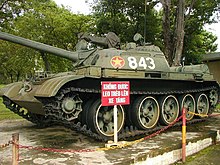
After unifying the country, the communist government proceeded to root out the remaining capitalist elements in the south. Many business owners were killed while others, known as the boat people, became refugees and attempted to escape to Western countries, resulting in the establishment of Vietnamese communities in many countries, including the United States , Australia and Canada . The ethnic Chinese, long resented by the ethnic Vietnamese for their perceived economic clout, were particularly hard-hit by the purges.
Following the collapse of the state-run economy, the government implemented market-oriented reforms and introduced capitalist elements in 1986 with a policy known as đổi mới . This policy has proved highly successful, as it spurred impressive economic growth and infrastructure development. Discriminatory laws against the remaining ethnic Chinese were repealed, and many have used their business acumen to contribute greatly to the revitalisation of the Vietnamese economy, also regaining some of their previous economic dominance in the process. Relations with the United States have thawed considerably, with formal defence ties having been re-established in 2016. Some former refugees or their descendants, most of whom were raised and educated in the West, have returned to Vietnam to take advantage of new economic opportunities. Today, Vietnam is widely considered to be one of the rising stars of Asia with a young population and vibrant economy.
Politics [ edit ]
The Socialist Republic of Vietnam (Cộng hòa xã hội chủ nghĩa Việt Nam) is a one-party authoritarian state, with the General Secretary of the Communist Party of Vietnam as the supreme leader, the president as the head of state and the prime minister as the head of government. The Vietnamese legislature is the unicameral National Assembly , from which the prime minister is selected. In practice, the president's position is only ceremonial, with the prime minister wielding the most authority in government.
Economy [ edit ]
Economic reconstruction of the reunited country has proven difficult. After the failures of the state-run economy started to become apparent, the country launched a program of đổi mới (renovation), introducing elements of capitalism. The policy has proved highly successful, with Vietnam recording near 10% growth yearly (except for a brief interruption during the Asian economic crisis of 1997). The economy is much stronger than those of neighboring Cambodia and Laos. Like most Communist countries around the world, there is a fine balance between allowing foreign investors and opening up the market.
There used to be extreme restrictions on foreigners owning property or attempting to sell. However, a property regulation announced in 2015 allows foreigners to own and lease apartments in Vietnam.
It is very difficult for them to trade without negotiating 'fees'. Business can be done via local partnerships with all the attendant risks.
Power and services is another issue. There are often rolling blackouts at times when there is not enough electricity. For this reason, many shops have portable generators.
According to government estimates, Vietnam saw 12.9 million tourist arrivals in 2017. Just 5% of visitors to Vietnam return for another holiday, compared to Thailand's whopping 50% return rate.
People [ edit ]
Most people in Vietnam are ethnic Vietnamese (Kinh), though there are many minority groups who tend to live in the highlands or big cities. The three biggest minorities are the Tay people, Thais and Muong. Others include the Khmers and Hmong. There is a sizable ethnic Chinese community in Ho Chi Minh City, most of whom are descended from migrants from Guangdong province and are hence bilingual in Cantonese, Teochew or other Chinese dialects and Vietnamese. The Chams, who live in the southern coastal areas of the country, represent the bulk of Muslims in Vietnam.
Buddhism , mostly of the Mahayana school, is the largest religion in Vietnam, with over 80% of Vietnamese people practising it to one degree or another, albeit usually syncretised with Taoism, Confucianism and Vietnamese folk religion. Christianity (mostly Roman Catholicism) is the second largest religion at 11%, followed by the local Cao Dai religion. Islam , Hinduism and local religions also share small followings throughout the southern and central areas.
Culture [ edit ]
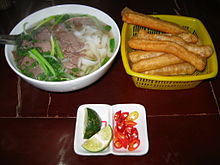
Due to its long history as a tributary state of China, as well as several periods of Chinese occupations, Vietnamese culture is strongly influenced by that of southern China, with Confucianism forming the basis of Vietnamese social etiquette. The Vietnamese language also contains many loan words from Chinese, though the two languages are unrelated. Buddhism remains the single largest religion in Vietnam. As in China, but unlike its Southeast Asian neighbors, the dominant school of Buddhism in Vietnam is the Mahayana School.
Nevertheless, Vietnamese culture remains distinct from Chinese culture as it has also absorbed cultural elements from neighboring Hindu civilizations such as the Champa and the Khmer empires. The French colonization also left a lasting impact on Vietnamese society, perhaps symbolised best by the Vietnamese fondness for baguettes and coffee. Southern and Central Vietnam, especially along the coast, have a much stronger Western influence, as compared to the North.
The division of Vietnam during what is locally called the American War has also resulted in cultural differences between northern and southern Vietnam that can be seen today. To this day, northern Vietnamese have a tendency to be more ideological, while southern Vietnamese tend to be more business-minded.
Vietnam is known for several traditional arts, with perhaps the most famous being water puppetry . In modern times, Vietnam has also jumped on the cirque nouveau bandwagon, with AO Show from Ho Chi Minh City perhaps being the best known example. Vietnam is also home to a vibrant pop music scene, with South Korean pop being the biggest influence on modern Vietnamese pop music.
Climate [ edit ]
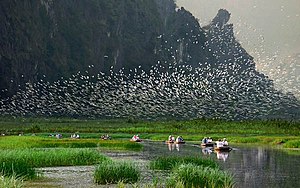
Vietnam is large enough to have several distinct climate zones.
- The south has three somewhat distinct seasons: hot and dry from Mar-Apr; rainy from May-Nov; and cool and dry from Dec-Feb. April is the hottest month, with mid-day temperatures of 33°C (91°F) or more most days. During the rainy season, downpours can happen every afternoon, and occasional street flooding occurs. Temperatures range from stifling hot before a rainstorm to pleasantly cool afterwards. Mosquitoes are most numerous in the rainy season. Dec-Feb is the most pleasant time to visit, with cool evenings down to around 20°C (68°F).
- The north has four distinct seasons, with a comparatively chilly winter (temperatures can dip below 15°C/59°F in Hanoi), a hot and rainy summer and pleasant spring (Mar-Apr) and autumn (Oct-Dec) seasons. However, in the Highlands both extremes are amplified, with occasional snow in the winter and temperatures hitting 40°C (104°F) in the summer.
- In the central regions the Hai Van pass separates two different weather patterns of the north starting in Langco (which is hotter in summer and cooler in winter) from the milder conditions south starting in Da Nang. Northeast monsoon conditions Sep-Feb often have strong winds, large sea swells and rain. This is a miserable and difficult time to travel through Central Vietnam by motorbike. Normally summers are hot and dry.
Read [ edit ]
- Catfish and Mandala: A Two-Wheeled Voyage Through the Landscape and Memory of Vietnam by Andrew X. Pham (2000).
- The Quiet American by Graham Greene (1955). Set in 1950s Saigon. A love triangle with a historical backdrop. 2 film adaptations: 1958 & 2002.
- The Lover by Marguerite Duras (1984) (original title: L'amant ). Film adaptation: 1992 starring Jane March, directed by Jean-Jacques Annaud.
Watch [ edit ]
- Indochine (French, 1992), with Catherine Deneuve, directed by Régis Wargnier. Set in 1930s French Indochina. A good storyline with some interesting insights on the history and politics of the time. Set around Saigon.
- Cyclo (Vietnamese, 1995). Set in Saigon, a dive into the murky violence and poverty of 1990s Saigon.
Holidays [ edit ]
By far the largest holiday is Tết — the Lunar New Year — which takes place between late January and March. In the period leading up to Tết, the country is abuzz with preparations. Guys on motorbikes rush around delivering potted tangerine trees and flowering bushes, the traditional household decorations. People get a little bit stressed out and the elbows get sharper, especially in big cities, where the usual hectic level of traffic becomes almost homicidal. Then a few days before Tết the pace begins to slow down, as thousands of city residents depart for their ancestral hometowns in the provinces. Finally on the first day of the new year an abrupt transformation occurs: the streets become quiet, almost deserted. Nearly all shops and restaurants close for three days, (the exception being a few that cater especially to foreign visitors; and hotels operate as usual.)
In the major cities, streets are decorated with lights and public festivities are organized which attract many thousands of residents. But for Vietnamese, Tết is mostly a private, family celebration. On the eve of the new year, families gather together and exchange good wishes (from more junior to more senior) and gifts of "lucky money" (from more senior to more junior). In the first three days of the year, the daytime hours are devoted to visiting: houses of relatives on the first day, closest friends and important colleagues on the second day, and everyone else on the third day. Many people also visit pagodas. The evening hours are spent drinking and gambling (men) or chatting, playing, singing karaoke, and enjoying traditional snacks and sweets (for women and children.)
Visiting Vietnam during Tết has good points and bad points. On the minus side: modes of transport are jammed just before the holiday as many Vietnamese travel to their home towns; hotels fill up, especially in smaller towns; and your choice of shopping and dining is severely limited in the first days of the new year (with a few places closed for up to two weeks). On the plus side, you can observe the preparations and enjoy the public festivities; pagodas are especially active; no admission is charged to those museums and historical sites that stay open; and the foreigner-oriented travel industry of backpacker buses and resort hotels chugs along as usual. Visitors also stand a chance of being invited to join the festivities, especially if you have some local connections or manage to make some Vietnamese friends during your stay. When visiting during Tết, it's wise to get settled somewhere at least two days before the new year, and don't try to move again until a couple of days after.
Lesser holidays include 1 May, the traditional socialist labor day, 2 September, Vietnam's national day, King Hung celebration on 10 March of Lunar Calendar, commemorating past kings, and Reunification Day on 30 April, marking the fall of Saigon in 1975. Around those times, trains and planes tend to be sold out, and accommodation at the beach or in Dalat are hard to find. Best to book far in advance.
See also [ edit ]
- Vietnamese phrasebook
- Driving in Vietnam
- Trekking in Vietnam
- Vietnam by motorcycle
- Vietnamese cuisine
Tourist information [ edit ]
- Vietnam Travel website
Talk [ edit ]
The official language of Vietnam is Vietnamese ( Tiếng Việt ). Vietnamese is a tonal language that uses a change in pitch to inflect different meanings, and this can make it difficult to master. Travellers may still be surprised to learn that the basic grammar is pretty simple. Verbs are static regardless of the past or future and parts of speech are pretty straightforward. The major difficulties lie in the pronunciation of the various tones and some of the sounds. Vietnamese is an Austroasiatic language that is related to Khmer, though the two languages are not mutually intelligible.
Vietnamese consists of 5 main dialects: the northern dialect spoken around Hanoi, the north-central dialect spoken around Vinh, the central dialect spoken around Hue, the south-central dialect spoken around Phu Yen and the southern dialect spoken around Ho Chi Minh City.
While the Hanoi dialect is the prestige dialect and widely used in broadcasting, there is no legally-defined standard dialect of Vietnamese. Northerners often think that the southern dialect is for "hai lúa" (country folk) and will always recommend that you stick to the northern dialect, but the choice of dialect should depend on where you plan to stay. If you are working in Ho Chi Minh City , the main economic centre of Vietnam, the southern dialect is what you will hear every day. The southern dialect is also more prevalent among Vietnamese communities in the West due to the southern origin of most of the Vietnam War refugees.
Vietnamese uses the Latin alphabet (with heavy use of diacritics), and the spelling accurately reflects the pronunciation. However, the pronunciation of the letters is often different from that in English.
Although Chinese characters are no longer used to write Vietnamese, the Vietnamese lexicon continues to be heavily influenced by the Chinese language. Some words are loanwords from Chinese like "hotel" (khách sạn), "children" (nhi đồng), "communist party" (đảng cộng sản); some are formed based on Chinese roots (characters), like "representative" (đại diện) or "bird flu" (cúm gà). Any knowledge of the Chinese language will make it much easier to learn Vietnamese. Chinese characters are sometimes still used for ceremonial purposes, such as in Buddhist and Taoist temples, but in general most Vietnamese are unable to read them. Vietnamese is also full of French and English loanwords. Nowadays, some English words are used directly in Vietnamese: camera, clip, internet, jeans, PC, sandwich, selfie, radar, show, smartphone, tablet, TV, etc.
Although the Vietnamese people appreciate any effort to learn their language, most seldom experience foreign accents. Consequently, learners may find it frustrating that no one can understand what they try to say. Staff in hotels and children tend to have a more tolerant ear for foreign accents and it is not unheard of for children to effectively help translate your badly pronounced Vietnamese into authentic Vietnamese for adults.
Ho Chi Minh City is home to a sizeable ethnic Chinese community, many of whom speak Cantonese . The more remote parts of the country are also home to many ethnic minorities who speak various languages belonging to the Mon-Khmer, Tai-Kadai and Austronesian language families.
Most younger Vietnamese learn English in school, but proficiency is generally poor. However, most hotel and airline staff will know enough English to communicate. Younger upper and middle class Vietnamese generally have a basic grasp of English. Road directional signs are generally bilingual in Vietnamese and English. Vietnamese people are much more adept at using 'Translate' Apps on phones than in neighbouring countries and will readily use these as means of communicating in English as well as other languages.
As a result of its colonial legacy, educated senior citizens are able to speak French . However, English has supplanted French as the main foreign language among the younger generations.
Russian is also spoken by some Vietnamese who have studied, worked, or done business in the USSR or Russia.
In the big cities, some of the big international luxury hotel chains will have staff who can speak other foreign languages such as Mandarin, Japanese, or Korean. At the more popular tourist sites, such as Hanoi's Temple of Literature, guides conduct tours in a number of foreign languages, including German, French, Spanish, Mandarin, Korean or Japanese.
Get in [ edit ]
Entry requirements [ edit ], visa-free entry [ edit ].
As of 2023/2024, visitors from the following countries, with their passport validity being at least 6 months from the date of entry, do not require a visa and can stay for the following number of days:
- 14 days: Brunei , Myanmar
- 21 days: Philippines
- 30 days: Indonesia , Kyrgyzstan , Laos , Malaysia , Singapore , Thailand , Cambodia
- 45 days: Belarus , Denmark , Finland , France , Germany , Italy , Japan , Norway , South Korea , Spain , Sweden , Russia , the United Kingdom (valid until 14 March 2025)
- 90 days: Chile , Panama
No specific waiting time is necessary between exit and re-entry on visa-free or visa-based visits to Vietnam. The visa-free period is calculated anew for every entry.
Further visa-free entries into Vietnam include:
- Any foreigner on a permanent or temporary residence permit.
- Any foreigner travelling in a border economic zone (e.g. Ha Tien ) for no more than 15 days, or in a special administrative and economic zone or a coastal economic zone like Phu Quoc island, off of the southwestern coast, for no more than 30 days. In order to boost tourism, the Vietnamese government has made these changes for Phu Quoc. Phu Quoc International Airport ( PQC IATA ) receives some direct flights from European airports such as Stockholm-Arlanda operated by Thomson , and flights from destinations in Asia. Also, those flying through Ho Chi Minh City (transit) or arriving by boat will not need to apply for a visa beforehand. Those wishing to travel elsewhere afterwards can apply for a proper Vietnamese visa at the local immigration office.
- Any foreign citizen of Vietnamese origin, who can apply for visa exemption that allows multiple entry for 3 months at a time which is valid for the duration of the passport.
In all other cases a visa in advance is required to visit Vietnam — see below. The previous visa-on-arrival scheme has been terminated.
E-Visa [ edit ]

Visitors from many countries , including most Western ones, are eligible for an electronic visa (e-Visa), which you apply for through the official online portal and print out yourself after approval (twice). It typically takes 3 working days to process, costs US$25 (single-entry) or US$50 (multiple-entry), and is valid 30 to 90 days, depending on you nationality and type of visa.
Don't forget to pay, which is a separate step after confirming your application, otherwise your visa application will be on hold! Also, the automatic email confirmation is not reliable and you have to check for yourself online whether you have received the visa. You must print out two paper copies of your visa once it is approved. You will need to submit one copy to the immigration officer when entering the country, and submit the other one to the immigration officer when leaving. You may also need to show it when checking in for your flight.
E-Visas are valid at major airports and seaports, and most but not all land crossings , e.g. not at the Oyadav–Lệ Thanh crossing between Banlung (Cambodia) and Pleiku (Vietnam). A full list of valid crossings is available on the e-Visa website, though many of them use obscure local names that can be difficult to find on maps.
In theory, entry and exit from the country should be from the same airport, seaport, or land crossing as stipulated on the e-Visa form, but in reality this is usually not enforced on the way out. However, you must enter on the date and at the place stipulated on the visa; you will be denied entry if you arrive on the wrong date or at the wrong port of entry. You will also be denied entry if there are typos in vital data on your eVisa such as your name or birth date.
Multiple entry and extended duration, are available with additional documents and information required.
Regular visa [ edit ]
Those not eligible for an eVisa can apply for a regular visa at most Vietnamese embassies and consulates abroad. The cost of applying depends on your nationality and the embassy or consulate you are applying at, but it will generally cost at least double the price of the eVisa. Check with the Vietnamese embassy or consulate in your country of residence, or the country you are in, for details. Embassies are (oddly) reluctant to announce fees on their websites, as the relatively high visa costs are a tourism deterrent, but nevertheless a source of revenue. Email or, even better, call them to get up-to-date information on prices. Or if you are in the same city, walk in and ask in person.
A regular visa may be required for people eligible for e-Visa, in case you want to enter at a remote border crossing that isn't included in the e-Visa system.
If your country does not have a Vietnamese embassy or consulate, a popular alternative would be to apply at the Vietnamese diplomatic missions in Bangkok , Sihanoukville or Phnom Penh . As of 2019, one of the reportedly cheapest places to get a visa are the Vietnamese embassy and consulates in Cambodia, starting at US$40 for a one-month, single entry visa. You may be able to apply for a visa and get it back later the same day; for example, at the Vietnamese embassy in Phnom Penh. Make sure to inquire about the details, since if you don't complete the application before a certain time of day, you will need to wait until the next day to pick up the visa and your passport.
Dual citizens [ edit ]
If you are a citizen of two foreign countries, you may be entering Vietnam on a different passport (Country A) than the one you have used to leave the previous country on your itinerary (Country B's passport) (e.g. because Country A's passport has a Vietnamese visa or offers a visa-free entry to Vietnam, while Country B's passport has a visa for the previous visited country). In this case, the Vietnamese immigration inspector will likely want to see the exit stamp and/or visa in your Country B passport as well. He may suggest putting the Vietnamese entry stamp into Country B passport as well, so that all your stamps would be in one place. Don't take him up on his offer; make sure that the Vietnamese entry stamp goes into the passport that either has the Vietnamese visa, or offers visa-free entry to Vietnam. Otherwise, you risk having problems when leaving Vietnam; the border control officers at your attempted exit point may declare your entry stamp "invalid" and send you back to your original point of entry to have the error corrected.
By plane [ edit ]
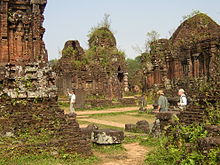
Vietnam's main international airports are located at Hanoi ( HAN IATA ) and Ho Chi Minh City ( SGN IATA ). Both airports are served by numerous flights from major cities in East Asia and Southeast Asia , with some intercontinental services to Australia , Europe and the United States .
International airports at Da Nang , Vinh , Nha Trang and Phu Quoc receive flights from neighboring Asian countries. As Da Nang is closer to the historical sites of Central Vietnam than the two main airports, it can make a convenient entry point for those who wish to visit those sites.
The national carrier is Vietnam Airlines , which operates flights into Vietnam's two largest cities from various cities in Australia, Asia and Europe. Vietnam Airlines serves most capital cities of Southeast Asian countries . The largest low cost carrier is Vietjet Air which flies to regional destinations including Bangkok, Chiang Mai, Hong Kong, New Delhi, Seoul, Singapore and Yangon.
By train [ edit ]
There is a nightly sleeper train between Nanning in China and Hanoi, taking 12 hours, including a tedious 2+2 hours at the border — see Hanoi#Get in for details. Through service are also available from Beijing , but travellers will need to change railway coaches at Nanning.
The old metre-gauge Kunming-Hanoi line has closed, and the simplest work-around is to take the high-speed train from Kunming to Nanning to join the overnight train to Hanoi. Another option is to travel to Hekou North Station in China, walk across the border from Hekou to Lao Cai , then take a Vietnamese train from Lao Cai to Hanoi. Both sides have several trains a day, so a daytime train from Kunming to Hekou can be matched with an overnight train from Lao Cai to Hanoi.
There are no railway links between Vietnam and Laos or Cambodia.
By road [ edit ]
Cambodia [ edit ].
Regarding bribes ; this is still a problem as of 2023, however most people encounter no issues when entering Vietnam by land. Certain border crossings, like the Bavet–Moc Bai crossing between Phnom Penh and Ho Chi Minh City , are known for demanding a 100,000–200,000 dong bribe from some people for giving the entry (but also exit) stamp — a claim is that this only applies to e-Visa. If you are one of the unlucky ones, try negotiating it down to 50,000 dong or be bold, put the 50,000 dong into your passport, walk up to the border officer desk in the VIP line, and hand over your passport. Check the reviews of the relevant border checkpoint on Google Maps to understand the situation and how to react. When travelling by bus, most likely the bus company will take care of the border formalities in exchange for a "service fee", so as to not to get stuck at the border. So, any potential bribe will already be included in this service fee or your bus ticket price.
The main crossing with Cambodia is the already above mentioned Bavet–Moc Bai crossing on the Phnom Penh–Ho Chi Minh City road. Buses between the two cities cost US$22–25 and take around 6–7 hr. Passengers are usually taken to a duty free shop for lunch while staff process them through immigration.
The Phnom Den–Tinh Bien crossing just north of Chau Doc . There is no regular boat service from Chau Doc onward towards Ho Chi Minh City or even other parts of the Mekong Delta , but you have to go by road.
Close to the coast is the Xa Xia–Prek Chak (Ha Tien) crossing . The Vietnamese consulate in Sihanoukville issues 30-day tourist visas on a same-day basis. Buses run between Sihanoukville and Phnom Penh , and Ha Tien and even Phu Quoc in Vietnam.
The Tro Peang Plong–Xa Mat crossing on the Kampong Cham – Ho Chi Minh City road is not well served by public transportation.
The Oyadav–Lệ Thanh crossing connects Banlung in North Eastern Cambodia and Pleiku in the Central Highlands of Vietnam. Vietnam e-Visas are not accepted for entering Vietnam at this border crossing. So, only visa-free nationalities or people with a traditional visa from an embassy/consulate can enter. The Vietnamese entry checkpoint closes to foreigners at 17:30.
China [ edit ]
There are three border crossings between China and Vietnam that can be used by foreigners:
- Dongxing - Mong Cai ( by road; onward travel Mong Cai to Ha Long by sea or by road )
- Hekou - Lao Cai ( by road and/or rail, but no international passenger train services )
- Youyi Guan - Huu Nghi Quan (Friendship Pass - by road and/or rail )
Laos [ edit ]
There are six border crossings between Laos and Vietnam that can be used by foreigners (from north to south):
- Tay Trang (Dien Bien province, Vietnam) - Sobboun (Phongsali province, Laos)
- Na Mao (Thanh Hoa province, Vietnam) - Namsoi (Houaphanh province, Laos)
- Nam Can (Vietnam) - Namkan (Xiangkhouang province, Laos)
- Kaew Neua - Cau Treo (Keo Nua Pass)
- Lao Bao (Vietnam) - Dansavan (Laos)
- Ngoc Hoi (Kon Tum province, Vietnam) - Bo Y (Attapeu province, Laos)
Be wary of catching local buses from Laos to Vietnam. Not only are they often crammed with cargo (coal and live chickens, often underfoot) but many buses run in the middle of the night, stopping for several hours in order to wait for the border to open at 07:00. Whilst waiting, you will be herded off the bus (for several hours) where you will be approached by pushy locals offering assistance in getting a Laos exit stamp in exchange for money (usually US$5+). If you bargain hard (tiring, at 04:00) you can get the figure down to about US$2. The men will take your passports, which can be disconcerting, but they do provide the service they promise. It is unclear whether you can just wait for the border officials to do this. There is also a VIP bus from Savannakhet.
By boat [ edit ]
Boats (4–5 hr) from Phnom Penh to Chau Doc run once a day — see Phnom Penh#By boat . They use the so called Song Tien landport border crossing on the banks of the Mekong River.
This journey between Phnom Penh and Ho Chi Minh City can also be stretched into a 2-nights/3-days Mekong Delta tour and provides a more insightful journey between the two cities, starting from about US$60–100. However, the only times on a boat with these tours will be the Phnom Penh–Chau Doc bit, a floating market morning boat tour from any of the overnight towns along the way, and the short Ben Tre – My Tho boat ride — the rest is by bus. For an actual boat tour of the Mekong Delta it will probably require several hundreds if not a thousand US dollars.
Get around [ edit ]

Trains are undoubtedly the most comfortable and an exciting way to travel overland in Vietnam.
Due to the steady increase of tourist bus prices, trains are now an inexpensive alternative to buses. While a night in a sleeper carriage is still more expensive than a sleeper bus, seat carriage prices are very competitive.
Destinations [ edit ]
There is one major train line in Vietnam, the 1,723 km (1,071 mi) trunk between Hanoi and Ho Chi Minh City (HCMC), on which the Reunification Express runs. HCMC to Hanoi is more than 30 hours, and overnight hops between major destinations are usually possible, if not entirely convenient. It is a good way to see the countryside and meet upper-middle class locals, but unless you are travelling in a sleeper car it is no more comfortable than buses.
In addition, there are shorter routes from Hanoi leading northwest and northeast, with international crossings into China . One of the most popular of the shorter routes is the overnight train from Hanoi to Lao Cai (with a bus service from Lao Cai to the tourist destination of Sapa ).
Seats and carriages [ edit ]
Air conditioned soft or hard sleeper berths are recommended for overnight trains. Otherwise air-conditioned soft seats are sufficiently comfortable to travel in them during the day. If you are sensitive to cigarette smoke try to book a seat closer to the middle of the carriage as people smoke in the areas at the end of the carriages and the doors are often left open.
At least in the sleeper carriages, there are hot and cold water dispensers and paper cups — tea or instant coffee may be a great idea. Toilets in the seater carriages can be squatting ones, whereas toilets in the sleeper carriages are regular ones. So, if possible, head to one of the sleeper carriages if the passage is not locked. There is always a sink separate from the toilet with water to wash your hands, but only the sleeper carriages may have soap and a dryer.
When buying a ticket, also check the sleeper carriages for availability. During day travel, some sleeper berths are priced almost as cheap as seats, the upper berth sometimes even cheaper. Note that the train personnel in Vietnam seems to enforce the bed selection and people are not sitting together on the lower seat during the day like in India. In the worst case, you will have to stay in sleeping position the whole trip, during the day. However, on the lower berth(s), two friends or on your own, with one or two pillows in your back, is a great way to chill and watch the landscapes fly buy. If the seater carriage is fully booked, be assured, so will be the sleeper soon. So, you will most likely have to stick to the selected berth, even if your side of the cabin was empty when you booked it. (In the 6-berth carriage, for more head space put the middle berth up half way and use the foot rest to keep it in that position.)
Tickets [ edit ]
In high season, purchasing as early as possible is a good idea. However, you can simply check the ticket situation online by checking near-future trains (in the next couple of days) to understand how early you need to book.
Booking online is possible through the official Vietnamese Railways website , which has an English version and accepts payments by international bank cards. The process is straight forward and works flawlessly — you will receive an e-ticket for download with a QR code in the end. Printing the e-ticket is not necessary if you got the QR code, but most larger railway stations will have a ticket printing machine anyways, just in case.
Prices fluctuate a little, by 5% or so, but booking early except for assuring a seat is not necessary. Prices for holiday periods are generally higher.
There are commercial websites to book your train ticket with, like Baolau or 12go.Asia . However, if the Vietnamese Railway website is working, there is no real reason to do so. Also, while they will assure you a seat on the train, they might lie about the type of seat, especially if the train is getting full. It happened to tourists in the past that they booked a regular seat but ended up with a sleeper berth, having to lie down the whole journey during daytime. It is best therefore to book directly, which will also ensure you the best price.
Booking at the train station itself is generally safe, but beware of scams by station staff . Prepare a piece of paper with the destination with date, time, no. of passengers and seat class, and, most importantly, know the price.
( It is unclear whether the following information is still relevant as of 2023. ) Popular berths and routes are often bought out by tour companies and travel agents well before the departure time. Being told the train is sold out at a station ticket window or popular tour company office does not mean there are no tickets available; they have simply been bought by another reseller. Unsold tickets can often be bought last minute from people hanging around at the station. A train is rarely sold out for real, as the railway company will add cars when demand is high. Commissions on these tickets will drop away as the departure time draws nearer. As of July 2018 tickets (now termed "boarding passes") do indicate the class of ticket, making scams with falsely promised seat classes less of an issue, although buying your ticket directly online or from the train station remains the best option.
By bus [ edit ]

Public buses travel between the cities' bus stations. In bigger places, you often have to use local transport to get into the city centre from there. Buses are generally in reasonable shape, and you have the chance to interact with locals.
Every major city will have a centralised bus station, and most of the major companies will have ticket offices at the stations. Bus stations are generally well organised, safe and easy enough to navigate even if you don't speak Vietnamese.
As a foreigner, you are likely to get overcharged on local buses, where you pay a conductor during the journey. Find out what the right fare is by looking up the price (it is displayed somewhere, often next to the front door on the outside of the bus; take a photo if you can), or by talking to one of the local travellers. Give the right amount and be prepared to argue your case. Nowadays however, many conductors will issue tickets, making it harder or less interesting for them to overcharge you.
Long-distance buses connect most cities in Vietnam. Most depart early in the morning to accommodate traffic and late afternoon rains, or run overnight. Average road speeds are typically quite slow, even when travelling between cities. For example, a 276 km (172 mi) journey from the Mekong Delta to Ho Chi Minh City by bus will likely take about 8 hours.
So called open tour buses are run by a multitude of tour companies. They cater especially to tourists, including door-to-door service to your desired hostel. You can break the journey at any point and continue on a bus of the same company any time later, or simply buy tickets just for the stage you're willing to cover next. If you are not planning to make more than 3-4 stops, it might be cheaper to buy separate tickets as you go. Buses without the journey break option are just called deluxe or inter-provincial buses .

There are seater buses available, especially during the day, sleeper buses , where instead of a seat, you get an angled-flat bunk bed that you can sleep on, and more expensive VIP sleeper bus , in which you get a wider bunk bed, your own cubicle for more privacy, and a personal TV system similar to those in aeroplanes.
Most ho(s)tels and guesthouses can book buses for you. However, they will try to book a more expensive option, because their commission is bigger then. So, you are better off to shop around at travel agents and bus companies directly, as prices will vary considerably on any given ticket or bus company — some buses (even sleeper) are as cheap as a seater railway carriage, e.g. FUTA Bus or Son Tung Bus (Hue and south). Booking with the bus company directly may net you a commission-free fare, but most companies have fixed pricing policies, which can only be circumvented through a travel agent.
If you are traveling with a bicycle , negotiate the extra fee with the driver rather than the ticket counter before buying your ticket. The bicycle fee should be no more than 10% of the ticket price.
Cope [ edit ]

Stop-offs are often at souvenir shops to give the bus company an extra income. You do not have to buy anything, but they always have toilets and drinks and water available for purchase. The estimated time for a bus trip will not be accurate and may be an additional couple of hours sometimes, due to the number of stop offs. Collecting the passengers at the start of the journey can also take quite a while too. Always be at least half an hour early to catch the bus. Try not to drink too much water, as rest stops, especially for overnight buses, may be just somewhere where there are a lot of bushes.
Vietnamese buses are made for Vietnamese people; bigger Westerners will be uncomfortable, especially on overnight buses. Also, many Vietnamese are not used to travelling on long-haul buses, and will sometimes get sick — not very pleasant if you are stuck on an overnight bus with several Vietnamese throwing up behind you.
Even if you are sometimes bus-sick, it is advisable to book a seat at the middle rather than at the front of the bus. First, you will avoid viewing directly the short-sighted risks the driver is taking on the way. Second, you will somewhat escape the loud noise of non-stop honking (each time the bus passes another vehicle, that is about every 10 seconds).
Although the bus company will usually be happy to collect you at your hotel or guest house, boarding at the company office will guarantee a choice of seats and you will avoid getting stuck at the back or unable to sit next to your travelling companions. The offices are generally located in or near the tourist area of town, and a short walk might make your trip that much more pleasant.
The long haul bus companies operate from north to south and back on the only main road (QL1). If you take a bus going further than your destination, the bus will drop you off at the most convenient crossroad for it and not as you may have expected at the bus terminal of your destination. For Hué, this crossroad is 13 km from the city centre; for Nha Trang 10 km. At these crossroads, you will find taxis or motorbike taxis to get you to your ho(s)tel.
Stay safe [ edit ]
A scam that you may encounter is that after arriving at your location, the guides will ask you whether you have booked a hotel. Even though you haven't, say that you have and prepare the name of a hotel. If you say you have not booked one, they will charter a taxi for you and probably drop you at a hotel which they can collect commission. If you decide not to stay, things may get a little ugly, as they will demand that you pay the taxi fare, which they may quote as several times the actual fare for a ten-minute ride.
Be very careful of your possessions on the overnight bus, as people (including bus employees) have been known to look through passenger's bags and take expensive items like electronics and sell them on for profit. Do not fall asleep with your headphones in your ear, as the chances are your phone will be nowhere to be found in the morning. Get a padlock for your hand luggage and lock everything up in there before you go to sleep.
Flights are the fastest way to traverse this long country. Flights between Hanoi and HCMC last only about 2 hours and start at €30–40.
There are many airports connecting with Hanoi and HCMC (north to south).
Northern Vietnam :
- Điện Biên Phủ Airport ( DIN IATA ) near Dien Bien Phu
- Van Don International Airport ( VDO IATA ) near Cai Rong
- Cat Bi International Airport ( HPH IATA ) near Hai Phong , including international connections with South Korea and China
Central Coast :
- Vinh Airport ( VII IATA ) near Vinh
- Dong Hoi Airport ( VDH IATA ) near Dong Hoi
- Phu Bai International Airport ( HUI IATA ) near Hue
- Da Nang International Airport ( DAD IATA ) near Da Nang , including international connections with South Korea , China , Malaysia , Cambodia , Singapore , Taiwan , and Japan
- Chu Lai Airport ( VCL IATA ) near Quảng Ngãi
- Phù Cát Airport ( UIH IATA ) near Quy Nhon
- Tuy Hoa Airport ( TBB IATA )
- Cam Ranh International Airport ( CXR IATA ) near Nha Trang , including international connections with South Korea , China , Malaysia , Thailand
Central Highlands :
- Pleiku Airport ( PXU IATA ) near Pleiku
- Buon Ma Thuot Airport ( BMV IATA ) near Buon Ma Thuot
- Lien Khuong Airport ( DLI IATA ) near Da Lat , including domestic connections to Da Nang , Vinh and Hue
Southern Vietnam :
- Rach Gia Airport ( VKG IATA ) near Rach Gia
- Can Tho International Airport ( VCA IATA ) near Can Tho
- Con Dao Airport ( VCS IATA ) on Con Dao
- Phú Quôc International Airport ( PQC IATA ) on Phú Quôc
Some airports are further away from the next major city or sight. Make sure to know how to get away from the airport without shedding another 500,000 dong for a taxi.
The full-service domestic airlines are flag carrier Vietnam Airlines operating some shorter flights, as well as privately owned Bamboo Airways . The main budget airlines are Pacific Airlines [dead link] and VietJet Air .
By bicycle [ edit ]
Adventurous travellers may wish to see Vietnam by cycling . Several adventure travel tours provide package tours with equipment. Most of the population get around on two wheels, so it's an excellent way to get closer to the people as well as off the beaten path.
Bicycles can be rented cheaply in many cities and are often a great way of covering larger distances. Good spots for cycling are Dalat , Hoi An , Hue and Ninh Binh . On the other hand, attempting to cycle in Hanoi or Ho Chi Minh City (HCMC) is virtually suicide without proper experience of traffic rules (or lack thereof, 'proper experience' in this case means understanding that everyone around you could potentially change direction without signalling and at any moment). A general 'rule of thumb' when on a bicycle or motorbike is 'expect the unexpected'. It's like a school of fish traffic situation.
In cities like HCMC and Hanoi, parking bicycles on pedestrian areas is not allowed and you will have to go to a pay parking lot: 2,000 dong per bike, 5,000 dong for a motorbike.
By motorbike [ edit ]

Some choose to traverse the entire country this way while most are satisfied with a few local day trips — also see below . If you are not an experienced motorbike rider you should reconsider starting to ride here. Riding in the big cities is not advisable unless you are an experienced rider with a very cool head. Traffic is intense and chaotic; "right of way" is a nearly unknown concept.
In small towns and beach resorts where traffic is light, e.g. Pho Quoc, it's a delightful way to get around and see the sights, and much cheaper than taxis if you make several stops or travel any distance. Roads are usually decent, though it's advisable not to ride too fast and always keep an eye on the road for the occasional pothole.
Two main categories of motorbike are available for rent: scooters (automatic transmission); and four-speed motorbikes.
Most places you would want to stop have parking attendants who will issue you a numbered tag and watch over your bike.
If you are in Vietnam during the rainy season , make sure to buy a poncho or a raincoat before you start. They are available for as little as 10,000 dong. However, the traffic doesn't stop, it just becomes more chaotic. If you are hesitant or have not driven in such conditions before, it might be prudent to park and wait.
Beware of thieves: always keep your motorbike in sight or parked with an attendant. Look for rows of neatly-parked motorbikes or signs that say giu xe .
It is illegal for foreigners to ride a motorbike in Vietnam without a temporary Vietnamese motorbike licence , or an International Driving Permit with a valid home country motorbike licence. Nevertheless, many foreigners ride without a valid licence. Make sure to check with your travel insurance company to see if you are even covered to ride.
Crossing the border into Cambodia with a Vietnamese license plate seems no issue as of Dec 2023.
By taxi [ edit ]
Nowadays, the taxi and motorbike taxi market is dominated by the ride-hailing service Grab ( Android , iOS ), which took over Uber's former South-east Asian operations, including that of Vietnam. This means that the price and destination are set upfront and cash is not required; while cash is accepted, the driver may not have enough change should you hand them a large note, so preparing the exact amount is preferred. Depending on the route taken and time, prices will be slightly higher than for a taxi in most cases, but will sometimes be even cheaper. Outside of large cities, Grab arranges taxi rides according to metered rates, which are still paid through the app.
Even if you don't use Grab for booking, the app will help you to get a feeling for the rough price ranges for rides in case you hail a taxi or motorbike taxi directly along the street. Note that there are cases where the Grab driver can charge additional money, e.g. in case he used a larger vehicle. Find out about those cases from Vietnamese people or the TOS so not to be surprised when it happens expecting some kind of a scam.
As of 2023, Xanh SM [dead link] is pushing persistently into the taxi aka ride-hailing market with its EV fleet of cars and motorbikes. According to industry insiders they are supposed to overtake Grab in 2024 on the car side. They often have specials to attract people, so it is a good idea to also download this app (for Android or iOS ) and price–compare against Grab, especially for larger distances and prices.
By metered taxi [ edit ]
Regular taxis are still operating in places where ride-hailing may not be immediately available, like airports, railway stations, or around hotels. The smaller the taxi the lower the flag fall: so a small compact saloon or equivalent will have a flag fall of 5,000 dong, a mid range saloon 9,000 dong and an SUV 11,000 dong. The flag fall fare is for a shorter distance the smaller the car so the 5,000 dong flag fall takes you 500 m, whilst the 11,000 dong will last for 850 m so on journeys longer than 1 km the size of the vehicle makes no difference (somewhat complicated but after a few rides you will understand how the system works). In the evening these flag falls may rise by 1,000 dong.
Few drivers speak more than a few words of English, so staff at your hotel write down the names of your travel destinations in Vietnamese to show the driver. Another option is to show them the destination in Google Maps on your phone. In that case, most drivers prefer to view the complete route instead of just the destination and may even end up using your phone for navigation. It helps to carry one of your hotel's business cards so you can return to the hotel without too much fuss.
In the more touristy destinations such as Sapa and Cat Ba, it is much more difficult to get drivers to use their meters than in the big cities and beach centres. Be prepared to walk away if the driver refuses to use the meter.
Beware of common taxi scams , such as drivers refusing to use the meter and quoting ridiculous fares, or rigged meters than jump at ridiculous rates. However, as long as the meter starts automatically after the vehicle has been rolling for a few metres or the driver switches it on manually, you shouldn't be scammed. To minimise your chances of falling for a scam, try to learn to recognise the reputable large taxi companies — see city articles.
Carry small change and notes for paying fares, since drivers often are or pretend to be short on change.
Many drivers have a good command of the geography of their city and the nearest most passengers will come to being scammed is that the driver may select a slightly longer route than is strictly necessary. Keeping Google Maps open during your journey often prevents this issue.
By xe ôm [ edit ]
Motorbike taxis ( xe ôm , literally "hugging vehicle") are a cheap and reasonable mode of transport for Vietnamese as well as tourists — provided you avoid getting scammed. It's generally not a good idea to grab a random one off the street, as you are much more likely to get scammed as a foreigner. Instead, use one of the before mentioned ride hailing apps if available or use them for negotiating the price, as you are much less likely to get scammed that way. About 10,000 dong should suffice for a 10-minute trip, which should get you anywhere within the city centre. Longer trips to outlying areas should cost about 20,000-30,000 dong.
All riders are now required to wear helmets, a rule that is strongly enforced. Make sure the driver supplies you with a helmet. If he doesn't, find another one, as you'll be the one stung for the fine.
Drivers rarely speak English. As with most things, a tourist will often be quoted an above-market price initially, and you need to be firm, anything over 10,000 dong is a reason to walk away. Occasionally drivers will demand more than the negotiated price at the end, so it's best to have exact change handy. Then you can pay the agreed amount and walk away, end of discussion.
In some cases they will take you wherever they want (tourist attractions or shops you didn't request to go) and sometimes they will wait for you to come back (even if you don't want them to wait) and will ask you for more money for having been waiting. Even if you speak some Vietnamese, this is not useful, since they will cheat you anyway or they will act as if they don't understand even if they do. Again, be firm and walk away.
By cyclo [ edit ]

Not really an alternative to (motorbike) taxis, but an interesting way to see the city, cyclo pedicabs still roam the streets of Vietnam's cities and towns, especially the ones with many tourists. They are especially common in scenic smaller, less busy cities like Hue, where it's pleasant to cruise slowly along taking in the sights. Though the ride will be slow, hot and sometimes dangerous, you will generally need to pay more than for a motorbike for the equivalent distance. On the plus side, some drivers (particularly in the South) are very friendly and happy to give you a running commentary on the sights. Cyclos are slowly being supplanted by motorbikes though.
Cyclo drivers are notoriously mercenary and will always ask for a high price to start with. Sometimes they will also demand more than the agreed price at the end. Japanese tourists, especially women, are most often targeted with this scam since they are more responsive to the threat that the driver will call the police and make trouble for them if they don't pay as demanded. A reasonable price is about 20,000 dong for up to 2 km (1.2 mi), and if the driver disagrees, simply walk away — you won't get far before that driver or another takes your offer.
Prices for a sightseeing circuit with intermediate stops are more complex to negotiate and more subject to conflict at the end. If you plan to stop somewhere for any length of time, it's best to settle up with the driver, make no promises, and start fresh later. Some drivers start with a very low rate to get you into their cycle and then if required to wait for you or otherwise vary the agreed price, bring out a typed up price list of their "standard rates" which are inflated beyond belief. If even slightly unsure ask the driver show you his list of charges. Then negotiate from that point or walk away.
To avoid trouble, it's also best to have exact change for the amount you agreed to pay, so if the driver tries to revise the deal, you can just lay your cash on the seat and leave.

You will be missing a big part of Vietnamese life if you do not spend some time on a boat. Do be careful though because many boats, although seaworthy, are not designed to first world standards. An example is the ferry from Phu Quoc to the mainland. This ferry has one tiny entrance for all passengers to board. When full, which it usually is, there are approximately 200 people on board. In the event of an accident, the chance of everyone getting out of the boat fast enough would be very small. The idea of an emergency exit does not exist there.
Tour boats can be chartered for around US$20 for a day's tour; but beware of safety issues if you charter a boat, make sure the boat is registered for carrying tourists and has enough life jackets and other safety equipment on board. Or you can book a tour through a tour company; but in Vietnam most Tour Agents charge whatever markup they want and therefore the tourist is often paying margins of 30-40% and the boat owner and operator (of anything from a van to a boat etc.) are paid very little of the total amount.
Ha Long Bay is a famous destination for one- to three-day boat trips among its scenic limestone islands. The problem is that all the boats seem to visit the same places - and with high prices, poor quality boats and service real value is hard to come by. Many boats have a US$10 corkage fee, and forbid BYO alcohol, while on-board alcohol and seafood is about the same price as in Europe in some places. If there is rain, mist or low cloud, you may not see much. Try to pick a clear day.
Dozens of small family-operated boats ply the river in Hue taking visitors to the imperial tombs southwest of the city. This journey is long because the boats are slow, taking about 4 hours or so to make the journey in one direction.
Snorkel, fishing or lunch trips are available from Nha Trang , Hoi An , and Phu Quoc to nearby islands. In Central Vietnam northeast monsoon season limits many sea boat tours during the months Sep-Feb; other parts of Vietnam seem less affected.
A 90-minute hydrofoil boat operates from HCMC to the seaside resort of Vung Tau for about 250,000 dong each way, the fastest way to reach the beach from the city.
By car [ edit ]

Traffic moves on the right in Vietnam.
The concept of renting a car to drive yourself is almost non-existent, and when Vietnamese speak of renting a car, they always mean hiring a car with a driver. (After a short time on local roads with their crazy traffic, you will be glad you left the driving to somebody used to it.) Vehicles for rent are widely available. Tourists can hire vehicles through hotels and tour agents found in every tourist area. International car brands have started to surface, offerint chauffeur-driven services. Few drivers speak any English, so make sure you tell the hotel or agent exactly where you want to go, and have that communicated to the driver.
On foot [ edit ]
Traffic is made up of a staggering number of motorbikes and, since import duty was reduced when Vietnam's joined the World Trade Organization, an increasing number of private cars. However it's exceptionally rare to see a motorbike of more than 150cc, and the traffic rarely gets above 20–30 km/hr in central areas.
When crossing roads stay aware, and walk slowly and confidently. Motorbike riders are exceptionally good and will simply move to avoid you, just don't make any sudden erratic moves. Just look for a gap or seam in the traffic, and begin a slow, but steady movement. If you hear a beep coming your way it's likely a motorbike rider is about to enter your personal space. Be alert and prepared to stop putting your foot forward until he passes.
Always look both ways — don't assume traffic only comes from one direction. Give oncoming vehicles ample time to see and avoid you. Never move hastily between rows of waiting cars, often motorbike drivers will use the space between car rows to drive and they won't see you coming, since the cars block their sight.
Adherence to traffic signals is not guaranteed. Drivers tend to use "best judgment". Just remember though that vehicles can always turn right at any time (regardless of lights). Motorbikes often drive in the wrong direction to take a short cut, even against the traffic flow. Crossing roads therefore maybe a challenge for Westerners used to traffic laws and traffic lights.
For navigation make sure to have good (offline) maps and GPS with you. For reliable maps, GPS navigation , comprehensive map information, consult OpenStreetMap , which is also used by this travel guide and by many mobile Apps like OsmAnd or Mapy.cz .
See [ edit ]
Vietnam will show you sides of Asia that you've dreamed of. Lush rice fields at the bottom of stunningly gorgeous highlands, colourful water markets on the streams of the Mekong Delta and the endless bustling city life of Hanoi, where anything from school children to fridges and huge piles of vegetables are transported on the back of countless motorcycles. Although Vietnam's huge cities are rapidly transforming into modern Asian metropolises, traditional culture is never far away.
Architecture [ edit ]
Numerous ancient buildings remain and are actively maintained in Communist Vietnam, like the old town of Hoi An , but so are the buildings of Communist history, like the Independence Palace in Ho Chi Minh City. Also, the colonial history provides for many architectural delicacies.
City life [ edit ]

Head to Hoi An with its Venice-like canals and beautiful old town for some top sightseeing. Enjoy the old port , wander through its endless winding alleys and take a pick from its countless fine restaurants and shops, or relax on the beach. Once a fishermen's village, this town's now well-protected by preservation laws and has turned into a major hot spot for visitors. Hanoi is of course the summit of Asian city life. It's an incredible myriad of ancient traditions, old and modern architecture, sounds, smells, bustling commerce and famously crazy traffic. It's chaotic and enchanting at once - a great place to discover both ancient and contemporary Vietnam. Most sights are in the Old Quarter , including the famous Hoan Kiem Lake and the beautiful Bach Ma Temple . Spend a day or two in Ho Chi Minh City , or Saigon, the country's largest city. Nowhere are contrasts between old and new more ubiquitous and alive than here, where you'll find ancient pagodas and traditional street life at the feet of giant skyscrapers. Top sights include the Reunification Palace and Giac Lam Pagoda . Also well worth visiting is the former imperial town of Hue , with its beautiful Citadel and the Tombs of the Emperors along the Perfume River . The largest beach city is Nha Trang which spreads out along the beach but also has an interesting city-scape.
Landscapes and nature [ edit ]

Few countries are blessed with landscapes as captivating as those of Vietnam. For many, the country's awe-inspiring limestone scenery, perfect beaches, islands, mountain ranges, rice fields and lakes are its greatest treasures. One of Vietnam's top attractions, Ha Long Bay , boasts thousands of limestone pillars and islands topped with dense jungle vegetation. Among the bustling port life, you'll find floating fishermen's villages, caves, and island lakes. Neighboring Lan Ha Bay is as spectacular, but less busy. Head to Sa Pa and the Muong Hoa valley to get take in the views of local rice fields against a background of bamboo forests. Also in the north is Tam Coc near Ninh Binh . This area is famous for its karst scenery, rice fields, and caves and is best explored by hired boat.
Phu Quoc , off the Cambodian coast, is the largest island in the country. Its delightful palm-lined beaches and tropical forests can compete with any in the world. Most famous in the south is of course the Mekong Delta . Here, the Mekong River empties into the South China Sea via a maze of smaller streams. It's a lush, green region and the source of half of Vietnam's agricultural produce. It offers scenic views of the rivers and rices fields as far as the eye can see. Here, natural landscapes and culture go hand in hand as life revolves around the water. The Mekong streams are a major means of transportation and host floating markets .
Some best picks in terms of natural wonders can be found in the country's national parks. Phong Nha-Ke Bang National Park , a UNESCO World Heritage Site, is famous for its natural caves and grottos, with underground rivers and cave beaches as well as stunning stalagmites and stalactites. For wildlife, try Cuc Phuong National Park .
Museums [ edit ]
For better insight in Vietnam's ancient traditions, culture and history, visit one of the many museums, some with truly excellent collections. The War Remnants Museum in Ho Chi Minh City will leave a lasting impression, particularly the chilling collection of war photography. Although not exactly neutral in tone, there are English labels. The HCMC Museum is in a building worth seeing on its own, and gives a nice overview of the city's history. For a broader history collection, try the fine History Museum , which has artefacts from several Vietnamese cultures on display. In Hanoi , the Vietnam Museum of Ethnology is an excellent place to dive into the life of the country's tribal people. In the centre of town is the Fine Arts Museum has all kinds of arts on display, from high-quality wood and stone carvings to fabulous ceramics and textiles. Descriptions in English. For something completely different try the Robert Taylor Museum of Worldwide Arms in Vung Tau . This is one mans fascinating collection of arms and uniforms collected from around the world.
Do [ edit ]
Trekking Vietnam is an ideal way to enjoy and experience beautiful nature of Vietnam, from the yellow farmers' terraces in harvesting season of the north ( Sa Pa ), to the off-the-beaten-path Central Highlands, or the frenetic activity of the Mekong Delta in the south.
Chinese chess ( cờ tướng ) is a popular game in Vietnam, and you will often notice the elderly having games in the public parks. If you know how to play, this can be an opportunity to befriend the locals. A uniquely Vietnamese tradition pertaining to Chinese chess is human chess ( cờ người ), typically played at temple and village festivals during Tết . As the name suggests, the pieces are played by humans dressed in traditional Vietnamese costumes, usually with 16 teenage boys on one side and 16 teenage girls on the other, and a choreographed traditional martial arts fight between the two pieces always ensues whenever a piece is captured.
Retreats, spas, meditation and yoga are popular in Vietnam, with Hoi An in particular becoming a hub for like-minded individuals.
Motorbiking [ edit ]
Epitomized in an episode of “Top Gear” riding a motorbike in Vietnam has become a goal for many people visiting the country. While riding in Vietnam can be dangerous, it can also be a life-changing experience. You see things from the seat of a motorbike that you don't see while travelling in different type of vehicle.
Motorbiking is popular with locals and tourists alike. Given that motorbikes are the main mode of transport in Vietnam, they can give a particularly authentic view of travelling through the country. Renting or buying a bike is possible in many cities.
Major roads between cities tend to be narrow despite being major, and full of tour buses hell-bent on speed, passing slow trucks where maybe they shouldn't have tried, and leaving not much room at the edge for motorbikes. But there are many good roads and beautiful sights to be seen with the freedom of your own motorbike.
Motorbike tours are the newest addition to the motorbike hype in Vietnam. Three basic concepts exist for that:
- On the most simple "tour", your luggage is taken care of and you ride the distance, e.g. Hoi An to Hue by motorbike and visit all the sights on the way. Price-wise this comes up to the same as a bus ride for the same distance, which is why many people choose this interesting alternative.
- On motorbike adventure tours , you are guided on multi-day drives to remote regions of the country. Most tours include accommodation, petrol, helmets, drivers and entry tickets to local places of interest. Guides usually speak good English or French and offer customised tours if desired.
- Motorbike sightseeing tours are similar but have a more local range specific to one city or area and can focus on food, shopping or sightseeing.
Buy [ edit ]
Money [ edit ].
The national currency is the dong ( đồng ), sometimes denoted by the symbol " ₫ " (ISO code: VND ). Prices are usually shown without a currency notation, e.g. as "100.000", "100k" or "100K", and in speech it's common to drop the thousands completely. Wikivoyage articles will use dong to denote the currency.
Notes are available in denominations of 1,000, 2,000, 5,000, 10,000, 20,000, 50,000, 100,000, 200,000 and 500,000 dong. Smaller bills and coins in denominations up to 5,000 dong also exist, but are rarely seen. While they are legal tender, they are difficult to get rid of if you end up with some.
ATMs [ edit ]
ATMs are common and can be found in most cities and every tourist destination. They will accept a selection of credit and debit cards, including Visa, MasterCard, Maestro or Cirrus and several other systems. Many ATMs charge a fee per withdrawal, but a few are free. Withdrawal maximums are a problem of the past and withdrawing 5–10 mn dong is not an issue anymore.
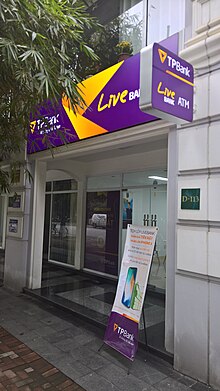
The ATMs of the following banks have no withdrawal fee :
- TP Bank . ( updated Nov 2023 )
- VP Bank . ( updated Dec 2023 )
- ACB . European Visa (unclear whether "Union" or continent) and JCB cards only . ( updated Nov 2023 )
- HDBank . Visa cards only . ( updated Dec 2023 )
- EXIMBANK . ( updated Dec 2023 )
The ATMs of the following banks have the listed fee per withdrawal :
- Agribank . 22,000 dong . ( updated Mar 2020 )
- ABBank . 20,000 dong . ( updated Jan 2018 )
- ANZ Bank . 40,000 dong . ( updated Jan 2018 )
- BIDV Bank . 50,000 dong plus 5,000 dong VAT . ( updated Mar 2016 )
- DongA Bank . 20,000 dong . ( updated Jan 2018 )
- HSBC , [email protected] . 100,000 dong . ( updated Apr 2016 )
- Techcombank . 66,000 dong . ( updated Jan 2018 )
- VIB . 50,000 dong (and they don't warn about it!) .
- Vietcombank . 1.5% fee . ( updated Feb 2020 )
- Vietinbank . 55,000 dong . ( updated Jun 2016 )
- Sacombank . 1.5% fee . ( updated Feb 2020 )
Credit cards [ edit ]
Credit cards are now accepted more and more around the country, especially where there is a lot of tourists present. Credit card purchases are required by law to be charged in dong.
A train ticket is easily payable with a credit card through the official government website for example.
Cashless payment [ edit ]
Vietnamese seem to love cashless payment, and even the tiniest shop will have a QR code to submit the payment. It is unclear however whether foreigners can use this payment method.
At least the cashless payment hype is not yet at a stage where you will have problems paying with cash, like in India for instance.
Money exchange [ edit ]
If you choose to carry cash, jewellery shops and gold shops offer the best rates for all major and hard currencies (EUR, USD, AUD, SGD, GBP, etc.) and least bureaucracy. Weirdly their rates are sometimes even better than the official Interbank rate at XE.com, but generally they are very close and the procedure is straightforward. There is no form filling or passport required. Most don't advertise their service, just ask. This is vaguely illegal, but enforcement is minimal. The best place in many cities in Vietnam to find gold shops that will transact currency exchange is to head for the central food/clothing market. Try to bring the largest denomination banknotes possible (e.g. $100 for U.S. dollars, £50 for pound sterling) in as pristine a condition as possible, as you will usually get a better rate that way.
Unofficial exchange agents like hotels and travel agencies often have a considerable markup over the official Interbank exchange rate, and sometimes they have different rates for different services. Also, US$50 and US$100 notes get a higher exchange rate than notes of lower denominations. Official exchange counters however, e.g. at the airport or in the city centre, have quite competitive buy and sell rates with markups as low as 1–2%, depending on the currency.
When leaving Vietnam , on most land borders connecting to Cambodia, China and Laos there are freelance money changers to take care of your financial leftovers, but be assured they will get the better of you if you don't know the going rate. In Hanoi airport, there are no money changers after you clear immigration, so exchange your dong before you enter the departure hall unless you plan to shop.
It is difficult to find or exchange dong outside Vietnam, with some notable exceptions such as Singapore or Bangkok — if you are not heading to either of those places, you should get rid of any leftovers before leaving the country.
Banking [ edit ]
Traveller cheques of well-known companies are accepted, but usually a small fee is charged. Fees might also be the only thing that would keep you from getting cash advances on Visa- or MasterCard at most banks. Through both ways you can also get hold of U.S. dollars, though there will be even higher fees. There are mentions in some popular travel books about Vietcombank not charging any commission fees to cash American Express travellers cheques. However, this is no longer true.
There are branches of money transfer companies like Western Union, but this is always one of the more expensive ways to get money. However, it's better for larger amounts. A US$800 transfer costs US$5 from America and the exchange rate is quite good. You may also transfer US dollars to
Acceptance of other currency [ edit ]
Prices are sometimes advertised in U.S. dollars, but payment is almost always expected in dong only , especially outside major tourist destinations. It is easier to bargain with dong, especially since dollar prices are already rounded. If paying with dollars, bills in less than perfect condition may be rejected. US$2 bills (especially those printed in the 1970s) are considered lucky in Vietnam and are worth more than US$2. They make a good tip/gift, and many Vietnamese will keep them in their wallet for luck.
Tipping [ edit ]
Tipping is not expected in Vietnam with the exception of bellhops in high-end hotels, and the Vietnamese themselves don't do it, though tips will not be refused if offered. Some establishments which are used to serving Western tourists have come to expect tips, though it is still perfectly acceptable not to tip. In any case, the price quoted to you is often many times what locals will pay, so tipping can be considered unnecessary in most circumstances. To avoid paying an involuntary tip when a taxi driver claims he doesn't have small change always try to carry small denominations.
Shopping [ edit ]
Tax refund [ edit ].
Foreign visitors may claim a VAT refund provided they make the purchase at a participating shop, and leave the country through specific ports of exit.
Price discrimination [ edit ]
As you travel about, you will find there are clusters of shops all selling similar goods, such as 20 sewing machine shops together, then 30 hardware shops all together, 200 motorcycle repair shops in the same block. Prices are competitive.
However, overcharging has long been an issue in Vietnam tourism, and it is an issue both for foreigners and for Vietnamese people whose accents identify them as being from another region. It can happen anywhere on anything from a hotel room, a ride in a taxi, coffee, a meal, clothing, or basic grocery stuff. Your coffee suddenly becomes 100% more expensive and a restaurant may present you an English menu with inflated prices. A friendly local who spent 30 minutes talking with you may also feel like overcharging you on anything.
Vietnamese hold a diverse view on this issue, and the practice also varies somewhat from region to region, but in general it is more common in Vietnam than other neighboring countries to see it socially acceptable to overcharge foreigners. They may argue inflated prices are still cheap and they may blame the cheap cost of living which attracts a lot of backpackers with bare-bone budgets. According to this school of thought, if tourists complain about it, it's because they are stingy. Rich tourists should not have a problem being overcharged.
In general, in the south, while vendors have no qualms overcharging an ignorant foreigner, they will generally allow you to bargain prices down to the local price if you know what it is and insist on it. On the other hand, vendors in the north tend to hold more strongly onto the belief that foreigners should be overcharged, and they will usually refuse to sell items to you unless you agree to pay the grossly inflated foreigner price.
The good news is that standard prices are much more common than in the early 1990s. You will absolutely spoil your trip if you assume that everyone is cheating you. Just try to be smart. In a restaurant, learn some names of common dishes in Vietnamese, insist that you need to read the Vietnamese menu, and compare it. If owners argue that the portion of dishes in the English menu is different, it's definitely a scam so move to another place. Learn some Vietnamese numbers and try to see how much a local pays a vendor. The old bargaining tactic of proposing a price, if you are sure that it is a fair and appropriate price that a local would get, and walking away often does the trick, if you are willing to actually walk away.
Supermarkets [ edit ]
Shopping in supermarkets is much less common in Vietnam than in Europe and North America, or even in China or Thailand. Most grocery shopping for local still happens in traditional street markets.
Nevertheless, there exist supermarkets and convenience stores in most places, and they are constantly becoming more. Foreign companies are pushing into the market, like the Thai supermarket chain Big C, which also sells clothing items and household goods. Other supermarket chains are OK!, WinMart, Circle K, Family Mart, and Bách Hóa XANH — the latter, mostly available in the south and probably the most inexpensive one, popular for its evening fruit, meat and fish specials —, besides many smaller and privately run convenience stores.
Traditional street and covered markets are still thriving though, especially for produces — much as they do in Thailand for example. Supermarkets are generally more expensive when it comes to produces, but can be cheaper for packaged products and beverages.
Costs [ edit ]
Vietnam is cheap by Western standards. A month's stay can be as cheap as €300–350 using basic rooms (100–140,000 dong), local food (100–150,000 dong) and public transportation (50,000 dong).
Eat [ edit ]
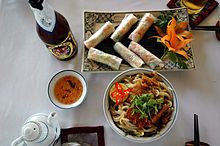
Food is at the very core of Vietnamese culture: every significant holiday on the Vietnamese cultural calendar, all the important milestones in a Vietnamese person's life, and indeed, most of the important day-to-day social events and interactions - food plays a central role in each. Special dishes are prepared and served with great care for every birth, marriage and death, and the anniversaries of ancestors' deaths. More business deals are struck over dinner tables than over boardroom tables, and when friends get together, they eat together. Preparing food and eating together remains the focus of family life.
Yelp and Tripadvisor are not widely used by locals in Vietnam, and reviews on those directories are usually posted by tourists. Foody is the go-to restaurant rating directory for the Vietnamese, and also functions as a food delivery and restaurant reservation app. While the interface is available in English, the downside is that almost all reviews are in Vietnamese.
Vietnamese cuisine varies from region to region, with many regions having their own specialties. Generally, northern Vietnamese cuisine is known for being subtle, central Vietnamese cuisine is known for being spicy, while southern Vietnamese cuisine is known for being sweet. There is also distinctive Vietnamese-Chinese cuisine to be found in Ho Chi Minh City's Chinatown.
At the same time, the Vietnamese are surprisingly modest about their cuisine. (An old proverb/joke says that "a fortunate man has a French house, a Japanese wife, and a Chinese chef.") High-end restaurants tend to serve "Asian-fusion" cuisine, with elements of Thai, Japanese, Chinese, and occasionally French mixed in. The most authentic Vietnamese food is found at street side "restaurants" (A collection of plastic outdoor furniture placed on the footpath), with most walk-in restaurants being mainly for tourists. Distinct regional styles exist: northern, central, and southern, each with unique dishes. Central style is perhaps the most celebrated, with dishes such as mi quang (wheat noodles with herbs, pork, and shrimp), banh canh cua (crab soup with thick rice noodles) and bun bo Hue (beef soup with herbs and noodles).
Many Vietnamese dishes are flavoured with fish sauce ( nước mắm ), which smells and tastes like anchovies (quite salty and fishy) straight from the bottle, but blends into food very well. (Try taking home a bottle of fish sauce, and using it instead of salt in almost any savoury dish: you may be pleasantly surprised with the results.) Fish sauce is also mixed with lime juice, sugar, water, and spices to form a tasty dip/condiment called nước chấm , served on the table with most meals. Vegetables, herbs and spices, notably Vietnamese coriander or cilantro ( rau mùi or rau ngò ), mint ( rau răm ) and basil ( rau húng ), accompany almost every dish and help make Vietnamese food much lighter and more aromatic than the cuisine of its neighboring countries, especially China.
Vietnam's national dish is phở (pronounced like the fu- in funny , but with tone), a broth soup with beef, pork, chicken or seafood and rice noodles (a form of rice linguine or fettuccine). In the south, phở is normally served with plates of fresh herbs (usually including Asian basil), cut limes, hot chilies and scalded bean sprouts which you can add according to your taste, along with chili paste, chili sauce, and sweet soybean sauce, while in the north, it is usually served only with fried quẩy fritters and chilli sauce on the side. Phở bò , the classic form of phở, is made with beef broth that is often simmered for many hours and may include one or more types of beef (skirt, flank, tripe, etc.). Phở gà is the same idea, but with chicken broth and chicken meat, so is Phở thit lon with pork, Phở tom with shrimp, Phở ca with fish, and Phở chay with tofu and vegetable stock. Phở is the original Vietnamese fast food, which locals grab for a quick meal. Most phở places specialize in phở and can serve you a bowl as fast as you could get a Big Mac. It's available at any time of the day, but locals eat most often Phở chay for breakfast. Famous phở restaurants can be found in Hanoi. The phở served at roadside stalls or informal restaurants tend to be cheaper and taste better than those served in fancier restaurants.
Street side eateries in Vietnam typically advertise phở and cơm . Though cơm literally means rice, the sign means the restaurant serves a plate of rice accompanied with fish or meat and vegetables. Cơm is used to indicate eating in general, even when rice is not served (i.e., An cơm chua? - Have you eaten yet) Though they may look sketchy, street side eateries are generally safe so long as you eat at places popular among the locals and avoid undercooked food. Many street food stalls do not display their prices; those outside tourist areas usually charge foreigners honestly, but ask for the price before you order to be sure.
In rural and regional areas it is usually safest to eat the locally grown types of food as these are usually bought each day from the market. It is not uncommon that after you have ordered your meal a young child of the family will be seen running out the back towards the nearest market to purchase the items.
Most restaurants/cafes in Vietnam will have a bewildering variety of food available. It is very common for menus to be up to 10-15 pages. These will include all types of Vietnamese food, plus some token Western food, possibly some Chinese-style ribs and maybe a pad Thai as well. It is generally best to stick with the specialty of the area as this food will be the freshest and also the best-prepared. As in other South East Asian countries, the menu is often more an indication of what a restaurant can cook and not all items may be available at any given time.
In restaurants it is common practice for the wait staff to place a plastic packet (stamped with the restaurant's name) containing a moist towelette on your table. They are not free. They cost 2,000–4,000 dong. If you open it, you will be charged for it. Also, peanuts or other nuts will be offered to you while you are browsing the menu. Those are not free, either. If you eat any, you will be charged.
Coffee , baguettes , and pastries were originally introduced by the French colonisers, but all three have been localised and remain popular. More on cà phê below, but coffee shops that also serve light fare can be found in almost every village and on many street corners in the bigger cities. Bánh mì are freshly baked baguettes, most commonly filled with grilled meats or liver or pork pâté plus fresh herbs and vegetables as bánh mì thịt , but there are countless variations filled with egg, beef, meatballs, pork skin etc. They are delicious and should be enjoyed at least once during a visit, and can easily be found from the bánh mì carts that are ubiquitous on the streets of Vietnam.
Vietnamese waters are in danger of collapse from over-fishing. Nevertheless, for the moment if you like seafood , you may find bliss in Vietnam. The ultimate seafood experience may be travelling to a seaside village or beach resort area in the south to try the local seafood restaurants that serve shrimp, crab, and locally-caught fish. Follow the locals to a good restaurant. The food will still be swimming when you order it, it will be well-prepared, very affordable by Western standards, and served in friendly surroundings often with spectacular views.
Most restaurants' hours are 10:00-22:00, although places serving breakfast-type items like noodles will open and close earlier. In 24-hour restaurants, there will be two prices. Prices are normal from 06:00 to 22:00, then doubled from 22:00 to 06:00. For example, rice usually costs 10,000 dong, but if you order after 22:00, the price will be 20,000 dong. This policy is government-mandated, to discourage people from eating late. Some dishes are not served after 22:00.
Cuisines other than Vietnamese, as well as fast foods, are increasingly available in the larger cities in the South and Central regions, less so in the North. Chinese, Japanese, Korean, Thai, Lao and other Asian restaurants are commonplace and Italian, French, German, Mexican, Russian, Ukrainian and Armenian restaurants can be found in most large cities in the South and Centre, as well as British, Irish an Australian food in bars and pubs. There is usually at least one Indian restaurant in most large towns and cities all over the country, many offering excellent quality food. Increasingly more affluent Vietnamese are sampling the different cuisines now available in their country so the chances of eating in a tourist ghetto are diminishing.
Dietary restrictions [ edit ]
Vegetarian food is quite easy to find anywhere in Vietnam due in large part to the Mahayana Buddhist influence, and all Vietnamese Buddhist monks are required to be vegetarian. Vegetarian eateries range from upscale restaurants to cheap and basic street stalls. Any Vietnamese dish with meat can be made vegetarian with the addition of fake meats. Besides the Buddhist influence of two vegetarian days a month, Cao Dai people eat vegetarian for 16 days. Look for any signs with the word chay as a suffix, like cơm chay for vegetarian rice dishes, phở chay for vegetarian pho, or bánh mì chay for vegetarian sandwiches. The words quán chay and nhà hàng chay literally translate as "vegetarian restaurant". It is also helpful to remember the phrase " ăn chay ", essentially meaning "I am a vegetarian". Even if you are not a vegetarian, a visit to a Vietnamese vegetarian restaurant will add a few new flavours that you won't find elsewhere. Also vegetarian food tends to be cheap which can help eke out the most hardened meat eaters budget. Be careful at regular stalls and restaurants though, as even dishes that seem vegetarian on the surface can sometimes make use of non-vegetarian seasonings such as fish sauce. As Vietnamese food traditionally does not use dairy products, vegetarian food in Vietnam is usually safe for vegans , but be careful to make sure it does not contain eggs.
Halal food is rare in Vietnam due to the small size of the Muslim community. Halal restaurants are mostly concentrated in Ho Chi Minh City and Hanoi , many of which are operated by immigrants from South Asia, Indonesia or Malaysia. The Mekong Delta and Ho Chi Minh City are also home to Muslim Cham communities, some of whom operate food stalls serving halal versions of Vietnamese street dishes for their respective communities. Kosher food is nearly unknown; if you keep kosher, contact Chabad Vietnam well in advance of your trip for assistance.
Drink [ edit ]
Drinking in a Vietnamese bar is a great experience. One of the interesting things is that during the day, it is almost impossible to see a bar anywhere. Once the sun goes down though, dozens appear on the streets out of nowhere.
Watch out for ice in drinks. Factory-made ice is generally safe, but anything else can be suspect. Factory ice has a hollow, cylindrical shape. Avoid irregular chunks of ice as it may be unclean.
Beer [ edit ]
The main brews are light lagers with a strength of 4.5–4.9%. In supermarkets a 0.33L can of beer starts at 10,000 dong. Some cheap beers in plastic bottles (0.9L) can be had for 15–18,000 dong. "Saigon" in a 0.45L glass bottle starts at 11,000 dong, but sometimes a deposit of 3,000 dong is added. A beer in a bar starts at around 20,000 dong.
The most popular beer (draught, bottle or can) among the southern Vietnamese is Saigon Do (Red Saigon) . For the northern Vietnamese Bia Hanoi (Hanoi beer) is the most popular brand, whereas central Vietnamese prefer Bière Larue from Da Nang or Bia Huda from Hue. 333 , pronounced "ba-ba-ba" is a local brand, but it's somewhat bland; for a bit more flavour, look for Bia Saigon in the green bottle and a bigger bottle than Bia Saigon Special. Bia Saigon is also available as little stronger export version. Locally brewed foreign brands like Tiger and Heineken are also common.
The craft beer revolution has well and truly reached Vietnam and bottled IPAs, brown beers and stouts are available in the major cities. Ho Chi Minh boasts an increasing number of brew-pubs and microbreweries. These brews are available at a fraction of the price they cost in Thailand or Singapore.
Beer in Vietnam is usually served in glasses filled with (and is thus drunk with) ice. This means that the cans or bottles of beer need not be chilled. If you are drinking with Vietnamese people, it is considered polite to top up their beer/ice before re-filling your own drink. It is also considered necessary to drink when a toast is proposed: "mot, hai, ba, do" ("one, two, three, cheers"). Saying "Trăm Phần Trăm" (100% 100) implies you will empty your glass.
Coffee [ edit ]
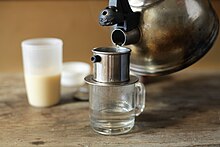
Coffee is usually served black ( Cà Phê Đen (Đá) ) or with sweetened condensed milk ( Cà Phê Sữa (Đá) ) — usually over ice ( Đá ). Ask for (Cà Phê) Nóng if you want your coffee hot without ice. Some people may add extra water with the hot version (see picture) to make the coffee less strong — the ice version gets less strong automatically. Also, locals tend to drink their Cà Phê Đen incredibly strong with up to 4 teaspoons of sugar. If you want black coffee without sugar, say so.
However, the slow dripping coffee through the metal filter seems distinct for tourist frequented places. Normal Vietnamese don't take or have the time to prepare nor wait that long. Hence, in less touristy places you will have a hard time finding the slow-filter version, they often won't have these filters and just serve already prepared coffee, often with the condensed milk already in the glass. If you want the milk separately, say so.
Take-away coffee ( Cà Phê Mang Đi ) with ice in a plastic cup and straw along the street can already be had for 10–12,000 dong.
In Hanoi , Cà Phê Trứng (egg coffee) is a local speciality.

A late addition to the coffee culture of Vietnam and often served for take-away are Cà Phê Muối (salted coffee) and Cà Phê Cốt Dừa (coconut coffee), basically a Cà Phê Sữa Đá topped with a cool mountain of salty whipped cream or sweet fluffy coconut slush, respectively. These are especially popular with the younger generation, but also tourists enjoy them.
Soft drinks [ edit ]

- Coconut water directly from the coconut is popular all around the country. After drinking the water, let the seller open the coconut, ask for a spoon, and enjoy the sometimes jelly-ish inner coconut meat. (If the coconut is too mature, the meat will be very hard and you are out of luck using the spoon, but the seller will know.)
- Nước Mía , or sugar cane juice , is served from distinctive metal carts with a crank-powered sugar cane stalk crushers that release the juice.
- Sinh Tố is another fabulous thirst quencher, a selection of sliced fresh fruit in a big glass, combined with crushed ice, sweetened condensed milk and coconut milk. You can also have it blended in a mixer. You could place any fruit-type after the word sinh tố , e.g., sinh tố bơ (avocado smoothie) or sinh tố dứa (pineapple smoothie). If you prefer to have orange juice, you won't use the word sinh tố but nước (literally: water) or nước cam if you would like to have an orange juice. Juices are usually without condensed milk or coconut milk.
- Chè Thái (Thai tea), Trà Trái Cây (fruit tea), or Trà Sữa (milk tea) are tea-based ( chè , trà ) dessert mix drinks made with various jellies, assorted tropical fruits, crushed ice, and (condensed) milk — kind of an advanced bubble tea, refreshing and colorful with a variety of textures, but it can be quite sweet if you don't watch it. Various word combinations exist to denominate this kind of drink.
Wine and liquor [ edit ]
Vietnamese "rượu đế" or rice alcohol ( rượu means liquor or wine [not beer]) is served in tiny porcelain cups often with candied fruit or pickles. It's commonly served to male guests and visitors. Vietnamese women don't drink much alcohol, well at least in public. It's not recommended for tourists.
Dating back to French colonial times, Vietnam adopted a tradition of viticulture. Dalat is its centre, and you can get red and white wine . There is a better range and better quality red wines than whites as reds seem to appeal more to the Asian palate. Most restaurant wine is Australian and you will be charged Australian prices as well, making wine comparatively expensive compared to drinking beer or spirits. Vietnamese wine has hit the mass market and is available by the glass or bottle in many restaurants. The quality ranges from the just-about-drinkable Vang Dalat Classic to the more than palatable Vang Dalat Premium. In supermarkets a bottle of Classic can be bought for around 80,000 dong whilst Premium is around 120,000. In restaurants a bottle of Classic costs 120,000–150,000 dong. Premium is less widely available in restaurants and where it is costs around 200,000 dong a bottle.
Imported wines, mainly Australian, French and Chilean are also available in supermarkets and in mid range and high end restaurants at far more expensive prices.
Rice spirits and local vodka is cheap in Vietnam by Western standards. Local vodkas cost about US$2-4 for a 0.75L bottle. Russian champagne is also common. When at Nha Trang, look for the all-you-can-drink boat trips for around US$10-15 for an all-day trip and party with on-board band.
Sleep [ edit ]

Lodging is not an issue in Vietnam, even if you are travelling on a tight budget. Accommodation in Vietnam ranges from 100,000-dong dorm accommodation in hostels to world-class resorts, both in large cities and in popular coastal and rural destinations. Even backpacking hostels and budget hotels are far cleaner and nicer than in neighboring countries (Cambodia, Thailand, Laos). And even cheap hotels that charge as little as 250,000 dong for a double room are often very clean and equipped with towels, clean white sheets, soap, disposable toothbrushes and so on.
Service in many of the very inexpensive hotels is quite good (since the rate that a person pays per night could equal a typical Vietnamese national's weekly pay), although daily cleaning and modern amenities like television may not be provided. In hotels costing a few dollars more (300,000+ dong, more in Hanoi) you can expect an en-suite bath, telephone, AC and television. As with hotels elsewhere in the world, mini-refrigerators in Vietnamese hotels are often stocked with drinks and snacks, but these can be horribly overpriced. You are much better off buying such items on the street. Adequate plumbing can be a problem in some hotels, but the standard is constantly improving.
It is a legal requirement that all hotels register the details of foreign guests with the local police. For this reason they will always ask for your passport when you check in. The process usually only takes a few minutes, after which they will return your passport. However, because non-payment by guests is by no means unknown, some hotels retain passports until check-out. If a place looks dodgy, then ask that they register you while you wait and take your passport with you afterwards. Few people have had a problem with this as it is routine across the country. You might find it helpful to carry some photocopies of your passport (personal data page and visa) which you can hand over to the hotel.
Hotels can be noisy, particularly when local families are staying. Vietnamese is one of the world's more vocal languages, and local tourists are happy to give full vent to it from 06:00 onward with scant regard for fellow guests. There are also a number of other sounds to be aware of when staying in Vietnamese hotels. Vietnam is a country under construction and the chance of the hotel being next to or very close to a building site is high. Also rooms in many small boutique hotels, guesthouses and home-stays are built fronting a central atrium or stairwell and the activities of the reception, common area and kitchen contribute more noises. Finally, there are the room-maids who start work soon after dawn and seem to think that you should be awake by then and consequently feel free to chat with each other at a loud volume and send and receive messages on mobile phones and walkie-talkies. If you are a light sleeper, bring a supply of earplugs.
Learn [ edit ]
If you want to meet local people, stop by a school. In Ho Chi Minh City, visit the American Language School, where you'll be welcomed enthusiastically and invited to go into a class and say hi. You'll feel like a rock star. The Vietnamese love to meet new people, and teachers welcome the opportunity for their students to meet foreigners.
An excellent novel set in modern-day Vietnam is Dragon House by John Shors. It's the story of two Americans who travel to Vietnam to open a centre to house and educate Vietnamese street children.
Former BBC reporter in Hanoi, Bill Hayton, has written a good introduction to most aspects of life in Vietnam, the economy, politics, social life, etc. It's called Vietnam, Rising Dragon , published in 2010.
Vietnam also has numerous universities for people who wish to pursue higher education. The most prestigious among them is Vietnam National University, Hanoi , originally founded by the French as Université Indochinoise in 1906. Other notable universities include Vietnam National University, Ho Chi Minh City and Hanoi University of Science and Technology
Work [ edit ]
You can volunteer as an English teacher through many volunteer organisations. However, if you have a TEFL/TESOL qualification and a degree then it's very easy to find paid teaching work. Without qualifications it's also possible to find work, but it takes more patience to find a job, and often there are concessions to make with payment, school location and working hours (weekends). Most teaching jobs will pay US$15-20 an hour. There are also many you-pay-to-volunteer organisations which allow you to help local communities, such as Love Volunteers , I to I and Global Volunteers . (But you must avoid some organized fraud. Ex: V4D, VTYD, RAKI, VVN...) Vietnam also has a booming tech startup scene, so opportunities may be available for people with expertise in computer science or other closely-related fields.
Legally, a work permit is required to work in Vietnam, although many foreigners do not bother, especially if the intention is to work for only a short period of time. Visa extensions are generally easy to obtain (your school will have to do this for you) although the immigration department will eventually insist on you obtaining a work permit before any more visas are issued. If your aim is to remain for a longer term, then it is possible to obtain a work permit although your school will need to do this for you. To apply, your employer will be required to submit the following: A contract and application letter from your school; a full, medical health check (done locally); a criminal record check (the criteria for this varies from province to province, some requiring a check from your home country, others, a check done solely in Vietnam); a copy of your TESOL/CELTA/TEFL and degree certificates; your 'registration of stay' form; a copy of your passport/visa. Sometimes, you may be asked to pay a small fee although the better schools will generally offer to do this for you. Work permits are valid for 3 years and are renewable for a period of up to 12 years.
Once you have a work permit, it is then a relatively simple process to apply for a temporary residence permit, which will alleviate your visa worries. The validity and procedure for renewal is the same as a work permit.
Vietnam has made a huge leap forward in terms of economic development and tourism, and many of the most feared annoyances are minor concerns. Vietnam is still a poor country, though. Tourists are considered money mules, and milking them is no crime. Nevertheless, outside of tourist hotspots, crime and scams against foreigners are rare.
Unexploded ordnance [ edit ]
As a legacy of the Indochina Wars , much of Vietnam's countryside is still littered with unexploded bombs and landmines, and many locals are still killed or maimed by them. Be very careful about going off the beaten path in rural areas, and ideally do not do so unless you have a guide who knows the area well.
Crime [ edit ]
Vietnam is a relatively safe place for tourists, and especially when travelling in groups. It will also depend on your nationality whether you may encounter issues — large western men are much more intimidating than smaller Japanese women, see cyclo scam.
Tourist areas are hotspots of petty crime. Violent crime towards foreigners is uncommon, but pickpockets and motorbike snatching are not uncommon in larger cities. Thieves on motorbikes snatch bags, mobile phones, cameras, and jewellery from pedestrians and other motorbike drivers. Don't wear your bag on your shoulder when riding a motorbike. Don't place it in the motorbike basket. When walking along a road, keep your bag on your inboard shoulder. If your bag is snatched, don't resist to the point of being dragged onto the roadway.
Reports of thefts from hotel rooms, including upmarket hotels, have been heard occasionally. Do not assume that your hotel room strongbox is inviolable.
Avoid fights and arguments with locals. Westerners may be bigger than Vietnamese, but if you're dealing with 5 or more Vietnamese guys then you're in serious trouble. Yelling is highly insulting to Vietnamese and may prompt a violent response. Vietnamese in general are placid and kind. As a visitor, you should respect local laws and customs. Altercations can be avoided easily by showing courtesy and tolerating cultural differences. Be on your best behaviour when drinking with Vietnamese men.
Corruption [ edit ]

The international monitoring group Transparency International has rated Vietnam as one of the most corrupt nations in Asia. Locals are convinced that the police are not to be trusted.
Motorcycle drivers may be stopped for a variety of reasons such as random checks of paperwork and licences and will fine foreigners around US$20 for each offence (the average traffic fine for locals is around US$5-10). Be polite but resolute, and stand your ground. Traffic officers are required to write traffic violations in their notebook and must give you a receipt for your fine which must then be paid at the station (not to the officer). For some offences (especially missing paperwork relevant to the vehicle you are riding), officers have the right to confiscate and impound your bike. If you have a phone, you could threaten to call your embassy and he may back down, although in most cases, it is often best to prevent any further escalation of the situation by paying the fine.
You generally won't encounter any problems with the police in more remote or rural areas because officers are likely to have a very poor command of the English language. The larger cities and areas that are frequented by tourists have more police who are proficient in communicating with tourists.
Immigration officers at land borders are known to demand bribes to stamp you in or out of the country. Refusing to pay the bribe will usually mean you are denied entry or not allowed to leave. The reputable bus companies will often charge a "border crossing fee" for their international routes, and staff would usually process you through immigration while you wait on the bus, and any bribes are included as part of that fee.
Most government offices will also require a small "gratuity" before processing paperwork. This is most commonly encountered when trying to obtain permits of residence for private accommodation, or work or residence permits.
Prostitution [ edit ]
Despite its seeming abundance, prostitution is illegal in Vietnam. The age of consent is 18. Vietnamese penal law levies penalties of up to 20 years in prison for sexually exploiting women or children, and several other countries have laws that allow them to prosecute their own citizens who travel abroad to engage in sex with children.
Under Vietnamese law, it is illegal for a foreigner to take a Vietnamese national to a hotel room. While this law is rarely enforced, you could find yourself in even deeper water if you report a crime disclosing that you shared a room with a Vietnamese national.
HIV/AIDS is prevalent in Vietnam, and many people go untreated due to the taboo nature of the disease. There is also a danger of theft when taking any unfamiliar woman back to a hotel or guest house. The tale of a man waking up to find his wallet, mobile phone or laptop missing is all too common. Stories also abound of Westerners being drugged while in a hotel room or being led to a dark, quiet place where they are relieved of their possessions by criminal gangs.
Scams [ edit ]
Most scams in Vietnam involve transportation, hotel prices, or the two-menu system practised by some restaurants.
Taxis [ edit ]
If you don't know what a reasonable fare is, it is generally a bad idea to agree on a price in advance. Rule of thumb to detect scammers: if the taxi doesn't have the fare charges written, or drivers name and photo on the dashboard, immediately ask the taxi to stop and get out. It is a definite scam.
As always, it is advisable to walk a hundred meters away from any tourist deposit point (bus arrival, train station etc.), as many taxi waiting here are either scammers or pay a commission to the cartel.
Many taxi drivers in Saigon and Hanoi try to overcharge newly arrived gullible travellers. When leaving the airport, the taxi driver may insist that you pay the airport toll. He might not be very forthcoming with the price, and if you give him cash, he will pay the toll and pocket the rest. The toll is 10,000 dong (July 2018) and having the correct money will avoid you getting fleeced. The toll is quoted along with the fare written on the dashboard of the taxi. You can confidently say "airport toll only 10,000 dong" and refuse to pay anything else such as parking (unless there were more toll roads in between).
Ask your hotel or hostel to arrange taxi services for you. This will ensure that you get a flat quoted rate as well as a trusted driver. Many hotels will be happy to arrange pick up and drop off from airports if you ask. Nevertheless, this can be more expensive than if you arrange it directly yourself, because the hotel will always try to cut into the deal, earning a little extra.
In several other cities of Vietnam, such as Dalat, Hoi An, Nha Trang, etc., do not travel by meter from the airport. The airports are as far as 30–40 km from these places and meter will cost you from 500,000–650,000 dong. However, you can either take a bus from the airport to city centre, or pre-negotiate a rate with the taxi for 200,000–300,000 dong. Pay attention to sides of taxis. Usually a rate for the airport is written on the door. Around town in these cities, metered taxis generally work fine.
If you ever get caught in a big taxi scam (such as rigged meter), you should get out of the vehicle and retrieve your belongings as if everything was all right, then refuse to pay the demanded price and threaten to call the police. Usually they will accept a more reasonable fare, but be prepared to face the driver's anger, so it is better to do this with a few witnesses around.
Taxi and cyclo drivers [ edit ]
Taxi and cyclo drivers may claim that they don't have change when accepting payment for an agreed-upon fare. The best way to handle this is to either carry smaller bills or be ready to stand your ground. Generally, the driver is only trying to get an extra dollar or so by rounding the fare up, but to prevent this scam from becoming more popular it is advised to stay calm and firm about the price.
When you meet an over friendly cyclo driver who says, "never mind how much you would pay" or "you can pay whatever you like at the end of the trip". He may try to show you his book of comments from international tourists. This kind of driver has to be a scammer. If you still want to use his service you should make it clear about the agreed price and don't pay more than that. Just be clear what you are willing to pay. The cyclo drivers are just trying to make a living.
Hotels [ edit ]
Hotel owners may tell you that the room price is 200,000 dong. However, when checking out, they may insist that the price is US$20, charging you almost double. Another trick is to tell customers that a room is a few dollars, but following day they will say that price was for a fan room only and it's another price for an air-con room. These days, legitimate hotel owners seem to be aware of these scams and are usually willing to help by writing down how much the room is per person per day (in U.S. dollars or dong), if it has air-con or not. Staff of legitimate hotels also never ask for payment from a guest when they check in. Watch out if they insist that you should pay when you check out but refuse to write down the price on paper. Otherwise, just book online with one of the common reservations websites, which will guarantee you the right price, and leave a review if something goes wrong.
As of 2019 most of the dollar versus dong scams have ended as almost all hotels now quote in dong and accept dong. Keep your dollar stash hidden and deal only in dong. Also as of 2019 quite a few low- to mid-range hotels do require payment upfront and as long as you get an official receipt there is nothing to worry about in this.
Restaurants [ edit ]
Some restaurants are known to have two menus, one for local people and another one for foreigners. The only way to deal with it is to learn a few Vietnamese phrases and insist that you should be shown only the Vietnamese menu. If they hesitate to show you the local menu, walk away. This scam is very unusual.
Hostels [ edit ]
Some hostels in Vietnam will want you to leave your passport at the reception, insisting even. This is not a legitimate business practice. Never leave your passport as collateral for anything.
Copycats [ edit ]
Besides accommodation and transport, another big scam in Vietnam involves copycat tour companies and restaurants. Anytime a company gets famous, copycats will pop out. A very famous example is the dozens of Sinh Cafes (bus company), which popped up. The real company has since changed its name to TheSinhTourist.
Fake monks [ edit ]
Buddhism in Vietnam generally follows the Mahayana school, meaning that the monks are required to be vegetarian and generally do not go on alms rounds. Instead, the monks either grow their own food or buy their food using temple donations. Monks do not sell religious items (shops selling religious items are staffed by laypersons, not by monks) or ask people for donations. Instead, donations are to be placed in temple donation boxes. It is entirely up to an individual to decide whether or not they wish to donate, and how much they wish to donate, and genuine temples will never use high-pressure tactics to solicit donations. "Monks" who approach tourists for donations are imposters.
Traffic [ edit ]

The first discovery for many tourists who just arrive in Vietnam is that they need to learn how to cross a road all over again. You may see a tourist standing on the road for five minutes without knowing how to cross it. Traffic in Vietnam can be a nightmare. Back home, you may never witness the moment of crash, seeing injured victims lying on the road, or hearing a BANG sound. Staying in Vietnam for more than a month, you will have fair chance of experiencing all these.
Roads are packed. Some intersections in main cities such as Hanoi, Ho Chi Minh City have traffic lights patrolled by police; most are either non-functional or ignored.
Crossing roads is an art in most of Vietnam, and there are no stop signals that will actually be followed by drivers. The art of crossing the road is fortunately very simple, though scary:
- There are some traffic lights and pedestrian crossings but they are by no means everywhere.
- If it is night time, and you are wearing dark clothes you should cross in a bright area or shine a torch towards the traffic
- If there is a bus, car or taxi, wait until it and its motorcycle entourage passes, as vehicles will not stop for pedestrians
- Ensure you, your fellow travellers and every piece of your luggage form an almost perfect line parallel with the traffic
- There is no 'ideal' time to start although you could pick a time with a little less traffic
- Step a little forward, a little more, and you will see motorcycle drivers to slow down a bit, or go to another way. Make your pace and path predictable to other drivers, don't change your speed or direction suddenly, and move forward until you arrive at your destination. Be aware that motorcycle drivers will swerve to avoid you but might swerve into your path.
- The simplest and best way to cross streets is to make yourself known and be steady. This means spread your arms out and walk at a steady pace. The locals will route around you. They are extremely good drivers and will avoid hitting you; just be sure to walk at a steady pace.
- Cars, buses and trucks can do you far more damage than motorcycles where the odds are much or even. Wait for anything with four or more wheels to pass and then take on the motorcycles.
The simplest way, if available, is to follow a local, stand next to them on the opposite side of the traffic (if you get hit, he will get it first) and he will give you the best chance of crossing a road.
If you are injured, don't expect the local people to help, even by calling an ambulance, because it is not free. Make sure you tell the local clearly that you will pay the ambulance fee. Hospitals will also not admit you until you prove that you can pay the bill.
Highways are risky, with an average of 30 deaths a day, and some locals will not even venture on them if not in a big vehicle (car or bus). Taking a bicycle or motorbike on highways is an adventure for risk takers, but definitely not for a family with children. Having said that, Vietnamese roads are no more dangerous than elsewhere in South East Asia.
Nightlife [ edit ]
- Petty crime in nightclubs is not unknown. Don't escalate an incident: avoid quarrelling with local people as drunks can be violent.
- Clubs are full of working girls trawling for clients. They may also be looking for wallets and mobile phones.
- Walking very late alone on the streets in the tourist areas is safe, but avoid unfamiliar women engaging you in conversation. They may try to touch you, sweet talk you, and then pick your pocket.
- Don't ask taxi drivers to recommend nightspots. Most taxi drivers earn commissions from bars and lounges to bring in foreign tourists. When you walk into one of these places, they will quote reasonable prices, but when you receive the tab, it may include extravagant charges. Do your homework beforehand, tell the taxi driver where you want to go, and insist on going to where you want to go despite their remonstrations. Most nightspots are reputable. Going to those with a mostly foreign clientele is a good practice.
Wildlife [ edit ]
Little wildlife remains, let alone anything dangerous to humans. Venomous snakes, such as cobras, may still be common in rural areas, but virtually everything else has either become extinct or exists in such small numbers that the chances of even seeing one are remote. Tigers may exist in very small numbers in remote areas, but this is unconfirmed.
LGBT travellers [ edit ]
Vietnam is generally a safe destination for LGBT travellers, and there are no laws against homosexuality in Vietnam. Transgender persons are allowed to change their legal gender after undergoing sex reassignment surgery. That being said, same-sex relationships are not recognised by the government, and the Vietnamese can be rather conservative, meaning that LGBT individuals can often be subject to some degree of prejudice. Fortunately, anti-LGBT violence is extremely rare.
Insulting national heroes such as Ho Chi Minh and Vo Nguyen Giap is illegal in Vietnam, and many foreigners have been jailed for doing so.
Stay healthy [ edit ]
Tropical diseases such as malaria , dengue fever and Japanese encephalitis are endemic in rural Vietnam. Malaria isn't as much a concern in the bigger cities such as Ho Chi Minh City and Hanoi, but always remember to take liquid mosquito repellent with you. It may be very useful, especially in the countryside and crowded neighborhoods.
Street food , including blended ice drinks, and food in restaurants is mostly safe to be consumed due to much improved hygiene. Vietnamese are very clean people, there are bins everywhere and interiors/floors are mostly tiled. Use common sense and follow the tips under the Traveller's diarrhea article and you will be fine.
Tap water is not safe to drink.
Contact lens solution is seldomly sold by pharmacies. You will have to find to specialised lens store or an optometrist to get it.
Healthcare [ edit ]
Vietnamese hospitals are generally not up to Western standards. Hospitals are often short of medicines and other supplies, and waiting times can be long, even in acute cases. Outside Hanoi, Ho Chi Minh City and Da Nang, few doctors speak English. Private clinics in Vietnam, run by foreigners, are therefore recommended as the first port of call. These clinics have both Vietnamese and foreign doctors. In general, hospitals will only accept your case if you can demonstrate the ability to pay for their services.
There are private hospitals in Hanoi, Ho Chi Minh City and Da Nang that cater mainly to Western expatriates and provide excellent healthcare, with staff members who are able to speak English and French, though you would be paying a steep premium for their services. Vinmec International Hospital is a chain of expatriate-oriented private hospitals with locations in several of Vietnam's larger cities.
Private hospitals in Hanoi recommended for travellers to Hanoi include Hanoi French Hospital, International SOS Clinic Central Building, Hanoi Family Medical Practice.
In Ho Chi Minh City, hospitals recommended for travellers include Franco-Vietnamese Hospital, City International Hospital, Columbia Asia Gia Dinh International Clinic, Columbia Asia Saigon International Clinic, HCMC Family Medical Practice Diamond Plaza, International SOS Clinic Hannam Building, Hoan My Medical Corporation chain.
If you fall seriously ill while travelling, it is advisable to seek treatment in nearby Southeast Asian countries if possible. In serious cases, doctors may even order the patient to be flown to Singapore or Thailand for treatment. When travelling to Vietnam, it is very important to take out comprehensive travel insurance. Please read the terms and conditions of your travel insurance carefully.
In tourist destinations, you can ask for medical services at hotel reception desks or from your tour operator. In many cases, you may have to pay cash in advance to see a doctor. In larger cities, payment can usually be made by debit card. Keep receipts for insurance purposes.
The emergency number for ambulances in Vietnam is 115, but the emergency number usually does not serve in English. Public ambulances can be slow to arrive, so it is usually best to take a taxi, for example. If you call an ambulance, be prepared for a long waiting time. Paramedics do not usually speak English and ambulances are poorly equipped. In large cities, hospitals also have private ambulances, which are usually more efficient than public ambulance services.
In large cities such as Hanoi and Ho Chi Minh City, there are a number of good quality pharmacies. Most private hospitals and clinics also have a pharmacy. Pharmacies are usually well-stocked and most medicines can be bought without a prescription.
Pharmacies in Vietnam are not strictly regulated. If you buy medicines from a pharmacy other than a hospital pharmacy, it is a good idea to check the expiry date of the medicine packs you buy. The packaging, the contents of the packs and any instructions for use should be checked carefully.
Respect [ edit ]
In traditional Vietnamese culture, elders are treated with great deference and respect. While expectations are more relaxed when foreigners are involved, it's a good idea to show politeness, respect and restraint towards those who look older than you.
It's common to be stared at by locals in some regions, especially in the rural areas outside of big cities, and in the central and northern parts of the country. Southerners are usually more used to foreigners. Wherever you are, though, expect some probing questions whenever a conversation starts: How old are you? Are you married? Do you have children? While these might seem nosy in the West, they're perfectly normal, good-natured questions here that help people determine how they should address you. The best thing to do is just play along. You probably don't know much about their culture; it's only fair that locals wouldn't know much about yours.
An Asian woman travelling with a non-Asian man often attracts a more undesirable kind of attention. Probably due to memories of the sexual escapades of GIs during the American War, people will often assume she is an escort or prostitute, and she may be insulted or harassed, even if she has no relationship to the man. These prejudices have lessened somewhat, but they are still present. As of April 2019 these prejudices have almost completely disappeared for 'respectable looking Asian women' and the nearest they will get to a problem is that almost all locals will assume they are Vietnamese and seek to circumvent the English speaking foreigner by speaking Vietnamese to Thai/Chinese/Singaporean/ Australian-never-been-to-Vietnam before-but-looks Asian, wives or girlfriends. The Vietnamese themselves generally do not engage in public displays of affection, even among married couples, as it is considered to be disrespectful, so it is advisable for couples to show restraint while in public.
Vietnamese people tend to be dressed modestly and conservatively, though somewhat less so at bars and nightclubs in Hanoi and Ho Chi Minh City, where young locals can sometimes be spotted in sexy outfits. But generally, you should try to cover your shoulders and knees, as doing so will earn you a lot more respect from the locals.
Saving face is very important in Vietnamese culture. You should generally avoid pointing out the mistakes of others no matter how minor they might be in order to avoid causing major embarrassment.
As in many other Asian countries, you are expected to remove your shoes before entering people's homes.
When handing out and receiving business cards, always be sure to do it with both hands , as using only one hand is considered to be very disrespectful.
Relations with China are a sensitive issue best not discussed with locals. Tensions boil over periodically over territorial disputes in the South China Sea, called the "East Sea" ( Biển Đông ) in Vietnam — using the former name may offend locals by suggesting that you support China's claims. Possession of maps showing the nine-dash line is likely to elicit negative reactions from Vietnamese; this has also resulted in certain foreign movies and television series such as the 2019 animated film Abominable and the 2023 Barbie movie being banned in Vietnam.
However, China is Vietnam's largest trading partner and source of international tourists, and individual visitors from mainland China should not face any major issues so long as they avoid political discussions. This animosity towards China also generally does not extend to ethnic Chinese from other countries.
The American War [ edit ]
The most surprising thing about the topic of the Vietnam War (the American or Reunification War, as it is called in Vietnam) is that most Vietnamese do not bear any animosity against visitors from the countries that participated, and in the South many Vietnamese (especially older Vietnamese involved in the conflict or with relatives in the war) appreciate or at least respect the previous American-led or French-led military efforts against the North. Two-thirds of the population were born after the war and are quite positive towards the West. Some attractions present an anti-American viewpoint on the war, whilst many are surprisingly restrained.
Be sensitive if you must discuss past conflicts. Well over 3 million Vietnamese died, and it is best to avoid any conversations that could be taken as an insult to the sacrifices made by both sides during the wars. Do not assume that all Vietnamese think alike as some Vietnamese in the South are still bitter about having lost against the North.
Souvenir shops in Vietnam sell lots of T-shirts with the red flag and portraits of "Uncle Ho." Many overseas Vietnamese, particularly in the United States, Canada and Australia, are highly critical of the government of Vietnam, so you may want to consider this before wearing communist paraphernalia in their communities back home. A less controversial purchase if you are American, Canadian or Australian would be a nón lá (straw hat) instead.
Religion [ edit ]
Although the official census claims most Vietnamese are non-religious, you wouldn't know it to see them. Whether they attend services or not, most Vietnamese are in fact strong believers, incorporating a variety of religious traditions, beliefs and rituals into their daily lives.
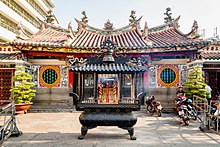
As in neighboring Southeast Asian countries, the most influential and widespread religion in Vietnam is Buddhism. Buddhism in Vietnam generally follows the Mahayana school, which is widespread in China, unlike the neighboring Southeast Asian countries which follow the Theravada school. This means that monks are required to be vegetarian, and pious individuals seeking a particular blessing will often forgo meat as well. Unlike in other Southeast Asian countries, it is not customary for monks to collect foodstuffs in the streets. Instead, they will either buy their food using temple donations, or grow their own food. Monks who hang out in tourist areas requesting donations are bogus. Similar to China and neighboring countries, Swastikas are commonly seen in Buddhist temples as a religious symbol; they are positive signs representing sacredness and blessing, and have no connection to Nazism or anti-Semitism.
Also, and more than in neighboring countries, Vietnam has a sizable proportion of Christians (11%; 9% Catholic, 2% Protestant). Christianity is especially prominent in major cities, where at least a few churches can be found. It is common for strangers and acquaintances to ask you to come to their church, although offence will not usually be taken if you decline.
Much like the Chinese and other Southeast Asians, Vietnamese people place a strong emphasis on spirits and ancestor worship. You'll see at least one shrine in every Vietnamese home and place of business, where occupants burn incense to honor or placate certain spirits. These are often decorated with statuettes or pictures of sacred figures: for devout Buddhists, this might be Buddha or Bodhisattva; for Roman Catholics, a crucifix or the Virgin Mary; for "non-religious" people, depictions of various traditional deities or spirits. If you see someone's photograph featured on a shrine, it's most often that of a family member who's passed away. Burning joss sticks (sticks of incense) for the spirits of departed family members is generally a token of respect.
Many temples require you to remove your shoes before you enter the temple buildings. As a general rule, you should always enter using the right gate and exit using the left gate (facing inward); the middle gate is traditionally reserved for the emperor and deities. Do not step on a raised doorway threshold when entering or exiting the temple; always step over it. Also be sure to dress conservatively when visiting temples; do not wear sleeveless shirts, and make sure your knees are covered.
Vietnamese are generally quite superstitious when it comes to death and the spirit world, and there are certain taboos you'll want to avoid. Some of these include:
- Placing chopsticks upright in the middle of a bowl of rice : Bowls of rice are arranged in this way next to the body of the deceased at funerals, so it reminds people of funerals. If you eat your rice with a spoon, place the spoon face down in the bowl, never face up.
- Taking photos of an odd-numbered group : The superstition goes that the person in the middle of a group will be singled out by evil spirits. Photos of even-numbered groups (2, 4, 6, or 8 people, and so on) are fine.
- Sitting with your back facing a family shrine : Considered disrespectful to the shrine, and to the spirits of the deceased.
- Climbing onto altars to pose for photographs with the statues : Considered very disrespectful to the deities being venerated.
Electricity [ edit ]
Electricity is delivered at 200 V, 50 Hz in Vietnam. Most Vietnamese sockets are compatible with the 2-pin American Type A, and the 2-pin European Type C, E and F plugs. Some sockets are also compatible with the 3-pin American Type B plugs.
Connect [ edit ]
Telephone [ edit ].
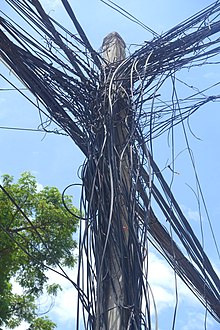
Land-line numbers in Hanoi and HCMC have a sequence of eight numbers, others have seven.
- Vietnam international code: +84
- Hanoi area code : (24)
- Ho Chi Minh area code : (28)
Telephone bills are 30% to 40% cheaper if dialed with 171 or 178 services.
- Domestic call : 171 (178) + 0 + Area code + Number.
- International call : 171 (178) + 00 + Country code + Area code + Number.
Since hotels and guesthouses often charge higher for telephone calls, try to find a post office or any reliable public service.
Mobile phones [ edit ]
Mobile numbers in Vietnam must always be dialed with all 9 or 10 digits (including a "0" prefixing the "1nn" or "9nn" within Vietnam), no matter where they are being called from. The 1nn or 9nn is a mobile prefix, not an "area code", as such and the second and sometimes third digits (the nn part) denotes the original mobile network assigned. As is the case with most mobile numbers, they can also be called within or outside Vietnam using the international format.
There are many mobile networks with different codes:
- Mobifone : 90, 93, 70, 76, 77, 78, 79
- Vietnamobile [dead link] : 92, 56, 58
- Viettel : 98, 97, 96, 32, 33, 34, 35, 36, 37, 38
- Vinaphone : 91, 94, 81, 82, 83, 84, 85
Prepaid account charges vary from 890–1,600 dong per minute. Recharge cards are available in denominations of 10,000, 20,000, 50,000, 100,000, 200,000 and 500,000 dong.
Useful numbers [ edit ]
- Fire Brigade 114
- Hospital 115
- General Information 1080
Internet [ edit ]
- SIM cards from all the main providers: Viettel, Vinaphone, Mobifone and Vietnam Mobile can be purchased on arrival in Ho Chi Minh or Hanoi. 100,000 dong buys 9 GB of data valid for 30 days, which is enough as long as you don't watch too many videos on your phone. If you intend to use your phone a lot, 30 GB data for 30 days costs around 330,000 dong. Providers offer phone packages as well, but for most tourists Facebook/Skype/Line calls are enough to keep in touch with friends and family, and your hotel can usually call taxis and bus companies, tourist informations, and any other place.
- Wi-Fi is now widespread in Vietnam and most hotels, restaurants and bars in the main tourist centres have free Wi-Fi. Ask for the password when you make your purchase. Sometimes the password is printed on the receipt or advertised near the counter. Otherwise, public plazas, most airports and many larger railway stations will also have Wi-Fi — wherever people or tourists frequent the place. Some Internet cafes are still available in tourist spots and rates are fairly cheap, ranging from 2,000-10,000 dong per hour. Connection speeds are high, especially in the big cities.
- Internet censorship is applied to a very small number of Internet services. Most foreign news sites like the BBC and CNN, as well as social media web-sites such as Facebook, Twitter and YouTube are usually freely accessible in Vietnam, though they may be temporarily blocked during politically sensitive periods. It may be wise to use a VPN service, which seem to work with most Wi-Fis in Vietnam.
- Has custom banner
- Has map markers
- Articles with dead external links
- Eat listing with no coordinates
- Has caution box
- Has caution box with out of date warning
- Usable countries
- Usable articles
- Country articles
- Has Geo parameter
- Southeast Asia
- All destination articles
- Pages with maps
Navigation menu
23 things to know before visiting Vietnam

Aug 7, 2023 • 10 min read
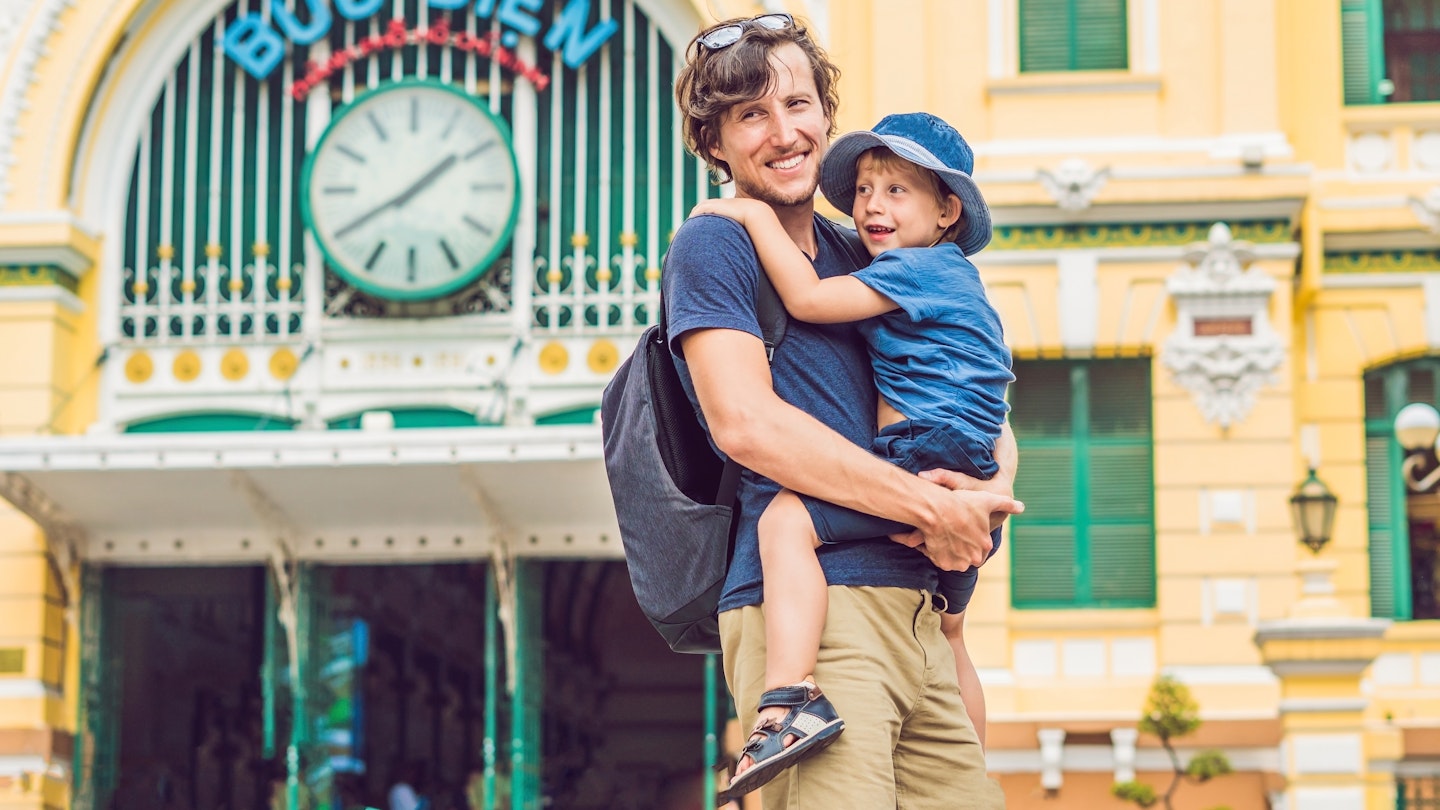
Read on for all the key things to know before you visit Vietnam © Elizaveta Galitckaia / Shutterstock
Adventures abound in Vietnam . You can climb the heights and scuba dive the lows, immerse yourself in culture or just kick back on the sand, confident in the knowledge that a fantastic meal is waiting for you at the end of the day. But there are things to know before you go, to avoid pitfalls in paradise. These are our top tips.
1. Pack for the climate
Perhaps the most important consideration when planning a trip to Vietnam is the weather. The south of the country sits firmly in the humid tropics, but the climate becomes increasingly temperate as you head north, and the highlands around Sapa can be downright chilly in winter. If you plan to visit both halves of the country, bring some clothes for the cooler highlands as well as the steamy Mekong Delta .

2. Be rain ready
Vietnam is soaked by the southwest monsoon from May to September and the northeast monsoon from October to April, so check the weather in the areas you plan to visit. Trekking in the northwest and boat trips in Halong Bay , for example, can be a soggy experience in July and August, but this is a great – if popular – time to bask on the central beaches. Even in the rainy season, it doesn’t rain all day, every day, so bring a raincoat or umbrella and make the best of the smaller crowds and lower prices.
3. Investigate the visa options
There are numerous ways to arrange the paperwork for a visit to Vietnam, some cheaper and quicker than others. You may not need a visa at all for a short trip, and electronic visas and visas on arrival are available for many nationalities – much less hassle than going to the embassy in person. Read up on the visa requirements before you book your flights, to avoid paying more than you need to, or getting held up by red tape.
4. Get your jabs
As with anywhere in the tropics, there are tropical illnesses to be aware of in Vietnam. See your doctor at least a month before you travel to get up to date with vaccinations, and arrange anti-malarial medication if you plan to visit rural areas.
Mosquitoes can also carry dengue fever, so bring repellent. On arrival, avoid drinking tap water and use antibacterial hand gel to reduce the risk of stomach bugs; a medical face mask can reduce the risk of respiratory infections and help with pollution in big cities.

5. Book ahead for Tet and the holiday peak
Booking transport, accommodation and tours ahead of time is not essential, but it’s a good way to avoid disappointment if you come at a busy time , such as July and August on the central coast. If you plan to be in Vietnam during the Tet (Lunar New Year) festival in late January or early February, having transport and accommodation in place before you arrive is a very sensible precaution.
There is a caveat, however – book directly with operators where possible. If you go through an agency, you’ll pay more, and some travelers have reported not getting the services and standards they were expecting when booking through third parties.
6. Factor sleeper buses and trains into your itinerary
Domestic flights in Vietnam are inexpensive but there are less polluting alternatives. When planning long-distance travel , don’t overlook the country’s overnight trains and buses – you’ll save the cost of a night’s accommodation and cover big distances, without eating into your sightseeing time. Reserve a fully horizontal berth for a more comfortable night’s sleep – both buses and trains have them. The booking site 12Go Asia is a good place to start investigating the options.
7. Give Vietnam the time it deserves
Vietnam measures 1650km (1025 miles) from the Chinese border in the north to the Mekong Delta in the south, so you’ll need plenty of time to get from A to B. Road and rail transport can be slow, and there are lots of places where you’ll want to stop as you travel between the major hubs. If you only have a short time, focus your itinerary on a small area – Hanoi and around, say, or Ho Chi Minh City (HCMC) and the Delta.
8. Respect religious spaces
When visiting Buddhist, Hindu, Confucian and Taoist temples, churches and other religious buildings, dress respectfully – it’s best to cover your legs and upper arms, and you may need to take off your shoes and hat to enter. Never touch anyone on the head, and avoid pointing the soles of your feet towards another person or any Buddhist statues – both signs of disrespect in Buddhist culture.
9. Don’t lose face
As in many other parts of Asia, Vietnamese culture places considerable emphasis on "saving face" – in other words, avoiding situations that might cause individual or collective loss of dignity and respect. Public outbursts and arguments can cause everyone involved to lose face, so keep a sense of perspective, and try not to get angry when confronted by inconveniences as you travel.

10. Do right with your chopsticks
There are several taboos associated with using chopsticks. Leaving your sticks sticking upright in a bowl of food is considered unlucky, as it resembles offerings of incense sticks made for the dead. Using chopsticks of uneven length is also frowned on, as is tapping your bowl with your sticks (associated with beggars requesting alms). If you eat in a group, use clean chopsticks (or the reverse ends of your own chopsticks) to pass food to others.
11. Eat like a local
Food is practically a religion in Vietnam, but locals focus their energy on the evening meal, where multiple dishes are shared between diners, with the whole family getting involved. Rather than ordering a single main course, choose a spread of dishes for the table and sample a rich mix of flavors and textures. If you need a boost between meals, street food snacks can be found everywhere, or just grab a nutritious sinh tố (fruit shake) or a cup of local drip-brewed ca phe (coffee).
12. Don’t go overboard with displays of affection
Public displays of affection are not a big part of Vietnamese culture, for couples of all orientations. Kissing, hugging and even holding hands in public can raise eyebrows, so tone down the romantic gestures while you’re in the country. On the plus side, despite lingering legal inequality, LGBTIQ+ couples generally face few problems in Vietnam, and Hanoi and Ho Chi Minh City (HCMC) both have lively scenes.

13. Be a respectful photographer
Always ask before taking photographs of people, particularly in minority villages. Many people find it intrusive, and by asking first, you’ll know if people are comfortable being included in your travel photos. In tribal areas, some villagers ask for payment for photos, which is fair enough... how would you feel if strangers kept sticking a long lens into your front porch?
14. Don’t get dragged into Vietnamese politics
Another time to think twice before pulling out your camera is during public demonstrations and political rallies. Critics of the government can face harsh punishments – demonstrations in 2018 against laws allowing the authorities to monitor online communications led to over 100 arrests. Play it safe – steer clear of political gatherings and avoid conversations about politics with local people.
15. Be a fair bargainer
Haggling is a fact of life in Vietnam, particularly at markets and souvenir shops, and you may pay over the odds if you accept the first price suggested. However, bargaining should never be a confrontational process – treat it as a game and counter the starting price with a lower counter offer, and see how the seller responds. With a bit of back and forth, you should reach a mutually acceptable price – and if you don’t, you can always decline politely and try another vendor. There’s little point haggling over tiny sums of money – if you pay 5000 dong (US$0.20) over the going rate, consider that you can probably afford it.
16. Know your loos
Western-style sit-down toilets are increasingly common in Vietnam, but you’ll often have to pay to use public loos, and paper is rarely provided. Carry your own, or use the hose or water jug provided. Bring antibacterial hand gel or soap; many bathrooms only provide running water.
17. Don’t let touts take you for a ride
Commission-seeking middle men (and middle women) pop up almost anywhere tourists gather, and Vietnam has its share. Be wary of touts who encourage visitors to use certain tour agencies, hotels, shops and transport companies in touristy parts of Hanoi, Ho Chi Minh City and Hoi An. If you use their services, you’ll pay more to cover their fee.

18. Avoid the sex tourism industry
Sex tourism is an unwelcome legacy of the American War, but it’s usually easy to spot – and avoid – places where the sex trade takes place. Be wary of bars, karaoke lounges and massage parlors with scantily clad staff and lots of pink or red neon. Note that some hotels refuse to allow foreign men to share rooms with Vietnamese women – which can lead to headaches for genuine couples with an Asian partner.
19. Give drugs a pass
Illegal drugs aren’t hard to find on the traveler circuit in Vietnam, but the penalties, if you’re caught by the police, can be severe – even for possession of small amounts. Many travelers have ended up in Vietnamese jails for drug offenses, and the death penalty can be applied in drug cases. If you are inclined to toke while you travel, it’s only a short hop to Thailand , where the consumption of marijuana in food and drinks has been decriminalized for now.
20. Shop responsibly
Vietnam has some wonderful crafts and art forms that make for great souvenirs, but stick to modern pieces; it’s illegal to take antiques out of the country. Also be watchful for souvenirs made from animal parts, such as shell, horn, bone, teeth and feathers. Such items are usually taken from wild animals, and you could fall foul of the Convention on International Trade in Endangered Species (CITES) .
21. Be smart about crime, not anxious
Opportunistic crime can occasionally be a problem, particularly in crowded cities where pickpockets and bag-snatchers on motorcycles take advantage of the unwary, but this isn’t a problem unique to Vietnam. Activate your big city precautions, and watch your belongings on busy public transport or in bars and cafes (using a phone or laptop at an outside table is unwise). Handbags with a single strap are a popular target for ride-by bag snatchers – a daypack or messenger bag is a better option.
22. Be wary of American War ordnance
Horrifying volumes of munitions were dropped over Vietnam during the American War, and unexploded ordnance continues to kill and maim people every year. Well-traveled areas are usually safe, but be cautious about stepping off roads and paths in rural areas. Don’t climb into bomb craters and never touch old explosive devices – they can remain deadly for decades.
23. Be typhoon smart
Vietnam is hit by periodic typhoons between May and November, with the biggest risk of storms from August to September. If you travel during the typhoon season, monitor local weather reports, and head inland from the coast if a direct hit by a big storm is predicted. In the event of flooding, contact your embassy or consulate and follow advice from the local authorities.
Explore related stories
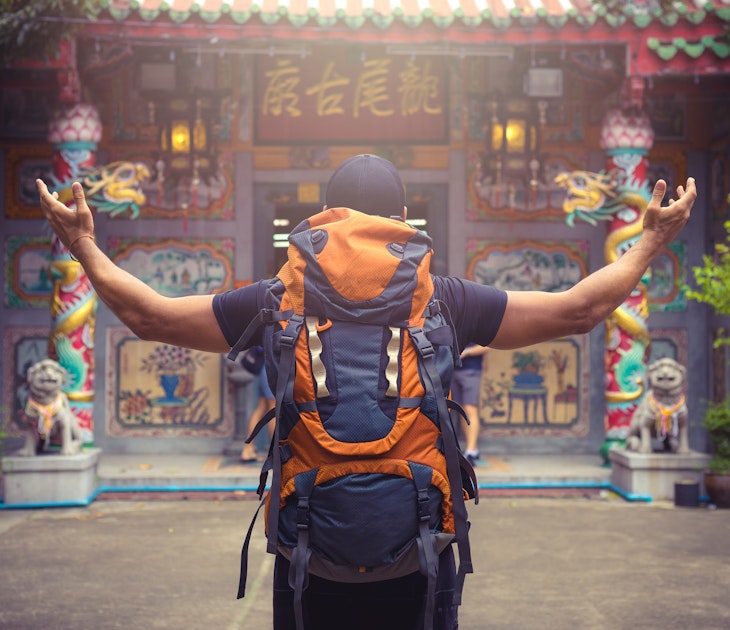
Festivals & Events
Apr 8, 2024 • 6 min read
With three seasons – hot, rainy and (comparatively) cool – Bangkok offers very different experiences throughout the year. Here's the best time to visit.
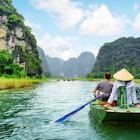
Mar 14, 2024 • 10 min read

Feb 24, 2024 • 8 min read
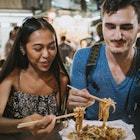
Feb 23, 2024 • 7 min read

Feb 22, 2024 • 5 min read

Feb 3, 2024 • 7 min read
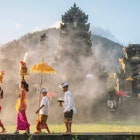
Jan 17, 2024 • 6 min read

Jan 17, 2024 • 8 min read

Jan 11, 2024 • 4 min read

Jan 5, 2024 • 20 min read
Le JavaScript semble être désactivé sur votre navigateur. Javascript doit être activé dans votre navigateur pour que vous puissiez utiliser les fonctionnalités de ce site internet.
- Afrique du sud
- Burkina Faso
- Corée du nord
- Corée du sud
- Philippines
- Pays Baltes
- République Tchèque
- Nouvelle-Calédonie
- Nouvelle-Zélande
- Polynésie Française
- Arabie saoudite
- Azerbaïdjan
- Emirats Arabes Unis
- Kirghizistan
- Ouzbékistan
- Iles Canaries
- Iles Cyclades
- Ile Maurice
- Iles Salomon
- Rép. Dominicaine
- Voyage de noces
- En septembre
- En novembre
- En décembre
- En amoureux
- À la Toussaint
- À Noël et au Nouvel An
- Circuit accompagné
- Voyage en famille
- Toutes les inspirations
- Nos événements culturels
- Carnets de voyage
- La Maison de thé
- Qui sommes-nous
- Notre valeur ajoutée
- Notre engagement responsable
- Notre agence de voyage
- Revue de presse
- Demander un devis
- Contactez-nous
- Prendre un rdv
- Me connecter
- Voyage Asie >
Voyage Vietnam
Votre prochain voyage sera inoubliable
Accès rapide
Toutes les couleurs de l'Asie du Sud-Est
Un voyage au Vietnam est un émerveillement pour les sens… Céladon, turquoise, rose tendre, framboise des façades de Hanoï jouant avec l’ombre des platanes. Lumière rasante du couchant sur les lagunes et les filets de pêche en apesanteur, sur les temples et pagodes. Bleu roi, bleu nuit, bleu pâle de la mer de Chine qui baigne de ses gradations hypnotiques les côtes de la route mandarine. Néons vibrants de la nuit saïgonnaise, rouges orangés des lampes de soie, blanc immaculé des ao dai… Plongez dans notre sélection d’itinéraires pour voyager au Vietnam et découvrir les couleurs, saveurs et lumières de l’Asie du Sud-Est. Avec sa silhouette en forme de dragon, le Vietnam séduit par le côté magique et irréel de la baie d’Halong , ses pitons creusés de grottes et de criques forgées par le vent, les vagues et les siècles. Il émerveille par le charme de ses villes emblématiques, incontournables, qui offrent un véritable dépaysement : Hanoï , la capitale à l’architecture coloniale, l’effervescente Ho Chi Minh-Ville , ex-Saigon, la belle Hoi An , classée au patrimoine mondial de l’Unesco, Hué l'impériale… Un voyage Vietnam, c’est aussi la découverte du Tonkin et ses paysages montagneux, la visite de Sapa et ses rizières en terrasses à flancs de montagnes ; c’est partir en croisière au fil du Mékong jusqu’au Cambodge, ou encore profiter d’un séjour de charme dans les plus beaux resorts pour nager dans les eaux limpides de la mer de Chine et se détendre à l'ombre des cocotiers. Les voyageurs apprécient le service impeccable, profitent du spa et de plages de sable blanc paradisiaques… et succombent à la douceur de vivre de cette destination authentique. C’est enfin rencontrer une mosaïque de peuples, comme dans les hauts plateaux du centre et les montagnes du nord du pays, où plus de cinquante minorités vivent dans des villages reculés, possédant leur dialecte, leur culture et leur mode de vie ethniques. Notre épopée transindochinoise, traversant Vietnam, Birmanie, Thaïlande et Cambodge, ou notre circuit au Vietnam se terminant en apothéose à Angkor sont des plus complets, mais si vous rêvez d’un voyage sur mesure au Vietnam , d’un trek ou d’un voyage de noces au Vietnam , n'hésitez pas à communiquer vos envies de vacances à nos conseillers spécialistes de l'Asie. Ils vous réservent leurs bons plans et les meilleures excursions pour enrichir votre escapade...
Découvrez notre agence de voyage Vietnam
Affiner votre recherche

Traversée du Vietnam
Circuit accompagné 12 Jours / 9 Nuits
À partir de 2 650 €*

Le Vietnam à sa guise
Voyage sur mesure 12 Jours / 9 Nuits
À partir de 2 290 €*

Tout le Vietnam
Circuit accompagné 20 Jours / 17 Nuits
À partir de 3 695 €*

Les incontournables du Vietnam du nord en liberté
À partir de 1 890 €*

Le Vietnam, une aventure en famille
Circuit accompagné 13 Jours / 10 Nuits
À partir de 3 030 €*

Balade au Vietnam en famille
Voyage sur mesure 15 jours / 12 nuits
À partir de 2 875 €*

Le Vietnam intime
Circuit accompagné 15 Jours / 12 Nuits
À partir de 3 505 €*

Le Vietnam, au cœur de la nature
Voyage sur mesure 14 jours / 11 nuits
À partir de 3 750 €*

Flexibilité
Report sans frais sur toutes nos destinations ou remboursement en cas de fermeture de frontière.

Des conseillers spécialistes connaissant dans les moindres détails leurs destinations

Contact téléphonique 24h/24 , 7j/7 pendant tout votre voyage.
Culture & voyage
Les clés pour bien préparer votre voyage au vietnam.
Conseils de nos experts, témoignages et coups de cœur
L’AVIS DE LUONG, CONSEILL È RE VOYAGES ASIE
"Céladon, turquoise, framboise des façades de Hanoï. Bleu roi, bleu nuit, bleu pâle de la mer de Chine. Rouge des lampes de soie, blanc des ao dai, orangé du couchant sur les temples et pagodes… Toutes les couleurs, saveurs et lumières de l’Asie du Sud-Est sont au Vietnam, mon pays d'origine."
LES 4 COUPS DE CŒUR VIETNAMIENS DE LUONG
- Visiter le musée des Femmes de Hanoï , parfaite introduction à la culture vietnamienne Au cœur de l’ancien quartier colonial français de la capitale, c’est à travers une riche collection de 28 000 objets que vous plongez dans la vie de tous les jours des femmes vietnamiennes, aux quatre coins du pays. Urbaine ou paysanne, du Nord au Sud, des plaines ou des montagnes, la féminité est plurielle et se décline en fonction de l’identité des cultures autochtones, révélant aux yeux de tous le destin de personnalités exceptionnelles et surprenantes.
- Ressentir la douceur de vivre vietnamienne au Mai Chau Écolodge Situé dans la vallée de Mai Chau, cet écolodge résume parfaitement la douceur de vivre à la vietnamienne, où nature et culture s’entremêlent somptueusement. Un engagement profond auprès de l’environnement qui se reflète dans chacun des 43 bungalows construits à partir de matériaux naturels, conférant charme et confort dans une ambiance zen. Après une balade à vélo à travers les hameaux Tay, faites un saut dans la piscine, rendez-vous au spa, dont les massages traditionnels aux herbes sont réputés, puis rejoignez le Panorama Bar, offrant une vue imprenable sur un damier de rizières et les montagnes du Tonkin.
- Randonner dans la nature intacte du lac Lak, fief des minorités Jaraï, Jun et Banhar Trop souvent résumé à ses grandes villes culturelles et à sa célèbre baie d’Halong , le Vietnam recèle encore nombre de paradis cachés. L’un deux, le lac Lak, se situe sur les hauts plateaux centraux et réunit tous les ingrédients d’un voyage inoubliable. Niché au cœur de parcelles de rizières et de monts volcaniques se reflétant dans ses eaux pures, il est le fief des minorités Jaraï, Jun et Banhar, dévoilant ses maisons en bois sur pilotis aux atypiques toits de paille surélevés. Randonnée , balade en pirogue et spectacle de gongs permettent de se connecter à la magie des lieux.
- Effectuer une croisière sur le légendaire Mékong , bien installé dans la cabine d’un bateau de charme La mémoire de Marguerite Duras plane dans cette région rurale à fleur d’eau, où l'on découvre sur ses traces les marchés flottants et villages sur pilotis, les rizières infinies et entrelacs de canaux parcourus par les jonques et barques des pêcheurs, les arroyos verdoyants et jardins fruitiers...
OÙ PARTIR AU VIETNAM ? Notre top 10 des sites vietnamiens incontournables
- Hanoï , capitale à l’héritage millénaire à découvrir au détour des ruelles bigarrées du quartier des 36 corporations, des rives du lac Hoan Kiem ou de Bah Dinh, à l’étrange pagode au Pilier Unique.
- Ho Chi Minh-Ville , encore appelée Saigon par ses habitants. Le centre historique aux belles bâtisses coloniales et aux agréables parcs mêlent avec brio traditions et modernité.
- Hue , l’impériale, pour son caractère grandiose. Maisons-jardins de riches bourgeois, tombeaux royaux, citadelle et pagodes étincelantes sont un plongeon unique dans les us et coutumes de la vie de cour.
- Hoi An , ancien port de marchands chinois en plein cœur du Vietnam, à l’ambiance incomparable avec ses vieilles échoppes, boutiques de tissus de soie, galeries d’artistes et cafés gourmands qui s’illuminent, la nuit venue, des couleurs chatoyantes de milliers de lampions.
- My Son , dont les vestiges d’époque Cham ont été classés au patrimoine mondial de l’Unesco. Les centaines de temples préangkoriens, uniques exemple au Vietnam, sont le témoin de l’importance de cette incroyable civilisation.
- Le delta du Mékong , monde amphibie envoûtant. Marchés flottants, arroyos et villages typiques sont à découvrir en barque, à vélo ou à bord d’un « xe loi » traditionnel. Sur les traces de Marguerite Duras.
- Les hauts-plateaux du Centre , de Ban Me Thuot à Kontum. Ici se côtoient lac de montagnes, villages Banhar et Jaraï aux belles maisons de bois sur pilotis et surprenante tradition de musiques de gongs.
- La baie d’Halong et ses paysages karstiques légendaires, à explorer en croisière. Au programme : grottes cachées, balade et kayak, visite de villages de pêcheurs et repas de fruits de mer.
- Mai Chau , campagne vietnamienne aux splendides rizières que l’on aime parcourir à vélo entre hameaux traditionnels peuplés de Tay, cultures et pics calcaires.
- Hoa Lu , « la baie d’Halong terrestre » et ses paysages immuables de rivières serpentant à travers les montagnes. Un moment de poésie à vivre à bord de votre barque dans la région de Tam Coc ou de Trang An.
LES BONNES RAISONS DE PARTIR AU VIETNAM Notre top 10 des expériences uniques à vivre au Vietnam
- Se rendre dans un marché du Haut-Tonkin , rendez-vous des Hmong et Dao noirs ou rouges venus échanger nouvelles et marchandises, bestiaux et larges sourires. Un festival de senteurs et de couleurs aux confins des montagnes du Nord.
- Traverser le pont Paul Doumer en train , à la spectaculaire charpente métallique d’époque française, et profiter d’un point de vue unique sur les paysages bordant le fleuve Rouge.
- Effectuer une croisière sur le légendaire Mékong , bien installé dans la cabine d’un bateau de charme. Possibilité de rejoindre le Cambodge et Phnom Penh pour un combiné d’Asie.
- Partir en randonnée dans les rizières de cartes postales . Les paysages sont particulièrement spectaculaires à Mu Cang Chai et Pu Luong, oscillant du vert au jaune et au brun.
- Explorer les galeries souterraines de Cu Chi ou de Vinh Long . L’occasion de se mettre dans la peau des résistants Viêt-Cong...
- Assister à un spectacle de marionnettes sur l’eau au théâtre Thanh Long à Hanoï ou sur la place du village de Yen Duc. Cet art typique du Nord conte la vie des campagnes au rythme d’un orchestre traditionnel. Immanquable.
- Profiter d’un massage aux herbes médicinales pour une parenthèse de bien-être . Une tradition particulièrement vivace dans les villages situés entre Hanoï et Hue.
- Rejoindre Dien Bien Phu , haut lieu de mémoire des affrontements de la guerre d’Indochine. Symbole d’une époque, la ville isolée au nord-ouest du pays est encore aujourd’hui emplie d’émotions.
- Visiter les villages anciens de la région du fleuve Rouge , aux magnifiques rues pavées et aux bâtisses en bois, comme Duong Lam et Dinh Bang dont les Dinh, maisons communales typiques, sont de tailles impressionnantes.
- S’enfoncer dans les méandres des grottes de Phang Nha lors d’une escapade d’une ou plusieurs journées à pied et en bateau.
QUAND PARTIR AU VIETNAM ? La meilleure période pour partir au Vietnam
La meilleure période pour partir au Vietnam s’étend de novembre à avril, saison sèche pendant laquelle les températures oscillent entre 25°C et 30°C.
Circuit accompagné Vietnam
Pour partir au Vietnam en toute sérénité et ne rien manquer des trésors du pays, rien de mieux qu’un voyage organisé. Mais pas n’importe lequel ! Un circuit accompagné au Vietnam en petit groupe de 8 à 20 personnes invitant à la réflexion et à la rencontre…
Voyage sur mesure Vietnam
Vous rêvez d’un voyage sur mesure au Vietnam pour explorer les paysages éblouissants à deux, en famille ou entre amis ? De plonger dans la culture riche du pays du dragon au gré de vos envies ?
Séjour Vietnam
Culturels, zen ou plage, nos séjours au Vietnam conjuguent charme, élégance, dépaysement et authenticité.
Croisière Vietnam
En jonque ou à bord d’un luxueux bateau, quel que soit votre désir de voguer au fil de l’eau, profitez de nos croisières exclusives sur le Mékong ou au milieu des quelque 3 000 îles et îlots de l’incontournable baie d’Halong.
Modules et excursions Vietnam
Escapade gourmande, nature ou balnéaire, séjour chez l’habitant ou en écolodge, trek dans un parc national... Nos experts vous ont concocté un vaste choix d’ excursions au Vietnam et de découvertes inédites.
Combiné Vietnam
Laissez-vous tenter par nos circuits combinés Vietnam , pour découvrir en un seul voyage les merveilles du Vietnam et de ses incontournables voisins : la Birmanie, le Cambodge et la Thaïlande.
Découvrez le Vietnam autrement :
Bien-être, détente et spa Vietnam
Aventure et randonnée Vietnam
Hors des sentiers battus Vietnam
Les plus belles plages Vietnam
Voyage luxe au Vietnam
Voyage en famille Vietnam
Voyage à deux Vietnam
Voyage de noces Vietnam
Besoin d'un conseil ?

01 40 51 95 15
Prendre un rendez-vous
- Nos villes et étapes au Vietnam
- Nos suggestions de voyage
- Infos pratiques
Plages idylliques de Danang , Nha Trang, Con Dao ou Phu Quoc ; inextinguible énergie de Ho Chi Minh-Ville , ex-Saigon, ou Hanoï , parsemée de lacs et parcs verdoyants ; nature somptueuse de la baie d’Halong et ses pitons rocheux, du delta du Mékong et ses vergers luxuriants, de l’Annam, splendide région de criques et de montagnes plongeant dans la mer de Chine ; Dien Bien Phu , tristement célèbre pour ses batailles ; cités au charme irrésistible : Hué l’impériale et ses maisons-jardins, Hoi An aux mille couleurs, Dalat , le « Petit Paris » des années 1920… Du Nord au Sud et d’Est en Ouest, le Vietnam enchante par ses merveilles naturelles et culturelles
Voyage au Bhoutan
Voyage en Birmanie
Voyage au Cambodge
Voyage en Chine
Voyage en Corée du nord
Voyage en Corée du Sud
Voyage en Inde
Voyage en Indonésie
Voyage Japon
Voyage au Laos
Voyage en Malaisie
Voyage au Maldives
Voyage en Mongolie
Voyage au Népal
Voyage au Philippines
Voyage à Singapour
Voyage au Sri Lanka
Voyage à Taiwan
Voyage en Thaïlande

Inscrivez-vous à notre newsletter pour recevoir nos inspirations de voyage en avant-première
Soyez informé en avant-première de tous nos voyages et de tous nos circuits
- Contact : [email protected] Prendre un rendez-vous en ligne 76, rue Bonaparte Paris 6 ème Europe & Orient : 01 56 81 38 30 Inde : 01 56 81 38 38 Asie : 01 40 51 95 15 Chine : 01 40 51 95 00 Afrique & océan indien : 01 56 81 38 29 Amérique du Nord : 01 53 63 13 43 Amérique Latine : 01 53 63 13 40 Australie & îles du Pacifique : 01 70 36 35 40
- Qui sommes nous ?
- Notre Maison de thé
- Nous rejoindre
- Votre agence de voyage à Paris
- Votre voyage de A à Z
- Voyage groupes
- Idée voyage
- Écotourisme
- Voyage sur mesure
- Nos brochures
- Calculateur CO²
- Sécurité & confidentialité
- Conditions générales de vente
- Conditions générales d'utilisation
- Mentions légales
- Charte avis voyageur

© Les Maisons du Voyage
Your Vietnam trip starts here
Where do you want to go, fully customizable tours to discover vietnam.
VietnamTours is one of the leading travel agencies in Vietnam, and have been designing and operating quality tours around Southeast Asia since 2008. A tour with us guarantees a memorable experience; whether you opt for a long package tour or a one-day excursion, a jungle trekking adventure or a sun-soaked leisure holiday, we pride ourselves on providing the best customer service, local knowledge and customization options in the industry.
Our travel experts are ready to create a Free customised itinerary for you next holiday. Where would you like to go?
Our Destinations
The Ancient Town
Ho Chi Minh City
The Bustling City
The Descending Dragon
The resort paradise
Capital of Vietnam
Tour Styles
- CLASSIC TOURS
- MULTI-COUNTRY
Essential Vietnam (17 Days / 16 Nights) from $ 1008 pp
17 Days 16 Nights
You are uniquely given a chance to witness the fertile and lush flood plains
Vietnam Must–Sees In 12 Days from $ 760 pp
12 Days 11 Nights
Vietnam in the eyes of all tourists is an astonishingly exotic
From Siem Reap To Hanoi – The Essence Of Indochina (8 Days 7 Nights) from $ 651 pp
8 Days 7 Nights
A wonderful glance of the extraordinary
Insider Guide
5 best cruises which stop in vietnam.
Cruising is a growing trend for global tourism as travelers guest to experience both the feel of bei...
Vietnam's 7 Most Elite Golf Courses
With more than 35 fully operational golf courses, some of which were designed by famed golf course d...
The 6 BEST National Parks in Vietnam
Vietnam is a country of tropical lowlands, and densely forested highlands, pristine beaches and roll...
Forget the Jet: Vietnam’s Five MOST Awestruck Motorbike Routes
Vietnam’s iconic rice terraces, water buffalo, ancient pagodas and magnificent valleys have been imm...
8 Best Luxury Resorts in Vietnam
Whilst Vietnam, much like its South East Asian neighbours, may be a huge attraction for backpackers ...
Meet Some Of Our Happy Travellers
The way to see vietnam.
Me and my family have largely organized tours ourselves in Asia and in Europe and we did take some time to consider booking a tour on Vietnamtours.com. It tur [...]
Northern Vietnam in 7 days - must consider
We booked our honeymoon trip with Vietnamtours.com - an excellent 7 day trip to see Hanoi, Halong Bay and Sapa. We had a lot of fun delving into the busy stre [...]
Thank you for organizing our group’s tours
We were a university alumni group of friends who took some time off to visit Vietnam and spend nearly a week together. Vietnam Tours were able to coordinate a [...]
Meet Our Team
With the most dedicated, friendly and professional staffs with years of experience in tourism field, we are happy to introduce you what makes VietnamTours what it is today.
Sales Manager
Travel Consultant Tour guide
Senior Travel Consultant
Cruise Consultant
Travel Consultant
Cruise Charter Specialist
Air Ticket Consultant
Admin & Secretary
Customer Support
How to spend 10 days in Vietnam — 5 unique itineraries
Book your individual trip , stress-free with local travel experts
- roughguides.com
- itineraries
- 10-days-in-vietnam-itinerary
- Travel guide
- Itineraries
- Local Experts
- Travel Advice
- Accommodation
Plan your tailor-made trip with a local expert
Book securely with money-back guarantee
Travel stress-free with local assistance and 24/7 support
We wanted to write and commend one of your tour guides - Nina, who has spent to days with us in Bangkok, staying along the river. Nina is the most professi...
Getting ready for your trip to Vietnam? The prospect of exploring this captivating country, with its rich history and delectable cuisine, can be both exciting and daunting. Fret not! We've handcrafted a selection of inspiring 10-day Vietnam itineraries to help you navigate this remarkable Southeast Asian destination.
See our other Vietnam itineraries: 5 days | 14 days
Itinerary #1: Vietnam family adventure
Itinerary #2: vietnam culinary discovery, itinerary #3: indochina’s unesco treasures, itinerary #4: the wonders of vietnam, itinerary #5: luxury vietnam, let us plan your trip for you, tailor-made travel itineraries for vietnam, created by local experts.

10 days / from 2150 USD
Vietnam Culinary Discovery
Vietnamese cuisine can be divided into three categories, each pertaining to a specific region, namely the North, Centre and South. You will visit all of these on this culinary tour of Vietnam. Awaken all of your senses to the wonderful sights, sounds and aromas of this fascinating country.

16 days / from 2150 USD
Very Vietnam
Vietnam is full of surprises, seamlessly mixing both ancient and modern. See rice paddies, traditional villages, markets, temples and pagodas. Discover romantic cities, cruise around mystical Halong Bay, laze on pristine beaches and get out and about in exuberant Ho Chi Minh City.

4 days / from 550 USD
Cultural Saigon
Southern Vietnam is home to modern Ho Chi Minh City, a vibrant southern capital full of historic attraction and old Saigonese charm. Soak up some café culture, enjoy authentic street food, and get a taste of the city’s thriving markets.
Explore the vibrant culture and stunning landscapes of Vietnam with this 10-day itinerary , from the bustling streets of Hanoi to the serene beauty of Halong Bay, the historic sites of Hoi An and Hue, and the vibrant markets of Ho Chi Minh City, all designed with families in mind
Itinerary overview
This family-friendly Vietnam trip begins in Hanoi , offering an exploration of the city and a scenic Halong Bay cruise with activities like cave visits. After an orientation tour in Hanoi, you'll visit Hoi An to learn about silk production and explore historic streets, followed by a boat trip to Hue.
In Ho Chi Minh City , discover the Cu Chi Tunnels iconic landmarks, and shopping at Ben Thanh Market. Your journey ends with a serene Mekong Delta boat tour, including a visit to Cai Rang Floating Market. Read more.

Cai Rang floating market, Vietnam © Shutterstock
Check this overview of the 10 days Vietnam itinerary.
Day 1: Hanoi Old Quarter
- Arrival in Hanoi
- Transfer to the hotel
- Explore the city or opt for optional excursions
Day 2: Start Halong Bay Cruise
- Visit Hong Ngoc Humanitarian Centre
- Explore Halong Bay with activities like cave visits, swimming, and kayaking
- Enjoy onboard activities at night
Day 3: Cruise & transfer to Hanoi
- Morning Tai Chi
- Halong Bay sunrise
- Return to Hanoi
- Free time to explore and savor street food
Day 4: Orientation Tour of Hanoi
- Visit sites like the Temple of Literature and Ho Chi Minh Mausoleum
- Leisure time for personal exploration
Days 5: Explore Hoi An
- Visit Hoi An Silk Village
- Learn about silk production
- Enjoy lunch at the village
Days 6: Perfume River in Hue
- Morning boat trip on Perfume River
- Visit Thien Mu Pagoda
- Explore the Imperial Citadel
- See Dong Ba Market and Tu Duc Royal Tomb
Days 7: Cu Chi Tunnels and Saigon Highlights
- Explore Cu Chi Tunnels
- Take a Saigon walking tour
- Visit landmarks
- Enjoy panoramic views
- Shop at Ben Thanh Market
Day 8: Mekong Delta by Boat
- Head to My Tho
- Explore the Mekong Delta by boat
- Witness daily life along the riverbanks
- Drive to Can Tho
Day 9: Visit Cai Rang Floating Market
- Observe local trade traditions on the water
Days 9-10: Leisure Time in Ho Chi Minh City
- Enjoy leisure time and optional excursions.
- Transfer to the airport for departure on Day 10
Enjoy the ease of our tailor-made trip service – book this journey without the hassle of planning and booking.

Panorama Aerial view of Hoi An ancient town © Shutterstock
Embark on a gastronomic adventure through the heart of Vietnam with our meticulously crafted 10-day culinary discovery itinerary. From savouring authentic Vietnamese cuisine in Hanoi to mastering the art of crafting iconic dishes, cruising the emerald waters of Halong Bay, and exploring the cultural and historical wonders of Hue, Hoi An, and Ho Chi Minh City, every day promises a feast for your senses.
Embark on a Vietnam culinary discovery, starting with hands-on cooking classes in Hanoi where you'll learn to make spring rolls and Pho, then explore cultural gems and enjoy a Water Puppet Show.
Next, cruise through Halong Bay , with cave exploration and seaside dining. In Hue, discover ancient villages, take a river cruise, and visit landmarks. Hoi An offers more culinary delights with cooking classes and exploration of the historic town, while in Ho Chi Minh City, explore Chinatown, markets, and landmarks, concluding your journey with a visit to the Cu Chi Tunnels.
Discover Vietnam’s diverse flavours, from street food stalls to cooking classes and authentic restaurant dining.

Water puppet show in Hanoi © Shutterstock
Day 1: Arrival in Hanoi
- Check-in at the hotel
- Dine at an authentic Vietnamese restaurant
Day 2: Hanoi Cooking Class and City Tour
- Learn to make dishes like spring rolls and Pho
- Explore Hanoi's landmarks
- Enjoy a Water Puppet Show
Day 3: Hanoi to Halong Bay - Overnight Cruise
- Head to Halong Bay
- Embark on a traditional junk boat
- Explore caves
Day 4: Halong Cruise and Flight to Hue
- Morning island and cave exploration
- Return to Halong City
- Catch an afternoon flight to Hue
Day 5: Hue Ancient Villages Tour
- Explore ancient villages near Hue, including Thuy Bieu
- Enjoy a river cruise
- Explore the Imperial City
- Visit Dong Ba Market
Day 6: Hue to Hoi An Via Lang Co Beach
- Visit Khai Dinh Mausoleum
- Depart for Hoi An with scenic stops
- Explore Cham Museum
- Visit Non Nuoc beach and Marble Mountain
Day 7: Hoi An Cooking Class and Old Town Tour
- Join a cooking class
- Visit the market
- Cruise the Hoi An River
- Explore Hoi An's historic town in the afternoon
Day 8: Chinatown and Ho Chi Minh City Sightseeing
- Explore Chinatown
- Visit Binh Tay market and Thien Hau Temple
- Discover Ho Chi Minh City's landmarks
Day 9: Cu Chi Tunnels and More Sightseeing
- Morning visit to Cu Chi Tunnels
- Return to Ho Chi Minh City
Day 10: Departure from Ho Chi Minh City
- Enjoy your last day at leisure
- Depart from Tan Son Nhat Airport
Experience carefree booking with our tailor made trip service .

Halong Bay, Vietnam © Shutterstock
Explore the enchanting landscapes and cultural wonders of Vietnam and beyond with our meticulously crafted 10-day itinerary . From the vibrant streets of Hanoi to the mystical caves of Ninh Binh, the serene waters of Halong Bay, the spiritual city of Luang Prabang, and the awe-inspiring Angkor Temple Complex in Siem Reap, this trip is sure to be a great use of 10 days in Vietnam.
Embark on a 10-day journey through Indochina's UNESCO treasures, starting in Hanoi with museum visits and a scenic cycle around Hoan Kiem Lake. Explore Ninh Binh's ancient capital and Halong Bay's captivating overnight cruise. Continue to Luang Prabang for temple visits and a riverboat journey, then uncover Cambodia 's Angkor Temple Complex , in Siem Reap , concluding with a temple trail and Apsara Dance Show.

Wat Xieng Thong buddhist temple in Luang Prabang, Laos © Shutterstock
Day 1: Hanoi Arrival and Exploration
- Arrive at Noi Bai International Airport
- Explore Hanoi
Day 2: Hanoi Full Day City Tour
- Explore Hanoi's museums
- Take a cycling tour around Hoan Kiem Lake
Day 3: Ninh Binh and Thien Ha Cave Exploration
- Visit Hoa Lu
- Explore temples
- Experience Thien Ha Cave
Day 4: Halong Bay Overnight Cruise
- Enjoy a Halong Bay cruise
Day 5: Return to Hanoi
- Start with Tai Chi on the cruise deck
Day 6: Luang Prabang Discovery
- Explore Luang Prabang
- Visit temples
- Enjoy a sunset visit to Vat Prabaht Tai
Day 7: Mekong River Exploration
- Board a riverboat to Pak Ou Caves
- Explore villages along the Mekong River
- Return to Luang Prabang
Day 8: Transfer to Siem Reap
- Visit museums
- Fly to Siem Reap
Day 9: Angkor Temple Complex Discovery
- Explore Angkor Thom
- Visit Bayon and Preah Khan temples
- Explore Angkor Wat
Day 10: Continuing Along the Temple Trail
- Visit various temples in the Angkor area
- Watch an Apsara Dance Show
Simplify your travel with our Vietnam local travel experts.

Ninh Binh in Vietnam © Shutterstock
Explore Vietnam's premier destinations on this comprehensive 10-day tour , spanning from the lively capital Hanoi to the enchanting Halong Bay. Experience serene river cruises along the Perfume River, delve into the rich history of renowned tombs and temples, and immerse yourself in the vibrant energy of Ho Chi Minh City.
The 10-day Vietnam wonders expedition offers an enthralling journey through the country's cultural riches and breathtaking landscapes. Starting in Hanoi, your adventure commences with the enchanting Water Puppet Show, followed by a cultural exploration of the city's landmarks.
Discover the mystical beauty of Halong Bay, then venture to Hue for historical insights and relaxation at a local spa. Journey through the scenic Hai Van Pass to Hoi An, with a stop at Thien Mu Pagoda, before exploring Hoi An's ancient town and market.
Visit Cai Be's floating market and Cu Chi Tunnels' historical significance, and delve into the vibrant Chinatown and temples of Ho Chi Minh City. Your expedition concludes with leisure time in the city before departure from Tan Son Nhat Airport.

Ho Chi Minh Mausoleum on the Ba Dinh Square in Hanoi, Vietnam © Shutterstock
Day 1: Hanoi Arrival and City Tour
- Arrive in Hanoi
- Attend a Water Puppet Show
Day 2: Hanoi Cultural Tour
- Visit Ho Chi Minh's Mausoleum
- Visit One-Pillar Pagoda
- Explore the Army Museum
Day 3: Discover Halong Bay
- Experience Halong Bay's beauty on a boat cruise
Day 4-5: Hue Sightseeing
- Explore historic Hue
- Visit royal tombs
Day 5: Hue to Hoi An Via Hai Van Pass
- Take a dragon boat ride
- Depart for Hoi An via Hai Van Pass
Day 6: Walking Tour of Hoi An
- Explore Hoi An's historic town
- Explore ancient houses
- Cross the Japanese bridge
Day 7: Cai Be Floating Market
- Travel to Cai Be
- Enjoy a boat ride to the floating market
- Cruise through fruit orchards
Day 8: Cai Rang Floating Market and Mekong Delta Tour
- Visit Cai Rang floating market
- Explore the Mekong Delta
Day 9: Cu Chi Tunnels and Sightseeing in Ho Chi Minh City
- Visit Cu Chi Tunnels
- Explore Ho Chi Minh City's Chinatown
- Visit temples and historic sites
Day 10: Ho Chi Minh City Departure
- Enjoy a leisurely day
Overwhelmed by the planning and booking process? Let us handle it – book this trip today.

Cu Chi tunnels in Vietnam © Shutterstock
Vietnam offers stunning beaches, lush national parks, historic temples, hill-tribe villages, top-tier museums, private transfers, speedboat excursions, and luxurious hotels, making it a destination that combines surprise and gratification at every turn. Discover this and more on this luxury Vietnam voyage .
Indulge in a luxurious Vietnam journey, starting with a lavish stay in Hanoi and exploring its attractions. Cruise through the mesmerizing Halong Bay and discover Hoi An's UNESCO-listed Ancient Town. In Ho Chi Minh City, explore Chinatown and historical sites, including the Cu Chi Tunnels. The adventure concludes with a grand Mekong Delta tour, offering opulence and cultural immersion.

One-Pillar Pagoda in Hanoi © Shutterstock
Day 1: Arrival and City Tour
Day 2: hanoi highlights.
- Ho Chi Minh Mausoleum
- One-Pillar Pagoda
- Temple of Literature
- Hoan Kiem Lake
Day 3: Halong Bay Cruise
- Depart from Hanoi for Halong Bay
- Set sail in Halong Bay
- Explore limestone formations
- Visit Thien Cung Grotto
Day 4: Leisure Day
- Enjoy a free day for relaxation or optional activities in Halong Bay
- Depart Halong Bay for Hoi An
- Explore Hoi An's Ancient Town and surroundings
Days 8-10:
- Depart Hoi An for Ho Chi Minh City
- Saigon City Tour
- Explore city highlights
Day 10: Mekong Delta
- Depart for the Mekong Delta
- Discover villages, markets, and historical sites on a speed boat tour
Day 11: Departure
- Head to the airport for your departure flight from Ho Chi Minh City, concluding your journey

Mekong Delta in Vietnam © Shutterstock
If you're considering a Vietnam adventure with our Vietnam travel experts . We will craft a customisable itinerary that you can adjust to your liking. Ditch the challenges of planning and booking.

The Rough Guides to Vietnam and related travel guides
In-depth, easy-to-use travel guides filled with expert advice.

Travel advice for Vietnam
From travel safety to visa requirements, discover the best tips for traveling to Vietnam
- Crime and personal safety tips Vietnam
- Eating and drinking in Vietnam
- Getting around Vietnam: Transportation Tips
- How to get to Vietnam
- Travel Health Vietnam
- Shopping tips for Vietnam
- Sports and Outdoor activities in Vietnam
- Travel Tips Vietnam for planning and on the go
- Best time to visit Vietnam
- Vietnam Weather in September
- Vietnam Weather in November
- Vietnam Weather in June
- Vietnam Weather in July
- Vietnam Weather in December
- Vietnam Weather in August
- Vietnam Weather in January
- Vietnam Weather in February
- Vietnam weather in March
- How to get from Hanoi to Halong Bay
- How To Get From Hanoi To Da Nang
- How to get from Hanoi to Sapa
- Vietnam Weather in April
- How to get a Vietnam visa
Find even more inspiration here

written by Dre Roelandt
updated 14.02.2024
Dre Roelandt is originally from the United States but lives and works in Berlin, Germany. Dre is a freelance writer and artist with a passion for travelling. They are an in-house Content Editor at Rough Guides.
Ready to travel and discover Vietnam?
Get support from our local experts for stress-free planning & worry-free travels.
- Where to stay
- Travel advice
You are using an outdated browser. Please upgrade your browser to improve your experience.
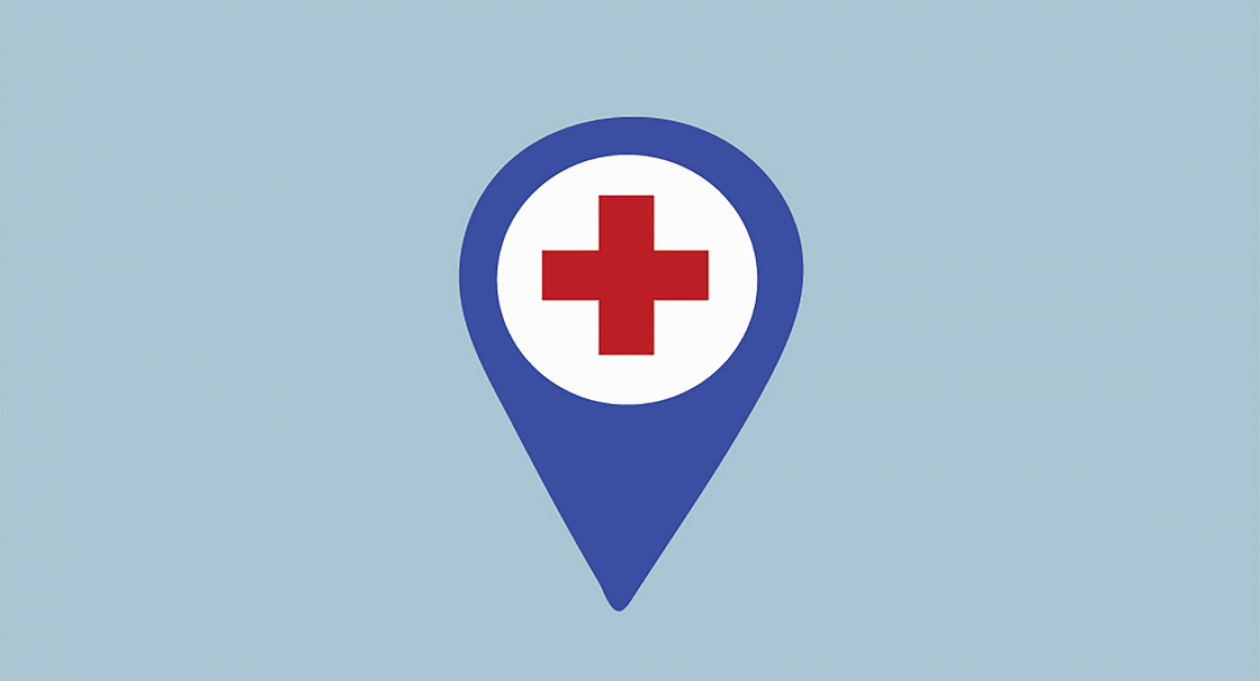
- Info for travelers on Covid-19 in Vietnam
Starting from 0:00 on May 15, all Vietnam destinations are open, no self-isolation is required, and all regulations for SARS-CoV-2 testing required before entering will be temporarily suspended.
Here are critical points of the new guidelines: Visa + travel insurance are now accepted for entry.
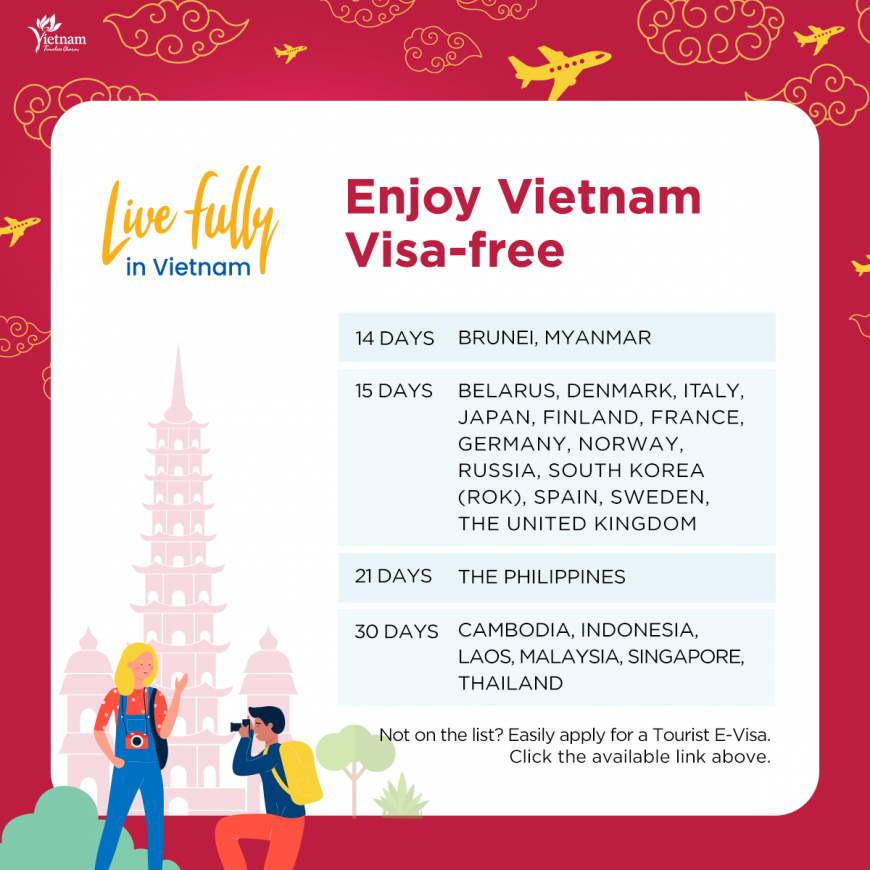
VISA EXEMPT
Visitors from the following countries may enter visa free, and stay for the indicated number of days.
- ASIA Brunei, Myanmar - 14 days. Japan, South Korea (ROK) - 15 days. The Philippines - 21 days. Cambodia, Indonesia, Laos, Malaysia, Singapore, Thailand - 30 days.
- EUROPE Belarus, Denmark, Italy, Finland, France, Germany, Norway, Russia, Spain, Sweden, The United Kingdom - 15 days.
To stay beyond this number of days, you may apply for a visa extension upon your arrival in Vietnam.
VISA REQUIRED
Simply apply online for your tourist E-visa , valid for 30 days. E-visa fee is USD 25, the processing time is 3 working days. You will receive your code by email to print your visa.
Screening centers and health hotlines
If you have symptoms of COVID-19, or are concerned that you may have been exposed, call Vietnam’s health hotline 1900 3228 immediately.
Vietnam has appointed 323 authorized testing facilities to carry out testing and diagnosis of COVID-19. See the full list .
Health requirements
Incoming travelers need to follow the below guideline from the Ministry of Health :
Starting from 0:00 on May 15, temporarily suspend pre-entry SARS-CoV-2 test requirements.
No requirement for quarantine.
Within 10 days from the date of entry: self-monitor your health, if you have symptoms of SARS-CoV-2 infection (fever; cough; sore throat; runny nose, stuffy nose; body aches, fatigue, chills; decreased or lost taste; decreased or lost sense of smell; pain, headache; diarrhea; difficulty breathing; respiratory inflammation...) must immediately notify the nearest medical facility for instructions.
These are based on guidelines from the Ministry of Health .
How to Apply for Vietnam's e-Visa:
Step 1: Prepare the required materials:
- One 4x6 passport photo in .jpg format with a white background, without glasses.
- One photo in .jpg format of your passport data page.
- A passport is valid for at least six months.
- Your temporary address in Vietnam and points of entry and exit.
- Debit or credit card for payment.
Step 2: Click this link or access https://immigration.gov.vn/ and go to 'E-visa Issuance' then click on the link for 'Outside Vietnam foreigners'.
Step 3: Upload your .jpg images (passport data page and passport photo) and fill out the required fields on the form completely. Submit your form.
Step 4: Pay the e-Visa fee of 25 USD. Copy down the document code provided.
Step 5: Within three working days you should receive news of your e-Visa application via email. If not, you can also run a search for your e-Visa at this link .
Step 6: Use your document code to locate your e-Visa online. Download and print the e-Visa in two copies for extra safety.
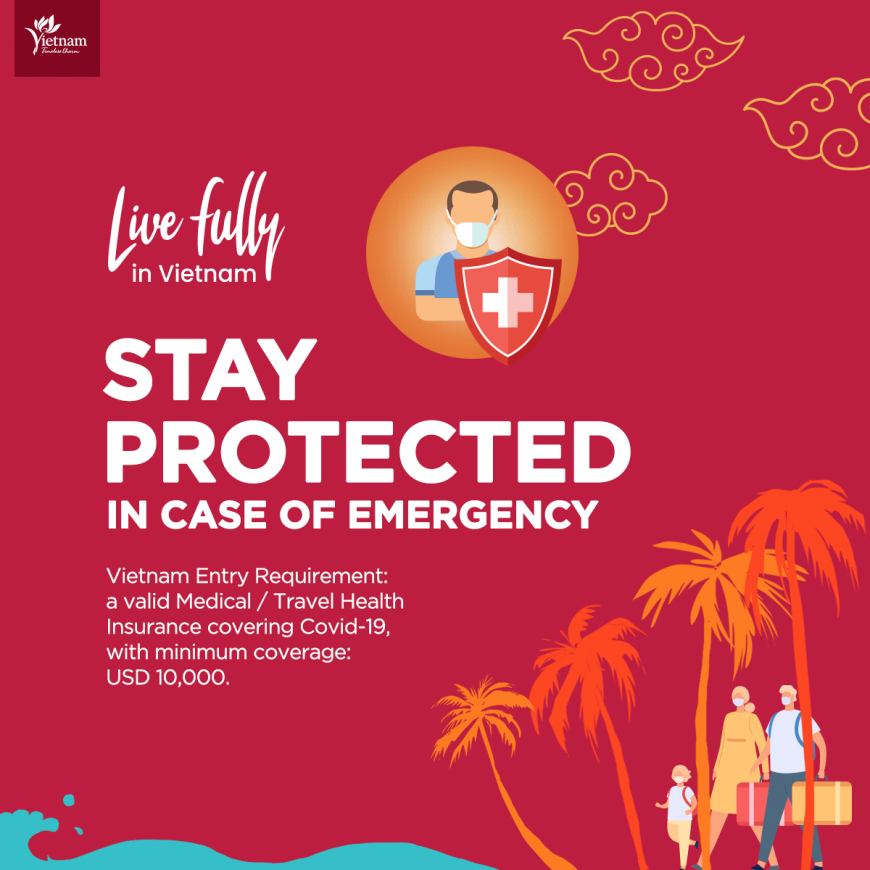
TIP: Travelers with an e-Visa can go directly to immigration counters at their point of entry and do not need to queue at Visa on Arrival counters.
Insurance requirement:
Purchase medical/travel insurance that covers COVID-19 treatment with a minimum coverage: $10,000. This typically costs about USD 40.
Health checks on departure
Domestic travel: Travelers are required to:
- During 10 days from the date of entry, tourists are requested to continue to self-monitor health. If having signs and symptoms of SARS-COV-2, must immediately notify the nearest medical facility.
- Comply with the Ministry of Health’s 4K message: khau trang (face masks), khu khuan (disinfection), khoang cach (distancing), khong tu tap (no gatherings).
- Currently, domestic flights restrictions have been reduced until the new update. However, please notice that all requirements might have resulted in changes requirements of the different destinations.
International travel: These follow the guidelines and procedures published by the country you are returning to.
Health and safety precautions for travelers
Visitors to Vietnam are encouraged to take sensible precautions against COVID-19 during their trips.
The World Health Organization outlines these basic practices to keep yourself and your loved ones safe:
Avoid traveling if you have a fever and cough. If you have a fever, cough, and difficulty breathing, alert health-care services and share with them your recent travel history.
Maintain social distancing. Stay a meter or more away from others, especially those who are sneezing or coughing, or have a fever.
Wash your hands regularly with soap and running water. You can also use an alcohol-based hand sanitizer to spray your hands frequently.
Cover your mouth and nose with tissue when you cough or sneeze. Dispose of dirty tissues immediately and wash your hands after coughing or sneezing.
Avoid contact with live animals. Wash your hands with soap and water if you touch live animals or animal products in markets.
Eat only well-cooked food. Make sure your meals, especially animal proteins and dairy products, are thoroughly cooked and prepared in a sanitary environment.
Discard single-use masks. If you choose to wear a single-use mask, ensure it covers your nose and mouth, avoids touching the mask, and wash your hands after removing it.
“Any travelers experiencing symptoms of the virus − fever, cough and difficulty breathing − should immediately call Vietnam’s health hotline: 1900 3228 . Vietnam has appointed 323 authorized testing facilities to carry out testing and diagnosis of COVID-19 disease. See the full list . For a full overview of the COVID-19 situation in Vietnam as it relates to travelers, as well as daily updates, please see our updated travel advisory. ”
The information above is compiled by the Vietnam National Administration of Tourism. Guidelines may change at any time based on conditions, as determined by the Vietnam government.
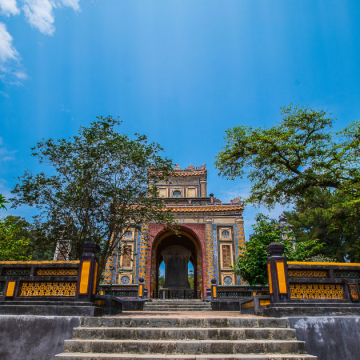
- You are here:
- Things to do
Create an account
Already have an account? Click here to sign in
By clicking submit, you agree to our Privacy Policy and Terms of Use
Sign in with your social accounts
Sign in with your email
Forgot password? Click here to get it back
Don't have an account? Sign up here
Forgot Password
The entered email has subscribed for Vietnam Tourism monthly newsletter
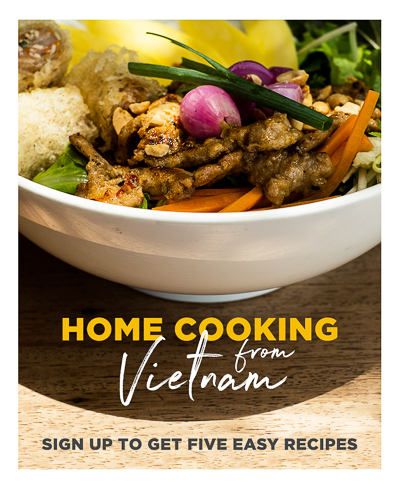
- Meet the Team
- Work with Us
- Czech Republic
- Netherlands
- Switzerland
- Scandinavia
- Philippines
- South Korea
- New Zealand
- South Africa
- Budget Travel
- Work & Travel
- The Broke Backpacker Manifesto
- Travel Resources
- How to Travel on $10/day
Home » Southeast Asia » Vietnam » Backpacking Guide
Backpacking Vietnam Travel Guide (BUDGET TIPS • 2024)
Backpacking Vietnam will ignite your senses in a way you have never experienced before. This unique country in the middle of Southeast Asia is unlike anywhere I have ever been before.
The colours, the lanterns and the smiley faces of Vietnam will forever be etched into my mind. Packed with rice-paddy fields, roaming buffalos and zooming motorbikes; there is so much to see and experience in this magical land.
Not only delicious but also kind to the budget; Vietnam has some of the best and most fascinating street food in the world. From a simple, delicious Bahn Mi to fresh Bun cha. Prepare for your mind (and your taste buds) to be blown.
Vietnam leapt into the 21st century so fast, that much of its countryside is still buffering to catch up – which I hope it never does.
While you can spend weeks exploring Vietnam’s off-the-beaten-track jungles and villages, you can also encounter EPIC cities with bustling traffic and fast wifi. Vietnam has it all (and more!)
Vietnam is a big ol’ place with rich diversity in terms of its cities and towns; each offering something completely unique from the next. You’ll want to be as prepared as possible to make the most of your time backpacking Vietnam
That’s where I come in! I’ve compiled all of the wisdom I have gathered from my trips into this ULTIMATE backpacking Vietnam guide. From the best places to visit to the boring (but important) stuff like insurance, I’ve got you covered.
Avast! Let’s get into the good stuff and stock you up with everything you need to know before backpacking Vietnam.
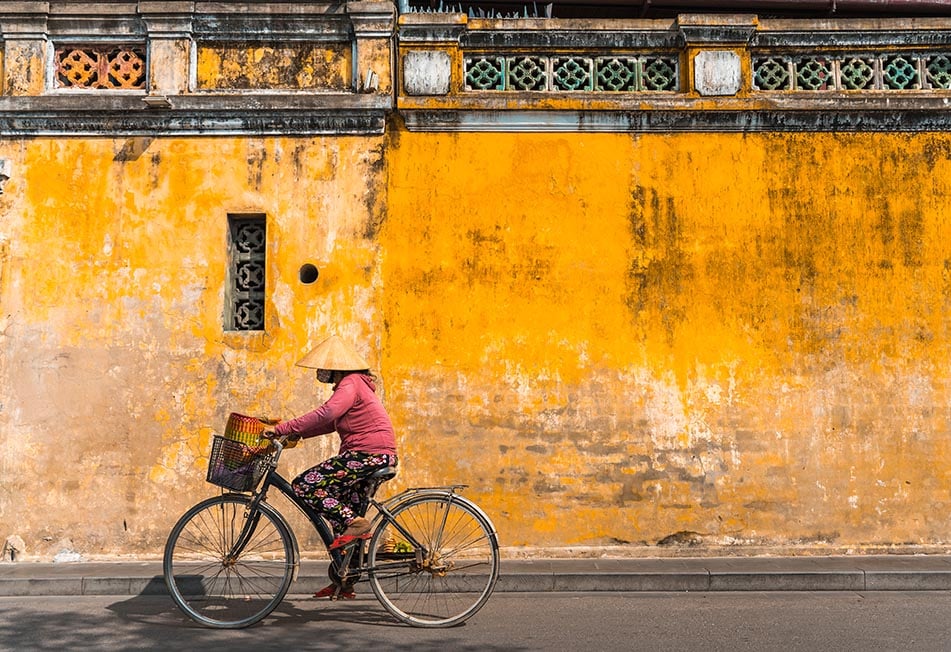
Why Go Backpacking in Vietnam
Travelling Vietnam has many of the classic markers of backpacking Southeast Asia . It still presents all the gorgeous sights: rolling green highlands, steaming jungles, twinkling azure coastlines, and ancient delights. There’s still an element of debauchery waking up still drunk in a city you don’t know. However, there’s an unshakable element of maturity that Vietnam asks of you.
I think it’s partly that the horrific history of this country is still in your face. Some of the mountains are still pockmarked from the insane bombing they endured in the war of the 1960s and 1970s. It’s also partly because Vietnam was not a well-visited destination until the 1990s. Even today isn’t full of cookie-cutter tours to the same degree as its neighbouring countries.
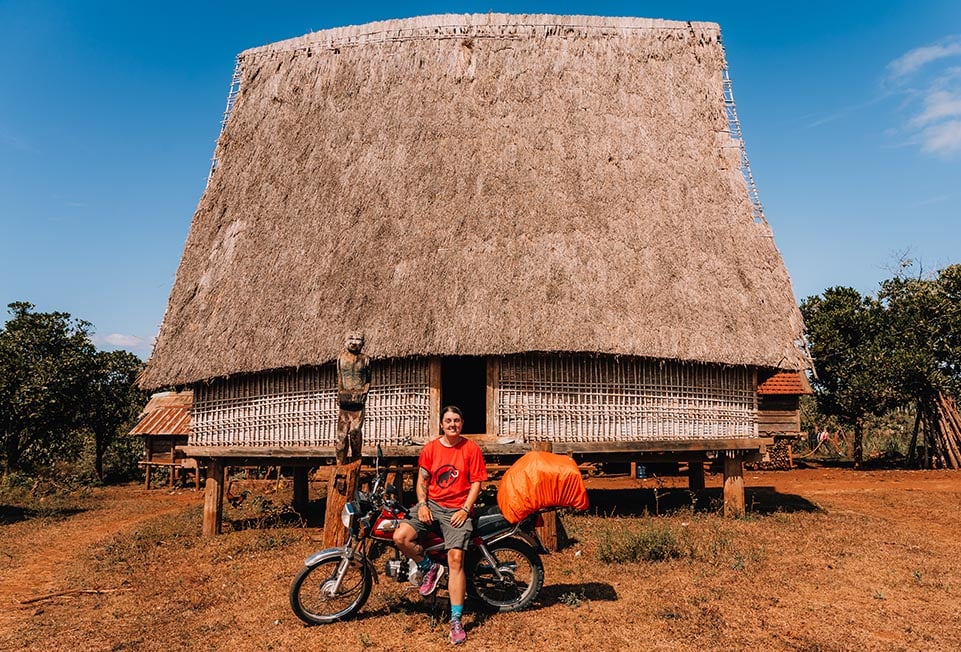
It’s also incredibly cheap to travel here. Vietnamese cuisine is sublime, the cities offer a metropolis-meets-charming-chaos style of living and the mountains? The mountains are damn fine. This has made it quite a popular base for English teachers, digital nomads, and other veteran traveller ex-pats.
I found Vietnam to be a heady collision of worlds. One day you might be chilling in a Vietnamese village that hasn’t seen foreigners in forty years, and the next you’re kicking it with Vietnamese students who deal weed to the ex-pats next door.
This all leads to this feeling that this is Southeast Asia. Or this is what Southeast Asia could be if there was a little more responsible tourism. Vietnam is a world away for most backpackers – and it sticks with them as a highlight of their years vagabonding Southeast Asia.
Best Travel Itineraries for Backpacking Vietnam
Best places to visit in vietnam, top things to do in vietnam, backpacker accommodation in vietnam, vietnam backpacking costs, best time to travel to vietnam, staying safe in vietnam, how to get into vietnam, how to get around vietnam, working in vietnam, culture in vietnam, faqs about backpacking vietnam, final advice before visiting vietnam.
Below we have put together the grand tour itinerary. This is great if you have over 3 weeks to backpack Vietnam, and best completed by motorbike or bus! If you only have 2 weeks, aim to complete the first or second half of the itinerary.
Vietnam is generally split into two regions, the north and the south. Deciding on where to stay in Vietnam , and what the best area for you is, can be a pretty hard decision.
If you only have less than two weeks, you can focus on one region. Another popular way to backpack Vietnam is to combine a trip with a neighbouring country. For example, combining Southern Vietnam and Cambodia.
2-Week Travel Itinerary for Vietnam: The Quick Trip
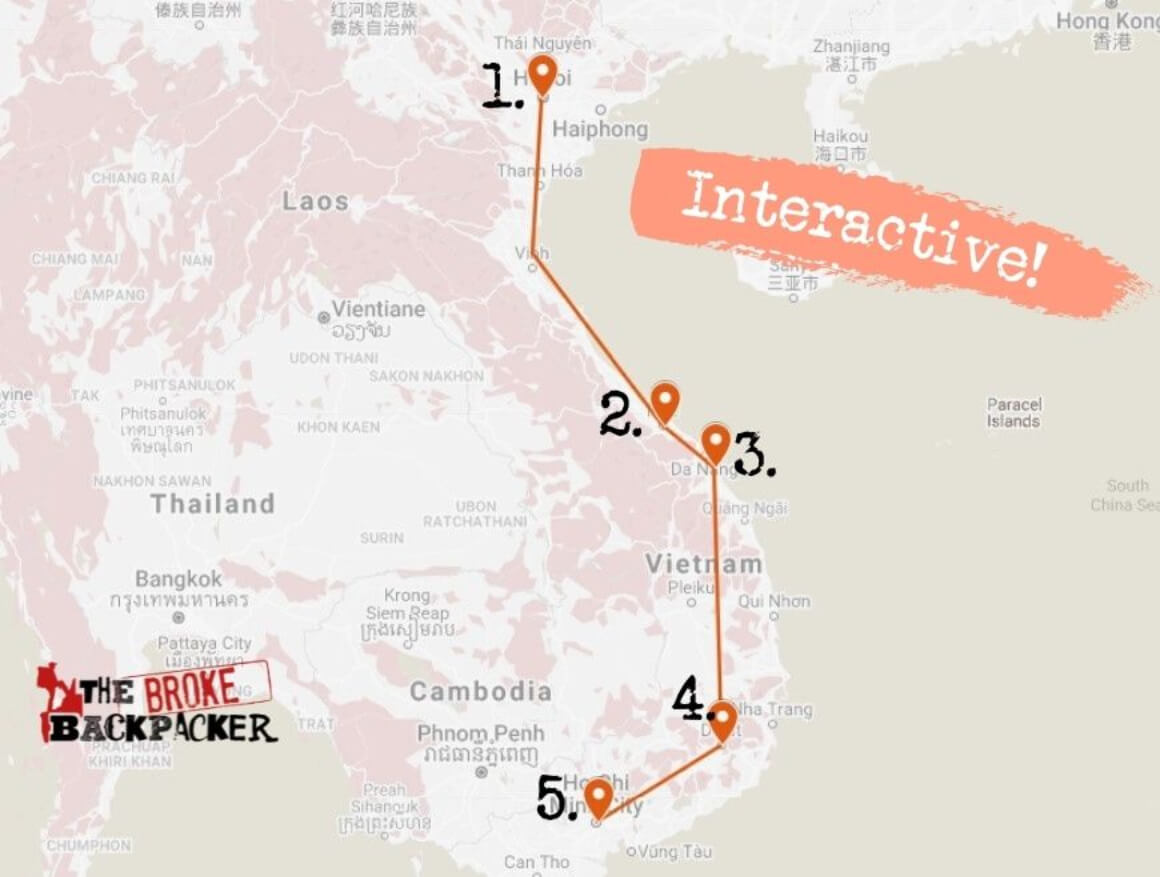
This trip is best done over about two weeks. It lends itself to bus travel in between some of Vietnam’s most beautiful places . You can start at either end, but I will talk about it from north to south.
Flying into Hanoi will be an experience in itself. Hanoi is an epic blend of modern skyscrapers and streets full of mouthwatering foods. Be sure to check out the Temple of Literature while you’re there.
After spending a few days in Hanoi, pop down the coast to the old imperial capital of Hue . My love affair with Vietnamese food was truly consummated here. Yes, if I could bed with the bun bo hue, I would. From Hue, it’s not too far to another beautiful Vietnamese city – Hoi An.
Hoi An has a slow pace of living and it’s a good place to catch up on the first leg of your trip. You can stroll through the picturesque streets, and catch up on some market shopping.
The chill times continue in Da Lat . It’s well worth taking a motorbike trip through the mountains on the way here -it’s stunning! Finish up your trip in Ho Chi Minh City !
This trip has the best of Vietnam in one neat little 2-week package!
1-Month Travel Itinerary for Vietnam: The Grand Tour
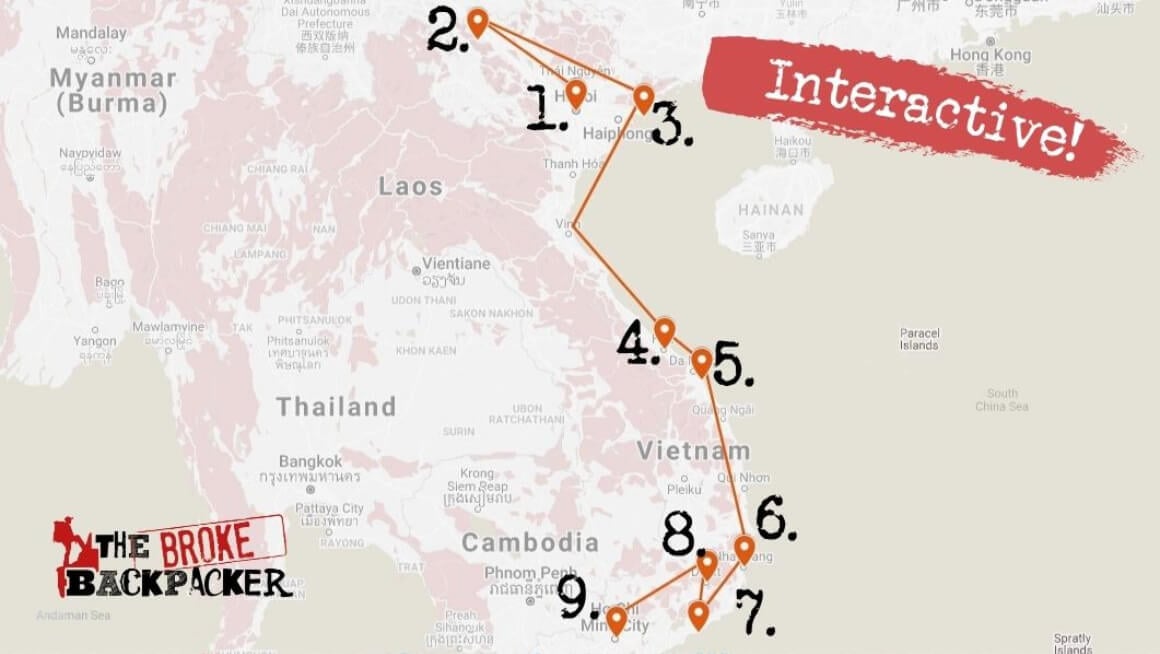
This itinerary can be complete in either direction, but I will discuss it from North to South. Start your trip backpacking in Hanoi – Vietnam’s beautiful capital city. Make a side trip to the countryside of Sapa, where you can ride your motorcycle through the hills and explore waterfalls. Then arrange a trip to Halong Bay, a highlight on any Vietnam trip.
Head south, stopping to stay in the town of Hue , before moving on to visit Hoi An , where you can get an affordable, good quality suit made. Then go to Nha Trang to let loose, get a bit wild and have some fun on the water. A popular water sports area with the likes of windsurfing, paragliding and jet skiing on offer; there’s enough adrenaline here to keep even the most adventurous happy.
Head to Mui Ne and for a short stay in Da Lat , then on to Saigon (Ho Chi Minh) , the starting point for most backpackers travelling Vietnam. Saigon is a crazy bustling city. You can also go explore the Mekong River, a paradise for wildlife.
As I mentioned earlier, backpacking Vietnam is a collision of worlds. Some cities feel like old-world Asia, others still retain strong French colonial influences, and others are straight-up party hubs. Vietnamese cities are still among my favourite in the world – the heady mix of skyscrapers and good internet with carts selling pig ears and Chinese medicine peddled throughout them.
There is so much to unpack and discover that I can give you my favourite places to go in Vietnam, but inevitably you’ll discover your own hidden gems.
Always, there is colour and the smell of pho.
Backpacking Hanoi
One of my favourite cities in all of Asia, Hanoi is a beautiful combination of Old meets Modern: a gateway to the incredible mountains and scenery to the North and the warm beaches and bustling cities to the south. Hanoi is worth spending at least a couple of days exploring, on foot, or by bicycle. You could end up joining the ranks of ex-pats that call Hanoi home.
In Hanoi, it is definitely worth visiting the War Museum, easily spotted it has a great collection of weaponry marking the entrance. It costs just $3 to get in and it’s a good introduction to exploring Vietnam’s war-torn past. Oh and be sure to check out the Old Quarter . It’s here that the traffic looks most like schools of fish, and that the best bowls of noodles can be found.
As for my personal favourite places to visit in Hanoi ? Other than the street carts selling banh mi until the early hours of the morning, it’s got to be the Temple of Literature.
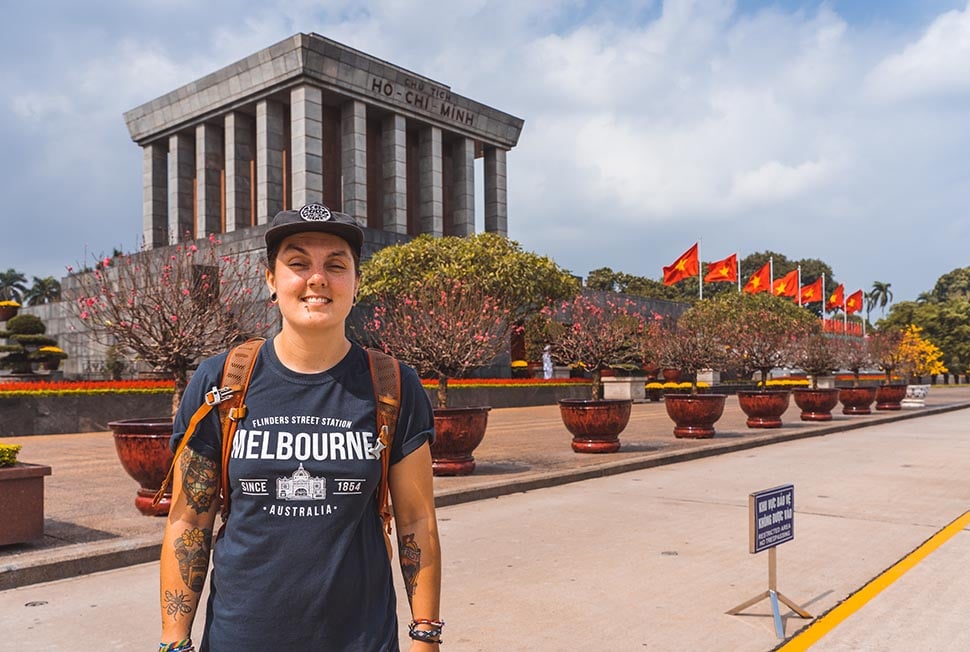
The Temple of Literature was founded in 1070. It was Vietnam’s first university where the rich and incredibly brainy attended. Even if you’re not into the history behind it, its handcrafted architecture is pretty breathtaking. If you aren’t templed out, definitely head over to the ‘old section’ of the city and stop by Bach Ma Temple aka the oldest temple in the city. If you only see one temple while backpacking through Hanoi , make it this one.
Hoan Kiem Lake, also known as the ‘Lake of the Restored Sword’. The legend goes that once the Emperor defeated the Chinese from Hanoi, a giant golden turtle grabbed the sword and disappeared into the lake to restore it to its rightful owners. All traffic here is banned between 7 P.M. to midnight every Friday to Sunday turning this beautiful place into a meeting place for friends, giving it an almost funfair vibe. If you’re an early bird and like morning exercise, 6 am Thai Chi takes place every morning.
Hanoi is a popular place to buy and sell motorbikes from or to other backpackers. It functions as both an entry and exit point to this epic country. As such, there is a contagious and frenetic energy in the hostels. You bump shoulders with those that have got stuck and fallen in love with Vietnam and those who are moving on. What a place to trade travel tips over a pint!

Backpacking Sapa
An explorers paradise, you are likely to arrive here early in the morning. Check into one of the awesome hostels in Sapa , leave your bags here, and go in search of Motorbikes for hire ! It’s around $10 per day to hire a motorbike. The price of freedom is cheap here.
Getting lost on a Motorbike, exploring the beautiful countryside is just one of the many adventurous things to do in Sapa . Drive to the beautiful Thac Bac Waterfall , around 15kms outside Sapa main town. A legend says if you look at the falls long enough, you will see a white dragon peering down into the valley below.
Get off the beaten track while backpacking Vietnam and take a day trip out of Sapa town and visit the incredible Ban Pho Village. One of the friendliest tribes in South East Asia, it stands out among others due to the Mongolian Ban Ha population here. Settled on a Mountainous cliffside these guys literally live life on the edge. Come and explore the culture, talk to the villagers and try not to get too drunk off the legendary corn wine they will insist you taste. Multiple times.
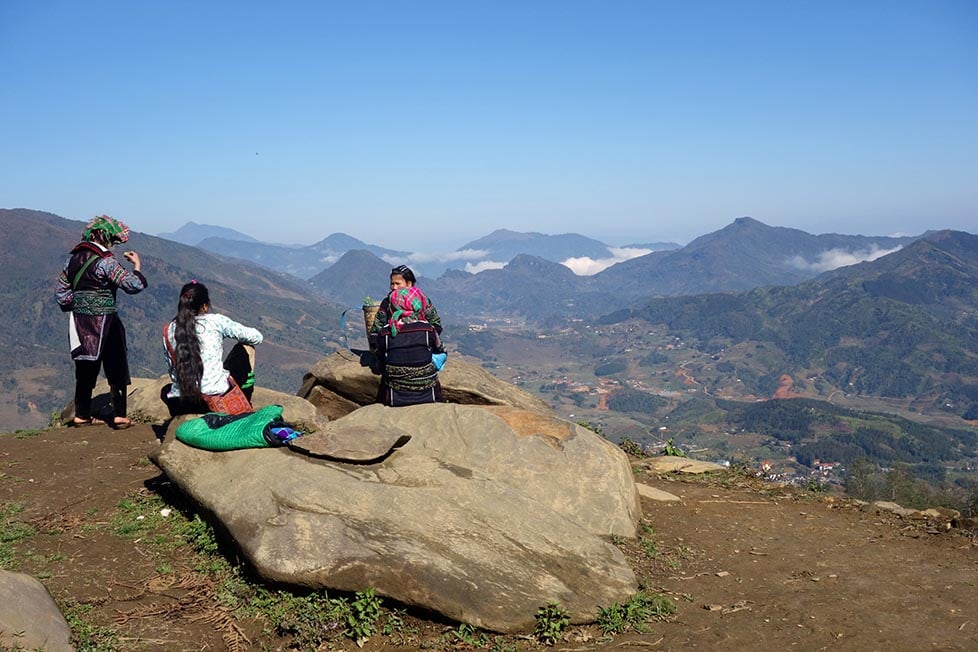
If motorbikes aren’t your thing, you can still make an awesome tour of Sapa Valley by bicycle. If you go with a company all of your food and extra transportation (not on a bicycle) is covered, but it is easy enough to organize yourself.
There are some truly awesome treks around Sapa and you could spend a few days (or a few lifetimes) here exploring. For the more adventurous, why not conquer Vietnams highest peak , Fansipan. Not quite Everest but standing at 3,143m it’s pretty impressive; it is possible to do in a day but most will recommend at least 2 days. You can do this hike solo or with trekking companies in the area.
Backpacking Ha Giang
If you fancy heading off on some even more adventure-fuelled forays, consider treks around the area or better yet, motorbiking the Ha Giang Loop ! It’s one of the most under-appreciated areas in Vietnam and attracts far fewer Western tourists than Sapa.
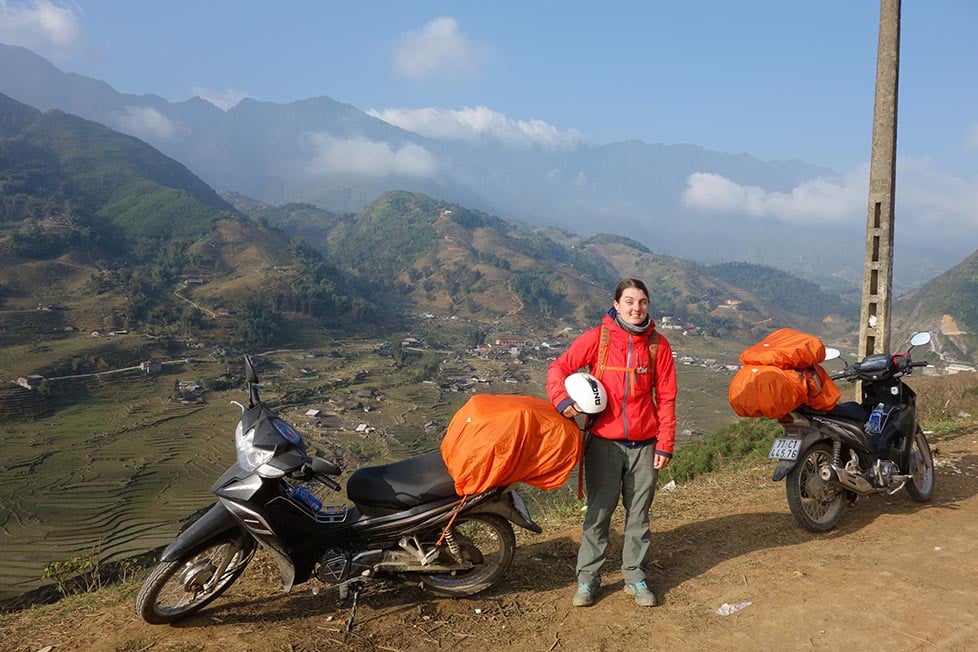
Although it’s getting more and more popular every day, there are still some hidden gems here, like the remote lake of Na Hang . There’s plenty of ripe adventure material left to find travelling in this part of Vietnam.
When looking for accommodation in Ha Giang, be sure to check out our friends at Hmong Moonshine! They are great people (ask for Tuyen) and the property itself is very beautiful. You can also learn how to make local moonshine while staying here! Allegedly, this is where I was drunk under the table by a Vietnamese grandma… Turns out I can’t hold my moonshine as well as the locals – who knew!
Backpacking Halong Bay & Cat Ba Island
This UNESCO world heritage site, often known as the Eighth Wonder of the world, is an unmissable stop whilst backpacking Vietnam. Almost everyone who visits Halong Bay does it as part of a pre-arranged package. I’m not normally one for taking the tour option but it is pretty impossible otherwise. The tour’s not too expensive and it was totally worth it.
We had a great time and were surrounded by some awesome people. It’s essential to prebook your trip and accommodation in Halong Bay ; we booked a two day, two-night tour from our stay at the Central Hanoi Backpackers Hostel.
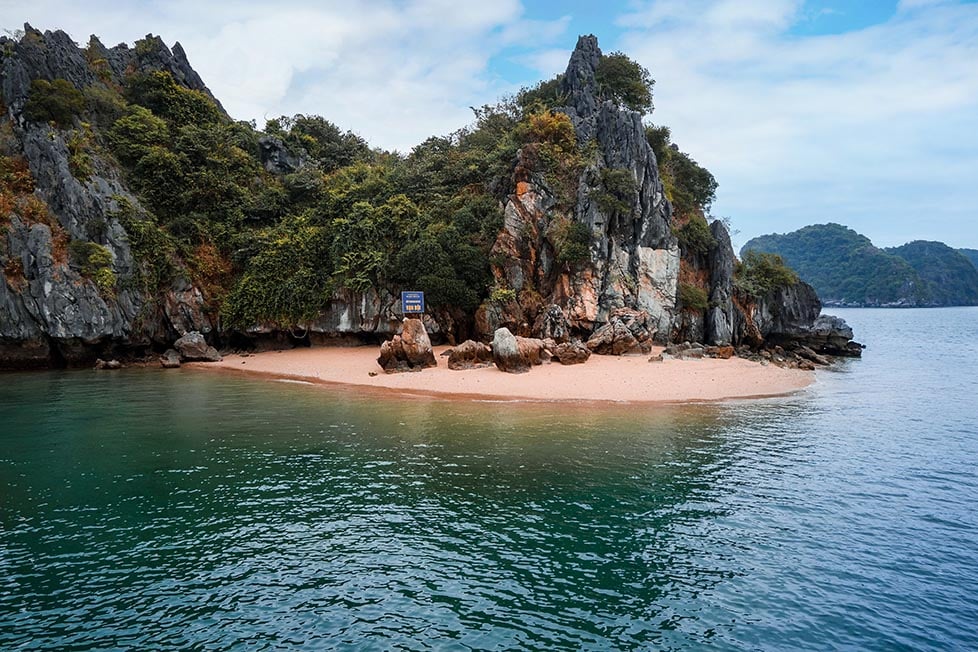
Whilst exploring Halong Bay we stayed on a cool ‘ Junk Boat ‘ one night and in beach huts the other. Being part of a prepackaged tour meant all our food, transport and everything else was included, making it a hassle-free adventure.
Once the tour is over you can either stay on Cat Ba island and check out the rock climbing scene or head back to Hanoi for a night before travelling South.
Backpacking Hue
This is a beautiful small town offering a great break in the journey from Hanoi to Hoi An. One of Vietnams most royal cities, Hue is littered with impressive historic sights, delighting the inner nerd in us all!
There are also heaps of cool backpacker hostels in Hue with bouncing little traveller vibes. It is one of Vietnam’s sticky spots – it’s just so easy to get stuck exploring and chilling out here. There is a slower pace of life compared with some of the other cities in Vietnam.
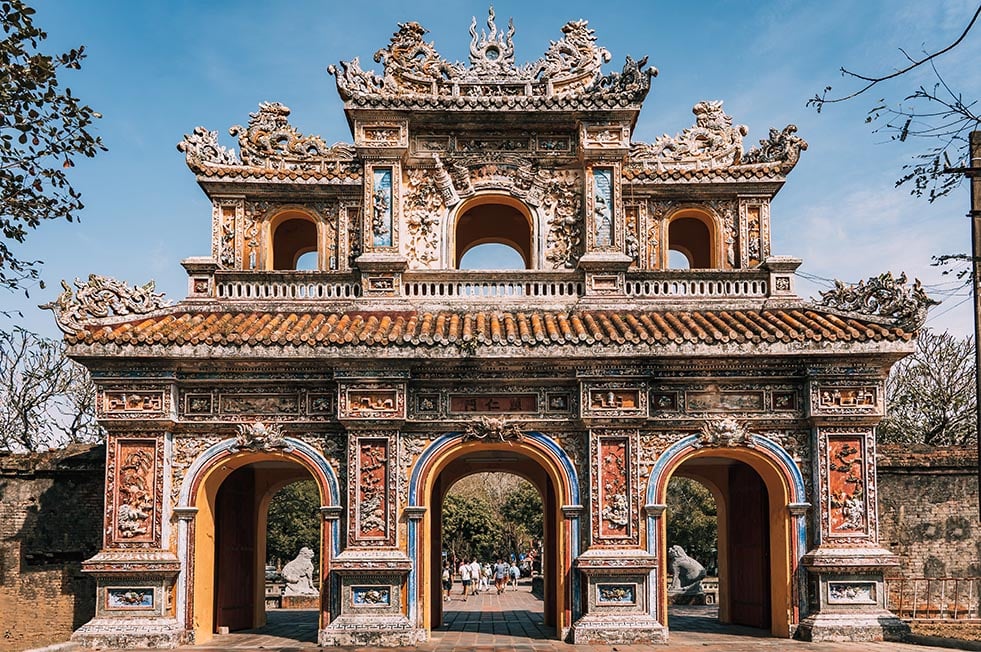
Check out the impressive Citadel on the other side of the perfume river. This impressive piece of history is made up of 4 separate citadels and will take a full day to explore. So you can hire a bike to get around!
There is a ton of things to do in Hue and you could easily spend weeks here. Check out the Thien Mu Pagoda ; standing at 21 metres high and decorated with mind-blowing architecture this pagoda is a pretty spectacular eyeful.
If rest and relaxation are what you are after the beaches of Lang Co and the mineral hot pools of Phong An are just a short distance away.
Backpacking Hoi An
Hoi An is THE place to get tailor-made clothes whilst backpacking Vietnam. There are loads of things to do but most backpackers visiting Hoi An come here to get a suit made.
Clothes tend to take at least 3 days to make so you want to get measured as soon as possible… So first stop? Find a tailor!
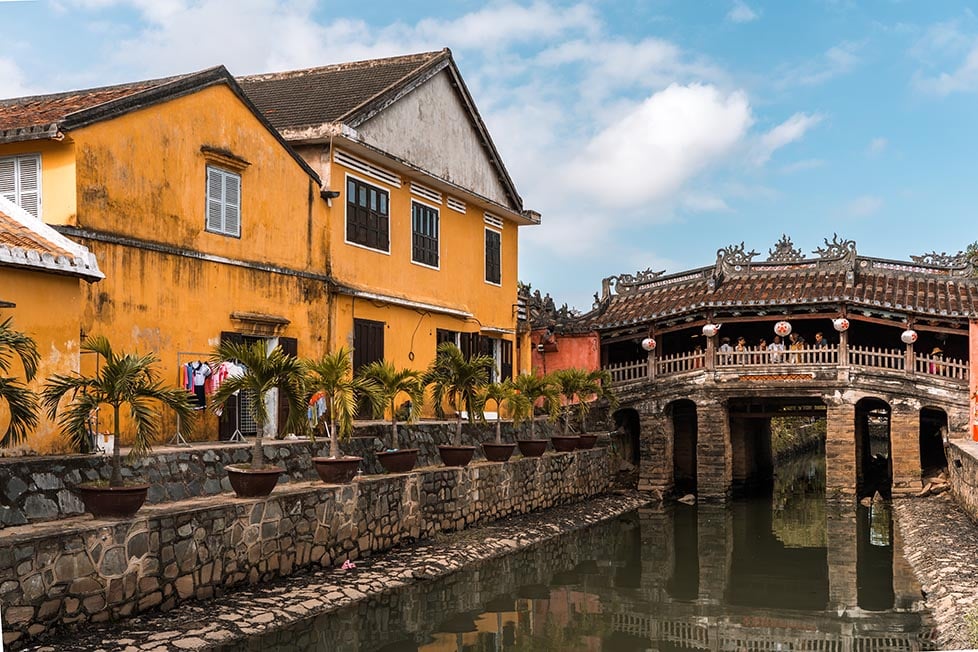
Check into Mad Monkey Hoi An – dorms start from $7 USD a night, and it has an awesome pool! Spend a few days exploring the local area by bicycle. (The hostel provides them for free.) It’s located close to the beach which is great on hot days, as you don’t have to go far!
Looking to get back into the city? Da Nang is a great day trip, only a 40-minute drive from Hue; the sandy beaches, caves and Buddhist shrines among many other activities make for the perfect day out.
Backpacking Nha Trang
Nha Trang is a perfect place to let loose, get a bit wild, and have some fun on the water. A popular water sports area with the likes of windsurfing, paragliding, and jet skiing on offer, there’s enough adrenaline here to keep even the most adventurous happy. No need to prebook; all can be arranged from the beach.
The best area to stay in Nha Trang is down the side alleys and not on the main road. It’s quieter, cheaper, and just more chill.
Something I found interesting about Nha Trang was its popularity with wealthy Russian tourists. I wasn’t expecting to eat mystery meat soup next to a large Slavic man with a shiny watch but hey, that’s travelling! Some of the bars popular with backpackers here can err on the side of dodgy , so keep your wits about you.
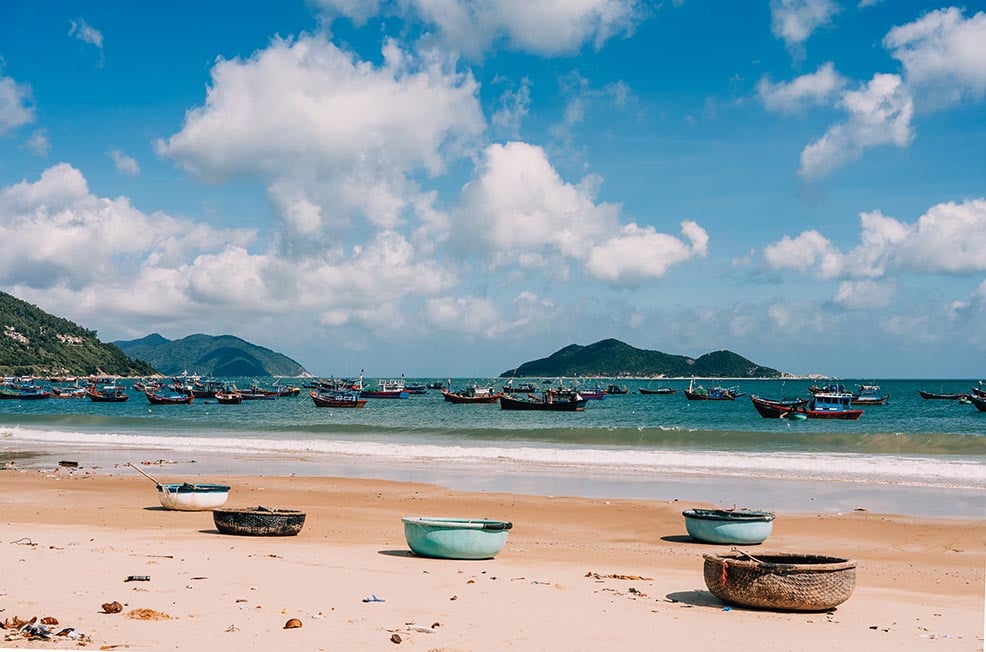
There are some great backpacker hostels in Nha Trang with awesome social vibes. The beaches are beautiful and there’s a pretty laid back vibe to backpacker life here.
There is a strange feeling that hovers over Nha Trang that I can’t quite put my finger on. It made me love it all the more, but still, there’s an oddity to it.
I think it’s got to do with the availability of cheap drugs and the associated changes to locals – and tourists who get hooked – that this brings. Rumours of Russian mafia activity abound and some of the hookers are pretty good pickpockets too. This all contrasts with a stunning, postcard-perfect exterior to create the ‘odd’ feeling.
Nha Trang is one of those interesting places that you’ll be glad you went to, but also, probably glad you left.
Backpacking Lak Lake
Recover from the heavy nights in Nha Trang and break up the journey to Dalat by venturing out to the tranquil and beautiful Lak Lake, the largest natural body of water in central Vietnam.
This region of Vietnam is home to the Mnong people . An ethnic group indigenous to Vietnam (with a small population in Cambodia too), the Mnong people, rather curiously, are renowned for designing one of the world’s oldest instruments: the lithophone .
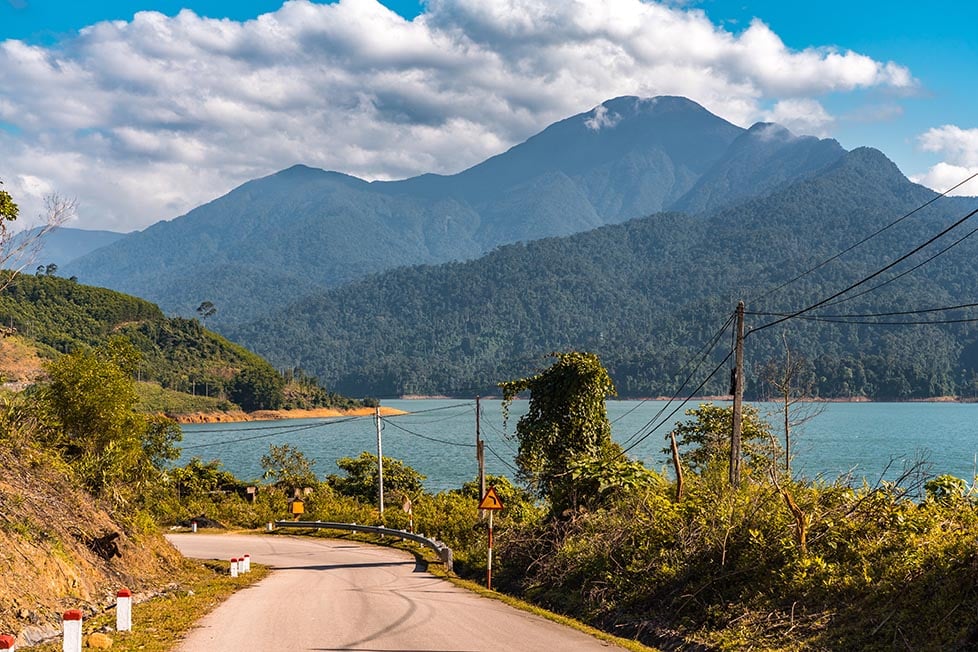
Paddle out in a kayak at sunset and enjoy the still waters and beautiful scenery. You can also explore Jun Village : A Mnong settlement of wooden stilted houses. It’s a very beautiful place to go in Vietnam and a slight departure from the regular tourist trail.
Backpacking Mui Ne
From Nha Trang you can head to Mui Ne which is home to one of the best beaches in Vietnam . You can check out the awesome sand dunes or hire a motorbike from Easy Rider for roughly 30 dollars and ride up the mountain paths to Dalat.
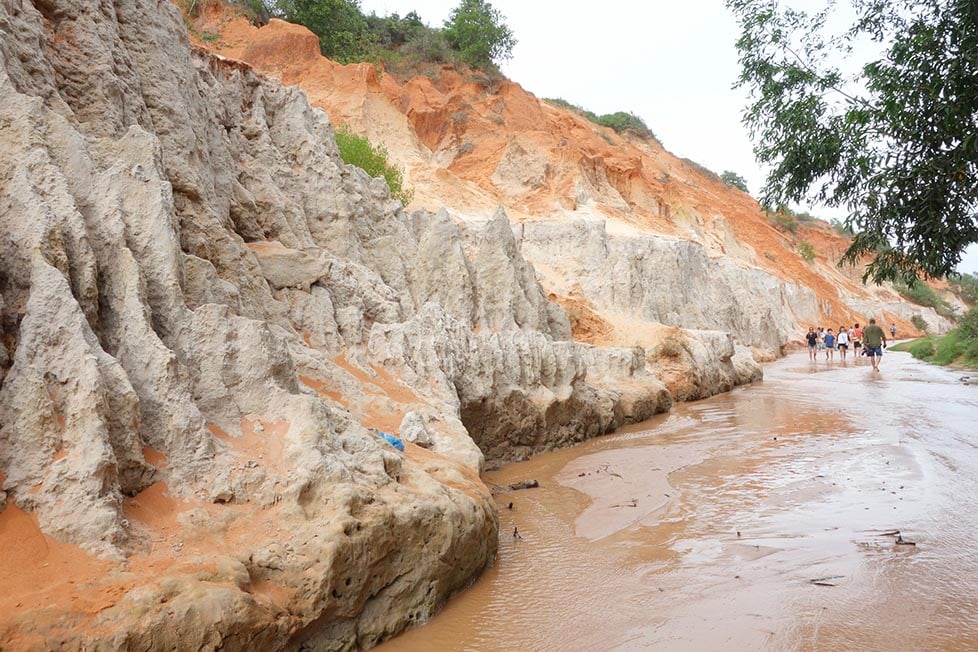
There isn’t much other than the sand dunes, beaches, and a fairy stream in Mui Ne. Ostrich riding is totally a thing though, which sounds totally awesome but it’s really kind of fucked. I am going to please ask you to consider your actions when engaging with animal tourism .
That is to say, please don’t ride the ostriches. Bombing the sand dunes is plenty fun enough.
Backpacking Da Lat (Dalat)
There is not a whole lot to do in Da Lat, but the ride itself is very scenic. I managed to crash and hurt myself quite badly because the roads are difficult, and if you have limited riding experience I suggest you hire a driver and just go on the back of the bike.
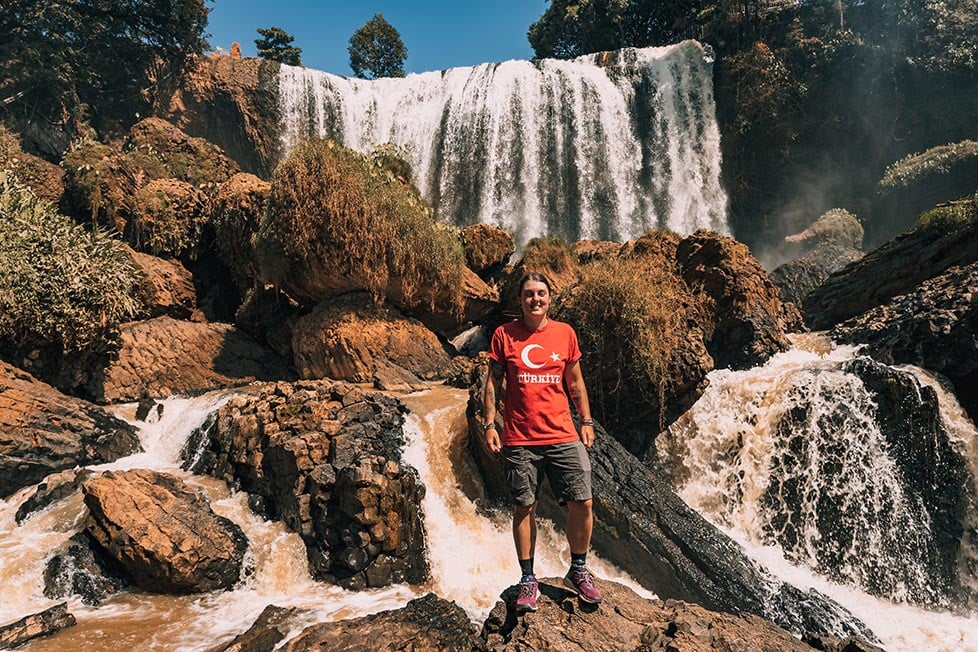
Although it’s not as stacked with activities as a lot of other destinations in Vietnam, there are still awesome budget accommodations in Dalat for backpackers to stay at. It’s a nice place in Vietnam to stay and take a breather for a few days.
I liked slowing down and getting to know the quieter side of Vietnam while in Da Lat. I couchsurfed here and we barbequed octopus and played hopscotch with the kids until late in the night. It’s one of those little memories that didn’t feel special at the time but has stuck out as a wonderful memory as the years have gone on.
Backpacking Ho Chi Minh (Saigon)
The starting point for most visitors to Vietnam, backpacking in Ho Chi Minh City (formerly known as Saigon) is a crazy bustling experience. Expensive for us broke backpackers in comparison to the rest of the country, I recommend venturing into the ‘real’ Vietnam pronto.
Although there are plenty of cool things to do in Ho Chi Minh , many of the ‘must-see’ sights around are related to the terrors of the Vietnam War.
The War Remnants Museum is a haunting insight into the life of those fighting on the front line during the period of 1954 – 1975. It costs around $1 to enter.
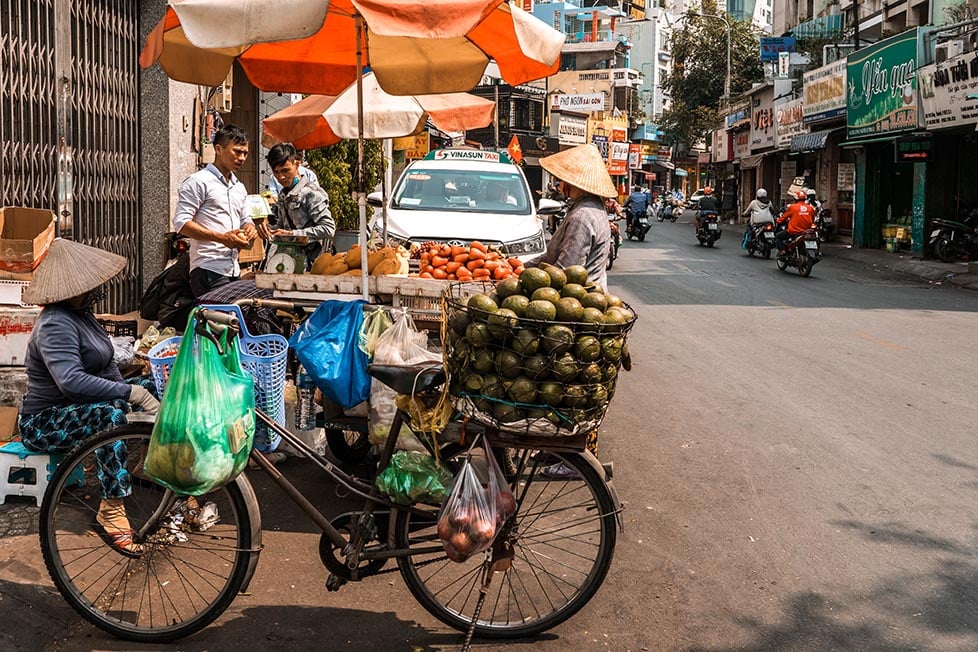
Take a trip out of the city and tour the incredible network of Cu Chi Tunnels . Brave claustrophobia and crawl around the safer sections of the restored tunnels, popping (or squeezing) out at the other end. You can pre-book half-day tours of the tunnels through the Hide Out Hostel travel desk.
From Ho Chi Minh, it is easy to arrange a bus onwards to Phnom Penh in Cambodia. You get your Cambodian visa for a fee on the border.
Mekong Delta
Mekong Delta is often referred to as the ‘Rice Bowl’ of Vietnam (there are lovely rice paddies everywhere) this maze of rivers, swamps and islands are home to tiny villages floating on the banks of the Delta.
Paddle into the floating markets and pick up some cheap trinkets, you’ll find anything and everything. Unfortunately, the market is becoming increasingly popular and much of the trinkets being sold are aimed at those travelling Vietnam.
If you have a day to kill in the Mekong consider renting a vintage Vespa scooter and checking out the Delta countryside and local culture.
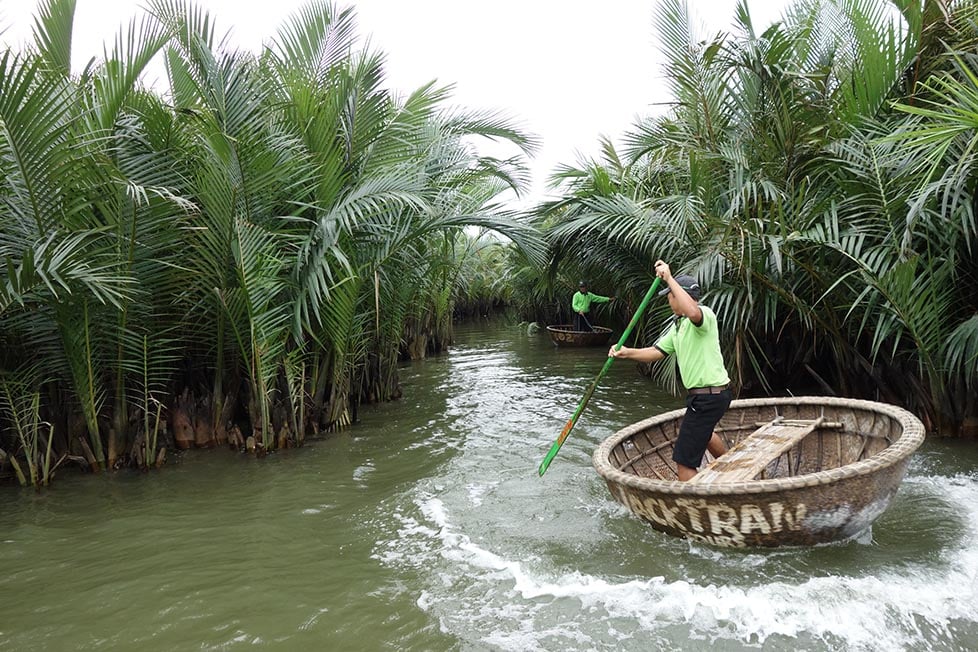
Moving past the ‘tourist’ trap section, the Mekong Delta is a paradise for local wildlife. The quiet and noise of nature is a refreshing change from the busy streets of Ho Chi Minh.
Trips to the Mekong can be as quick as half a day or a couple of days, depending on budget. However, I would recommend spending at least a day exploring the Mekong Delta. The best place to stay when exploring the Mekong Delta is Can Tho , just south of Ho Chi Minh
Getting Off the Beaten Path in Vietnam
Vietnam is certainly shooting up as a popular destination for both backpackers and holidayers. While you can stick to exploring the typical areas of Vietnam that most people visit, there is so much more to discover once you get off the tourist trail.
The Ha-Giang Loop (which I’ve already mentioned) is one such choice. It’s not one of Vietnam’s completely hidden gems anymore, however, it’s still far from touristic. Even attempting the Ha-Giang Loop by motorbike is going to give a feeling of real adventure material while simultaneously bringing you into closer contact with local communities.
As an extension of that, travelling Vietnam by motorbike (while definitely a common activity for tourists) brings even more potential for exploring the unseen sides of the country. The good thing about having your own wheels is that you can go anywhere! No village is too far off the beaten track.
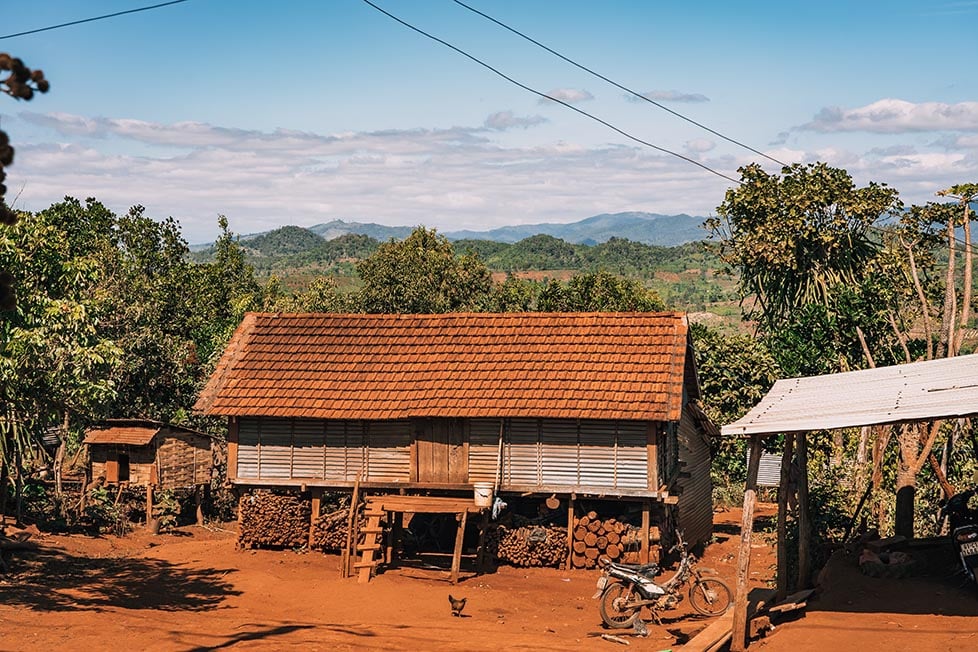
I’m also going to throw the suggestion of the Ta Xua mountain range at you. Close to Moc Chau village (another underexplored locale), the Ta Xua mountains give the feeling of walking above the heavens themself. Mountain trails wind the ranges over oceans of rolling cloud formations – sunrise is a real treat.
And lastly, if you’re packing for a beach day but prefer the feeling of lost isolation, Vietnam has heaps of lesser-known beaches to explore too! Just heading north up the coast from Nha Trang is going to land you in some dope spots like Quy Nhon . If you’re still keen to branch out from there, just rent a bike and start looking!

We’ve tested countless backpacks over the years, but there’s one that has always been the best and remains the best buy for adventurers: the broke backpacker-approved Osprey Aether and Ariel series.
Want more deetz on why these packs are so damn perfect? Then read our comprehensive review for the inside scoop!
Vietnam is loaded with cool activities – both for lovers of tourist affairs and for lovers of the road less travelled. Here’s my top pick of the coolest things to do in Vietnam!
1. Cruise Halong Bay
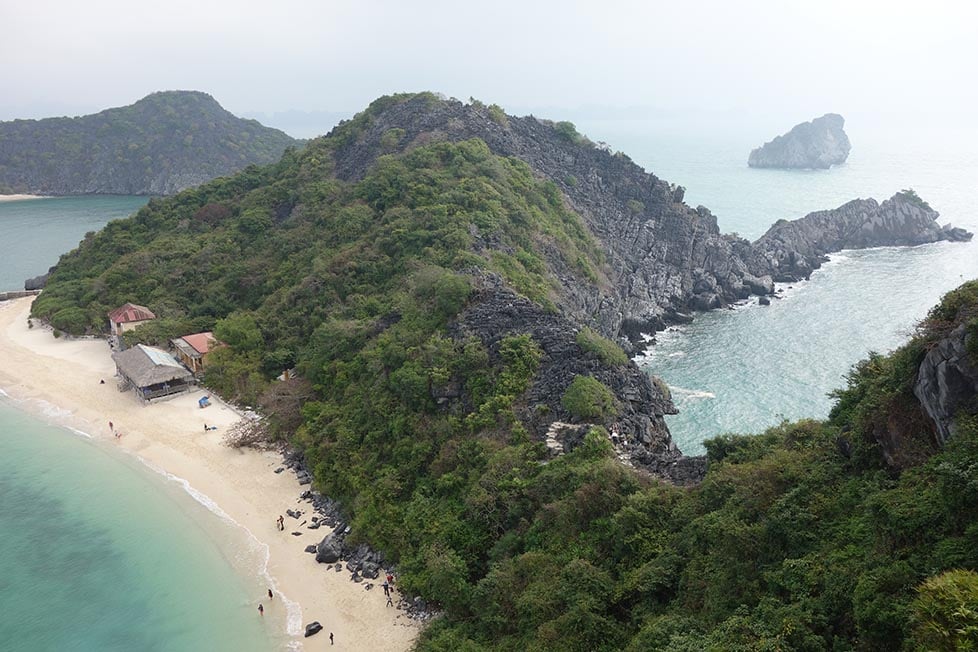
No journey to Vietnam is complete without a trip to check out Ha Long Bay. Admire the breathtaking scenery of mountainous limestone rocks while cruising Halong Bay. When the humidity hits take a leap off the side and into the tranquil water below and splash around till your heart’s content.
2. Squeeze into the Cu Chi Tunnels
See how the Vietnamese used underground tactics during the Vietnam War. Squeeze yourself into the tiny tunnels, overcoming claustrophobia as you try to experience what the Vietnamese Soldiers once did back in 1954.
3. Trekking in Sapa
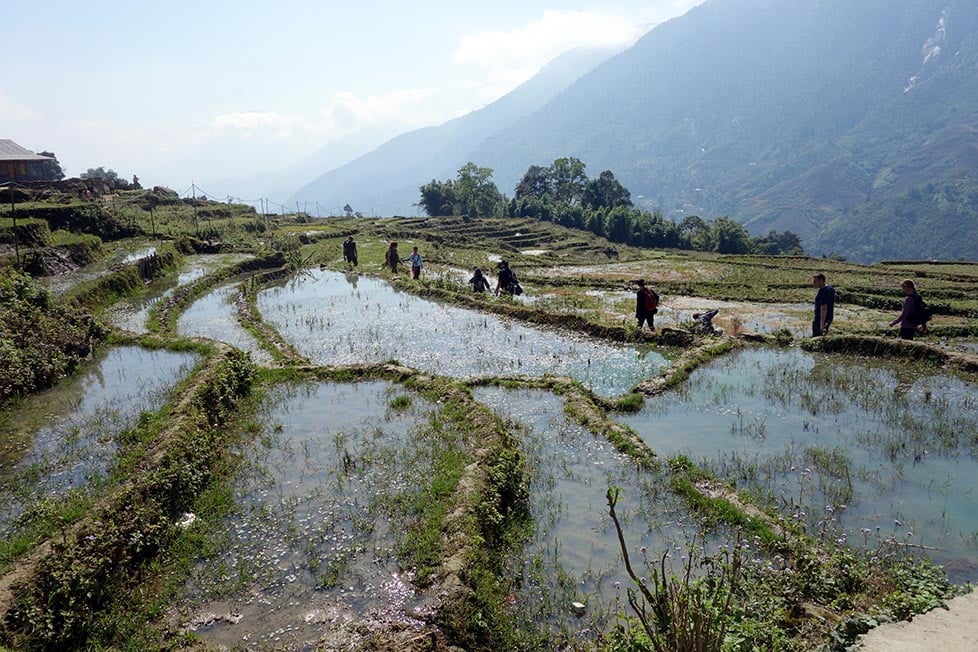
Leave the hustle and bustle behind and check into some of the most beautiful mountainous landscapes in Asia. Home to Vietnam’s highest peak Fansipan, Sapa is a dream to trek, and standing at 3,143m it’s pretty impressive. If this is a bit too adventurous, enjoy the day walks or simply kick back and take in the beautiful views.
4. Suit up in Hoi An
Thailand has Elephant Pants and Vietnam has incredible Silk Suits. Watch the talented tailors at work in Hoi An and get your own creation made cheaply, beautifully, and in just a few hours!
5. Motor Bike across the Country
This is a fantastic way to see the countryside. Of course, more information is coming about exploring on 2 wheels in the motorbike travel section below.
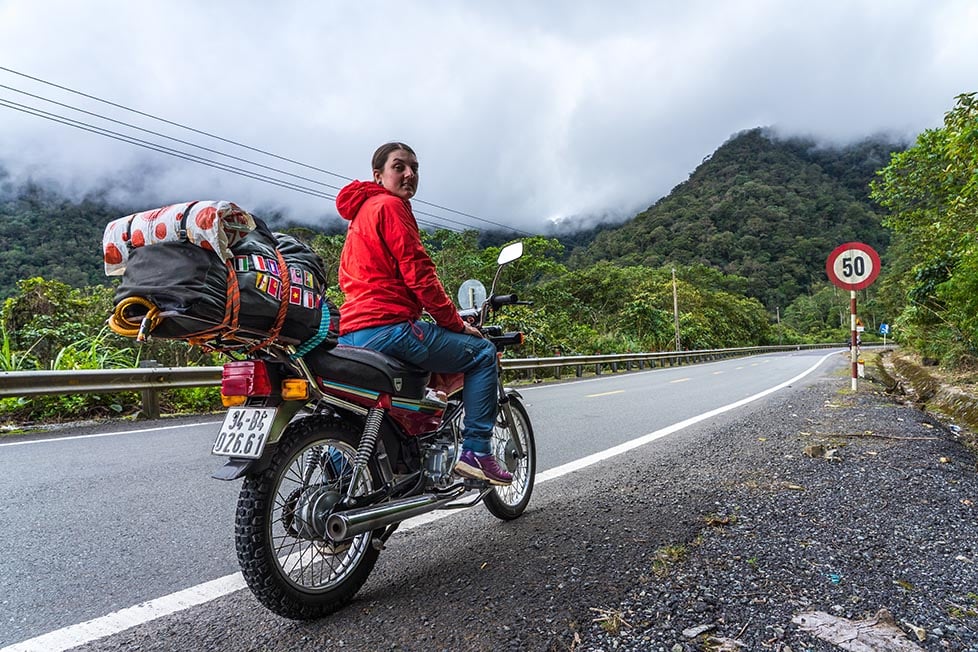
6. Water Puppet Show
Originating as far back as the 11th Century from the villages of the Red River Delta in Northern Vietnam, Water Puppet Shows are incredible. Lasting from as little as 5 minutes to hours, these are shows that you have to check out when travelling in Vietnam.
7. Bar Hop Ba Hoi
Friendly bars with cheap beer, laid back feels and even more friendly locals. Often located up sketchy looking side streets, these little bars are a great place for a laugh and cheap beer.
8. Street Food
For as little as $1 for a great meal, you really have no excuse not to try some of the local delicacies. We’re talking the classic Banh Mi and fetal duck eggs. There’s turtle soup, pho, and beef in every way you can imagine. This country is simply spoiled with the finest food in Southeast Asia.
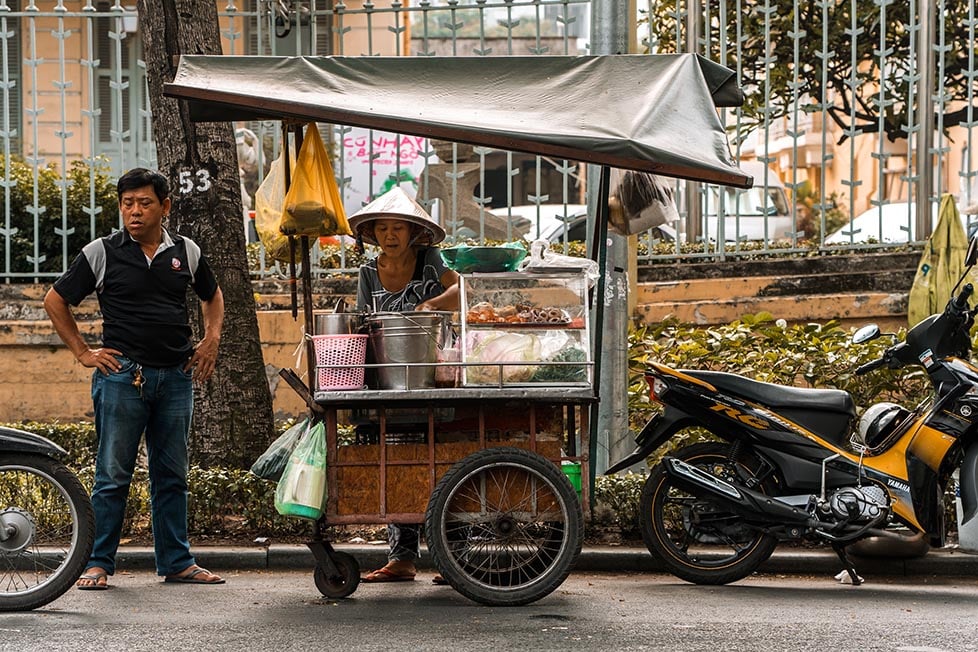
Wanna know how to pack like a pro? Well for a start you need the right gear….
These are packing cubes for the globetrotters and compression sacks for the real adventurers – these babies are a traveller’s best kept secret. They organise yo’ packing and minimise volume too so you can pack MORE.
Or, y’know… you can stick to just chucking it all in your backpack…
Vietnam has some of the cheapest accommodation in Southeast Asia . You can find a dorm bed for as little as $3 USD a night or a private room with a fan for $7 USD .
The hostel scene is pretty awesome. It’s super diverse with party hostel, co-working spaces, and grungy, old school hostels all in the mix.
You can expect to meet some interesting characters while staying in a hostel . This is where you can trade travel stories and pick up tips about where to go next. If hostels don’t sound like your thing – or maybe you just want to indulge in a double bed for a special occasion – Vietnam also has a range of great Airbnbs.
You can stay in whole apartments for less than $50 a night. When that one guy at the hostel has told you the story about how he almost became an international drug smuggler but then he remembered about his ethics so he just dodged taxes instead, an Airbnb can seem more appealing for a night. And even luxury Airbnbs in Vietnam is not out of the question for a solo backpacker in Vietnam looking to splurge for one night.
In between swanky Airbnbs and party hostels are a bunch of great guesthouses and homestays. Many of these aren’t listed online but are well known via word of mouth.
Wherever you choose to stay in Vietnam, it’s not going to be expensive – but it will be a great time!
The Best Places to Stay in Vietnam
Travelling in Vietnam can be cheap without you really having to think about it. I spent around 20 dollars a day in Vietnam, sometimes a little more when splurging on a day trip or imported beer. You could very easily travel on less than 10 dollars a day, while still enjoying yourself.
As I’ve (hopefully) made clear in this guide, I LOVE Vietnamese food! Mostly that’s because it’s so damn delicious, but partly it’s because it’s so cheap. If you spend $3 on a meal in Vietnam, you’re going to be full to the brim and overdosing on tastiness.
A l ocal beer costs around 80 cents , although imported beers are still expensive. Going out for a night to see some music or have drinks in a bar can be done for less than $10! (And that’s drinking A LOT!)
Local transport is very cheap; though an airconditioned bus ride will be around $15 . Generally speaking, the further from the city centres that you get, the cheaper life becomes.
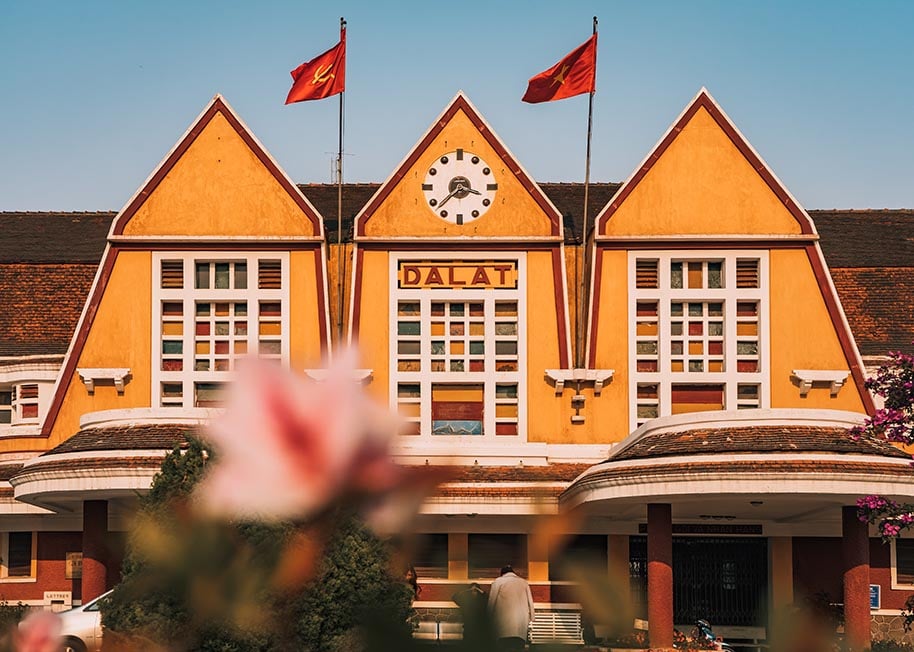
A Daily Budget in Vietnam
Money in vietnam.
Ever wanted to throw cash in the air and feel like a millionaire? Well, the Vietnamese Dong allows every broke backpacker travelling in Vietnam the opportunity to feel rich. As of 09/11/21, $1 US = 22,660 Vietnamese Dongs – crazy huh?
Plus the name is Dong… Which, when enjoying multiple dirt-cheap beers, is consistently amusing.
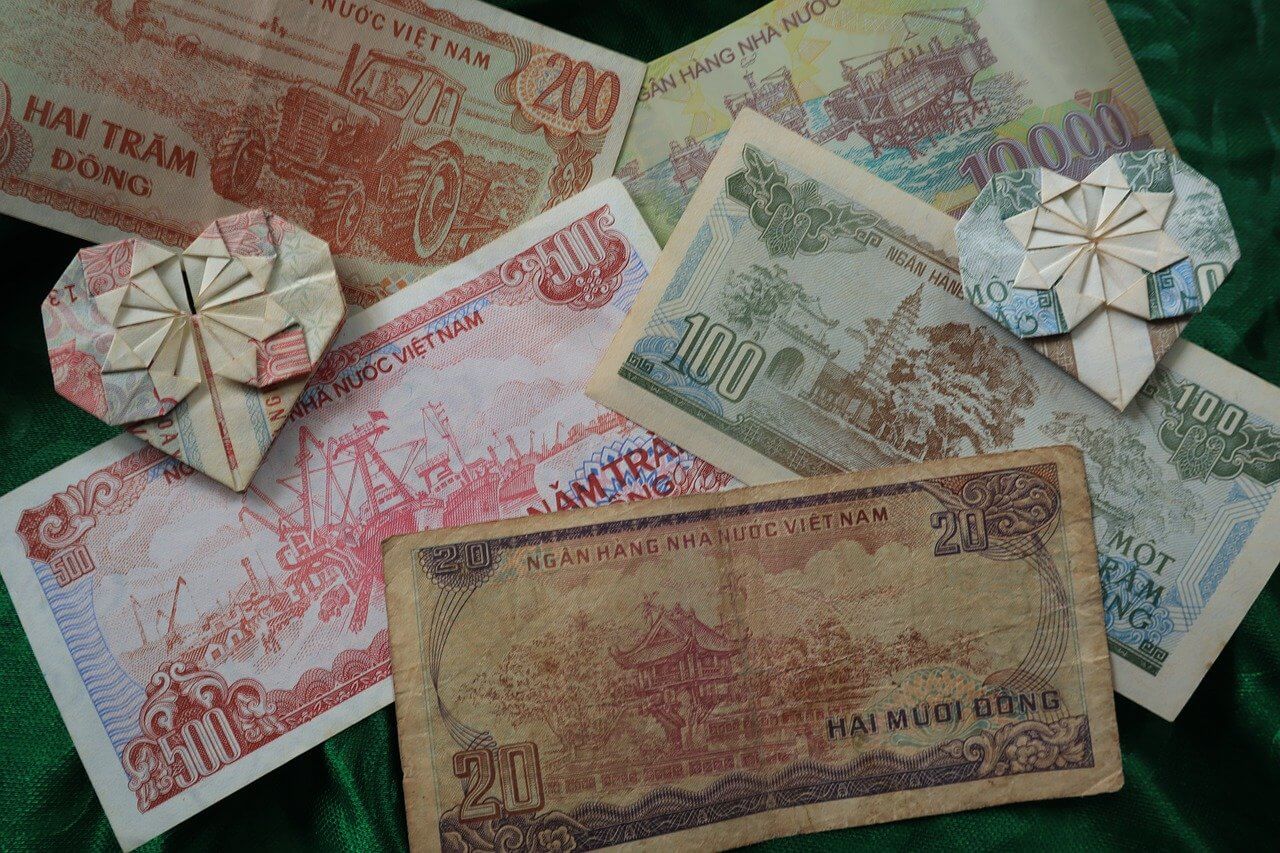
Don’t try to obtain Vietnamese currency before entering the country, it’s pretty much impossible. If you managed to snag some, you’ve probably had a pretty bad exchange rate. Take US dollars into Vietnam, you’ll find many shops and services accept US dollars.
Credit and Debit cards are widely accepted in the more built-up areas such as Ho Chi Minh and Hanoi but many of these, charge pretty insane withdrawal fees so it’s advisable to avoid small ATM transactions and get out a bunch of cash at once – just make sure you hide it well.
For all matters of finance and accounting on the road, The Broke Backpacker strongly recommends Wise – The Artist Formerly Known as Transferwise! Our favourite online platform for holding funds, transferring money, and even paying for goods, Wise is a 100% FREE platform with considerably lower fees than Paypal or traditional banks. But the real question is… is it better than Western Union? Yes, it most certainly is.
Travel Tips – Vietnam on a Budget
Vietnam is one of the cheapest destinations in Asia. However, it is still possible to go a little out of control, especially when the currency makes you feel like a millionaire. Standard budget backpacking tips aside, here are my top tips to keep it for backpacking Vietnam on a budget…
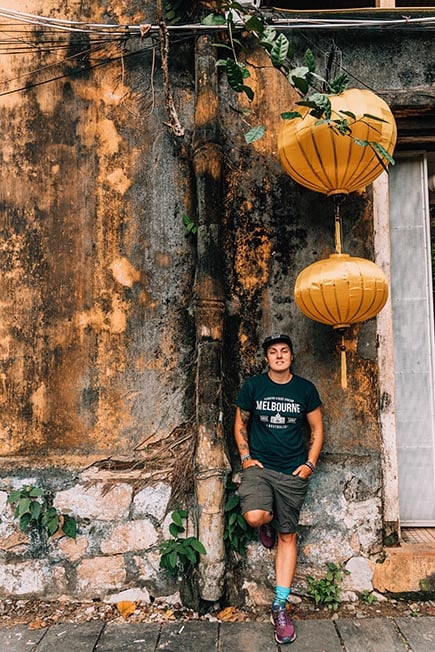
- Camp : Vietnam has some incredible countryside and coastline, views that shouldn’t be wasted by sleeping inside. Camping is most popular within the National Parks up and down Vietnam. Pack up your best backpacking gear and take adventures outdoor.
- Take the Bus : The national bus service or ‘the chicken bus’ has great links throughout Vietnam, even into some of the more remote areas. For as little as $1 a ticket, I’d happily sit next to a chicken for a few hours.
- Eat Street Food : Seriously, the food here is so cheap – and so declicious – you might as well indulge! Cooking for yourself probably won’t end up saving you much when you can get a meal on the street for $2 USD. Plus, you can’t make pho like the grandma up the road can!
- Understand the Money : If, like me, you don’t have a great mathematical brain, use a currency app to help you understand how much you are spending. Knowing the value of the currency will help you avoid being ripped off or spending too much without realising.
- Couchsurf: To connect with the locals, try meeting people with Couchsurfing. You’ll get a free place to stay, and you’ll probably make a friend!
- Keep it Local : Where possible drink the local beer, eat the local delicacies, and for day trips, try to use local companies. By using local companies you can haggle a bargain price that larger, international tour operators won’t offer. Plus supporting local businesses thrive is awesome!
- Hitchhike: I didn’t hitchhike whilst backpacking Vietnam but I have a couple of amigos who have hitched the whole length of the country, no worries. Getting around by hitchhiking is a great way to travel for free, meet local people, and kick plans to the kerb!
- Budget-friendly Tours: If you do happen to go on any guided tours, at least make it a tour where you can pay it off in instalments. Global Work and Travel have the broke backpacker in mind with this one. You can even choose the amount per instalment! There are loads of Vietnam tour options to tickle your fancy.

Why Should You Travel to Vietnam with a Water Bottle?
Whilst there’s a lot that we can do when it comes to travelling responsibly , reducing your plastic consumption is one of the easiest and most impactful things you can do. Don’t buy one-use water bottles, don’t take plastic shopping bags, and forget straws. All of this just ends up in landfills or in the ocean.
There’s nothing worse than showing up to a picture-perfect beach, only to discover plastic bottles littering the sand. One way to get around this is by investing in a premium filtered travel bottle like the Grayl Geopress. You can filter any kind of water, save money on buying endless plastic bottles – and sleep easy knowing you’re not contributing to the plastic bottles lining our beautiful beaches.

Drink water from ANYWHERE. The Grayl Geopress is the worlds leading filtered water bottle protecting you from all manner of waterborne nasties.
Single-use plastic bottles are a MASSIVE threat to marine life. Be a part of the solution and travel with a filter water bottle. Save money and the environment!
We’ve tested the Geopress rigorously from the icy heights of Pakistan to the tropical jungles of Bali, and can confirm: it’s the best water bottle you’ll ever buy!
Vietnam is a country with multiple weather patterns ranging from monsoon rains, cold snaps, and hot, humid sunny days. It can be hard to catch the whole country at a consistent time of year. But no fret, it is possible!
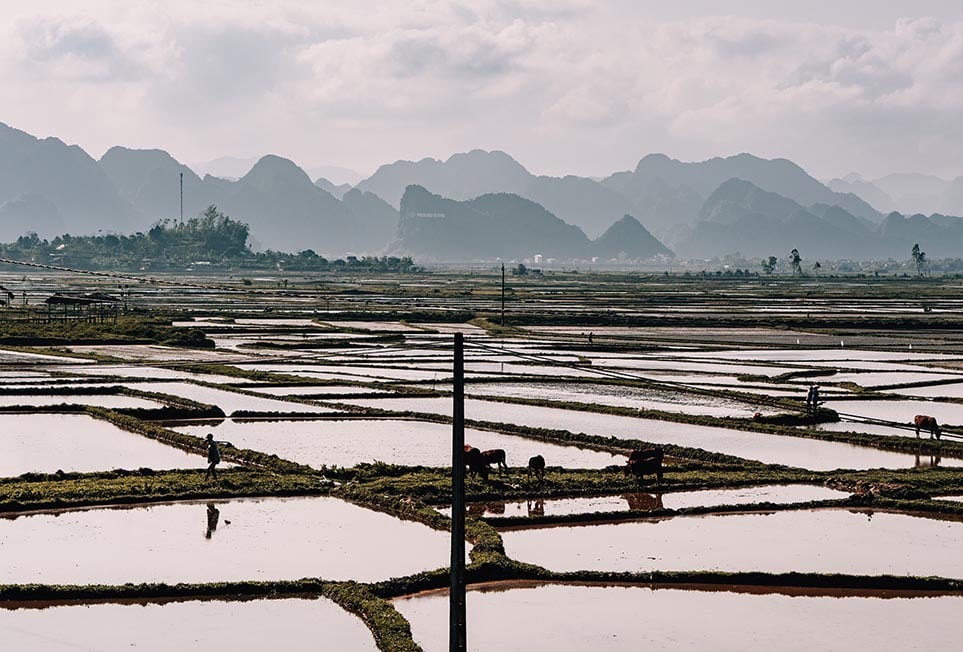
If you are planning to backpack Vietnam from top to bottom, the best time of year generally is September – December (Autumn) and March – April (Spring). These times of the year are your best weather window, where you might be lucky enough to see the whole country in sun!
Looking for specifics? Let me break down by regions, the best time of year for backpacking Vietnam:
- North Vietnam : October to May will give you dry weather the majority of months. Expect some colder temperatures in the mountains and from March onwards, a little more rain as it gets more humid.
- Central Vietnam : February to July is the best time of year to avoid heavy rain. Temperatures will hit the upper 30s in June to August.
- Southern Vietnam : December to April is the ‘dry’ season. Temperatures will rarely fall below 20 degrees and will reach up to 40 degrees come March/April.
What to Pack for Vietnam
Make sure you get your packing for Vietnam right! On every adventure, there are 6 things I never go travelling without:

Snoring dorm-mates can ruin your nights rest and seriously damage the hostel experience. This is why I always travel with a pack of decent ear plugs.

Hanging Laundry Bag
Trust us, this is an absolute game changer. Super compact, a hanging mesh laundry bag stops your dirty clothes from stinking, you don’t know how much you need one of these… so just get it, thank us later.

Sea To Summit Micro Towel
Hostel towels are scummy and take forever to dry. Microfibre towels dry quickly, are compact, lightweight, and can be used as a blanket or yoga mat if need be.

Monopoly Deal
Forget about Poker! Monopoly Deal is the single best travel card game that we have ever played. Works with 2-5 players and guarantees happy days.

Grayl Geopress Water Bottle
Always travel with a water bottle! They save you money and reduce your plastic footprint on our planet. The Grayl Geopress acts as a purifier AND temperature regulator. Boom!
With these essentials, I still make sure to do a rundown of my full backpacking packing list .
Vietnam is extremely safe for travel. Violent crime is almost nonexistent in Vietnam. Petty crime and pickpocketing can be an issue in the cities however, so just watch your valuables or leave them locked at your hostel. Where backpackers need to be careful is riding a motorcycle.
Vietnam’s cities are hectic, and the countryside has windy roads and animals roaming around. Even though road tripping with a motorcycle is a huge part of Vietnam tourism, I don’t recommend this for beginners.
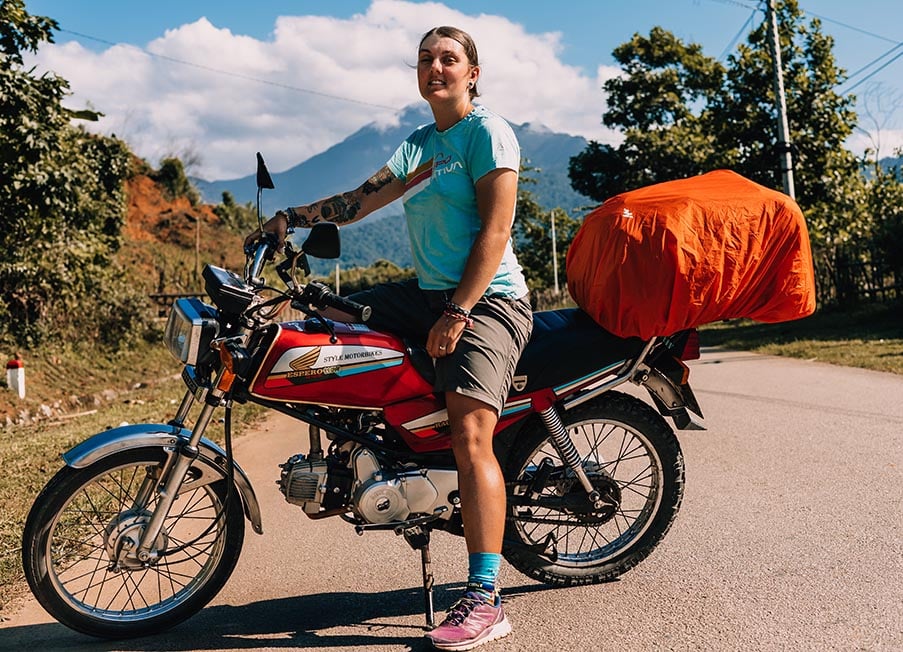
Dense cities and tourist attractions are still questionable (as they usually are). Vietnam isn’t rife with petty crime, but keep an eye on your valuables.
Past that, Vietnam is pretty standard ‘travel in Southeast Asia’ stuff, and even by that metric, it’s very chill. Stick to the standard advice for safe travel and you’ll be fine.
Sex, Drugs, and Rock ‘n’ Roll in Vietnam
The penalties for drugs are really harsh in Vietnam, like other neighbouring countries in Southeast Asia. Weed is the most commonly used drug throughout Vietnam, but you will get into a bunch of trouble for having it if you’re caught.
Let’s be realistic though, you’re probably going to try drugs on the road. In Vietnam, there are definitely underground scenes amongst locals – especially students – so having local friends helps when looking for a joint.
I’d advise against travelling even between cities with anything considered illegal. Once you arrive in a new city, ask around from there.
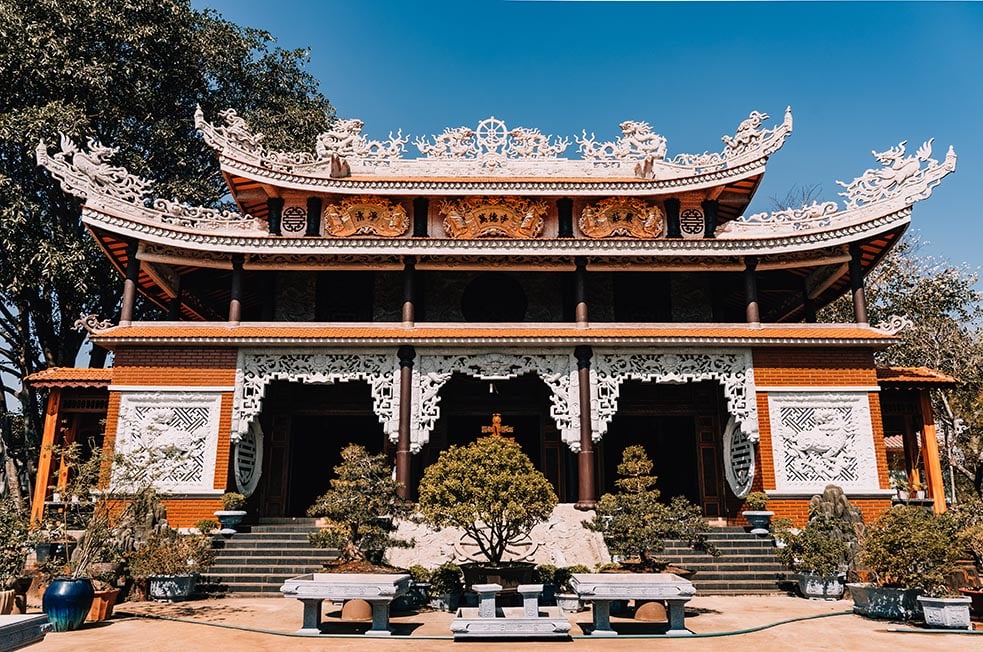
As for sex? Well you’re a backpacker, aren’t you? 😉 Of course, there will likely be a one night stand in your backpacker travels – whether you bone down in a hostel or have a sensuous encounter with a particularly beautiful local.
Through it all, you gotta be a good person. Free love is about love as much as it is about sex, y’know?
Also, I’d be remiss not to mention ‘sex tourism’. Everything is cheap in Asia, including the services of sex workers. This has led to an industry in Southeast Asia that can be very ethically murky. Regardless of your opinion on sex working in general – and whether or not you engage with sex working services – there is no reason for you to not have respect for another human being.
There are enough people in this world with bad intentions and rotten hearts – there’s no need to add your name to that list. But you know that.
Travel Insurance for Vietnam
Right, now let me be the first to admit that my travels sometimes involve some sketchy activities! But rather than ignore my wild side, I just insure in with World Nomads! That way, I can still have my adventures while knowing if shit hits the fan – I’m covered by insurance.
ALWAYS sort out your backpacker insurance before your trip. There’s plenty to choose from in that department, but a good place to start is Safety Wing .
They offer month-to-month payments, no lock-in contracts, and require absolutely no itineraries: that’s the exact kind of insurance long-term travellers and digital nomads need.

SafetyWing is cheap, easy, and admin-free: just sign up lickety-split so you can get back to it!
Click the button below to learn more about SafetyWing’s setup or read our insider review for the full tasty scoop.
Vietnam is one of Southeast Asia’s most accessible countries. Whether you are travelling the Southeast Asia loop and entering by land, coming down from China, or flying directly there, border crossings are relatively straight forward and the days of the tricky Vietnamese visa are now over.
There are long-distance bus/train services that you can use to get all the way from Bangkok to Ho Chi Minh City, or if you’re feeling more adventurous, train it from Europe all the way to Vietnam…
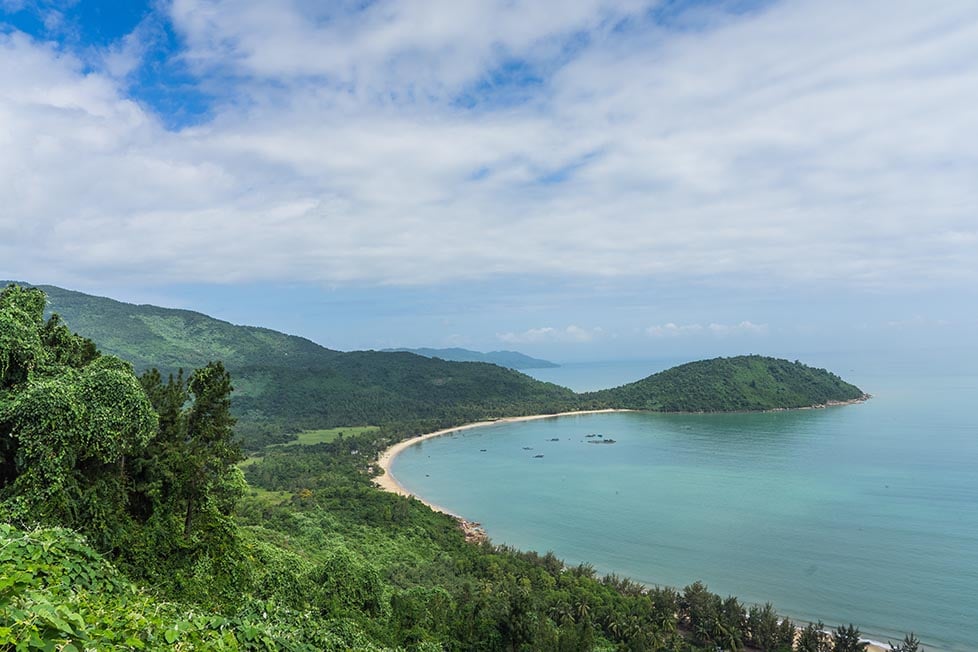
For those backpacking Vietnam without the luxury of time, the best way in is to catch a flight to Ho Chi Minh City. There are flights with the likes of Emirates (via Dubai), Air China (via Guangzhou), and many more Airlines.
I’ve found Vietnam Airlines tend to have the best deals for flying direct to Ho Chi Minh City. Most flights will land in Ho Chi Minh but you can fly to other parts of the country.
You can enter Vietnam by motorbike easily and you can easily travel from Cambodia across the border to Vietnam using local buses. Or, if you fancy travelling in style, there are VIP bus services available for flash-packers.
Entry Requirements for Vietnam
Most countries require a visa to enter Vietnam, however, there is a shortlist of countries that are exempt for short stays. Past that, you’ll need to organise a Vietnam e-visa for a 30-day stay.
Thankfully e-visas are relatively straightforward to organise before you travel to Vietnam. If you don’t want to organise it yourself, there are many companies out there who can help you apply.
And if the 30 days in Vietnam just feels too short, no worries! You can extend once you’re there.

Get 15% OFF when you book through our link — and support the site you love so dearly 😉
Booking.com is quickly becoming our go-to for accommodation. From cheap hostels to stylish homestays and nice hotels, they’ve got it all!
Comfortable long-distance transport and constantly improving road quality make travelling in Vietnam pretty smooth. Vietnam has a great coastal train line that extends up to the Chinese border making travelling onwards to China a snap! It’s a great way to travel across Vietnam on a time limit.
Most backpackers choose to explore Vietnam via bus network. Buses in Vietnam are cheap, plenty are hop-on/hop-off style tickets, and they have ever-increasing presence of Air Con. Basically, they are a broke backpackers dream.
A great way to get from one end of the country to the other fast and scenically. Vietnam Railways operates a single track train network running from Ho Chi Minh city all the way to the Chinese border with beautiful views of the countryside and coast. Slightly slow in places as much of the train line dates back to the colonial period – but that’s just part of the charm, right?
Ensure you book your tickets in advance. Hard sleeper class offers the best value. Be aware that if you buy a through ticket you cannot break up the journey along the way, you will need separate tickets for this. Hop on the Reunification Express for a breathtaking journey.
I did not travel via domestic flight within Vietnam. However, if you are on a time limit, a 2hr flight from Ho Chi Minh to Hanoi is a lot more favourable than 30hrs + it can take on the train. Vietnam Airlines, the national carrier, and Jetstar both offer cheap and backpacker-friendly flights to many destinations within Vietnam.
Rather than just rocking up at the station in the hope they will have space to fit you on, you can now book tickets in advance for most of Southeast Asia using Bookaway .
Travelling by Motorbike in Vietnam
To kick your backpacking adventure into the next gear, get a motorbike. Travelling by motorbike across Vietnam is often more cost-effective than paying for multiple train/bus tickets.
It gives you the freedom to really explore, get off the highway and go in search of raw adventure… Plus you look cool and you don’t have to deal with the drunken Aussie lads on the bus attempting to rope you into a game of ‘drink the beer’.
I picked myself up a Honda Win Manual Motorbike second hand from one of the many backpackers selling their bikes in Ho Chi Minh. I paid around $300 and, for the few weeks I had it, only some minor repairs were needed.
Before travelling to Vietnam, I had never actually ridden a motorbike before and I was, in truth, a little intimidated. Luckily, riding a motorbike is a lot easier than it looks and after about an hour of (somewhat, hilarious) practice, I was good to go.
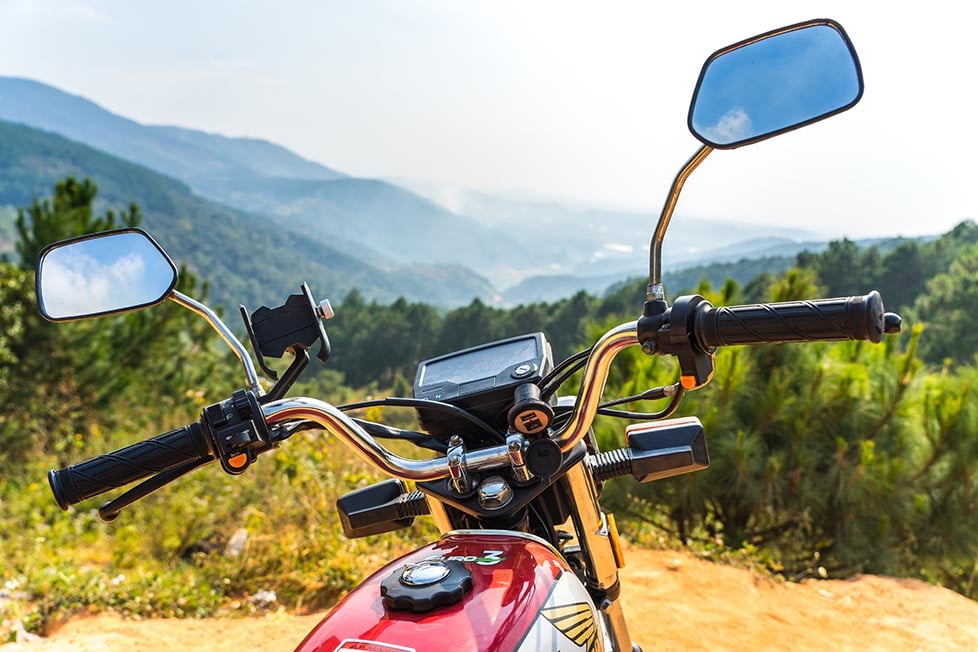
I had this expectation that the roads in Vietnam were going to be dangerous dirt tracks. But for the most part, they are fairly decent besides a few potholes. The biggest threat to you on the road is your own lack of attention, other drivers and animals/people. Make sure your travel insurance covers you for riding a motorbike in Vietnam.
Unfortunately, accidents among travellers are common; I came off my motorbike myself in Dalat and got away with just cuts and bruises… The bike flipped and hit me in the back of the head, and my helmet almost certainly saved my life – always wear a helmet .
I’d also consider bringing a dedicated tent for your motorbike if you want to save money on accommodation. I usually rocked up to a restaurant for dinner & politely asked if I could set up there for the night. They always said yes and never charged me a dime.
Onwards Travel From Vietnam
Vietnam is well placed for onward overland travel to Cambodia , Laos, and China which all border Vietnam. You can bus, motorbike, or hitchhike in a truck full of onions over any of these borders. There are also cheap flights to Thailand, Malaysia, and beyond if you want to carry the Southeast Asia party on that a-ways!
If your travel funds are running low, it’s well worth considering a flight Down Under to the famously high minimum wage of Australia! Or, if you want to chill out in some colder climates, why not try backpacking in New Zealand ?
The long and the short of it is, you’re spoilt for choice when it comes to onwards travel from Vietnam!
- Backpacking China
- Backpacking Malaysia
- Backpacking Laos
- Backpacking Thailand
Yes, yes, 1000 times, yes! I have no short number of long-term travelling friends that do a stint working a backpacker job in Vietnam to build up their cash supplies.
You will need a work permit to work in Vietnam though. A work permit/visa is valid for up to 2 years (non-renewable) and the pressure of the paperwork is off because the responsibility is on your employer! You’ll need to be sponsored by your prospective employer who will then be responsible for the organisation of your working permit.
Vietnam is also an up and coming digital nomad hotspot. It’s got fast internet, a good ex-pat science, and it is ridiculously cheap. There are not many other places in the world where you can get lunch for 2 dollars, and a beer for 80 cents while working with lightning-fast internet.

A new country, a new contract, a new piece of plastic – booooring. Instead, buy an eSIM!
An eSIM works just like an app: you buy it, you download it, and BOOM! You’re connected the minute you land. It’s that easy.
Is your phone eSIM ready? Read about how e-Sims work or click below to see one of the top eSIM providers on the market and ditch the plastic .
Teaching English in Vietnam
Teaching English in Vietnam is one of the most popular forms of work for foreigners in the country. With the right qualifications (i.e. a TEFL certificate ), you’ll find a lot of doors opening to you with some decent wages too (relative to the standards of Asia).
TEFL courses open up a huge range of opportunities and you can find teaching work all over the world with one! Broke Backpacker readers get a 50% discount on TEFL courses through MyTEFL (using the code PACK50).

You’ll need a prospective employer to sponsor you (and to go on a contract too). However, then an expat lifestyle in Vietnam awaits! There are heaps of schools around Vietnam that are always looking for fluent English speakers willing to teach. There are even heaps of adults wanting to learn.
A lot of people end up working in the major cities (like Hanoi or Ho Chi Minh) simply for the amount of work available and modern lifestyle. Of course, as I always tell people looking to teach English abroad , getting out of the urban jungles and into the villages and rural areas is going to offer a much more authentic and wholesome experience.
Volunteering in Vietnam
Volunteering abroad is an amazing way to experience a culture whilst helping your host community. There are plenty of different volunteer projects in Vietnam including teaching, construction, agriculture, and pretty much anything.
If the regular ol’ day job isn’t beckoning however, volunteering in Vietnam is a spectacular backup choice! You’ll lower your travel costs, connect with local communities, and give back all your best vibes and smiles while you’re at it! Volunteer programs run through reputable work exchange programs like Worldpackers and Workaway still have their flaws but they’re a great way to get your foot in the door of the volunteering community.
Although only surpassed only by Indonesia as Southeast Asia’s most heavily populated country, Vietnam is the region’s most ethnically homogenous country with the Vietnamese making up about 85% of the population. Most of the remaining population in Vietnam is made up of a variety of minority ethnic groups and peoples with their own customs and traditions.
Being a communist country, Vietnam has no state religion and atheism is encouraged. In truth, the majority of the Vietnamese people either identify with folk traditions or are just straight atheistic. Buddhism and Catholocism are the other two big religions in the country. Across all beliefs, the family and ancestor worship remain pillar belief concepts.
Once you get to know a Vietnamese person, I can guarantee you that you won’t stop laughing. There’s a lot of banter and a kind of humour that’s a second cousin of sarcasm. I don’t know quite how to describe it, but there’s a lot of pointing out the randomness of life and having a good laugh about it.
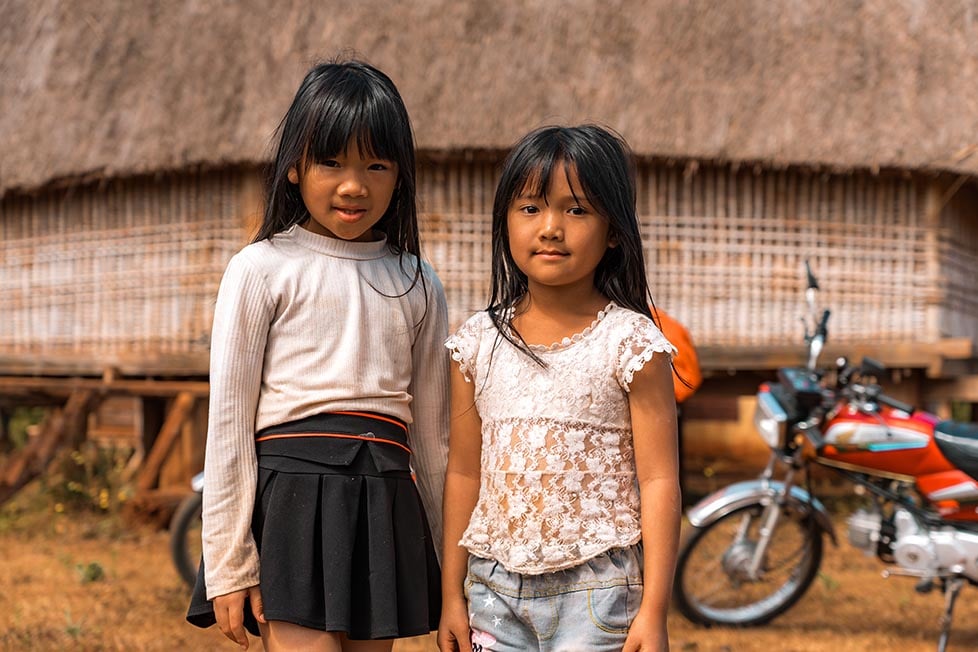
You don’t want to start a friendship with a Vietnamese person with too much banter; you still have to respect that people do not want to lose face. But once you’re out of a formal situation – and after some rice wine has been consumed – then you can unleash the sarcasm!
I think this makes sense for a country that had a brutal civil war and then still has to navigate communist “niceties”.
When my Vietnamese friend and I went on a bit of a street food bonanza, we joked a lot about things that only made sense in Vietnam – like the couple wearing matching pyjamas while dining at a fancy coffee shop. Also, she found it far too funny that people would stop to take selfies with me because I had blue eyes. Obviously, she had to start calling me “Miss America” despite the fact that I am Australian…
Useful Travel Phrases for Vietnam
Below I have listed helpful travel phrases for Vietnam. It always pays to learn a new language as you travel to be able to communicate with the locals. At the very least, try!
On my first days in Vietnam, the only word I could remember was sorry – sin loi . This was lucky, as it’s something I found myself saying a lot as I tried to navigate the dense city of Ho Chi Minh.
Thankfuly, the Vietnamese people are some of the most gracious and good-humoured people on the planet. Nobody cared that I was in the way, although it was pretty funny to hear a little, white foreigner saying sorry over and over!
- Hello – Xin Chao
- Goodbye – Tam biet
- Thank You – Cám on Ban
- No Problem – Khong Van De Gi
- I like to Eat – Toi Muon An
- What is this? – cái si te nài?
- I am Sorry – Toi Sin Loi
- No plastic bag – Không có túi nh?a
- No straw please – Không có r?m, xin vui lòng
- No plastic cutlery please – Không có dao nh?a xin vui lòng
- I’m Hungry – Tôi Doi
- What is your name? – Tên cua ban là si
- I don’t understand – Toi khong hieu
What to Eat in Vietnam
Vietnamese food is popular all around the world! I would be gobsmacked if you have yet to try rice paper rolls or noodle soup.
The Vietnamese know how to cook something mouthwatering out of thin air. As well as tasting absolutely wonderful, Vietnamese food is one of the healthiest foods in the world. Prepared with fresh ingredients, vegetables, herbs, and either rice or noodles, each dish is different but delicious!
And I will begrudgingly pay the French a complimen: they know how to cook some damn fine food. So, if you can imagine salivating snacks a la Vietnam with just a hint of French influence left over from the colonial days.
Yes, the food is the best reason to backpack Vietnam!
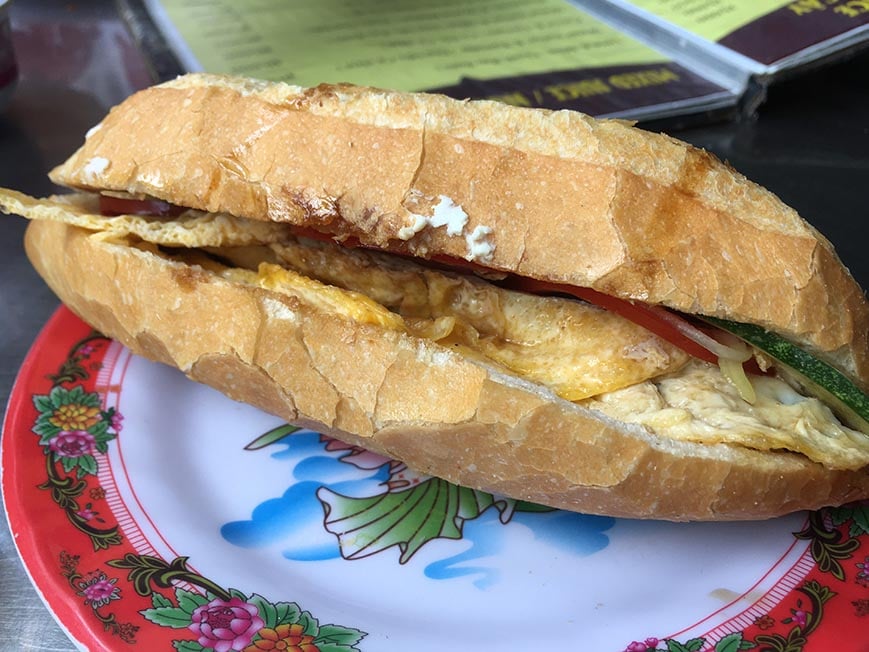
I remember sitting in a sliver of an alleyway deep within the bowels of the old imperial capital of Hue. I was sweating my sweet tushy off and thought the best way to combat sweat is with sweat, so I proceeded to order the most memorable meal I had in Southeast Asia. Bun Bo Hue .
I don’t believe in God, and neither do most Vietnamese people, but how do you explain such divine flavours?
While in Vietnam, I would suggest eating out at every opportunity. It’s cheap and delicious. You’ll understand, first hand, why McDonalds has never caught on in Vietnam.
Popular Vietnamese Dishes
- Buncha – One of my favourites! This is basically a Pork Meatball Noodle Salad. Yum!
- Goi Cuon – The famous Vietnamese “Summer Rolls” are a perfect light bite. Normally filled with shrimp and/or pork, herbs and vegetables. They are wrapped in rice paper and served with Peanut dipping sauce.
- Pho – Basically noodle soup. There are many varieties of Pho, perfect for those slightly unsure about Vietnamese food.
- Banh Mi Thit – Or in other words, the best sandwich in Asia! Basically, a well-sized baguette stuffed with yummy treats such as ham, cheese, fish, vegetables etc.
Brief History of Vietnam
People have been living in Vietnam for thousands of years. It was one of the first places in the world where rice was cultivated! There were several dynasties that ruled over a unified Vietnam – although alongside this dynasty were many other indigenous groups who never fully assimilated into any dynasty.
The Chinese often invaded and were periodically rulers of Vietnam. The Mongols did invade as well but were driven back. When the French showed up in the 19th century though, a unified Vietnam was not willing to be a colony of yet another foreign power.
When France was losing in WWII, Japan took advantage and occupied French Indo-China. The Vietnamese Communists or Viet Minh fought the Japanese and by 1945 they controlled parts of North Vietnam. Viet Minh took control of most of Vietnam and declared Vietnam independent by 1945, but France ignored this. With no intention to give up power, fighting broke out between them and the Viet Minh.
After a siege lasting 57 days, the French were forced to surrender.
In North Vietnam, Ho Chi Minh introduced a Communist regime while in the south Ngo Dinh Diem became ruler. Gradually, the USA became involved in the Vietnam War during the Cold War. First, they were sending military advisers to South Vietnam. Financially, they supported the French and later the South Vietnamese government.
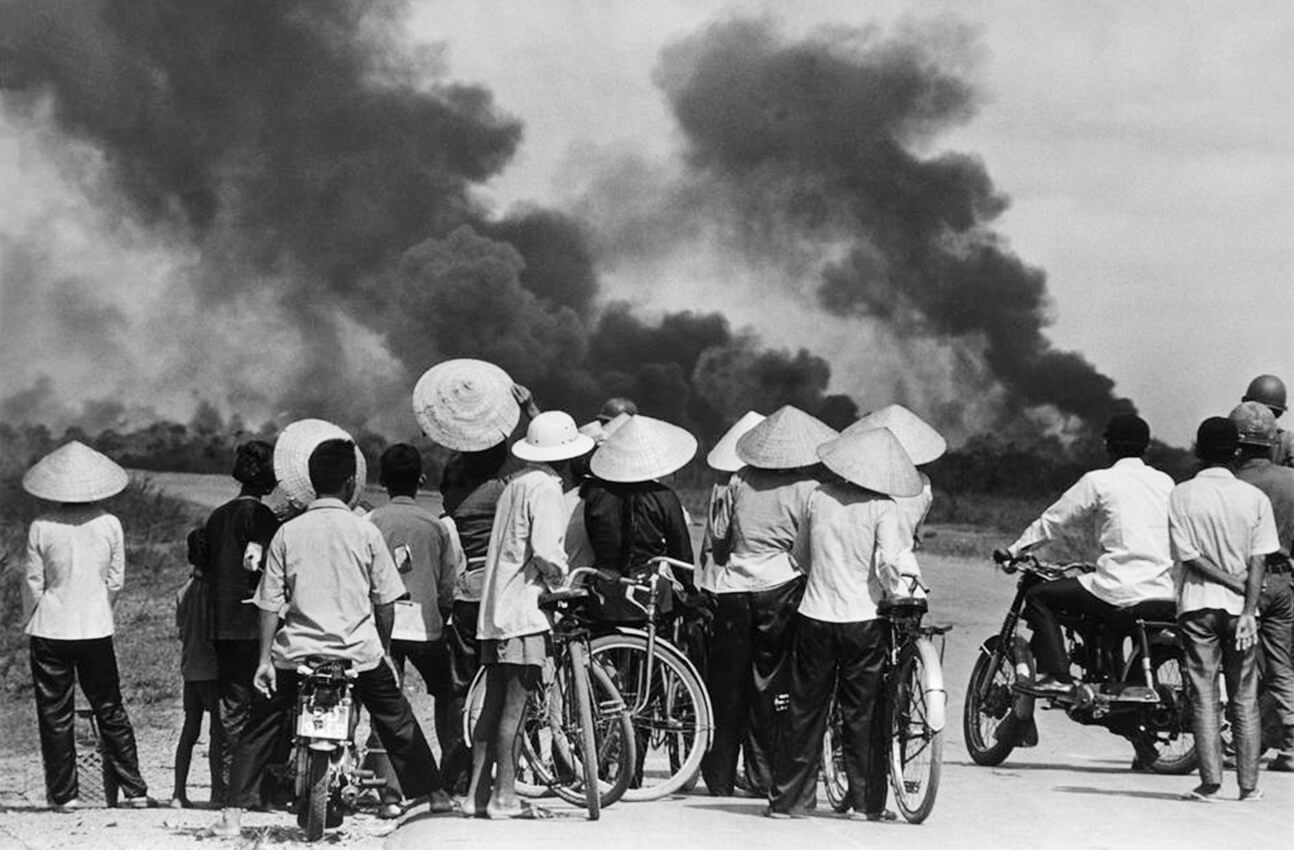
Then in 1964 two US ships were supposedly subject to ‘unprovoked’ attacks by the North Vietnamese. The Americans then bombed the north and Congress passed the Tonkin Gulf Resolution allowing the president to take ‘all necessary measures’ to prevent ‘further aggression’.
As a result by December 1965, there were 183,000 US soldiers in Vietnam and by the end of 1967, there were nearly half a million. However, the Vietcong continued their guerrilla war.
Americans withdrew from Vietnam in 1973, but the South Vietnamese continued to fight the Vietcong alone until 1975 until the North Vietnamese captured Saigon. Vietnam was reunited under Communist rule.
Every first time backpacker to Vietnam has a few questions that they are dying to know! Luckily, we’ve got you covered…
Is Vietnam safe for backpacking?
Yes, Vietnam is SUPER safe for backpackers. Petty theft is a fairly small risk and violent crime against tourists is very low. However, the roads can be quite dangerous – especially if you aren’t used to driving in heavy, chaotic traffic.
Where should I go backpacking in Vietnam?
There is a fairly defined tourist trail along the Ho Chi Minh highway that winds its way from north to south. This is not to say that it’s not worth checking out! The cities of Hanoi and Ho Chi Minh are along this route, as are the old capital of Hue and the city of lights AKA Hoi An. Off the beaten path destinations in Vietnam include along the Laos border and the very northern border with China. You can pretty much pick anywhere in Vietnam and be sure that it will be a good time!
What is considered rude in Vietnam?
Both men and women should dress conservatively when visiting Vietnam and be extra respectful toward elders. Don’t beckon with your palm facing up (as this is how you would beckon a dog) and generally keep a respectful tone. Obviously, tourists do have a little leeway but it pays to be respectful as a guest of this country.
Is Vietnam expensive?
Noo. Noooooooo, nope. Not in the slightest. I mean, you could spend hundreds of dollars per day living like a royal, but why would you bother? For 10 dollars a day you can have a good hostel bed, eat out at every meal, and even enjoy a cold beer at the end of it.
What is the highlight of backpacking in Vietnam?
For me, the highlight was seeing the modern world meet the old world. In many ways Vietnam is as advanced as cities in the west – the wifi is better than in Australia, for example. There are high rises, public transport, and hipster cafes. And then there is still the Vietnam of rice paddies, buffalo carts, and wet markets. It’s such a juicy, fascinating mix of cultures that simply never gets boring!

Our GREATEST Travel Secrets…
Pop your email here & get the original Broke Backpacker Bible for FREE.
Be good to Vietnam.
Writing your name in black marker on temples, chugging beer in Saigon while shirtless, swearing loudly, and visiting unethical animal attractions? You, Sir, are a twat. Luckily, most backpackers don’t fall into this category but, when you’re out and about and have had a few too many drinks, it can be easy to embarrass yourself.
By no means am I telling you not to drink, smoke, or party. Do it and enjoy it. Just don’t get so drunk you turn into an imbecile your mum would be ashamed of .
Go to Vietnam and have the time of your life, but be respectful along the way. There are mountains to hike, cities to explore, and some delicious bun bo hue to try along the way. You are sure to experience a very special slice of the world when you travel to Vietnam.
When we travel, we make choices that not only impact ourselves but the local communities around us and the travellers that come after us. When we are privileged enough to experience a country like Vietnam, it’s up to us to make sure it stays special for those that come after us.
Vietnam has had it rough over the years. Just be good to it, is all.
Now all that’s left is for you to book your ticket and get trying that banh mi!
- Best festivals in Vietnam
- Best backpack for travel
- Hanoi VS Ho Chi Minh
- Best hostels in the world!
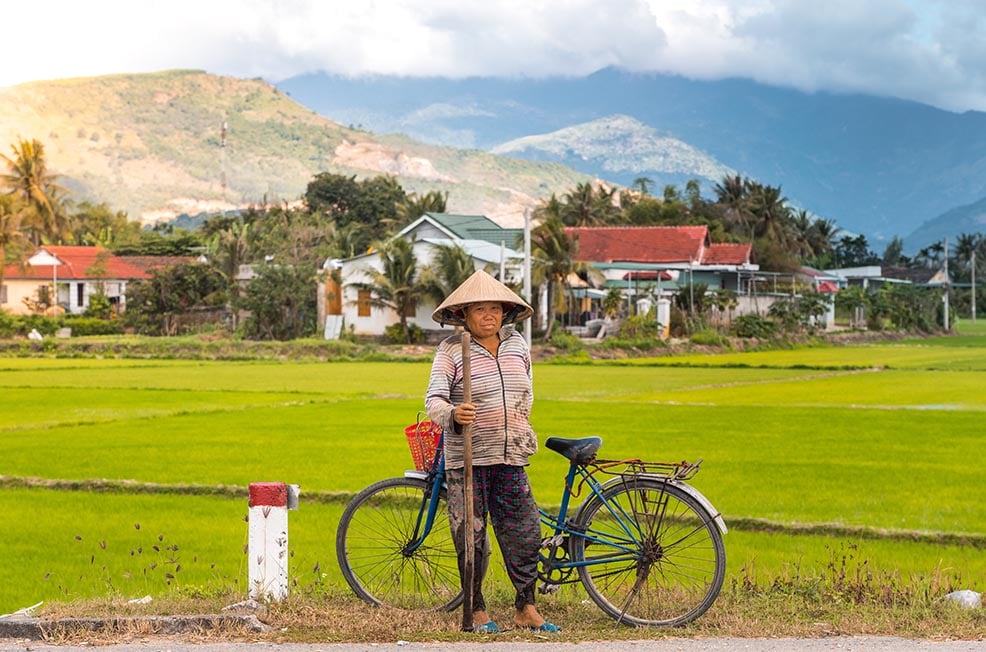
Updated November 2021 by Indigo Atkinson .

And for transparency’s sake, please know that some of the links in our content are affiliate links . That means that if you book your accommodation, buy your gear, or sort your insurance through our link, we earn a small commission (at no extra cost to you). That said, we only link to the gear we trust and never recommend services we don’t believe are up to scratch. Again, thank you!
Will Hatton
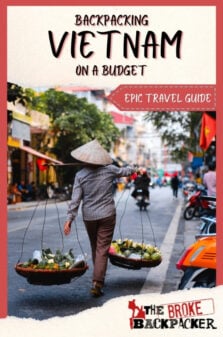
Share or save this post

60 Comments
Thanks for all the info, really loved it 🙂 I am travelling alone around Asia during 3-4 weeks. I am trying to decide between Vietnam or Indonesia. I am looking for nature a bit of beach and a destinations where its easy to meet people (but not too touristic). From your posts both seem great options! Any recommendation?
Hi Paula, I would suggest Northern Vietnam, Thailand and maybe one other destination. Indonesia is certainly an amazing country but you would be able to experience a number of different countries on one trip is you choose the first route.
I worked in Hanoi for a short time in 1996, and thought it was an amazing country. Have always meant to go back, but it is now 2020 and that hasn’t happened yet. Would love to see the rest of the country and backpacking might be the way to do. The guide is much appreciated! Many thanks 🙂
What a nice post. Vietnam is definately a must visit place in South-East Asia. We have everything from beautiful landscape, friendly people, amazing nature and delicious food,… Thank you very much for visiting our country and sharing your experiences to travel community. I love to read your amazing blog. Wish you all the best and keep doing a good job!
Hi! I was wondering if any vaccinations/medicines are necessary or recommended to enter Vietnam and its surrounding countries. I’ve heard advice to get Malaria pills but wasn’t sure if it’s absolutely necessary. Thank you in advance!
We recommend Hep A, Typhoid, and Tetanus vaccinations. Malaria pills are always good to have on hand in tropical areas. The CDC is a good resource for specific information by region. Happy adventuring!
Thank you so so much! This was put together so very well ! And it sounds like a practical and realistic itinerary for people on a budget ! Thank you so much 🙂
Thanks for dropping by! Hope your time in Vietnam is a good one 🙂
The best time to visit Vietnam: – The North: From November to March is great if you like cold air, very typical surroundings, but the weather may be rainy, and the remaining months are quite good weather – Central region: From April to November, sunny weather is very good, the rest is even rainy and cold. – Southern: All months
During my own trip to Vietnam last year I used this page as a reference. I ended up using Vietjet airways (not listed on this page) and had no problem finding a cheap flight. The central downtown Backpackers Hostel was spot on, and made for a great launching point into the rest of the country. My only additional recommendation in Hanoi is touring the Ho Chi Mihn museum, the glowing dead body of the fearless leader is crazy to see.
-be sure to cover all visible tattoos while visiting religious sites, as well as cover shoulders and legs to the knees -do not give money to children on the street, many are forced to beg and the more money given by tourist encourage them to not attend school
Hoi An, Danang will be great if you go there, sure you will have a great time. i love hoi an
Hey Will, I understand that you recommend traveling by motorbike. I’m planning on traveling to Vietnam for about 4 weeks “alone” (I’m hoping I’ll meet someone one the way) next year. Honestly, to me it sounds a bit scary to motorbike everywhere. I have never done it and afraid I won’t manage it. So my question is, do you think I would get a lesser experience by not renting a motorbike? Thanks
Having a motorbike in Vietnam is hands-down the best way to experience the country. It is not only one of the cheapest ways to get around but also gives you the most freedom. I’ve found some pretty amazing places in Vietnam that were only accessible by bike.
BUT you must be experienced with a bike before traveling to Vietnam. The roads can be super intimidating, thanks to all of the crazy drivers and speeding trucks, and being sheepish at all could result in disaster. I highly recommend that you practice on a bike before heading for the country – specifically, a semi-auto – and to know what you’re doing.
Hope that helps.
Best time to visit Northern Vietnam (Ha Noi, Ninh Binh, Phong Nha, Hue, Hoi An, Nha Trang) is from Mar to Sep. It’s sunny and hot season. So boring if you visit these places in winter, rain all day, sometimes have storm >_<
Southern Vietnam like Hochiminh, Mekongdelta, Phuquoc island …, you can visit anytime. It's warm, hot, sometimes rain 1h or 2h. From here, it's easy to go to Laos, Cambodia and Thailand by flight or bus or boat.
Thanks for your suggestions. We have finally made a plan of 15 days. Saigon(2n)- Mui Ne (half day) – Da Lat(2n)-Hoi An(2n)-Danag(1n)- Hue(half day) -Phong Nha(2n)- Ninh Binh(1day) – Halong Bay(1 and half day) – Hanoi (2n). We have eliminated Sapa trek because we have just completed himalayan range trek. Though it’ll be a speedy one but no way out. Wish to have a good time.
Wow, what a wonderful write up for someone who is planning to head for Vietnam for the 1st time. Would you please tell me if 12 days are enough to cover all of them? another thing is how much does is cost for Ha Long Bay cruise?
Waiting for your reply.
It’s not possible to do this whole itinerary in 12 days and I don’t recommend trying – it’ll be too rushed. For Halong Bay, there are many different packages and it partly depends on your haggling abilities but bank on somewhere between $100 – $200.
When you take a break and go to a new place, where everything is simply amazing and great to look at, then Vietnam is the place for you. I got Hanoi transfer service from Hanoi Travel Bus. It helps you from the airport to your lodging.
I have been to Vietnam so many times and I absolutely love it!
Just wanted to say thanks for taking the time to write this. I have traveled Asia plenty of times before and I am just researching an upcoming trip to Laos, Cambodia and Vietnam. The information you have provided here is so detailed and by far the most useful I have found. I’m pretty ‘laissez faire’ when it comes to travelling but in the past a lack of planning has seen me in a sticky situation. This makes me feel just prepared enough to arrive without a plan. Thanks and keep it up!
Thanks for your kind words, I’m glad you enjoyed the blog! 🙂
Hi everyone,
I just accidentally visit this blog, I’m a Vietnamese. I have some tricks to travel VietNam with cheapest price. I’ve just travelled across VietNam with 5,000,000 VND ~~ 250 USD with my motorbike. (around 4800km ~2900 miles in 9 days) Here is my tips: + Live in small hotel (hostel, in VietNamese => “Nhà Ngh?”) -> it cost from 5$ ->10$ per night 🙂 + There’s almost beautiful places in Northwest of VietNam, it called “Tay Bac”, it includes some provinces: – Ha Giang (you should visit Ma Pi Leng pass – small himalaya mountain range :)) – Lao Cai (SaPa is good) – Lai Chau(O Quy Ho pass (~40km)) – Dien Bien (many historical places) There also many places that I can’t list here.
If you interest in travel or something you can ask. Please contact [email protected] It’s my hobby, not work, so there no charge or fee. 🙂
Thanks for read my comments 🙂 Tan Pham
Have been struggling over multiple travel blogs to know more about Vietnam. This article has literally answered all my questions . Thanks Will, this is really great . We are a group of 4-5 girls, heading for Vietnam in December , just a quick question, how’s the safety for female travelers there ? Thanks again! 🙂
Have an awesome time – safety in Vietnam for ladies is really pretty good if you follow normal precautions of not being alone at night in the street etc.
Awesome blog WILL!!! This is informative & especially relevant for a traveler on budget. Thank you so much.
Thank you for a very detailed information. This blog is really suitable for one who wants to go and visit Vietnam. Hope that you will provide us the more interesting articles about this beautiful country. looking forward reading your others blog <3
Hey Will, thanks a lot for this beautiful blog. I’m heading to Vietnam next month and cant ask for more now. Great job, will surely leave a review when I get back. Thanks again!
Love how detailed your article is! I even share this to my friend who’s going to backpack here in Vietnam for a month and he also found your article very informative.
Brilliant blog and pictures! Sapa adjustments each year as swiftly do other terrific destinations in vietnam alas! Even though it nonetheless is a super united states of america to visit! Thank you for sharing.
Hey Will! been following your travels for a while now! Awesome stuff! did you spend any time in Da Nang? I have been living here for eight months and love it here, so much more than Hanoi, HCMC and Hoi An!
I haven’t been to Da Nang, would love to go though! 🙂
O gosh how I miss Vietnam. I absolutely loved the area of Halong Bay ad Ha Giang. The people are so lovely and friendly. The food is super. I want to go back!!
Awesome piece, some really helpful stuff on there for a first time traveller like me. I had a quick question. I’m planning on travelling through Vietnam solo in May next year and I was keen to find out exactly how “planned” my trip should be. Do you reckon I should pre-book all my accommodation before I go or do you think initially arriving with an idea of where I want to go will be fine? I obviously would like to have a good balance of being able to do things spontaneously if I meet a good crew of people but also wouldn’t want to be stuck without anywhere to stay! Thanks for the help
Play it by ear amigo!
The trip is really fun if you choose to have a great trip to experience all the best things that the tour has done, the difficult roads need patience and beautiful roads. will be recorded for your journey.
Hi Will Hatton thanks a lot for posting this interesting blog and also a worth read.People who are plannnig to visit vietnam should definitely go through this blog.
Thanks so much for this Will! My girlfriend and I are planning a budget trip to Vietnam and this guide is super helpful! You also shared so many destinations that I haven’t come across yet or found recommended so I definitely have a lot to consider with our upcoming trip.
Quick question for you – is it just as easy to get around using the train as the bus? Similar to how it is in Europe? or would you recommend using the bus for smaller destinations and the train to get between bigger cities?
Thanks Will!
Hey Stefan! It’s real easy to get around Vietnam using hop on hop off buses but I strongly recommend exploring by motorbike, that’s the best way to see the country! 🙂
Pour découvrir tout le Vietnam, je pense que cela prendra un mois. Et pour ce faire, mon budget doit être abondant
Hello! My understanding is that you cannot ride a motorbike in Vietnam without a proper license? My insurance won’t cover me without a motorcycles license. You mentioned you had no prior riding experience before going there. How did you get around that?
Hey man, I’m not sure if the situation has changed but as far as I know it’s very unusual to get into any problems with the police – a small bribe will get you out of most traffic situations. Your insurance wont’ cover you to drive a bike but if you did get into an accident…. *cough* perhaps you could say you were on the back *cough*
Recently completed our month long trip from Ho Chi Min to Hanoi & then beack to Thailand for another month. We based our trip on this article as we knew nothing of Vietnam. Found it usefull & informative.
Pretty impressive article! Thanks for sharing?
,great blog. worth a read.I am currently planning my Vietnam- Cambodia backpacking and this will definitely help me a lot but I think I’m going to skip some places though.
Very Informative article, Thanks for sharing!
Thank you! Hopefully I can get there soon!
– Jessica | http://brokegirlsdiary.com/
Loved your article.! Im planing my trip according this.! Also should i drop some of the stuff given above being a solo women traveler.?
…ps, your guide refers to around 20 different places to visit from North to South. Have you done this route & what would your estimated time frame be to travel this at a moderate, relaxed pace? How much time do you think we realistically need?
Great article Will. We “Will” be using this as a basis for planning our backpacking trip through Vietnam, possibly in June or July. The trip will be anything from 6-8 weeks. We will be slackpacking as we are 49 & 50 years young. Don’t mind camping as we rough it often in South Africa on 4×4 trails & bike rallies. We don’t, however do hostels or share bathrooms. Not sure how much that will influence the daily spend, although in Thailand we found that we spent more on accommodation yet less on getting scammed and wasting money like we saw lots of the young backpackers do, so maybe this will balance figures. Will, do you have any tips you may think are relevant to us “Midlifebackpackers”? Cheers
I’m Vietnamese and working in tourism but I learn more from your post. Great blog Will Hatton.
Great blog and pictures!
Sapa changes every year as rapidly do other great destinations in Vietnam unfortunately! Though it still is a great country to visit!
Tom and I met in Vietnam so it is quite dear to us! He rode a motorbike throughout Vietnam and had the time of his life! I went on buses but joined him along some of the stops. We will be posting a photo diary of his motorbike adventure on our blog soon. Great article, Will!
I would love to see the photo-diary!! keep in touch 🙂
In my opinion, no, not really. Hanoi is WAY nicer. Saigon has a good party vibe but it’s still not there best place in Vietnam to party so if I was planning a trip it would be the first place on my list I would scratch out if I was low on time.. 🙂
I loved backpacking in Vietnam, and visited everywhere that’s on your list. Sapa was the only place that, unfortunately, I really wasn’t keen on..
I think Sapa has changed a lot from what I have heard… I havn’t been for over three years now, I’d love to head back to Myanmar but I’m just preparing to head off on a whirlwind adventure around Central and South America! 🙂
Woah, also, I think that ostrich riding is not an activity that should be recommended. I saw the signs for it when I was in Mui Ne… Made me feel quite sad.
I’m currently in Central America, though will be travelling north I think. Unfortunately I don’t really have the funds to go south yet – as I want to do a massive long journey around South American in one go sometime in the future.
Hmmm, I don’t know enough about ostrich riding, other than that it is quite popular in South Africa, to say whether or not it should or should not be recommended. It was an interesting experience for sure and the ostriches seemed well looked after in a professionally run center.
Hi again Will – I would definitely recommend reading this post: http://right-tourism.com/2014/09/ride-ostrich/#sthash.frdGIE5P.KSwVRI2K.dpbs
Hi Charlie,
An interesting read for sure but it doesn’t really provide any evidence that there is a problem with riding ostriches, it uses phrases like ‘may’ and ‘maybe’ – although I think it’s important to be an ethical traveler, one has to try and get the balance right – after all, the most ethical thing for the planet would be to not travel at all! Riding an ostrich was a unique experience which I enjoyed, I’m not sure I would repeat it (I havn’t yet had a chance), and I saw no risk of harm to the ostriches themselves. When I can see a risk to an animal I will never increase that risk – for example, I would never dream of riding horses or donkeys abroad as they are usually treated badly.
Leave a Reply Cancel reply
Your email address will not be published. Required fields are marked *
Save my name, email, and website in this browser for the next time I comment.
Notify me of followup comments via e-mail.
TRAVEL ADVISORY : See updates, precautionary measures and new policies on the novel coronavirus in Vietnam here.

- Vivu Journeys
- About Victoria Voyages
Our Partners
- Booking Terms And Conditions
- How To Book
ULTIMATE VOYAGES TO EXPERIENCE THE BEAUTY AND AUTHENTICITY OF VIETNAM
We arrange trips throughout Vietnam with our very own network of travel providers. Whether you are looking for a classic highlight of the hustle and bustle Vietnam, a leisure journey throughout this country, or a unique experience of local culture and history, these itineraries will give you some suggestions to discover what Vietnam has to offer.
ULTIMATE VIETNAM EXPERIENCE
14 Days - 13 Nights From $ 2,599
Visit Vietnam’s most popular destinations on a wonderfully comprehensive two-week itinerary that includes Hanoi, Sapa and Halong Bay in the north, ancient Hoi An, and vibrant Saigon and the Mekong Delta.
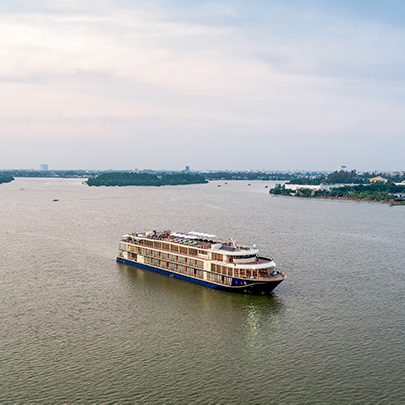
UPSTREAM JOURNEY WITH VICTORIA MEKONG CRUISE
3 Days - 2 Nights From VND 10,990,000
Designed for Vietnamese locals & expats, this luxurious all-inclusive cruise takes you through the hidden gems of the Mekong Delta in utmost comfort.
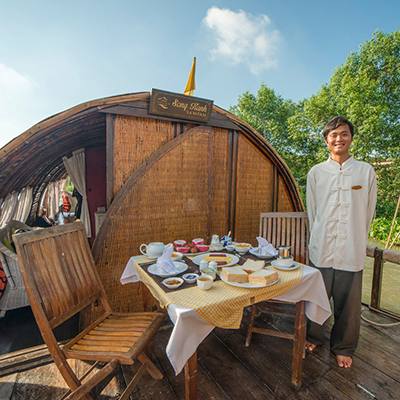
MEKONG CROSSROADS SAMPAN CRUISE
3 Days - 2 Nights From VND 6,900,000
Embark on a river cruise aboard the private Song Xanh sampan, witnessing life as it is lived on and by the river.
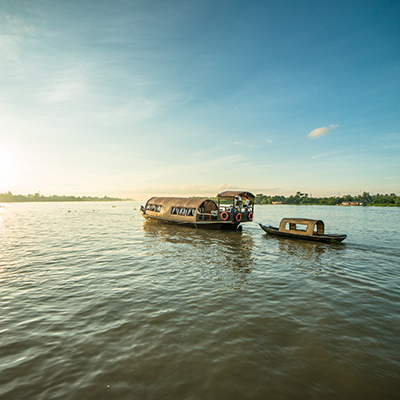
NIGHT ON THE MEKONG RIVER WITH SAMPAN CRUISE
2 Days - 1 Night From VND 4,900,000
Spend the night on the river with our sampan cruise in complete privacy & explore the best of river life.

NORTHERN & CENTRAL VIETNAM EXPLORATION
7 Days - 6 Nights From $769
Ready for an action-packed adventure in Northern and Central Vietnam? Explore Hanoi, Halong Bay, Hoi An and more.

ELITE VIETNAM
10 Days - 9 Nights From $1759
Explore the length of Vietnam, hitting two UNESCO-listed World Heritage Sites as well as historic Hanoi and bustling Ho Chi Minh City.
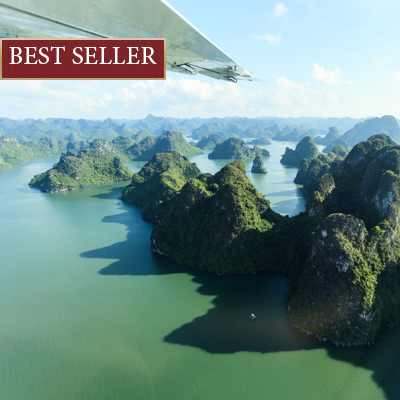
ULTIMATE NORTHERN VIETNAM EXPERIENCE
5 Days - 4 Nights From $599
Explore the highlights of Northern Vietnam by land, sea and air, visiting magical Halong Bay and the cool highlands of Sapa.

BEST OF VIETNAM
12 Days - 11 Nights From$2,299
Travel through all three of Vietnam’s regions to witness the past, present, and future of the country, with an idyllic beach retreat built in.

A TASTE OF VIETNAM
12 Days - 11 Nights From $1,599
Travel the length of Vietnam on a culinary journey through all three regions, sampling and learning how to cook the best of Vietnamese food.

ULTIMATE MEKONG DELTA
4 Days - 3 Nights From $599
Traverse the Mekong Delta from Saigon to Chau Doc (gateway to Cambodia), visiting a floating market, ethnic Khmer village, enchanted submerged forest and more.

ULTIMATE SOUTHERN VIETNAM
6 Days - 5 Nights From $859
Experience this lovely contrast of city and country on a journey through beautiful southern Vietnam.

A TASTE OF THE MEKONG DELTA
4 Days - 3 Nights From $425
Experience the highlights of the Mekong Delta, including Can Tho’s bustling floating market, the picturesque town of Sa Dec, and an overnight cruise for intimate views of life along the river.
START PLANNING YOUR VIETNAM TRIP TODAY:
WHY CHOOSE VICTORIA VOYAGES
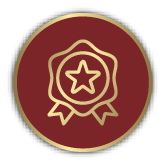
In- House Travel Providers
Our Partners come from within TMG's 4-star portfolio, many of whom boast 20+ years of award-winning experience.
Our Partners offer truly unique travel experiences
Our Partners enable us to deliver consistently high-quality service to clients.

Unmatched Savings
We use our own providers with no middleman, delivering maximum value for money to guests.
Our guests also enjoy extra perks: 15% off on all in-house services & free room upgrades (upon availability at check-in).

Expert Knowledge
Your expert travel consultant will look after you from beginning to end.
We craft your journey from our region-specific experience & extensive local knowledge.
You'll travel with English-speaking guides who are local experts themselves.
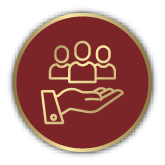
It's All About You
Our journeys are customisable with Tour Extensions (optional extra experiences).
All our tours are private or small group.
We're always here to support you during your travels.
READ OUR VIETNAM TRAVEL GUIDES:
Seizing TMG raining offers for only this SUMMER HIGH campaign RIGHT NOW
Discover the amazing vietnamese cities of hanoi, hue, and saigon, visiting the beautiful beaches of vietnam.

Victoria Voyages - Sales & Reservation
Level 3, 46 Nguyen Truong To street, Ha Noi, Vietnam
Tel: +84 243 926 3148 - ext. 315
Fax: +84 243 926 3148
Email: [email protected]
* Operated by Ivivu.com Joint Stock Company, Hanoi Branch
Our Journeys
Ultimate Vietnam Experience
Elite Vietnam
Ultimate Northern Vietnam
Ultimate Mekong Delta
Essential Information
How to book
Booking terms and conditions
Privacy Policy
- US$ US DOLLAR
- £ POUND STERLING
- C$ CANADIAN DOLLAR
- A$ AUSTRALIAN DOLLAR
- Signature Experiences

5.00 from 412 reviews
BESPOKE Vietnam TOUR. DONE RIGHT!
Luxury Vietnam Guided Tour Packages
Section Title
We have designed a range of tours to Vietnam to elevate your travel experience. You will see the exotic and rich culture of Vietnam that only a few countries have and the UNESCO Heritage Sites that it boasts many. You will follow the buffalo paths to find hill tribe villages in the mountains after exploring cities steeped in history. No dream is too small or too big; our knowledgeable experts know how to make it happen.

Meet Our Vietnam Expert
TRAVEL WITH EXOTIC VOYAGES
Create an itinerary that matches your interests. Put everything in place (a lot of effort going into this)
Which Does This
The tour runs like clockwork including pickup, accommodation, guides, drivers, activities & transfers
Giving You This
The Vietnam trip that you always dream of. 100% Satisfaction Guanrateed
SIGNATURE EXPERIENCES
Our signature experiences allow you to discover the new land in a deeper and more special way. You’ll realize, the place you visit, not only has its own culture and history but also has its Sound, Soul, and Stories, guided by our experts. Those experiences, ranging from 2 hours and half-day to full-day, can be easily tailored to best suit your preferences. Add them to your itinerary to make your travel more meaningful.

A Pottery Village Of Ancient Thang Long

60 Minutes with A Family of Talented Artists

My Tour Guide Is A Royal Descendant
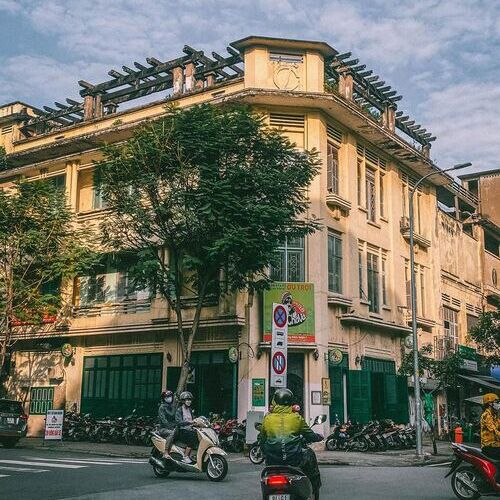
Behind The Tales of Saigon

In Search of Red-shanked Douc Langurs with A Wildlife Expert
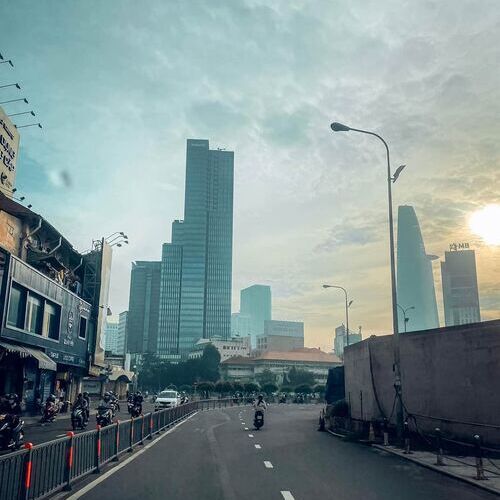
Good Morning Saigon

OUR RECOMMENDED TOUR
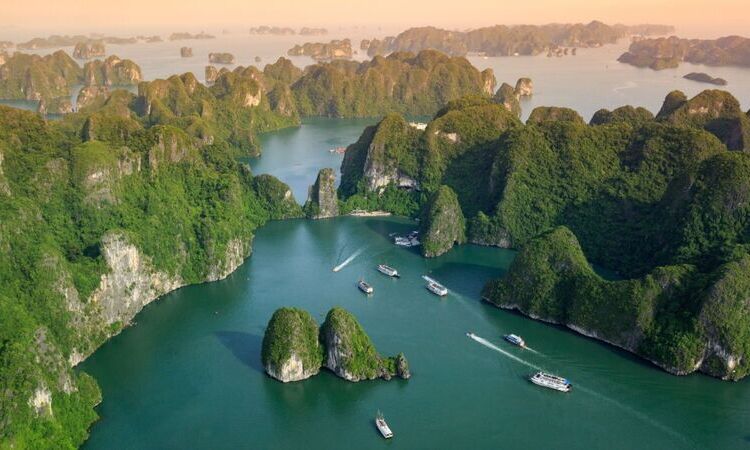
Finding Vietnam & The Lost Temples of Angkor
Explore all vietnam tours.

MEKONG RIVER TOUR AND MORE

AMAZING TASTE OF VIETNAM
VIETNAM SEA AND SAND: EXPLORE THE HIDDEN GEMS
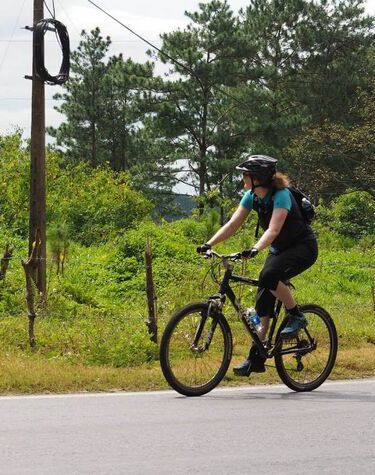
NORTHERN VIETNAM CYCLING
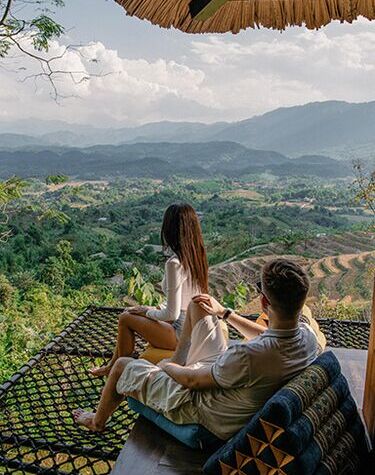
VIETNAM HONEYMOON PACKAGE: THE ONE-OF-A-KIND
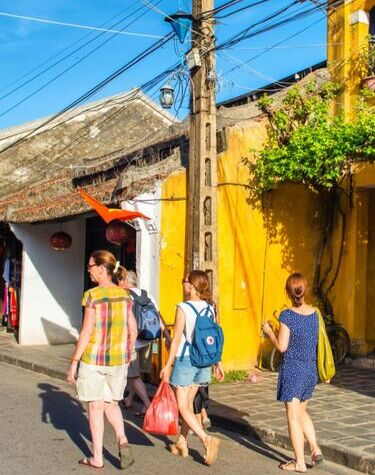
Family Fun in Vietnam

POST VIETNAM WAR - UNTOLD STORY
BEST OF VIETNAM: ART & CULTURE
Your tailor-made holiday done right., testimonials.
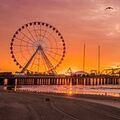
Minnesota, USA
Awesome trip to Vietnam!
Exotic Voyages is terrific to work with - they set up a fantastic trip for my friend and me. Very well organized and responsive, and the guides we had were A+. The lodging was also wonderful. Read more
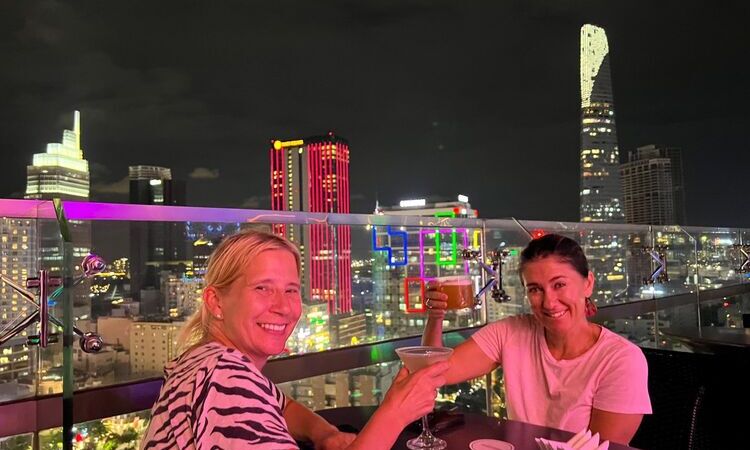
Wonderful Southern Vietnam Tour
We had a wonderful 5 Day Southern Vietnam tour. Our tour guide Vinh is simply great. He goes out of his way to ensure that we truly enjoy our trip. Food is so delicious. Hotels are great too.

Vietnam with my daughter
Beautiful trip to Vietnam with my daughter, planned by Sophiane (Huyen Trang) who was terrific!! Could t have been any better.

8 day solo vacation in Vietnam
I recently returned from from my first solo vacation. Rose took my initial thoughts on what I was interested in doing in Vietnam and ran with it. I was very nervous about traveling by myself so far ...
Manchester, New Hampshire
Hanoi, Mai Chau, Halong Bay and Da Nang
11 days tour in Vietnam with a couple of days in Hanoi, biking in Mai Chau, cruising on a night in Halong Bay and a few days relaxing in Da Nang (Nam Hai). Very well planned and organized trip, ...
Helsinki, Finland
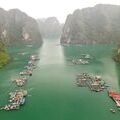
Why Choose EV?
Trusted & fully licensed international travel agency.
Our International Tour Operator & Travel License is 01-448/2011/TCDL-GPLLHQT, granted by Vietnam Tourism Administration Board.
Local Knowledge
Work with your designated travel designer to customize your trip to your exact requirements.
Unique Experiences
In our customers' words: "All of the activities Exotic Voyages recommended were great, and a handful were truly exceptional where we were the only westerners/tourists around. "
Best Travel Guide
With EV guides, you shake hand when you meet and will be giving them hugs when you leave.
Pay Direct Prices. No Overhead.
As we are running our own operation in Vietnam, you are getting the direct price from the source. Say goodbye to third-party commission or referral fee.
Customize Your Trip With A Travel Designer
All of our staff live and travel extensively throughout Vietnam and its neighboring countries, we offer you the insider knowledge.
Exceptional Travel Logistics
We are on-top of managing all logistics for your trip. Safe, on time & high quality vehicles, drivers and guides will be with you throughout.
100% Satisfaction Guaranteed
Customer satisfaction is our bloodline. If you are not satisfied with us, we will work with you to make it right!
Top things to do
Vietnamese street food is the best.
Great food makes people happy. Surely, you will have the happiest moment when traveling to Vietnam where you cannot escape from the heaven of street food: banh mi, Vietnamese pho, Vietnamese hot pots,...
Explore the ethnic minorities in the North of Vietnam
The area that surrounds Sapa unquestionably offers tranquility and beauty if that is what you're seeking. The deep valleys in the region offer some of the nation's most breathtaking rural vistas and several ethnic minorities presented in Vietnam, including the Red Dzao, Giay, and Hmong people. Also, you cannot miss out on conquering Fansipan Mountain, 'the Roof of Indochina'.
Be indulged in the natural beauty of UNESCO World Heritage
Halong Bay undoubtedly becomes one of the most unique places to visit in Vietnam. Thousands of thick limestone are layered side by side, creating a stunningly unique view while you are sailing on the well-known Halong Bay.
Roam around and explore the 1000-year-culture city
Hanoi is famous for the food, the busy streets, and the hospitable people. And of course, don’t forget to take a deeper look into the historical sites in Hanoi with the day tour around this bustling city.
Stop by the worth-living city named Da Nang
Danang - once an indigent area is transforming so quickly. Now, in this city, you can take advantage of both the romantic beaches and a variety of world-class luxury resorts in Vietnam.
Unlock the hidden charm of Hoi An
As the homeland of lanterns in all different colors and sizes, Hoi An sightseeing is not only renowned for its unique and intact architecture of temples, and pagodas but also for its tranquil rural Vietnamese sceneries. Several untouched communities that still retain their traditional beauty are waiting for you to discover.
Visit the old capital of Vietnam
Hue is known for its dreamlike scenery, which is a result of a variety of internationally renowned structures spread around its former capital, as well as its long history and culture. Taking a Hue walking tour to admire wonderful landscapes influenced by the Perfume River's beautiful curve is a must-activity that will make you fall in love with the serene vibe of the city.
Discover the 2-sided story of Dalat
Dalat can be gentle but also vigorous at the same time. Which one will you choose: enjoy a cup of coffee with a hill view or get ready for a wet and wild adventure such as white water rafting?
Try seafood in Nha Trang
Already famous for beautiful beaches and luxury resorts in Vietnam, you cannot miss Nha Trang for its wonderful variation of seafood. And guess what? It is ridiculously inexpensive.
Enjoy a sleepless night in Ho Chi Minh City
Different from the North, the lifestyle of the center of Southern Vietnam - Ho Chi Minh City is more “Western”. Take a Saigon bus tour to watch over the top attraction of the city in the morning but when the sun goes down, you are invited to crazy night parties and have so much fun.
Get closer to local life in Mekong Delta
Mekong Delta is where the famous Mekong River finds its way to the sea. It is one of the most fascinating regions for travelers to discover, which includes chaotic floating markets, authentic local life, paddy field mangroves, and wonderful vistas. It is just simply beautiful.
A true definition of the premium beach vacation
Phu Quoc is blessed with remarkable beauty, including some of Southeast Asia's most magnificent white-sand beaches, a deep blue sea, and a clear sky, as well as a tropical climate virtually the entire year. These features make the island the ideal destination for a beach vacation. Dive, snorkel, explore pristine woods on foot, stop in at charming fishing villages, or simply unwind on the private beaches of one of Phu Quoc's luxury resorts.
TRAVEL GALLERY
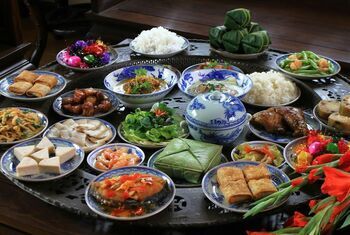
OUR FREE Vietnam GUIDE
If you want to learn it more, take a look at our Free Vietnam Ultimate Guides , you can have everything you want in hand just after a few minutes.

Follow us on instagram @EXOTICVOYAGES

You are customizing "Package's Name". Fill in the form below to get started.
Note: The reference price per person is based on the low season. The price may vary depending on your starting date
WHAT ARE YOU LOOKING FOR?
This website uses cookies.
We use cookies to personalise content and ads, to provide social media features and to analyse our traffic. We also share information about your use of our site with our social media, advertising and analytics partners who may combine it with other information that you’ve provided to them or that they’ve collected from your use of their services.
Necessary cookies help make a website usable by enabling basic functions like page navigation and access to secure areas of the website. The website cannot function properly without these cookies.
Statistic cookies help website owners to understand how visitors interact with websites by collecting and reporting information anonymously.
Preferences
Preference cookies enable a website to remember information that changes the way the website behaves or looks, like your preferred language or the region that you are in.
Marketing cookies are used to track visitors across websites. The intention is to display ads that are relevant and engaging for the individual user and thereby more valuable for publishers and third party advertisers.
Unclassified
Unclassified cookies are cookies that we are in the process of classifying, together with the providers of individual cookies.
General cookie introduction
Avis indépendant
Basé sur 2,942 avis des voyageurs
Planning a successful trip for you and making your holiday hassle-free is our simple motto.
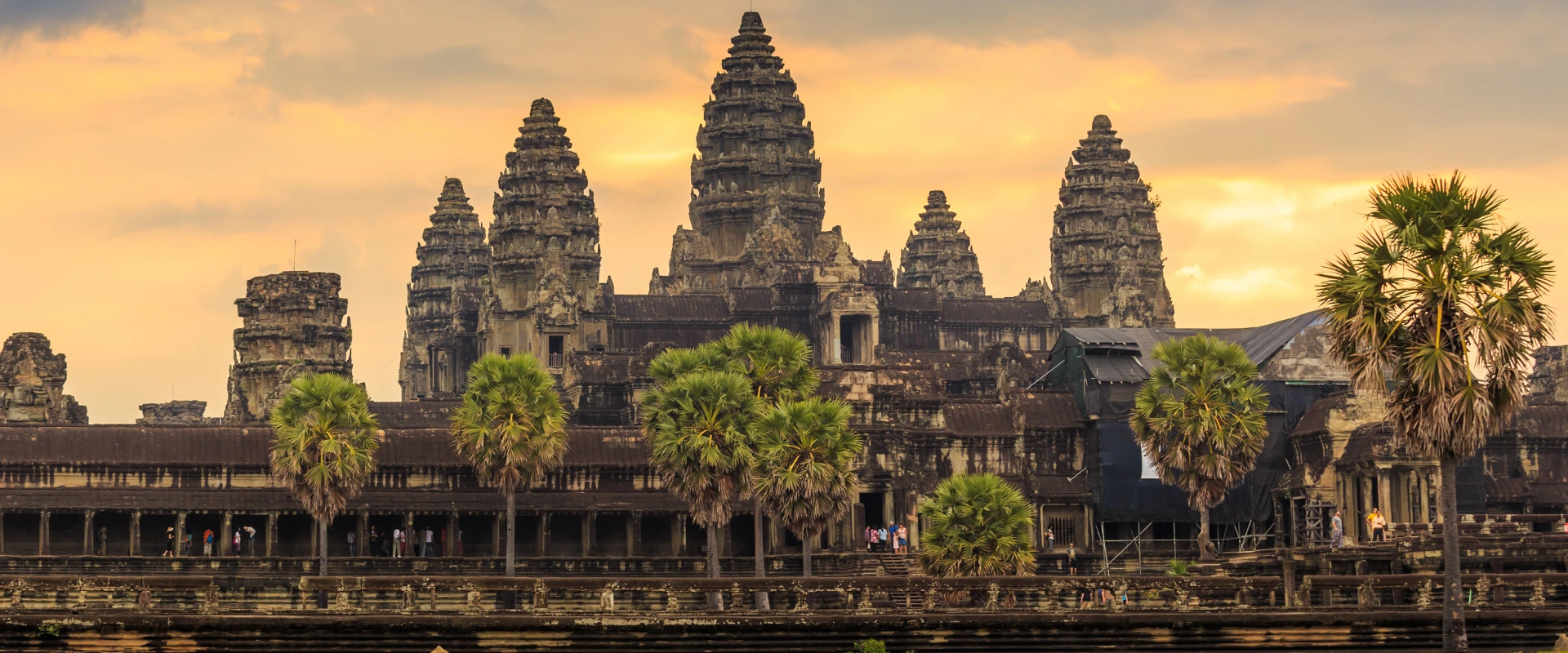
Voyage Vietnam, Spécialiste du Voyage Au Vietnam
Pourquoi voyager avec voyage vietnam.
- Plus de 30 années d’expérience
- 10 ans en ligne
- Pas de frais caché – Aucun achat forcé
- Nous acceptons toute demande de voyage personnalisée
- Remboursement garanti
de nos clients nous recommanderaient à leurs amis
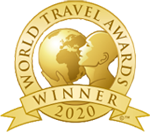
Le charme caché
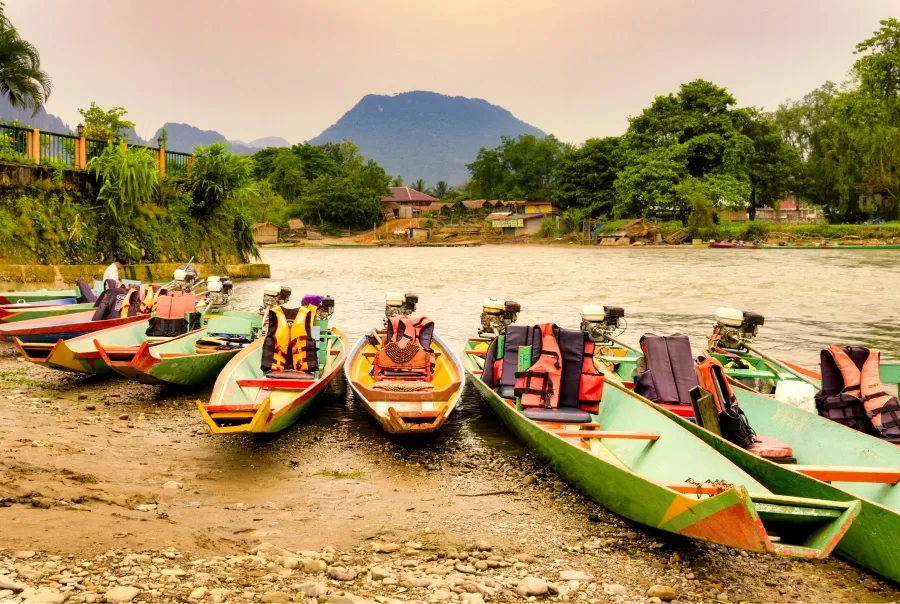
Que le voyage commence
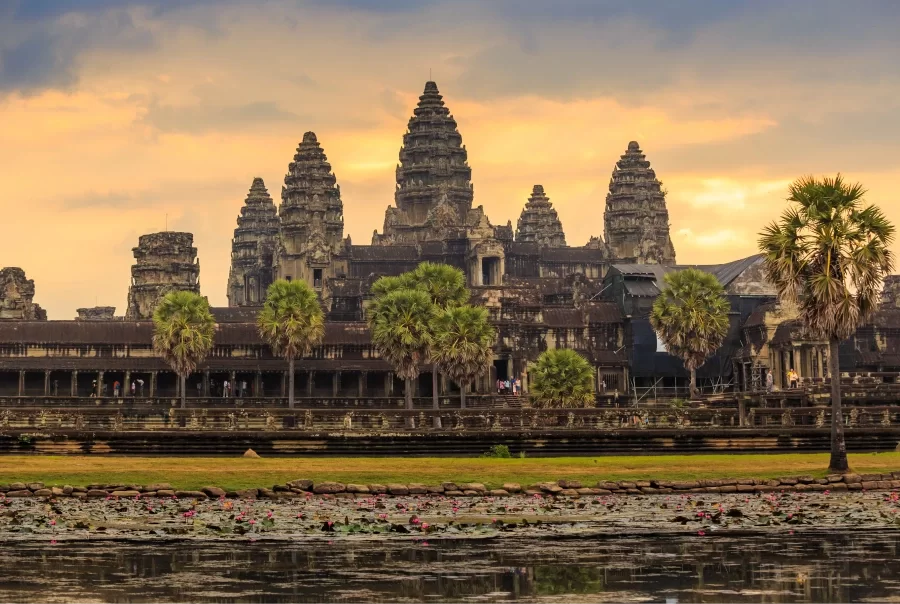
Royaume des Merveilles
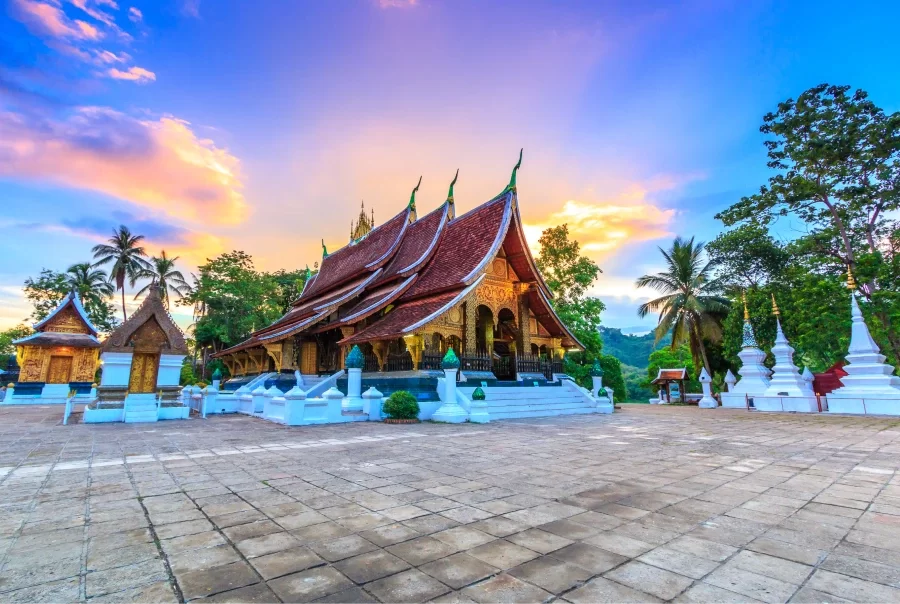
Tout simplement magnifique
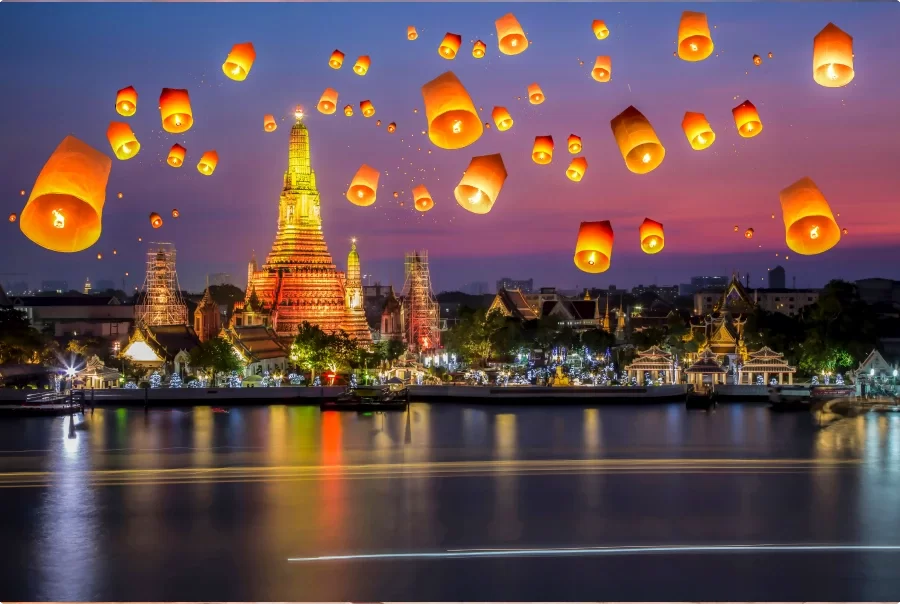
Thaïlande dépaysante
Le Vietnam, une terre de contrastes saisissants et de richesses culturelles, est une destination de choix pour les voyageurs en quête d'aventure, de culture et de détente. Cet article vise à fournir un guide complet pour planifier votre voyage au Vietnam, en abordant des aspects essentiels tels que la meilleure période pour visiter, les formalités de visa, les conseils de santé et de sécurité, les options de transport, la gastronomie, les attractions incontournables, et des conseils pratiques pour organiser son voyage avec une agence pour une expérience mémorable.
Avec ses paysages variés, allant des montagnes majestueuses du Nord aux plages idylliques du Sud, en passant par les villes dynamiques et les vestiges culturels, le Vietnam promet une aventure diversifiée. La culture vietnamienne, un mélange harmonieux d'influences indigènes, chinoises et françaises, se reflète dans son architecture, sa cuisine et ses traditions.
Le Vietnam est également reconnu pour son hospitalité chaleureuse, offrant aux visiteurs une expérience authentique et enrichissante.Ce guide vous emmènera à travers les différentes étapes de la planification de votre voyage, en vous fournissant des informations détaillées et des conseils pratiques. Que vous soyez un routard solitaire, un couple en lune de miel, ou une famille en vacances, le Vietnam a quelque chose à offrir pour chacun. Préparez-vous à être émerveillé par la beauté naturelle, la richesse culturelle et l'histoire fascinante de ce pays magnifique.
Le Vietnam s'étend sur plus de 1 000 kilomètres du nord au sud, ce qui entraîne des climats variés à travers le pays, influençant considérablement la meilleure période pour visiter. La planification de votre voyage en fonction du climat est cruciale pour profiter pleinement de votre expérience vietnamienne.
• Le nord du Vietnam (Hanoï, Baie d'Ha Long, Sapa) : le climat est tempéré avec quatre saisons distinctes. L'hiver, de décembre à février, peut être froid et brumeux, particulièrement dans les régions montagneuses comme Sapa. Le printemps (marsavril) et l'automne (octobre-novembre) sont généralement considérés comme les meilleures périodes pour visiter, avec un temps agréable et moins de pluie.
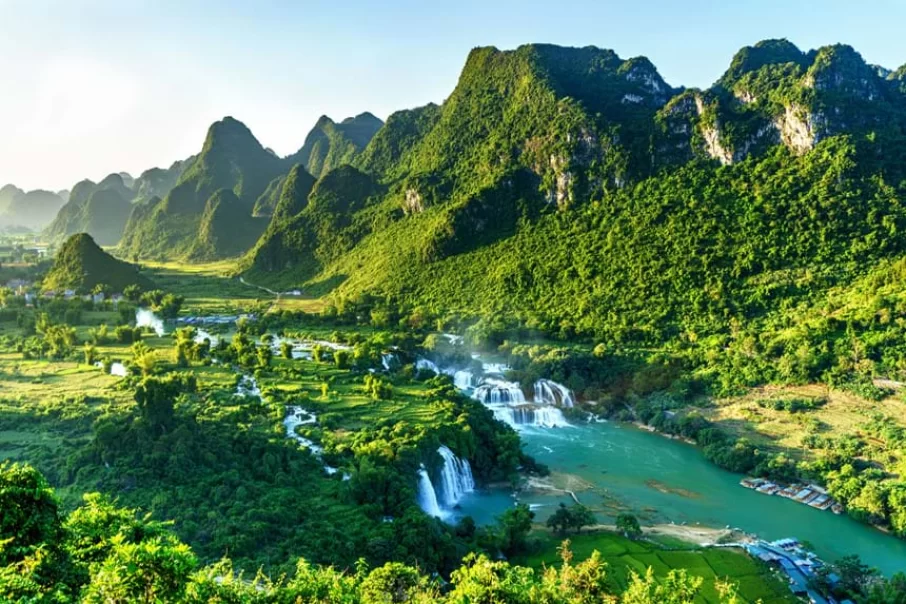
La meilleure période pour visiter le Vietnam
• Le centre du Vietnam (Hué, Da Nang, Hoi An) : cette région a un climat plus tropical. La saison sèche, de janvier à août, est idéale pour visiter, avec des températures chaudes et un faible risque de pluie. Les mois de septembre à décembre peuvent voir des pluies plus fréquentes et parfois des typhons.
• Le sud du Vietnam (Ho Chi Minh-Ville, Delta du Mékong) : caractérisé par un climat tropical avec deux saisons simples - la saison sèche (de novembre à avril) et la saison des pluies (de mai à octobre). La saison sèche est généralement préférée par les touristes, offrant un temps chaud et ensoleillé.
• Événements et festivals : envisagez de planifier votre voyage autour des festivals vietnamiens. Le Têt (Nouvel An lunaire), célébré entre fin janvier et mi-février, est le plus grand festival du pays. Cependant, de nombreux magasins et restaurants peuvent être fermés pendant cette période.
Conseil: si vous envisagez de visiter plusieurs régions, mars-avril et octobre-novembre sont des mois de transition où le climat est relativement agréable dans l'ensemble du pays. Pensez aussi à vérifier les prévisions météorologiques et les conseils de voyage avant de partir, car le climat peut varier d'une année à l'autre.
Obtenir le bon visa est une étape essentielle dans la préparation de votre voyage au Vietnam.Les exigences de visa peuvent varier en fonction de votre nationalité, de la durée et du but de votre séjour.
Les différents types de Visa
• Le Visa électronique (e-Visa) : disponible pour les citoyens de 80 pays, l'e-Visa est valable pour un séjour unique de 30 jours. La demande se fait entièrement en ligne et est généralement traitée dans les 3 jours ouvrables. • Le Visa à l’arrivée : pour ceux qui arrivent par avion, le visa à l'arrivée est une option pratique. Vous devez obtenir une lettre d'approbation en ligne avant votre départ, puis obtenir le visa à votre arrivée à l'aéroport au Vietnam. • Le Visa par l'ambassade/consulat : pour des séjours plus longs ou des types de visa spécifiques (comme les visas d'affaires), vous devrez peut-être faire une demande via une ambassade ou un consulat vietnamien.
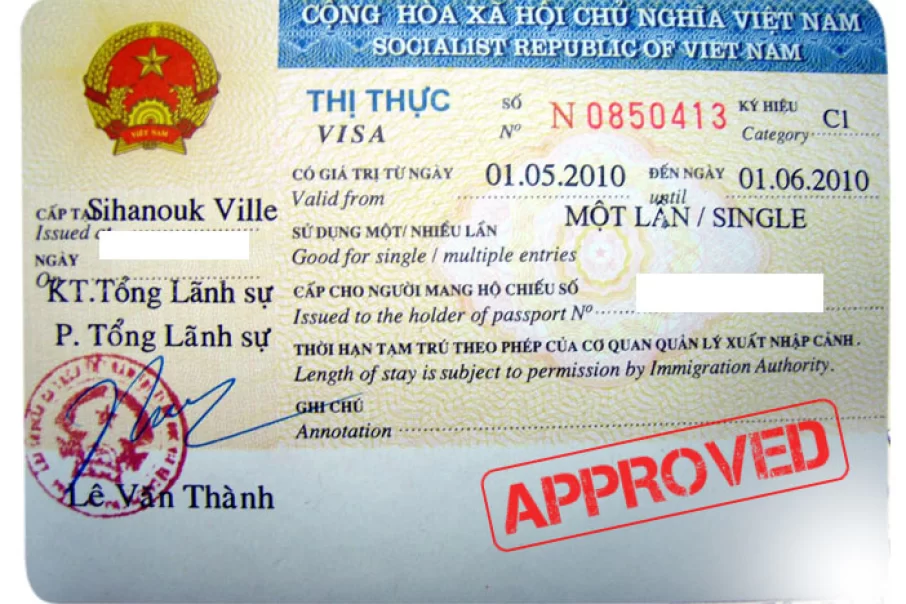
Voyage au Vietnam : les visas et formalités d'entrée
Les documents nécessaires pour voyager au Vietnam
• Passeport valide pour au moins 6 mois après votre date d'arrivée. • Formulaire de demande de visa rempli (pour e-Visa ou visa par l'ambassade). • Photo d'identité récente. • Lettre d'approbation (pour visa à l'arrivée). Conseils additionnels : • Vérifiez toujours les exigences de visa les plus récentes, car les politiques peuvent changer. • Assurez-vous d'avoir tous les documents nécessaires avant de partir pour éviter tout retard ou refus à votre arrivée. • Certains pays sont exemptés de visa pour des séjours de courte durée. Vérifiez si votre pays est sur la liste pour éviter des démarches inutiles.
Voyager au Vietnam nécessite quelques précautions en matière de santé et de sécurité pour garantir un séjour agréable et sans soucis.
Vaccinations et précautions sanitaires
• Consultez un médecin ou un centre de vaccinations internationales plusieurs semaines avant votre départ pour discuter des vaccins nécessaires ou recommandés (comme la fièvre typhoïde, l'hépatite A et B, la rage, et le DTC). • L'eau du robinet n'est pas potable au Vietnam. Buvez toujours de l'eau en bouteille et évitez les glaçons. • Soyez prudent avec la nourriture de rue. Mangez dans des endroits fréquentés et choisissez des aliments bien cuits.
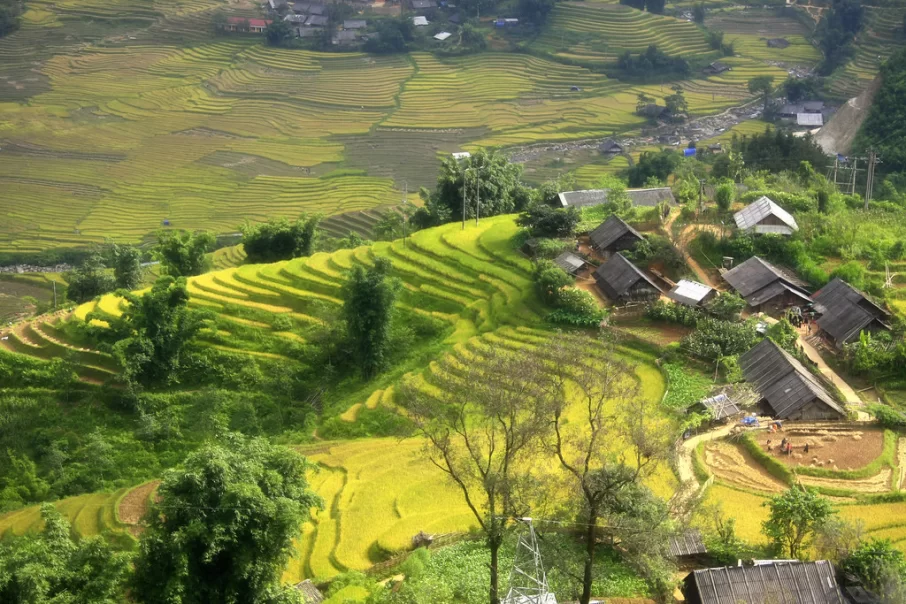
Voyager au Vietnam : la santé et la sécurité
Les assurances voyage
Souscrivez une assurance voyage couvrant les soins médicaux d'urgence et l'évacuation sanitaire. Vérifiez également la couverture pour les activités à risque si vous prévoyez des aventures comme la moto ou la randonnée.
La sécurité personnelle
Le Vietnam est globalement un pays sûr pour les touristes. Cependant, faites attention aux pickpockets et aux escroqueries, surtout dans les zones touristiques et les marchés bondés. Respectez les lois et les coutumes locales. Par exemple, il est interdit de prendre des photos de sites militaires ou de manifestations politiques. En cas d'urgence, connaissez les numéros à contacter (police, ambassade, services médicaux).
Les vols intérieurs
Pour les longues distances, les vols intérieurs sont une option rapide et pratique. Le Vietnam dispose de plusieurs compagnies aériennes locales, comme Vietnam Airlines , VietJet Air et Bamboo Airways, offrant des liaisons fréquentes entre les grandes villes et les destinations touristiques. Les vols sont généralement abordables et efficaces, surtout si vous êtes limité par le temps.
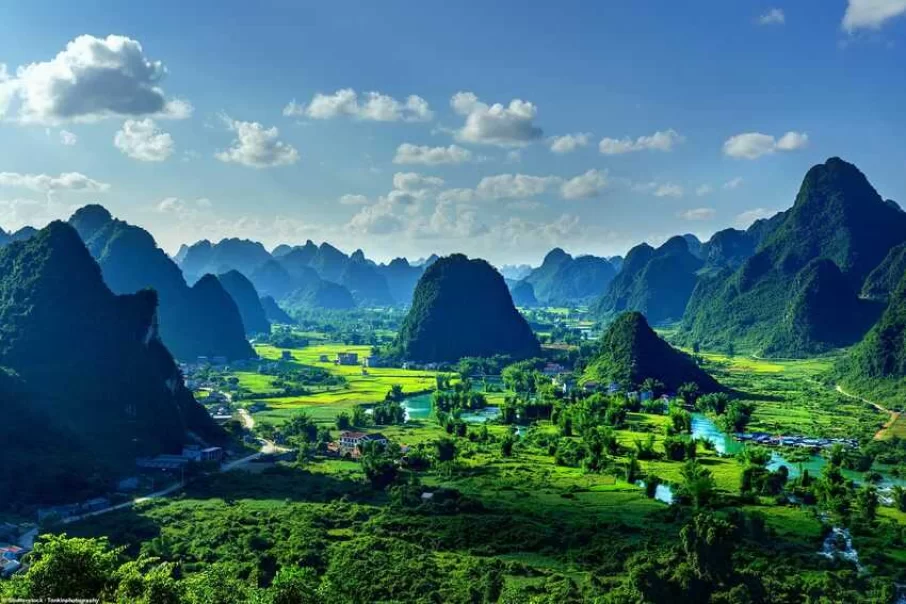
Se déplacer au Vietnam
Voyager en train est une excellente façon de voir le paysage vietnamien. Le réseau ferroviaire relie Hanoï à Ho Chi Minh-Ville, avec des arrêts dans des villes clés en chemin. Les trains offrent différentes classes de confort, des sièges durs aux cabines de couchettes douces. Une expérience particulièrement mémorable est le trajet en train de nuit, où vous pouvez vous endormir au son du roulis des wagons et vous réveiller dans une nouvelle destination.
Le réseau de bus au Vietnam est étendu et économique, reliant non seulement les grandes villes mais aussi les petites villes et les villages ruraux. Les bus vont des options locales de base aux bus de luxe avec air conditionné et sièges inclinables. Cependant, les voyages en bus peuvent être longs et les routes sinueuses, donc ce n'est pas l'option la plus rapide.
Les motos et vélos
Pour une immersion complète, beaucoup choisissent de louer une moto ou un vélo. Cela offre une liberté inégalée pour explorer, que ce soit dans les rues animées des villes ou sur les routes de campagne paisibles. Cependant, la conduite au Vietnam peut être intimidante en raison du trafic dense et des règles de circulation parfois chaotiques. Assurez-vous d'être à l'aise avec la conduite dans de telles conditions et d'avoir une assurance adéquate.
Taxis et Grab
Les taxis sont omniprésents dans les villes et sont une option sûre et confortable, surtout si vous n'êtes pas à l'aise avec la conduite. Grab, une application de covoiturage similaire à Uber, est également largement utilisée et pratique pour les courts trajets en ville. En choisissant le mode de transport qui convient le mieux à votre style de voyage, vous pouvez enrichir votre expérience au Vietnam et profiter de la diversité que ce pays a à offrir.
Si vous ne savez pas par où commencer pour votre voyage au Vietnam, voici une liste non exhaustive des choses incontournables à faire pendant votre séjour :
Baie d'Ha Long : un paysage époustouflant de l'UNESCO avec des croisières pour explorer des îles karstiques et des grottes.
Hanoï : la capitale vietnamienne regorge de sites historiques, de musées, de marchés animés et de la célèbre cuisine de rue.
Sapa : une région montagneuse connue pour ses rizières en terrasses, ses randonnées et la découverte de diverses ethnies.
Hoi An : une ville ancienne préservée offrant un aperçu de l'histoire du Vietnam, célèbre pour ses rues pittoresques et ses lanternes.
Hué : l'ancienne capitale impériale du Vietnam, connue pour sa citadelle, ses tombeaux royaux et ses pagodes.
Delta du Mékong : explorez cette région labyrinthique de cours d'eau en bateau, visitez les marchés flottants et découvrez la vie rurale.
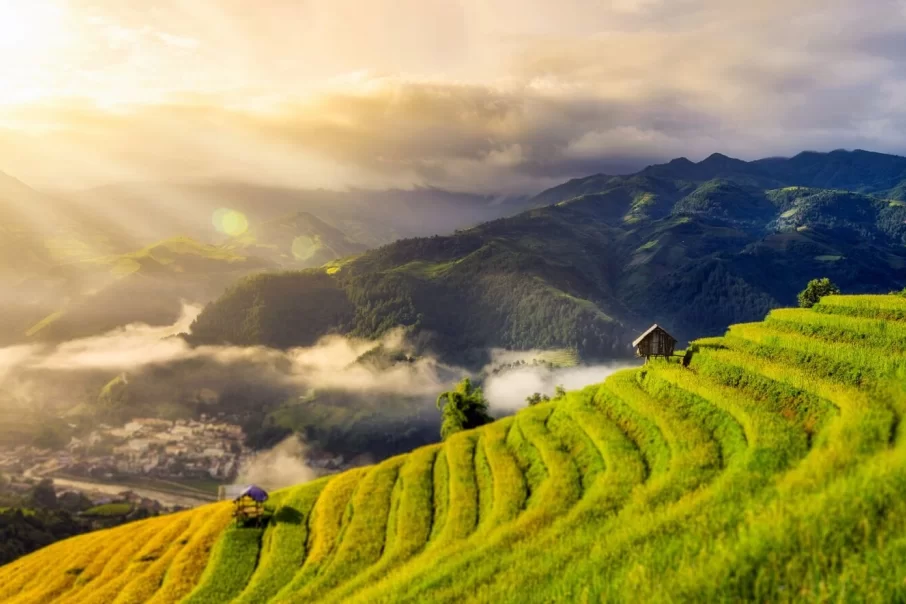
Les incontournables à faire pour un voyage au Vietnam
Ho Chi Minh-Ville (Saigon) : une ville dynamique avec un mélange de sites historiques de la guerre du Vietnam et de modernité urbaine.
Nha Trang : une station balnéaire populaire avec de belles plages et des activités aquatiques.
Da Nang : connue pour ses plages, la montagne de marbre et la proximité avec les montagnes de Ba Na Hills.
Les tunnels de Cu Chi : un réseau de tunnels historique utilisé pendant la guerre du Vietnam.
La cuisine vietnamienne, reconnue pour ses saveurs fraîches, ses herbes aromatiques et son équilibre entre les éléments sucrés, salés, acides et piquants, est un incontournable de tout voyage au Vietnam. Chaque région a ses spécialités, reflétant son histoire, sa géographie et ses influences culturelles.
Le nord du Vietnam
Dans le nord, les plats sont généralement moins épicés mais riches en saveurs. Le Pho, une soupe de nouilles avec du bœuf ou du poulet, est un classique de Hanoï. Autre spécialité du nord, le Bun Cha, composé de porc grillé servi avec des nouilles de riz, des herbes et une sauce à base de nuoc mam (sauce de poisson fermentée).
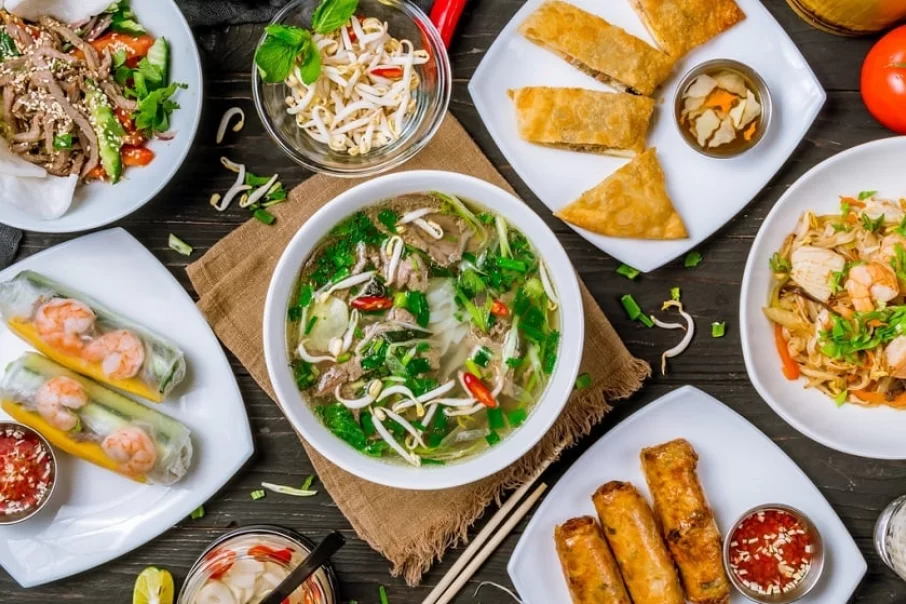
Tout savoir sur la cuisine vietnamienne avant son voyage au Vietnam
Le centre du Vietnam
Le centre, notamment la ville de Hué, est réputé pour sa cuisine raffinée, autrefois servie à la cour royale. Les plats sont plus épicés et colorés. Le Bun Bo Hué, une soupe de nouilles épicée avec du bœuf, est un must. Les petits en-cas comme les Banh Beo (petits gâteaux de riz) et les Banh Khoai (crêpes croustillantes) sont aussi des délices à ne pas manquer.
Le sud du Vietnam
Le sud, avec son climat tropical, offre une abondance de fruits, de légumes et de fruits de mer, se traduisant par des plats plus sucrés et plus variés. Le Cari Ga, un curry de poulet influencé par l'Inde et la Malaisie, et le Canh Chua (soupe aigre de poisson) sont représentatifs de cette région. Ho Chi Minh-Ville, en particulier, est un melting-pot de saveurs, offrant un mélange de plats de tout le pays et de cuisines internationales.
Et la street food vietnamienne ?
La street food est un aspect essentiel de l'expérience culinaire vietnamienne. Des marchés de rue aux vendeurs ambulants, vous trouverez une variété incroyable de snacks, de repas complets et de boissons. Les rouleaux de printemps frais (Goi Cuon), les crêpes vietnamiennes (Banh Xeo) et les desserts à base de lait de coco et de tapioca sont des incontournables.
Opter pour une agence de voyage comme VoyageVietnam.com peut considérablement faciliter la planification et l'organisation de votre séjour au Vietnam, surtout si vous visitez le pays pour la première fois ou si vous avez des besoins spécifiques.
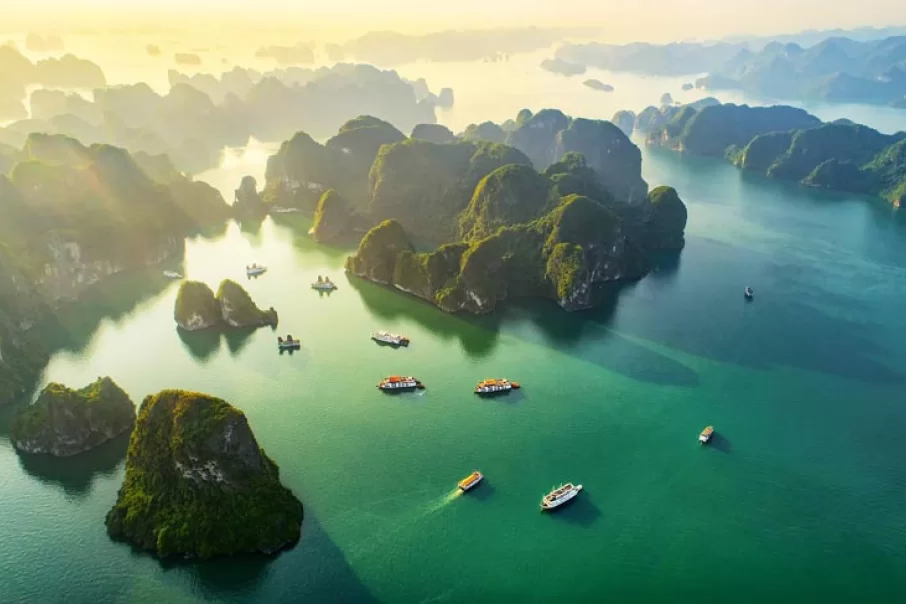
Organiser son voyage avec une agence
Des services personnalisés
L'un des principaux avantages de VoyageVietnam.com est la personnalisation des voyages. L'agence offre une attention personnalisée, adaptant les itinéraires en fonction de vos intérêts, de votre budget et de la durée de votre séjour. Que vous soyez un amateur d'aventures en plein air, un passionné de culture et d'histoire, ou que vous recherchiez simplement un séjour relaxant sur des plages paradisiaques, l'agence peut organiser un voyage qui répond spécifiquement à vos désirs.
De plus, vous pouvez à tout moment réaliser un devis en ligne pour un voyage au Vietnam tout compris et personnalisé !
Une expertise locale
L'expertise locale est un atout majeur. Les agents de VoyageVietnam.com connaissent le pays en profondeur. Ils peuvent vous fournir des informations précieuses sur les destinations moins connues, les meilleures périodes pour visiter certaines régions, et des conseils sur les expériences culturelles authentiques. Cette connaissance approfondie vous permet de vivre des expériences uniques qui peuvent être difficiles à organiser par vous-même.
Facilité et confort pour un voyage tout compris
Organiser un voyage peut être fastidieux, surtout dans un pays avec des différences culturelles et linguistiques significatives. VoyageVietnam.com s'occupe de tous les détails logistiques – réservations d'hôtels, transports internes, visas, et même des recommandations de restaurants et d'activités. Cela vous permet de profiter de vos vacances sans vous soucier des arrangements pratiques.
Un rapport qualité-prix rare
Les agences de voyage comme VoyageVietnam.com ont souvent accès à des tarifs préférentiels et des offres spéciales auprès des hôtels, des compagnies aériennes et d'autres fournisseurs de services. Cela signifie que vous pouvez profiter d'un voyage de qualité à un prix compétitif. De plus, l'agence peut vous aider à éviter les pièges courants tels que les surcharges touristiques et les escroqueries, vous garantissant ainsi une meilleure utilisation de votre budget de voyage.
Une assistance continue
Un autre avantage significatif est la disponibilité d'une assistance en cas de besoin. Que vous ayez des questions pendant la planification de votre voyage ou que vous ayez besoin d'aide pendant votre séjour au Vietnam, l'équipe de VoyageVietnam.com est disponible pour vous aider. Cette tranquillité d'esprit est particulièrement précieuse dans des situations imprévues, comme les changements de dernière minute ou les urgences.
Des expériences thématiques
Enfin, VoyageVietnam.com propose diverses expériences thématiques – des circuits gastronomiques aux randonnées en montagne, en passant par des séjours culturels et historiques au cœur du Vietnam. Ces expériences sont conçues pour offrir une perspective plus profonde et enrichissante du Vietnam, au-delà des attractions touristiques classiques. En résumé, choisir une agence comme VoyageVietnam.com pour organiser votre voyage peut transformer une simple visite en une expérience inoubliable, riche en découvertes et en confort.
Outre les circuits au Vietnam, nous vous proposons également des voyages organisés dans les pays d'Asie du Sud-Est tels que le Laos, le Cambodge, la Thaïlande et le Myanmar ! N’attendez plus et voyagez avec VoyageVietnam !
Le Vietnam est-il sûr de voyager?
Le Vietnam est sans doute l’un des meilleurs pays où voyager en Asie du Sud-Est, car il a la réputation d’avoir certains des plus beaux paysages, une histoire très riche, ainsi qu’une culture et des traditions très enchanteresses et captivantes. Néanmoins, comme dans tout autre pays, des inquiétudes ne manqueront pas d’être soulevées quant au niveau de sécurité des voyageurs et des touristes lors de leur visite dans le pays. Il s’agit d’une préoccupation tout à fait compréhensible et légitime, car il faut savoir s’ils sont en sécurité ou non avant de se lancer dans un voyage vers le pays d’autrui.
Généralement, le Vietnam est considéré comme un endroit sûr pour les touristes, cependant, comme il ne peut y avoir de garantie de sécurité à 100 % nulle part dans le monde, il est très important d'être conscient des risques possibles associés au fait de se trouver à certains endroits et à certaines heures. La plupart du temps, les régions du Vietnam qui sont densément peuplées comme Hanoï, Hô Chi Minh-Ville, etc. connaissent des problèmes de vol et d'autres délits mineurs comme le vol à la tire, ce qui est une préoccupation normale dans la plupart des grandes villes du monde. Compte tenu de cela, il est conseillé aux touristes de développer un troisième œil dans la rue et de veiller à tout moment à une protection accrue de leurs objets de valeur.
L’arnaque touristique est un défi répandu et assez alarmant au Vietnam. Cela est dû au fait que les touristes se font arnaquer en raison de leur connaissance insuffisante des prix réels des biens et services. Certaines des façons courantes de rencontrer de tels défis incluent la rencontre avec des chauffeurs de taxi très malhonnêtes, la réception d'offres trompeuses de la part de vendeurs, etc.
En tant que touriste, vous pouvez rencontrer un chauffeur de taxi et, comme vous ne connaissez pas votre environnement, il peut essayer de vous donner des propos scandaleux. des prix pour pratiquement moins de service. Ceci est très courant, surtout dans les zones touristiques. Vous devez donc être très informé et vigilant lorsque vous parcourez le pays. Vous devez être prudent et connaître par vous-même les prix locaux réels des biens et services avant de vous lancer dans une transaction avec qui que ce soit, et vous assurez également de n'effectuer des transactions qu'avec des personnes de confiance et vérifiées.
Afin d'optimiser votre sécurité au Vietnam et d'éviter de regarder par-dessus vos épaules lors de votre tournée dans le pays, vous devez prendre certaines mesures très au sérieux. Votre sécurité personnelle est primordiale et passe avant tout. Vous devez donc être très vigilant, en particulier dans les zones très fréquentées, et également limiter l'exposition de gadgets et de bijoux très coûteux, tout en protégeant vos sacs et autres objets de valeur. Vous devez également normaliser l’utilisation des cartes de débit ou de crédit, en particulier pour les transactions importantes, afin d’éviter de transporter de grosses sommes d’argent liquide.
Encore une fois, vous devez vous engager uniquement avec des modes de transport officiels et vérifiés comme le transport par application mobile (Grab, etc.) ainsi que les taxis avec compteur pour éviter d'être trompé ou arnaqué. Vous devez également vous assurer qu'avant de venir au Vietnam, vous avez souscrit une assurance médicale très puissante pour prendre en charge tous vos besoins médicaux et vous couvrir entièrement, qu'il pleuve ou qu'il fasse beau.
Bien que vous ayez souscrit une assurance médicale, vous devez toujours vous assurer de prendre des mesures de sécurité telles que prendre les vaccinations recommandées ou suggérées, boire de l'eau en bouteille très sûre, ainsi que prendre des mesures sérieuses contre les moustiques pour prévenir le paludisme. En passant par la plupart, sinon la totalité, de ces mesures et précautions suffisent à dire que votre voyage au Vietnam sera tout à fait étonnant et dépourvu de toute anomalie de sécurité.
Combien coûte un circuit au Vietnam?
Planifier un voyage dans un très beau pays d’Asie du Sud-Est comme le Vietnam nécessite certainement une budgétisation et des calculs adéquats. Vous devez inclure les coûts majeurs tels que les vols, l’hébergement, le transport, la nourriture et les activités elles-mêmes. Pour être honnête, nous devons établir le fait qu’il existe de nombreuses classes et variations dans chaque voyage ou voyage touristique. Nous disons cela parce que par exemple, un touriste planifiant un voyage de 3 ou 4 jours au Vietnam aurait un coût différent par rapport à quelqu'un qui part pour 2 semaines. Ces variations seront donc dues aux préférences de la personne en matière d’hébergement, de style de vie en voyage, de transport, de vol et d’activités en général. Examinons le coût estimé du voyage pour une personne effectuant un « voyage à petit budget ».
Lorsque vous partez en voyage touristique dans n’importe quel pays, vous devez généralement réserver un billet d’avion aller-retour pour un retour plus facile et plus rapide. Les prix des billets d'avion varient cependant en fonction de votre emplacement et de la proximité réelle de votre destination de voyage. Par exemple, si vous voyagez depuis certaines des grandes villes des États-Unis d'Amérique comme New York, Los Angeles, San Francisco, etc., le coût d'un billet aller-retour au Vietnam peut varier entre 600 et 1 200 dollars. Ces prix dépendent cependant également de la compagnie aérienne, de la saison ou de la période de l'année, ainsi que de la disponibilité des vols. Il est donc important de continuer à surveiller les prix des billets car ils fluctuent la plupart du temps.
L’hébergement est l’une des choses les plus importantes à considérer lors de la planification d’un voyage dans un autre pays. Vous devez donc prendre en compte le coût de l'hébergement pendant votre séjour au Vietnam et les prix peuvent varier en fonction du type d'hébergement, de la période du voyage ainsi que du lieu. Habituellement, lorsque vous voyagez dans une grande ville dans n’importe quelle partie du monde, vous devez vous attendre à ce que le coût de l’hébergement comme les hôtels, etc. soit plus cher que dans les petites villes, et le Vietnam ne fait pas exception.
Par exemple, si vous envisagez de vous rendre dans des villes comme Hanoi et Ho Chi Minh, vous ne vous attendez pas à avoir les mêmes prix d’hôtel qu’à Ninh Binh. Un hôtel normal à Hanoï peut coûter environ 800 000 VND par nuit, soit environ 34 dollars, tandis qu'un hôtel de luxe peut coûter environ 3 000 000 VND par nuit, soit environ 128 dollars. D'un autre côté, dans les petites villes, une chambre d'hôtel normale peut coûter environ 500 000 VND par nuit, soit environ 21 dollars, tandis qu'une chambre de luxe peut coûter environ 2 500 000 VND par nuit, soit environ 107 dollars. Il est toutefois important de noter que ces prix peuvent évoluer en fonction de la saison ou de la période, ainsi que des disponibilités.
Lorsqu'il s'agit de manger, le Vietnam est connu pour sa cuisine de rue abordable mais tout à fait savoureuse. Ces aliments sont peut-être bon marché, mais croyez-moi, ils sont également très délicieux. Peu importe que vous souhaitez maintenir un style de vie luxueux lors de vos voyages ou des dépenses plutôt modestes, en tant que touriste, vous devez essayer certains, voire tous les plats de rue du Vietnam, vous les adorerez certainement.
Vous pouvez acheter de la restauration rapide ou de rue dans la rue pour environ 20 000 à 50 000 VND, soit environ 2 $ ou moins. Les restaurants de milieu de gamme servent de la nourriture pour environ 200 000 à 500 000 VND, soit environ 8 à 20 $ par repas, tandis que les restaurants haut de gamme ou de luxe servent de la nourriture pour environ 1 000 000 VND et plus, soit environ 40 $ et plus par repas. Le plus étonnant, c’est que le système a été structuré pour s’adapter aux envies et préférences de chacun, que vous soyez amateur de cuisine de rue ou que vous soyez du genre restaurateur raffiné, vous n’êtes certainement pas en reste.
Le transport est également un aspect essentiel de l’équation du voyage. Il est tout à fait conseillé de connaître et de calculer le coût du transport pendant la totalité de votre séjour au Vietnam. Comme nous le savons tous, il existe généralement différents modes de transport, notamment les trains, le métro, les bus, les taxis et les voitures de location. Voyager en train au Vietnam est très populaire car le coût dépend également de la durée de votre voyage.
Par exemple, lorsqu'une personne voyage en train de Hanoï à Hô Chi Minh-Ville pour un aller simple, elle peut payer entre 800 000 VND (34 $) et 1 600 000 VND (68 $) selon le calibre du siège. À l’heure actuelle, il n’existe qu’une seule ligne de métro dans tout le Vietnam, celle-ci se trouvant à Ho Chi Minh-Ville. Le prix d'un ticket de métro est de 5 000 VND (0,21 $) par trajet. Le bus est un moyen moins cher et plus pratique de se déplacer au Vietnam.
Les prix des billets de bus dépendent généralement de la distance parcourue ainsi que du type de bus. Le prix d'un bus typique de Hanoï à Hô Chi Minh-Ville est d'environ 400 000 VND (17 $) à 800 000 VND (34 $). Les taxis circulent généralement dans tout le pays et constituent également un moyen très pratique de se déplacer. Le prix d'un taxi dépend pratiquement de la distance parcourue.
Un trajet de 5 km depuis Hanoï peut généralement coûter environ 70 000 VND (3 dollars). La location d'une voiture est plus pratique lorsque vous voyagez en famille ou en groupe. C'est vraiment pratique dans de telles circonstances et peut coûter entre 500 000 VND (21 $) par jour pour une petite voiture. Les prix des locations varient en fonction de la taille et du type de voiture.
En planifiant un voyage au Vietnam en tant que touriste, vous devez prendre en compte le coût de vos activités, y compris les sites et destinations touristiques. Ces sites peuvent inclure des temples, des plages, des marchés, etc. Pour les temples et les sanctuaires, vous devrez prévoir un budget suffisant, de l'ordre de 50 000 VND (2 $) par personne, alors que les plages comme Nha Trang, Da Nang et Phu Quoc peuvent coûter plus cher. à 100 000 VND (4$).
Il existe des spectacles de marionnettes sur l’eau au Vietnam. Ces spectacles sont une forme d’art traditionnelle qui serait originaire du delta du fleuve Rouge. Vous pouvez aller voir un spectacle à un prix allant de 100 000 VND à 300 000 VND par personne, soit environ 4 à 13 USD par personne. Il existe de nombreux marchés sympas au Vietnam, comme le marché Ben Thanh à Hô Chi Minh-Ville et le marché Dong Xuan à Hanoï.
Lorsque vous parcourez les marchés et décidez d’acheter quelque chose, les prix peuvent varier en fonction de ce que vous souhaitez acheter. Les aliments de rue sur les marchés coûtent aussi peu que 20 000 VND (moins de 1 dollar) par repas. Lorsque vous planifiez votre voyage au Vietnam, vous pouvez faire une estimation et un calcul approximatifs en prenant en compte les chiffres suggérés ci-dessus, afin que vous puissiez au moins avoir un aperçu de ce dans quoi vous allez vous lancer et combien d'argent vous pouvez y consacrer.
Quelle est la meilleure façon de voyager au Vietnam?
Lorsque vous planifiez votre voyage au Vietnam, la façon de vous déplacer dans le pays vous viendra certainement à l'esprit. Les différents moyens de déplacement sont l'avion, le train, la voiture, le bateau, le bus, le taxi ou la moto.
Avion – C’est évidemment le moyen de transport le plus rapide mais le plus coûteux. Il est généralement pratique et plus approprié pour ceux qui sont très en retard ou battus par le temps, et qui doivent également pouvoir se le permettre car c'est un moyen assez coûteux par rapport aux autres.
Train - Le Vietnam est considéré comme l'un des pays d'Asie du Sud-Est doté d'un réseau ferroviaire de qualité et fiable. Bien que plus cher que les bus, il offre un meilleur confort et une meilleure commodité, c'est pourquoi l'office du tourisme vietnamien le considère comme plus pratique et plus sûr que les bus.
Bus - Si vous êtes un voyageur indépendant et que le confort ou la commodité optimale ne vous dérange pas, le système de bus sera très utile pour vous en tant que touriste au Vietnam. C'est pratiquement le moyen de déplacement le moins cher et peut être assez fastidieux, car vous devez toujours surveiller et respecter les horaires de bus afin de ne pas manquer votre bus à un moment donné.
Bateau - Il existe un certain nombre de fleuves au Vietnam, qui sont également très navigables, le Mékong et ses affluents étant le plus important de tous. Les bateaux peuvent être utilisés pour se déplacer dans des endroits reliés à ces rivières et disposant également de zones d'amarrage relativement sûres. Il existe également des déplacements à travers des zones reliées par la mer, par exemple une croisière vers les îles de la baie d'HaLong pour vivre une expérience magnifique et captivante avec les karsts et les îles.
Voiture - C'est un moyen très pratique pour se déplacer au Vietnam, notamment pour ceux qui voyagent en famille ou avec un groupe d'amis ou de collègues. Vous pouvez louer une voiture pour vous aider à vous déplacer en tant que touriste local mais jamais en tant que touriste étranger. Cela est dû au fait que le Vietnam n’autorise pas l’utilisation de permis de conduire internationaux pour opérer dans le pays. Vous pouvez cependant louer une voiture et un chauffeur pour vous déplacer en tant que touriste étranger.
Moto - C'est le moyen de transport et de déplacement le plus populaire au Vietnam. C'est un moyen de déplacement très rapide et pratique mais aussi très risqué par rapport aux autres moyens. C'est un moyen plus approprié de contourner le trafic intense dans les grandes villes comme Hanoi, Ho Chi Minh, etc.
Taxi - C'est également un moyen pratique de se déplacer puisque vous pouvez trouver des taxis presque partout dans les grandes villes et même dans les plus petites. Vous pouvez commander des taxis sur des applications de téléphonie mobile (Grab, Uber etc), c'est une manière encore plus fiable d'utiliser le service de taxi, pour une expérience encore meilleure.
Lorsque nous analysons et examinons l'ensemble des différents moyens de déplacement au Vietnam, nous pouvons sans aucun doute arriver à la conclusion que les trains sont le meilleur moyen de se déplacer au Vietnam, en mettant en perspective l'abordabilité et le confort.
Quelle est la meilleure période pour voyager au Vietnam?
Le Vietnam est un très beau pays à visiter avec une culture riche, un éventail enchanteur de paysages et une histoire fascinante. Il n'y a en fait pas de mauvais moment pour visiter le pays, cependant, il existe certainement des moments les plus appropriés pour visiter différentes régions du pays, et en tant que touriste envisageant de visiter le Vietnam, vous êtes obligé d'être au courant de toutes les informations concernant le moment approprié. ou période pour visiter le Vietnam.
Généralement, la période la plus appropriée pour visiter le Nord-Vietnam se situe entre septembre et novembre et également entre mars et mai. Pendant ces périodes, le temps est calme et agréable avec des températures atteignant environ 15 degrés Celsius à 28 degrés Celsius. Les activités de plein air sont bien encouragées pendant ces mois en raison du ciel clair et du climat agréable, contrairement à la chaleur totale de l'été.
Les périodes hivernales s'étendent généralement de décembre à février, tandis que les températures peuvent être extrêmement froides, en particulier autour des zones montagneuses, où les températures descendent jusqu'à environ 10 degrés Celsius. Au contraire, les températures estivales (de juin à août) deviennent très chaudes avec des averses de pluie rampante.
En tant que touriste, si vous souhaitez découvrir un automne très agréable et serein, le mieux est de septembre à novembre. En supposant que vous souhaitiez faire du trekking en montagne ou aller voir une tribu montagnarde, mars à mai promet des conditions météorologiques bien meilleures.
En examinant les deux saisons distinctes de la partie sud du Vietnam, à savoir la saison des pluies et la saison sèche, il n'est donc pas si difficile de tirer une conclusion soudaine sur la saison la plus appropriée pour visiter le Sud-Vietnam.
La saison sèche, qui s'étend de novembre à avril, s'accompagne d'un temps clair et de températures élevées. Cela offre une atmosphère stable permettant aux touristes de profiter de leurs visites et mouvements ininterrompus tout au long de leur voyage dans la partie sud du Vietnam. Il suffit donc de dire que la meilleure période pour visiter le sud du Vietnam est la saison sèche.
Des destinations comme la ville de Hue, Da Nang et Hoi An sont toutes populaires dans le centre du Vietnam et ont un climat relativement similaire. Il est donc important de connaître les horaires ou la période les plus appropriés pour visiter la région en tant que touriste afin de profiter de votre voyage sans distractions ni imprévus.
Il est généralement recommandé que le meilleur moment pour visiter cette région du centre du Vietnam soit le point culminant de la saison touristique, qui s'étend généralement d'avril à août, où il y a un bon ensoleillement ainsi que des conditions favorables pour les activités liées à la plage, entre autres.
Combien de jours au Vietnam suffisent-ils?
On murmure toujours qu’il n’existe aucune spécification de temps réelle pouvant être fixée pour un voyage ou une tournée. C'est généralement à la personne qui entreprend le voyage de décider combien de jours ou de semaines elle souhaite passer pendant le voyage. Cependant, il existe toujours une durée suggérée qui peut être utilisée pour effectuer une visite.
Le Vietnam est un très beau pays très célèbre dans la région du Sud-Est de l’Asie pour ses paysages étonnants et sa riche culture. Au fil des années, le Vietnam est devenu une très bonne destination touristique avec ses villes comme Hanoi, Ho Chi Minh, etc. ainsi que des plages et des îles comme la baie d'Ha Long, le delta du Mékong, etc. Avec toutes ces destinations et bien plus encore, c'est inévitable. pour voir le travail qu'il faut faire pour réaliser une tournée nationale au Vietnam.
Pour vivre pleinement l’expérience du Vietnam du Nord au centre en passant par le Nord, vous devrez vous en tenir à un itinéraire de 10 jours. Cet itinéraire de 10 jours vous tiendra au courant et informé de tous les lieux incontournables, afin que vous ne manquiez rien ni aucun lieu.
Où dois-je aller en premier au Vietnam?
Chaque ville du Vietnam possède au moins une caractéristique unique qui la distingue des autres. Cela signifie que vous ne pouvez pas simplement tirer des conclusions hâtives sur quelle ville est la meilleure parmi les autres. Cependant, en tant que visiteur novice, je vous recommanderai de visiter Hanoï en premier, non seulement parce que c'est la capitale du Vietnam, mais aussi parce qu'elle a beaucoup à montrer et à enseigner.
Hanoï est une ville qui regorge de culture vietnamienne riche, d'une touche d'histoire, ainsi que d'une cuisine d'excellence avec une touche de classe. Chaque visiteur visitant le Vietnam pour la première fois devrait se faire un devoir d’aller voir Hanoï avant de continuer ailleurs. Une fois parti de Hanoï, il en apprendra beaucoup sur les gens et la culture avant même de commencer à explorer.
Quel est le plus bel endroit du Vietnam?
Le Vietnam est un pays très merveilleux d’Asie du Sud-Est avec de nombreux paysages captivants et de beaux endroits à voir. Il existe de nombreuses destinations enchanteresses et à couper le souffle, comme Hanoi, la capitale du pays, Ho Chi Minh-Ville, Hue, Da Nang, entre autres endroits où les visiteurs et les touristes peuvent explorer la magnificence du pays.
Il est généralement assez fastidieux de choisir une destination particulière comme étant la plus jolie de toutes, car la plupart, sinon la totalité, des destinations sont très belles. Quoi qu’il en soit, il est très important de reconnaître que de multiples enquêtes et classements ont prouvé que la baie d’HaLong, classée 2 fois au patrimoine mondial de l’UNESCO, est la plus belle de toutes.
Cela est probablement dû à ses plages immaculées, ses magnifiques grottes et grottes, ses nombreuses montagnes calcaires ainsi que ses villages de pêcheurs calmes et spectaculaires. Il est évident que cette destination précieuse possède toutes ses caractéristiques et fait ressortir le meilleur de chacune d'elles, atteignant un bon niveau de destination touristique de premier ordre et une perfection optimale.
Ai-je besoin d’un guide touristique au Vietnam?
Comme tout autre touriste, un guide touristique est nécessaire pour rendre votre voyage plus facile et meilleur. Donc, la réponse est oui! Oui, vous avez besoin d’un guide touristique au Vietnam, car c’est un guide touristique qui possède la plupart des connaissances sur l’histoire du pays qu’il partagera avec vous. Il peut facilement partager avec vous des faits amusants et intéressants au cours de votre voyage.
Une autre raison très importante pour laquelle vous avez besoin d'un guide touristique est le soutien pratique. Les guides touristiques sont essentiellement utiles lorsqu'il s'agit d'être votre interprète quelque peu informel auprès de nombreuses personnes, vendeurs et magasins, et vous aident également à échapper à l'arnaque. Ils vous aident même surtout à négocier correctement les biens et services afin que certaines personnes malveillantes ne parviennent pas à vous arnaquer.
Un visa est-il nécessaire pour voyager au Vietnam?
En 2024, 25 pays pourront voyager au Vietnam sans visa. Pour ces pays, la seule exigence est d'avoir un passeport valide avec au moins deux pages vierges pour les démarches d'immigration et le tamponnage. Néanmoins, pour les pays qui ne font pas partie de ces 25 pays, leurs citoyens doivent demander un visa valide avant de pouvoir se rendre au Vietnam. La bonne nouvelle est que depuis août 2023, les ressortissants de tous les pays sont éligibles à l’octroi d’un visa électronique pour le Vietnam d’une durée de séjour de 90 jours. Voici une liste complète des pays (25) qui n'ont pas besoin de visa pour visiter le Vietnam.
Brunei, Myanmar, Biélorussie, Danemark, Finlande, France, Allemagne, Italie, Japon, Norvège, Russie, Corée du Sud, Espagne, Suède, Royaume-Uni, Philippines, Cambodge, Indonésie, Kirghizistan, Laos, Malaisie, Singapour, Thaïlande, Chili , Panamá.
Quelles sont les possibilités de visites au Vietnam?
Le Vietnam est un très beau pays avec de nombreuses attractions touristiques captivantes et des paysages enchanteurs. Les possibilités de visite sont nombreuses et ne peuvent pas toutes être mentionnées ici. Cependant, il y a quelques endroits importants qui doivent être mentionnés car en tant que touriste jetant un coup d'œil au Vietnam dans son ensemble, votre visite ne peut être complète sans voir ces lieux.
Baie d'Ha Long - Il s'agit d'un site classé au patrimoine mondial de l'UNESCO qui figure souvent en tête de la liste des principales attractions touristiques du Vietnam. Lorsque vous visitez le Vietnam, on ne dira pas que vous avez terminé votre voyage sans visiter cet endroit. Il existe de nombreuses activités auxquelles participer dans cet incroyable paysage karstique, comme le kayak, la visite de villages flottants, la randonnée, etc.
Hanoï - C'est la capitale du Vietnam qui attire des millions de visiteurs chaque année en raison de sa longue histoire de plusieurs milliers d'années, de sa riche culture, ainsi que de sa belle architecture et de la valeur de la tradition vietnamienne. Les endroits que vous ne devriez pas manquer à Hanoi en tant que touriste sont le pont Long Bien, la prison Hoa Lo, le temple de la Littérature, le lac Hoan Kiem, etc.
Sapa - C'est l'une des régions montagneuses du nord du Vietnam, y compris le Fansipan (la plus haute montagne du pays). Il compte un certain nombre de villages de randonnée comme Cat Cat, Y Linh Ho, etc. où les touristes peuvent explorer et vivre de superbes expériences de randonnée.
Ninh Binh - Cet endroit est connu pour être l'ancienne capitale du Vietnam féodal vers le siècle à l'époque des dynasties Dinh et Le. Cet endroit possède des sites étonnants comme les karsts de Trang An, les anciennes citadelles et temples de Hoa Lu etc, un endroit vraiment étonnant.
Ville de Hue – Elle est connue comme la ville la plus historique du Vietnam et abrite l’ancienne capitale impériale du pays. Hue possède des palais, des temples et des résidents de l'empereur qui sont de véritables reflets historiques de l'ancienne citadelle impériale de Hue.
Hoi An - On dit que cet endroit a une culture mixte car il a été développé par les Japonais, les Chinois et les Vietnamiens, mais il a un thème chinois dominant dans tout l'espace. Hoi An à des destinations comme le village de poterie de Thanh Ha, le village d'herbes de Tra Que, etc. C'est une destination qui accueille de nombreux festivals chaque année, le festival des lanternes de pleine lune étant le plus célèbre d'entre eux. Ce festival a lieu le 14ème jour de chaque mois lunaire et présente uniquement la tradition et la culture vietnamiennes avec des expositions de lanternes partout.
Ho Chi Minh Ville (Saigon) - C'est une ville jeune de plus de 3 siècles avec ses attractions influencées par l'architecture de l'époque française comme le musée des vestiges de la guerre, le palais de la réunification, la cathédrale Notre-Dame, etc. C'est une très belle ville avec beaucoup plus à explorer comme les meilleurs plats de rue du Vietnam, etc.
Da Nang - C'est un endroit qui vous éblouit par sa modernité et son caractère solennel. Il y a un certain nombre de choses à voir ici comme le col Hai Van, la montagne de marbre, les collines de Ba Na, le pont d'or, etc. Cela ne s'arrête pas à ces quelques mentions, mais propose également une cuisine étonnante aux touristes. explorer.
Comment est la nourriture au Vietnam?
La culture culinaire vietnamienne est tout à fait étonnante car elle reflète le style asiatique typique (cadre familial), chacun recevant une assiette ou un bol de riz et tous les autres aliments comme le poulet, le porc, le poisson, les légumes, les nouilles, etc. étant au centre et partagés par tous. tout le monde. Au cours des dernières années, la cuisine vietnamienne a acquis une certaine popularité et une réputation pour sa santé et son caractère unique, ce qui la rend très convoitée par beaucoup.
Au Vietnam, vous comprendrez et vous habituerez au fait que les gens ne plaisantent pas avec leur riz et leurs nouilles, car on les trouve dans presque tous les plats vietnamiens. Ce sont quelques plats typiques vietnamiens qui doivent être explorés par tous les moyens nécessaires en tant que touriste.
Bo Kho - Il s'agit d'un ragoût de bœuf et de légumes originaire du Vietnam et est souvent consommé avec des baguettes.
Nem Nuong Xa – Ce sont de la viande grillée normale servie sur des brochettes de citronnelle.
Banh Mi Thit - Ce n'est rien de plus qu'un sandwich composé de baguettes vietnamiennes farcies au jambon, au fromage, aux sardines, aux carottes ou à la Bologne vietnamienne.
Pho - Une soupe de nouilles vietnamiennes aux herbes très délicieuses et chaudes composée de poulet ou de bœuf généralement servie avec du basilic vietnamien, des feuilles de menthe, du citron vert et des germes de soja.
Goi Cuon - Rouleaux d'été vietnamiens composés de porc ou de crevettes ou les deux et d'herbes fraîches, enroulés dans une feuille de riz avec une trempette.
Che - Il s'agit d'un pudding à base de riz gluant et de haricots, souvent servi en dessert.

- Vietnam Cambodge
- À propos de nous
- Devis Sur Mesure

- BLOG DE VOYAGE
- NOUS CONTACTER

- Circuit Vietnam 10-12 jours
- Circuit Vietnam 15 jours
- Circuit Vietnam 3 semaines

- Les incontournables
- Rando & Hors des sentiers battus
- Vietnam en famille
- Circuit Vietnam extension plage
- Circuit Vietnam du Nord
- Circuit Vietnam du Sud

- Circuit Vietnam Cambodge
- Circuit Vietnam Laos
- Voyage en Indochine
- Circuit en Thaïlande
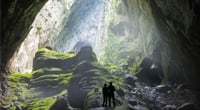
- Baie d'Halong
- Halong terrestre
- Mu Cang Chai
- Lac de Ba Be
- Dien Bien Phu
- Ho Chi Minh
- Delta du Mékong
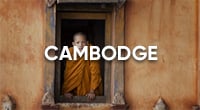
- Infos pratiques
- Circuits Cambodge
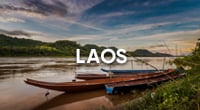
- Circuits Laos
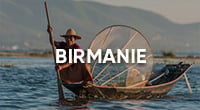
- Circuits Birmanie
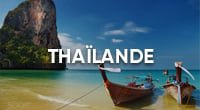
- Circuits Thailande
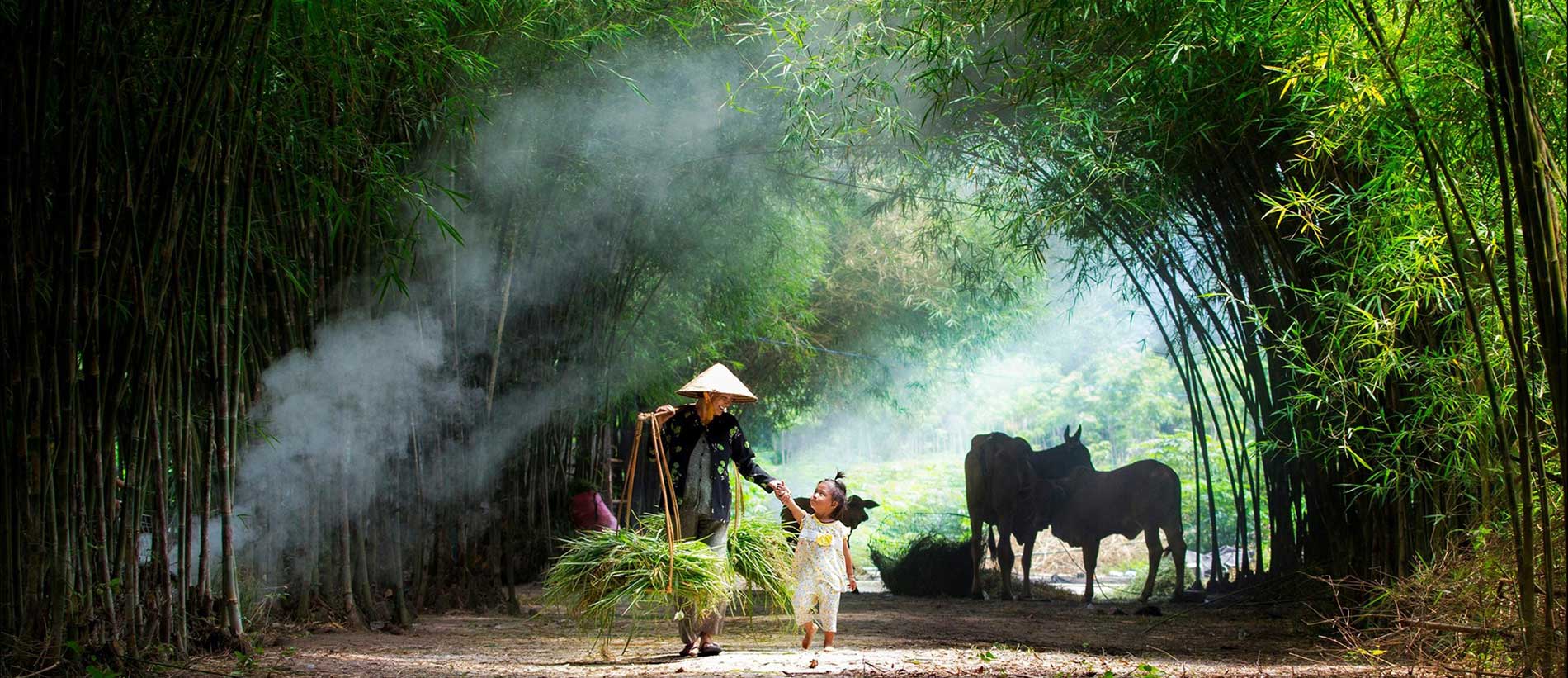
- Blog de voyage
- Récit de voyage
Vietnam 15 jours, comment organiser son voyage ?
15 jours représentent une durée idéale pour visiter le Vietnam, le pays en forme d’un S en Asie du sud-est. Ce circuit de 15 jours vous permettra de découvrir tous les incontournables du pays du nord au sud : la capitale d’Hanoi, la merveilleuse baie d'halong terrestre et maritime, la charmante vieille ville de Hoi An, l'ex-ville de Saigon…Voici des retours de nos chers voyageurs Mme et M. Bernadette & Jean-Paul AUBERT (Étampes, France) qui ont voyagé par le biais de notre agence.

1. Pourquoi le Vietnam en 15 jours ?
2. que faire au vietnam en 15 jours , 3. mon itinéraire au vietnam 15 jours, 4. les informations à connaître sur le vietnam avant votre départ .
.jpg)
Jean-Paul AUBERT - De part son éloignement de l’Europe et sa singulière géographie, 15 jours est un minimum pour bien découvrir le Vietnam, l’appréhender, se familiariser avec lui et ses habitants, s’en imprégner sans que cela soit la course comme cela peut l’être avec les circuits de 10 ou 12 jours.
En 15 jours, vous pouvez vous permettre d’envisager un circuit nord-sud, ou inversement, afin de découvrir la richesse du patrimoine historique, culturel et naturel à travers les sites incontournables du pays. Que faire au Vietnam en 15 jours ? Dans ce récit, je vous raconte ce que j’ai fait durant mon voyage de 15 jours au Vietnam.
La question que tout le monde se pose lors de la préparation de son voyage. Sites incontournables ou sites hors des sentiers battus, activités culturelles ou plus tournées vers la nature ? Tout dépendra en fait de vos envies car ce voyage au Vietnam, c’est d’abord le vôtre ! Cependant, si vous prévoyez un voyage de Vietnam 15 jours pour la première fois, je vous conseille vivement de privilégier les sites incontournables pour avoir un premier aperçu de ce pays en forme de dragon :
- Dans le nord du Vietnam, il y a bien évidemment la majestueuse baie d’Halong à découvrir, site naturel féerique inscrite à l’Unesco, l’attachante capitale millénaire Hanoï à l’histoire fascinante, le spectaculaire site paysager de Ninh Binh dont la nature hallucinée a été consacrée par l’Unesco, sans oublier les époustouflantes rizières en terrasses du Tonkin comme à Sapa.
- Au centre du Vietnam, deux villes pleines de charme et d’élégance classées à l’Unesco vous dévoilent un patrimoine exceptionnel. Hué tout d’abord et ses vestiges de dernière capitale royale, et Hoi An, une jolie petite ville musée qui mélange agréablement tous les plaisirs : l’histoire, la culture, la gastronomie, la campagne, la plage et le shopping.
- Saïgon vous éblouira par cette façon bien à elle de marier le moderne et l’ancien, et vous serez à coup sûr envoûtés par l’Eden nonchalant qu’est le delta du Mékong, un univers aquatique pittoresque plein de surprises.
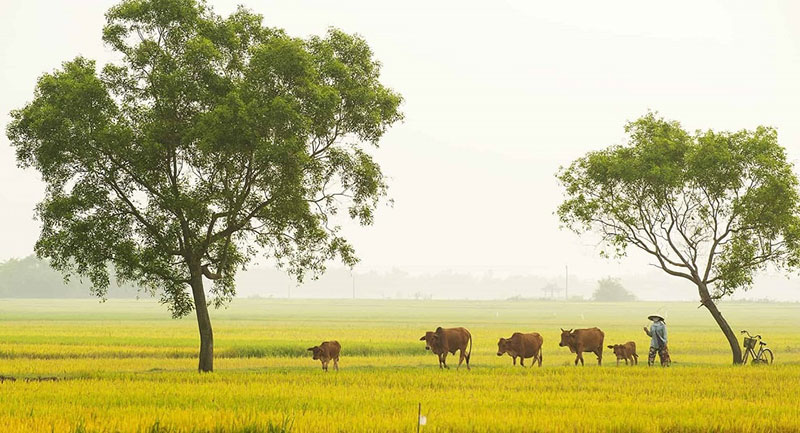
3.1 Itinéraire Vietnam 15 jours : en bref
Voici ma meilleure proposition d’itinéraire pour visiter le Vietnam en 15 jours :
.jpg)
Jour 1 : Hanoi – Arrivée, premières visite de a ville
Jour 2 : Hanoi – tour de ville - train de nuit pour Lao Cai
Jour 3 : Lao Cai – Bac Ha avec nuit chez l'habitant
Jour 4 : Bac Ha, visite d'un marché hebdomadaire – Sa Pa
Jour 5 : Sa Pa, randonnées pédestre – Lao Cai – Hanoi
Jour 6 : Hanoi – Ninh Binh (baie Halong terrestre) – Hanoi
Jour 7 : Hanoi – croisière sur la Baie d’Halong
Jour 8 : Baie d’Halong – Hanoi – envol pour Hue
Jour 9 : Hu e - découverte de la dernière capitale impériale
Jour 10 : Hue – transfert à Hoi An
Jour 11 : Hoi An - visite de la ville la plus charmante du pays
Jour 12 : Hoi An – envol pour Ho Chi Minh ville
Jour 13 : Ho Chi Minh ville – visite du Delta du Mékong
Jour 14 : Delta du Mékong, visite du marché flottant de Cai Rang – Ho Chi Minh Ville
Jour 15 : Ho Chi Minh Ville (départ)
>>> Envie d'un séjour de 2 semaines au Vietnam? Jetez un coup d’œil sur ce circuit incontounable: Le meilleur du Vietnam en 15 jours
3.2 Programme Vietnam en 15 jours: en détail
Jour 1 – jour 2 : hanoi tour de ville – lao cai .
Comme la plupart des voyageurs, j’ai débuté mon voyage au Vietnam en 15 jours par un tour de ville Hanoi afin de connaitre ses lieux symboliques. J’ai décidé d’y consacrer mes deux premières journées.
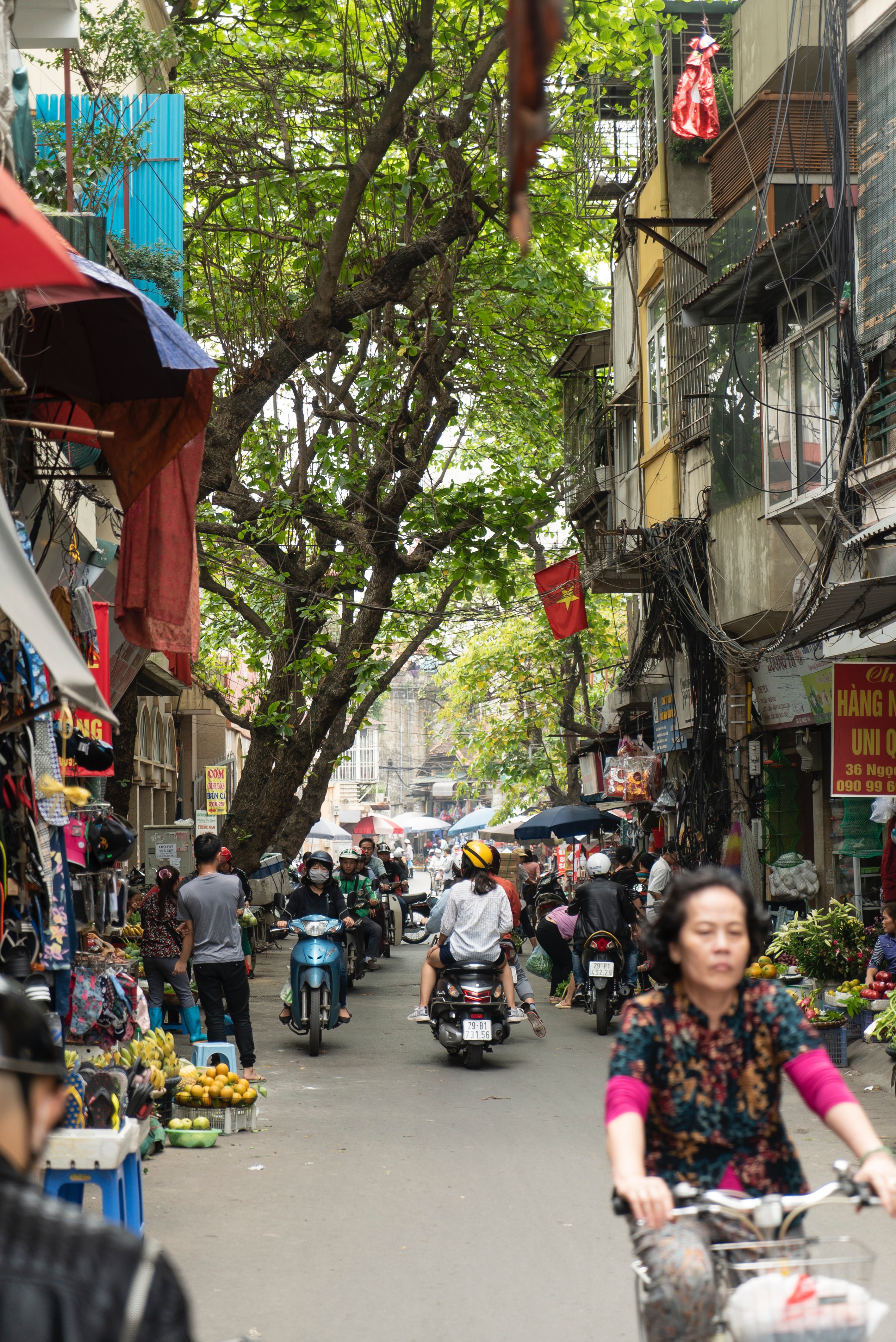
J’ai particulièrement aimé le lac Hoan Kiem qui, situé au cœur de la ville, est l’âme de Hanoï. Le week-end, le pourtour du lac est piétonnier et j’ai eu la chance d’assister à de nombreux spectacles qui s’y déroulent. J’ai adoré l’ambiance animée du vieux quartier de Hanoï qui est l’expression même de l’identité vietnamienne et où je me suis régalé de la légendaire cuisine de rue de la capitale.
J’ai visité le magnifique musée ethnographique qui présente la belle mosaïque ethnique du Vietnam. Puis je me suis rendu dans les alentours de Hanoi pour découvrir l’un des nombreux villages artisanaux , celui de Bat Trang, spécialisé dans la céramique, où j’ai pu admirer le savoir-faire des artisans qui perpétuent un artisanat millénaire.
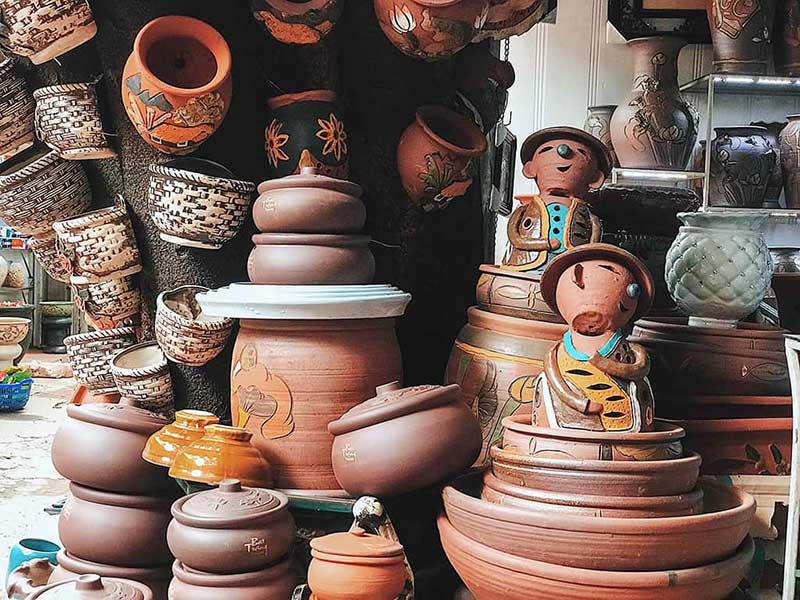
Le soir, j’ai pris le train de nuit couchette en direction de Lao Caï, à l’extrême nord du Vietnam
Jour 3 : Lao Cai – Bac Ha
Arrivée tôt le matin à la gare de Lao Caï, j’ai pris un bon petit déjeuner local puis ai pris la route en direction de Bac Ha , un petit bourg montagnard situé dans une région montagneuse éblouissante de beauté. Une belle randonnée m’a permis de découvrir de splendides rizières en terrasses qui dégringolent des montagnes où vivent plusieurs minorités ethniques.
.jpg)
J’ai passé une séjour inoubliable avec l'expérience " dormir chez l'habitant " dans une famille de l’ethnie « Tay ». Cela reste un des moments forts de mon séjour. J’ai partagé avec eux un dîner convivial, accompagné de quelques verres d’alcool de maïs.
Jour 4 : Bac Ha – Sa Pa
Accompagnée d’un guide local, j’ai pu m’aventurer dans des contrées sauvages et magnifiques dans les alentours de Bac Ha. J’ai rencontré des femmes Hmong fleur époustouflantes de beauté avec leurs chatoyants costumes traditionnels. J’ai également participé avec des villageois à quelques travaux des champs, ce fut une expérience incroyable et très enrichissante ! Nous avons pris ensuite la route pour nous rendre à Sapa, ancienne station climatique de l’époque coloniale.
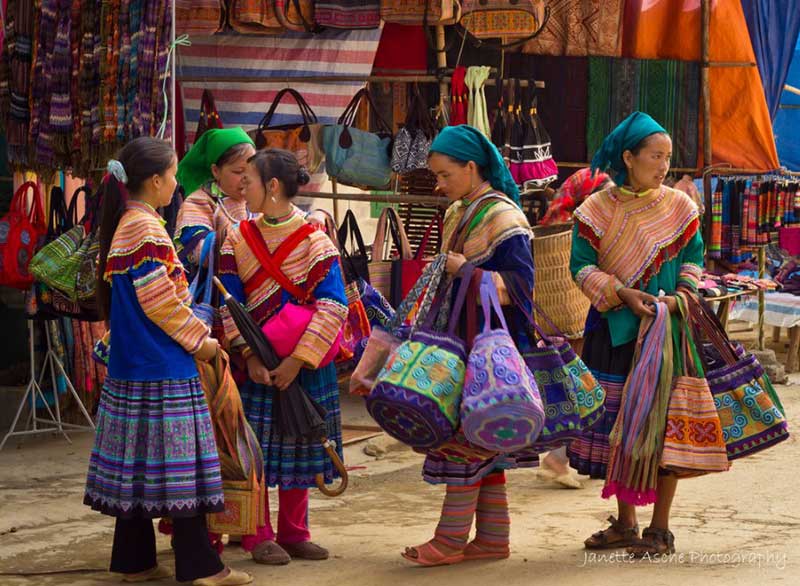
Jour 5 : Sapa – Lao Cai – Hanoi
J’ai consacré ma journée à la découverte des villages ethniques aux alentours de Sapa, accompagnée de mon guide local bienveillant et toujours prompt à me donner de passionnantes informations. J’ai pu rencontrer les femmes Hmong noir, habillées de leurs costumes traditionnels de couleur indigo, et les femmes Dao rouge et leur superbe coiffe. Le clou du spectacle était les incroyables rizières en terrasses qui signent là des tableaux vertigineux. Il a fallu quitter ce décor sensationnel pour prendre le bus pour Hanoï avec des images plein la tête !
Jour 6 : Hanoi – Ninh Binh (baie Halong terrestre) – Hanoi
Aujourd’hui, je suis parti avec beaucoup d’excitation à la découverte de la baie d’Halong terrestre à Ninh Binh. J’ai tout de suite ressenti le calme et un sentiment de relaxation en arrivant ici. La région est tellement paisible que j’avais l’impression d’entendre uniquement le son émis par la rameuse lors de la splendide balade en barque. Et s’il vous plait, ici on rame avec les pieds ! Je vous recommande fortement cette baie d'halong terrestre pour ses belles rizières inondées, ses grottes, et ses jolies paysages ruraux.
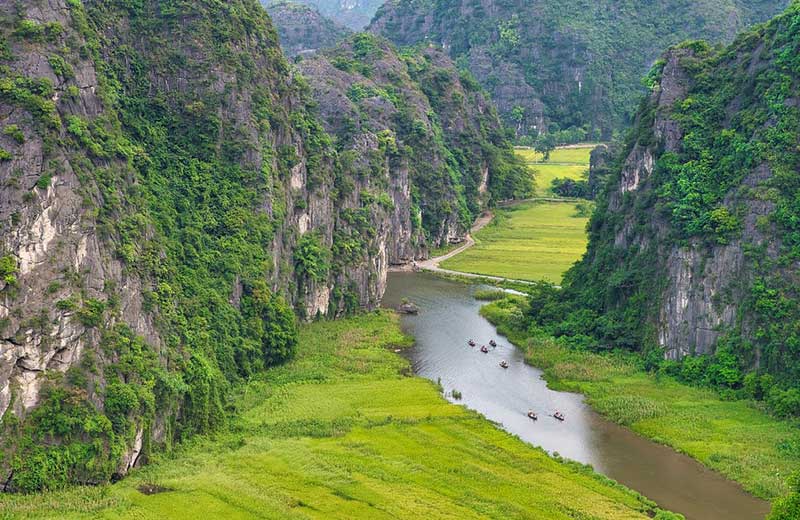
Jour 7 : Hanoi – Baie d’Halong
Je me suis levé tôt ce matin car je vais visiter l’incontournable baie d’Halong , la vraie. J’ai choisi un programme différent du circuit classique en faisant une croisière dans la baie de Lan Ha, voisine d’Halong et bonne alternative face à la sur-fréquentation touristique de la baie d’Halong. Lors de la croisière, nous avons eu l'occasion de nous baigner dans la baie et de faire du kayak. Mon coup de cœur : les excellents repas de fruits de mer frais servis à bord !
.jpg)
Jour 8 : Baie d’Halong – Hanoi – Hue
J’ai suivi le conseil du capitaine de la jonque et me suis levée très tôt le matin afin de voir le soleil se lever. Quel merveilleux spectacle que de voir l’astre solaire se lever dans cette féerie calcaire tout droit sortie du chaos initial ! Nous avons encore navigué dans ce décor exceptionnel, pris un délicieux déjeuner et salué l’équipage avant de reprendre la route en direction de la capitale vietnamienne. Cette croisière restera pour moi un de mes plus beaux souvenirs de mon voyage au Vietnam.
Jour 9 : Hue – tour de ville
Cette journée fut consacrée à la visite de Hué , l'ancienne capitale royale sous la dynastie des seigneurs Nguyen. J’ai n’ai pas bouder mon plaisir à visiter l’ancienne citadelle royale, l’élégante pagode Thien Mu perchée au bord de la romantique rivière des Parfums et les magnifiques tombeaux des empereurs nichés dans des cadres naturels somptueux. Je me suis également rendu en fin de journée au vibrant marché de Dong Ba et ai fini cette belle journée en goûtant à quelques-unes des spécialités gastronomiques de Hue, connue pour proposer une des cuisines les plus raffinées du pays.
.jpg)
Jour 10 : Hue – Hoi An
Le matin, j’ai pris la route en direction de Hoi An le long de la mer de l’Est et de vastes étendues de rizières. Après avoir passé la sublime lagune de Lang Co, nous avons fait l’ascension du col des nuages qui offre des panoramas à couper le souffle. Passage par Danang pour visiter l’excellent musée des arts Cham, initié par l’archéologue Henri Parmentier, avant de rejoindre la charmante de Hoi An où je n’ai pas pu résister d’aller à la plage de An Bang pour prendre un bon bain de mer rafraîchissant.
Jour 11 : Hoi An
Hoi An est pour moi la ville la plus charmante du Vietnam. Quel plaisir que de se balader dans ses rues piétonnes, de découvrir ses bâtisses en bois centenaires, de traverser ce pittoresque pont japonais coiffés de tuiles et de se régaler d’une cuisine locale pleine de saveurs. Je suis partie l’après-midi découvrir à vélo la riante campagne afin de visiter quelques-uns des nombreux villages artisanaux où j’ai pu, avec l’aide d’artisans, confectionner moi-même mes souvenirs : lanternes et poteries. Eclairée de centaines de lanternes le soir, la vieille ville de Hoi An devient véritable magique !
.jpg)
Jour 12 : Hoi An – Ho Chi Minh ville
Pour économiser le temps, j’ai pris un vol pour Saigon , la capitale du sud du Vietnam. Une ville étonnante, tout à fait fascinante où l’architecture coloniale se mêle avec les constructions modernes les plus audacieuses. Une ville pleine de contrastes, de dynamisme, d’énergie qui abrite des musées passionnants comme celui des Beaux-Arts ou de la guerre du Vietnam. Le soir venu, j’ai pris un cocktail sur l’un des nombreux toits-terrasses de la ville pour profiter d’une vue panoramique incroyable sur cette mégalopole qui ne semble jamais dormir.
Jour 13 : Ho Chi Minh ville – Delta du Mékong
Direction le delta du Mékong où le légendaire fleuve fini une course de plus de 4500 kilomètres en se divisant en 9 neufs bras. Le delta du Mékong c’est encore un autre visage du Vietnam qui s’est offert à moi. Un monde aquatique surprenant où la nature est reine et sait être généreuse avec les habitants. Les vergers abondent en fruits tropicaux, les cocotiers poussent en jungle et les rizières donnent trois récoltes par an. Gâtés par cette nature, les locaux se montrent d’incroyables hôtes. J’ai pu apprécier leur hospitalité en passant une nuit chez l’habitant où j’ai pu préparer le dîner avec la famille et ensuite le partager avec eux.
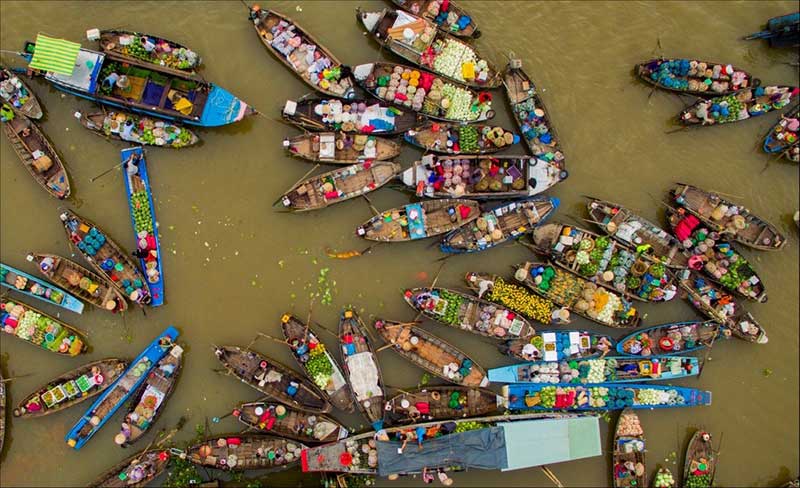
Jour 14 : Delta du Mékong – Ho Chi Minh Ville
J’ai fait l’effort de me lever de très bonne heure pour pouvoir assister au marché flottant de Cai Rang à Can Tho. Quelle récompense ! Un spectacle étourdissant où des centaines d’embarcations de différentes tailles viennent pour commercer. C’était hallucinant de voir cet enchevêtrement de bateaux et cette activité si intense sur l’eau. J’ai même pu prendre mon petit déjeuner auprès d’une embarcation qui servait soupes, sandwiches et cafés ! Après le déjeuner pris en compagnie de mes adorables hôtes, j’ai pris la route pour rejoindre Saïgon.
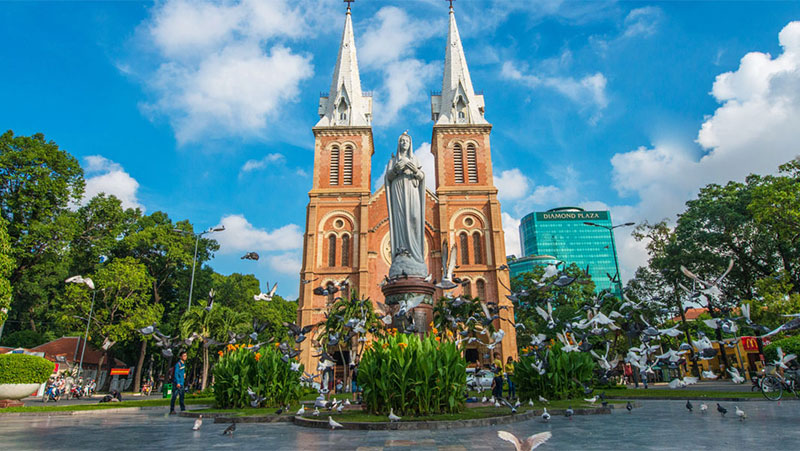
Jour 15 : Ho Chi Minh ville – Départ
Après une visite de Cholon, le chinatown de Saïgon, et du marché de Ben Thanh pour l’achat de quelques souvenirs, j’ai pu profiter d’un massage régénérateur avant de m’envoler pour l’Europe avec des souvenirs de voyages impérissables !
Mon voyage au Vietnam en 15 jours touche à sa fin mais j’ai déjà pensé à un autre voyage pour découvrir ce pays magnifique en profondeur. C’est sûr que je reviendrai !
Voilà, j’ai plaisir à partager avec vous cet itinéraire de mon voyage au Vietnam en 15 jours et espère que cela vous servira pour préparer le vôtre.
Capitale : Hanoi
Superficie : ≃ 331.000 km2
Population : ≃ 98,1 (M d’habitants)
Langue : Vietnamienne
Taux de change : 1€ ≃ 25.100 VND (2022)
Météo : Bien que le climat varie beaucoup entre les différentes régions du Vietnam, les bonnes périodes pour visiter l'ensemble du pays s'étendent d'octobre à avril où le temps est agréable, peu risque de pluie.
.jpg)
À lire également :
- Nos conseils utiles pour prévoir son budget voyage au Vietnam pour 2 semaines
- Top meilleurs endroits à visiter au Vietnam en 2 semaines
- Carte SIM Vietnam pour les touristes en 2023 : ce qu’il faut savoir
Quiz: Que savez-vous du Vietnam ?
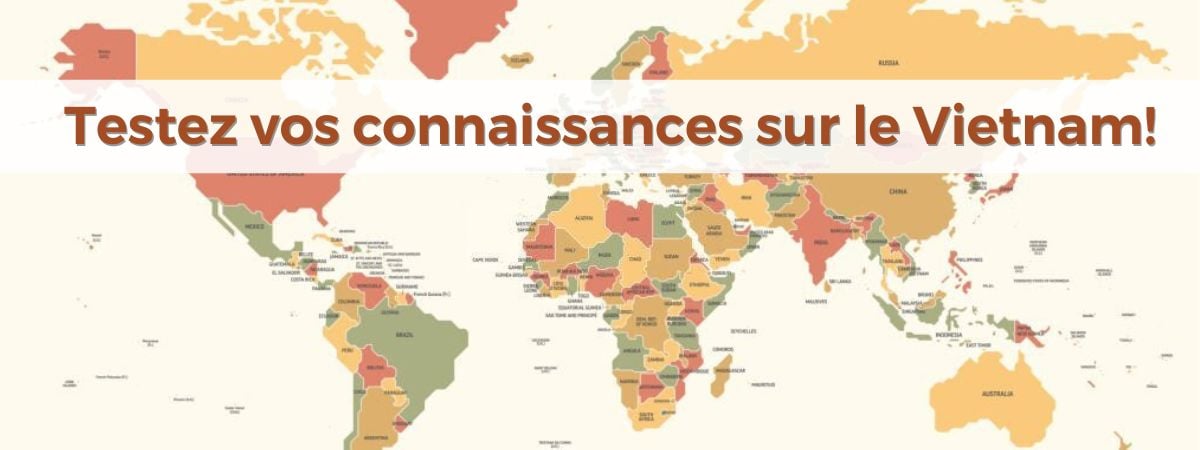
Les rizières en terrasses sont principalement associées à la région montagneuse du Nord du Vietnam. Ces terrasses offrent des paysages spectaculaires, en particulier pendant la saison de la culture du riz, avec des étages de champs en gradins sur les pentes des montagnes.
La ville célèbre pour sa citadelle impériale et ses tombes royales au centre du Vietnam est Hué. Hué était la capitale impériale du pays et abrite de nombreux sites historiques et culturels importants, dont la citadelle et les tombeaux des rois de la dynastie Nguyen.
La baie d'Ha Long, un site du patrimoine mondial de l'UNESCO, se situe dans le nord du Vietnam. Intégrée au golfe du Tonkin dans l'océan Pacifique, elle est renommée pour ses formations karstiques saisissantes, ses îles pittoresques et ses eaux cristallines, constituant ainsi une beauté naturelle unique au monde.
La "baie d'Halong terrestre" se trouve au nord du Vietnam (à 2 heures de route au sud d’Hanoi). Cette appellation vient du paysage karstique similaire à celui de la baie d'Halong, avec ses formations rocheuses spectaculaires émergeant des rizières et des cours d'eau, offrant une beauté naturelle remarquable.
La plus grande ville du Vietnam est Ho Chi Minh-Ville, située dans le sud du pays. C'est un important centre économique offrant de nombreuses activités commerciales et culturelles. La plus dynamique et moderne du pays, elle est réputée pour sa vie nocturne vibrante.
Hội An, vieille ville centrale du Vietnam près de Hué et de Da Nang, est souvent surnommée la 'ville des lanternes'. Cette réputation découle de sa tradition artisanale, illuminant rues et maisons d'une atmosphère magique et empreinte de traditions.
Le Vietnam se trouve en Asie du Sud-Est. C'est un pays situé dans cette région de l'Asie, entouré par des pays comme la Chine, le Laos et le Cambodge. Ses frontières s'étendent le long de la mer de Chine méridionale.

Bonjour, de mars à avril, c'est la haute saison touristique, donc pour un voyage parfait, nous vous conseillons de tout organiser à l'avance, en particulier la réservation d'hôtel.
Pour mieux vous préparer, vous pouvez vous poser quelques questions telles que :
- Souhaitez-vous voyager dans le nord, le sud, le centre, ou partout... ?
- Quels sites aimeriez-vous découvrir ?
- Quel mode de transport envisagez-vous pour les déplacements (train, avion, etc., notamment pour les longues distances) ?
Nous espérons que cela vous aidera. N'hésitez pas à poser d'autres questions. Cordialement.
Bonjour Nicolas,
Vous pourrez chercher les Agences de voyage locales sur les livres connus comme Lony planet, Routard ou sur le site Tripadvisor.
De notre part, basée à Hanoi, notre Agence Vietnam Découverte est spécialisée dans les voyages individuels et sur-mesure au Vietnam et et en Asie du Sud-Est (Cambodge, Laos, Birmanie, Thaïlande). Nous serons ravis de partager nos connaissances, expériences avec vous pour que vous puissiez concevoir un beau voyage au Vietnam. Veuillez nous contacter via WhatsApp au numéro suivant : 84 397 541 881 ou email : [email protected]
Le mois de décembre tombe dans la haute saison touristique au Vietnam. Les bonnes prestations telles quelles jonque sur la baie d’Halong, bon guide francophone local, hôtel de charme…sont complètes rapidement. Ce serait mieux de bloquer ces prestations de ce type avant.
Cordialement, Lan DUONG.
Bonjour Emilie Hardènne, vos 15 jours sont idéaux pour visiter le nord, la plus belle région du Vietnam. Vous pourrez visiter ses sites incontournables tels que Hanoi, la capitale millénaire, la baie d'Halong, la baie d'Halong terrestre et faire une boucle dans les montagnes pour découvrir les fabuleuses régions de Sapa, Bac Ha, Ha Giang et Cao Bang. Vous ferez là-bas des randonnées pédestres dans les montagnes pour admirer les paysages spectaculaires et découvrir les villages ethniques locaux, visiterez les marchés locaux où les minorités ethniques se réunissent pour vendre et acheter des produits locaux, participerez à des activités culturelles telles que la danse, la musique et la cuisine traditionnelle et passerez des nuits chez l'habitant pour appréhender la culture locale.
Côté météo, le mois de novembre est en fin d'automne dans le nord. Le temps est frais avec une température variant entre 18 et 25 degrés (il ne fait pas encore froid). Dans les montagnes, les paysages restent encore somptueux avant l'arrivée de l'hiver, mais vous ne pourrez pas voir les rizières en terrasse car la récolte de riz sera terminée en septembre. Pour voir les rizières, nous vous conseillons de partir vers le mois d'août et au plus tard en septembre. Pour plus de renseignements sur la météo au Vietnam, je vous remercie de consulter notre article " Quand partir au Vietnam ". N'hésitez pas si vous avez d'autres questions. Cordialement, DUONG Thi Lan, conseillère en voyages
- Cuisine & culture
- Guide de voyage Sri Lanka
- Guide de voyage Laos
- Guide de voyage Cambodge
- Guide de voyage Thaïlande
- Guide de voyage Vietnam
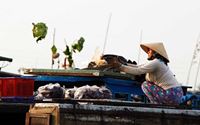
Grande boucle du nord Vietnam 15 jours
Ce circuit Nord Vietnam 15 jours est dédié aux voyageurs souhaitant découvrir les splendides paysages en altitude et les cultures authentiques des ethnies minoritaires. Vous êtes invités à effectuer cette boucle en deux semaines en parcourant les plus belles rizières en terrasses du Vietnam, en visitant des marchés hebdomadaires colorés de la région sans oublier les rencontres conviviales avec les habitants locaux.
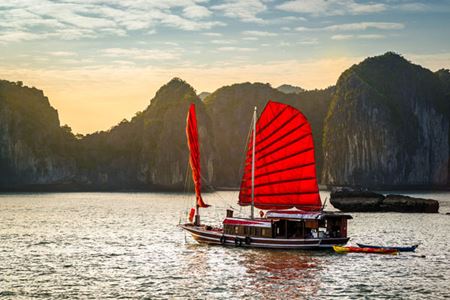
Le meilleur du Vietnam 15 jours
Ce circuit de 15 jours propose une vue d’ensemble des trois régions du pays en forme de S. Au nord, vous visiterez Hanoi la capitale millénaire et la baie d’Halong maritime et terrestre, et ferez aussi une excursion dans les splendides montagnes de Sapa. Au centre, vous explorerez l’ancienne cité impériale de Hué et la vieille ville de Hoi An, avant de clore votre voyage dans le sud en visitant Ho Chi Minh ville et le delta du Mékong. Voici nos suggestions de programme pour un circuit de 15 jours au Vietnam.
De la baie d’Halong à l'île de Phu Quoc 18 jours
Ce circuit vous permet de parcourir le Vietnam depuis la spectaculaire baie d’Halong à bord d’une jonque traditionnelle, au nord-est, jusqu’à la plage insulaire et reposante de Phu Quoc, à l’extrême sud du pays. Des randonnées pédestres à la découverte…
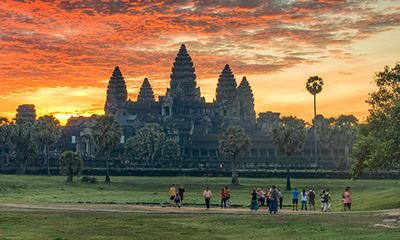
De la baie d'Halong aux temples d'Angkor 15 jours
Ce circuit Vietnam Cambodge 15 jours est idéal pour découvrir les deux pays d’Asie du Sud-est. Vous visiterez le Vietnam - en faisant notamment une croisière dans la magnifique baie d’Halong - avant de vous rendre au Cambodge par la voie fluviale pour visiter des spectaculaires temples d’Angkor.
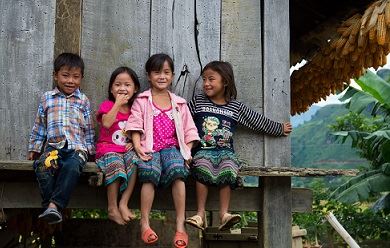
Multiples visages du Vietnam 21 jours
Vous souhaitez une découverte approfondie de notre pays ? Le circuit multiples visages du Vietnam d’une durée de 21 jours est le choix parfait. Ce circuit trans-vietnamien dure trois semaines et vous emmènera vers tous les sites majeurs du pays. Vous profiterez d’une croisière en jonque...
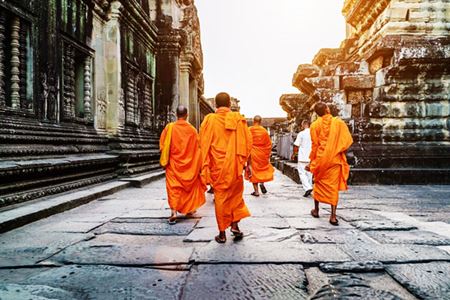
Grande traversée de l’Indochine 21 jours
Circuit complet à la découverte de tous les sites incontournables de l’ancienne Indochine. Ce programme est très intéressant dans la mesure où il vous permet de combiner les trois pays de l’Indochine pour n'en faire qu'une seule destination. De diverses activités originales…
+84 2436983617 (fixe)
+84 397541881 (hotline)
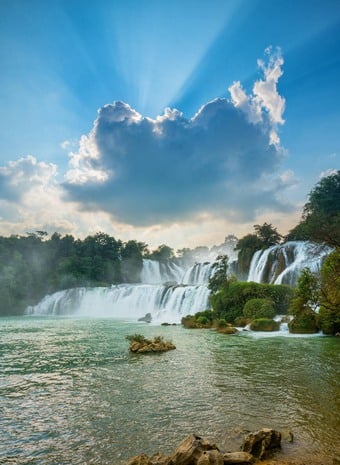
Voyage au Vietnam : notre itinéraire et nos conseils : du Nord au Sud
Découvrez nos conseils pour un voyage au vietnam pour des vacances en amoureux pendant 15 jours. un itinéraire de 15 jours en bateau, en bus, en avion pour découvrir le vietnam du nord au sud..
Décidés au dernier moment à partir en vacances en Avril, les choix sont vite limités, surtout si on n'a pas beaucoup de temps pour organiser son voyage. Du coup, ce sera l'Asie, son soleil, sa chaleur, et la facilité d'organiser un voyage au jour le jour. Après la Thaïlande, le Laos et Bali, notre choix se porte donc sur le Vietnam et ses paysages variés : villes, plages, rizières... Et tout ça sous le soleil.
Comme d'habitude, vous trouverez la vidéo de notre voyage à la fin de cet article. Si vous avez des questions, n'hésitez pas à nous laisser un commentaire.
Suivez-nous sur Instagram pour découvrir les lieux conseillés dans cet article, nos voyages, nos bons plans
Nos conseils billets d’avion, hôtels, transports et parcours
Comme nous nous sommes décidés un peu tard, nous prenons les billets un peu au dernier moment sur Internet. Nous nous décidons pour un vol aller-retour pour Hanoï plutôt que Ho Chi Minh : le nord nous attire plus. Nous prenons un vol chez Fly Emirates en profitant des économies faites grâce au site Igraal.
Notre vol réservé pour 15 jours de voyage, nous pouvons construire notre parcours. Vous trouverez l’itinéraire ci-dessous. Et il est clair que nous avons voulu trop en faire !
Pour nous soulager des longs temps de voyage entre les différentes régions, nous avons même pris des vols internes qui ont forcément gonflé notre budget. Malgré cela, nous avons quand même eu l’impression de nous être trop déplacés au cours de ce voyage et de ne pas avoir assez profité. Si vous le pouvez, prenez le temps de visiter chaque région. Pour visiter tout le Vietnam, il faut AU MINIMUM 3 semaines.
Voici notre itinéraire (n'hésitez pas si vous avec des questions sur celui-ci) :

Si vous prenez des vols intérieurs, rien à craindre : les 2 compagnies ont été très fiables : Vietnam Airlines et Viet Jet Air. Pensez juste à bien vérifier combien de bagages sont autorisés sur votre billet.
Un autre point important avant de partir au Vietnam est la météo. Par exemple, en Avril, il fait beau, il fait chaud, mais il fait aussi lourd !!! Le taux d’humidité est énorme (c’est un critère à regarder avant de partir), alors si vous êtes comme moi et que vous adorez la chaleur, c’est le rêve. Mais si vous êtes comme Mathieu, que vous n’aimez pas trop le soleil, et encore moins l’humidité parce que vous passez votre temps à transpirer : c’est le calvaire… Surtout dans les grandes villes asiatiques. On vous aura prévenu 😊
Une fois toutes ces informations prises, deux solutions s’offrent à vous : réserver tous vos logements à l’avance, ou vous permettre de naviguer selon vos envies sur place en réservant en dernier moment : bien souvent vous trouverez beaucoup de possibilités de logement sur place et quasiment tout est référencé sur booking.com . Pensez juste à activer le cashback sur Igraal pour faire des économies : pour nous cela a représenté environ 100€ sur ce voyage…
Pour vous déplacer sur place, à part les avions, vous pourrez tout prendre au dernier moment via votre hôtel ou via des agences sur place. Et vous pourrez choisir votre gamme de confort : bus, mini-van 16 places, mini-van limousine 8 places, chauffeur privé, ou pourquoi pas le train… Les transports en Asie, c’est facile et pas cher.
L’étouffante Hanoï
Une fois atterri à Hanoï, il est très facile de trouver un taxi pour vous rendre à votre Hôtel. On vous conseille de choisir un hôtel situé dans le centre, cela vous permettra de limiter les taxis et autres moyens de transport.
Nous avions trouvé The Light Hotel que nous conseillons : les chambres sont spacieuses et confortables et le petit déjeuner très copieux et varié. Sa situation est parfaite car très proche du centre avec tous les commerces à côté.

Nous partons donc à la découverte d’Hanoï et nous sommes tout de suite marqué par le trafic incessant des scooters : de gauche à droite, en travers, … Il y en a partout et ça devient compliqué de se frayer un chemin pour traverser. C’est le royaume du scooter.
Rassurez-vous, on change vite d’habitude et on n’attend plus que le bonhomme passe au vert pour traverser : on se fraye un chemin. Tout est une question de confiance et finalement les scooters font finalement aussi attention à nous lorsque l’on traverse.
Hanoï peut se découvrir à pied ou en scooter : un très bon moyen semble être une visite avec un scooter et surtout un pilote : plusieurs agences proposent ce type de visite. L’agence Hanoï Street Food Tour propose elle de découvrir la ville en scooter mais avec des pauses dégustations…
Nous nous concentrons surtout sur les quartiers autour de notre hôtel : dans les boutiques au Nord du lac, on trouve toute sorte de choses. Nous nous trouvons surtout des répliques de chaussures de sport mais à un prix défiant toute concurrence.

Pas loin de notre hôtel, nous découvrons aussi la ligne de chemin de fer qui traverse la ville. Pour la trouver sur un plan, cherchez sur google map le Hanoi Street Train . Le décor vaut vraiment le détour : on peut marcher sur la ligne de chemin de fer qui traverse la ville, voir même se poser pour prendre un verre au bord des rails. En espérant voir passer le train…
On décide également d’aller voir le spectacle de marionnettes sur l’eau du Thang Long Puppet Theater . Pas très cher, le spectacle vaut le coup : bercé de musique traditionnelle, c’est un spectacle assez poétique qui se déroule directement sur l’eau. Avec 40°C dehors, c’est aussi une pause fraîcheur pour nous dans cette salle climatisée.
Pour les repas, voici les quelques lieux que nous pouvons vous conseiller :
- Pho Bo Mau Dich : ce petit restaurant vous permettra de manger des plats typiquement vietnamiens à prix très très intéressant. On mange sur le pouce mais la cuisine est vraiment savoureuse
- Durt Bird : ce restaurant est entièrement dédié au poulet : les photos, le décor, … Vous pourrez surtout y déguster des très bons burgers à base de poulet fris.

- Poke Hanoï : c’est notre coup de cœur à Hanoï . Une cuisine très fraîche dans un joli site pour déguster des poke bowl très bon. Une vraie pause fraîcheur dans Hanoï.

Au niveau spa et massage, vous en trouverez partout. Mais on vous conseille le Urban Oasis Spa : très propre, le service est vraiment de qualité dans un immeuble dédié. Plus classe, plus propre que les autres que nous avons pu tester, mais pas plus cher !
Après seulement une journée dans la fourmilière Hanoï, nous décidons qu’il est temps pour nous d’aller chercher un peu de calme et nous négocions avec notre hôtel une excursion de 2 jours dans la Baie d’Halong.
La quiétude de la Baie d’Halong
Il faut compter environ entre 90 et 150€ pour une excursion de 2 jours dans la Baie d’Halong, repas et transports compris. Nous partons donc tôt le lendemain matin avec une navette venue nous chercher directement à l’hôtel. Après environ 3 heures de route nous arrivons à l’embarcadère d’où tous les bateaux partent. Selon votre catégorie de bateau, vous pourrez vous retrouver entre 20 et 60 personnes par bateau. Un minimum de monde permet un peu plus de calme…
Dès le départ, le bateau glisse entre les falaises et les îles et plus on avance plus le paysage devient magnifique. Il y a certes beaucoup de bateaux, mais ceux-ci sont plutôt assez jolis et avancent relativement silencieusement dans les flots.
En plus de la nuit et des repas, plusieurs arrêts sont prévus pour rythmer la croisière : un village de pêcheurs sur l’eau à visiter en barque, des grottes cachées sur une île, une plage de sable
Mais l’activité la plus belle consiste à regarder le coucher de soleil sur la baie depuis le pont du bateau ! C’est une vue féerique… Avant de s’endormir au rythme des vagues (très calmes).

Le lendemain c’est déjà le trajet retour même si la vue reste magnifique. La croisière reste une activité assez chère mais très jolie. Choisissez celle-ci en fonction de votre budget : il n’y a pas besoin de dépenser des millions pour rendre celle-ci agréable.
Les paysages de Tam Coc
Dès la fin de notre croisière nous nous dirigeons vers Tam Coc : c'est l'équivalent de la Baie d'Halong mais terrestre ce coup-ci.

Nous logeons un peu à l’extérieur de la ville pour rester au calme. Cette solution est à retenir si vous n’avez pas peur de conduire un scooter qui sera le moyen le plus simple pour découvrir la région. Pour les plus sportifs, il y aussi le vélo.

Afin de découvrir la région, nous demandons à notre hôtel de nous conseiller un guide, et on rencontre donc Lan Anh qui nous accompagne tout au long de notre journée. Nous conseillons vraiment de faire appel à ses services. Si besoin, nous pouvons vous donner ses cordonnées.

L’activité la plus connue sur place consiste à monter à 2 ou 3 dans des barques conduites par des locaux qui rament alternativement avec les mains et avec les pieds… Nous choisissons l’embarcadère situé dans Tam Coc : commence alors une promenade entre les montagnes, les rizières, dans les grottes. C’est notre activité coup de cœur du séjour : malgré la pluie, nos yeux sont éblouis par la beauté du site. Bien sûr nous ne sommes pas la seule barque sur les flots, mais tout le monde semble respecter le calme et la zénitude du paysage et de la nature.
Plusieurs autres activités sont possibles dans la région (visite de grottes, ballade entre les rizières, promenade dans un parc d’oiseaux, …) : nous conseillons vraiment de rester au moins deux jours à Tam Coc…
Pour un repas un peu occidental, n’hésitez pas à essayer le restaurant Chookie’s Beer Garden . Dans un joli cadre, vous pourrez déguster de très bons plats, voir même des pizzas cuites au four, et également rencontrer les autres voyageurs de la région pour pourquoi pas échanger quelques bons plans. A tester.

Mais pour nous il est déjà temps de reprendre la route pour l’aéroport d’Hanoï et un vol pour Da Nang.
Les lanternes de Hôi An
Depuis Da Nang, à 20 minutes de taxi, se trouve Hôi An. C’est notre pause farniente des vacances. Un hôtel club au bord de la mer, une grande piscine, … Pour 2 jours de flemme la plus totale. Au programme, un hôtel avec piscine, plage et palmiers...
Mais Hoi An c’est aussi son centre-ville avec beaucoup de charme. Le lieu est surtout connu pour ses ruelles piétonnes (si rare au Vietnam) et ses lanternes. Chaque magasin, chaque bâtiment a ses propres lanternes qui donnent un air bucolique à la ville. On prend plaisir à se promener à pied sans avoir peur de se faire écraser.

Profitez-en pour faire du shopping (peintures, souvenirs, …) ou pour vous faire faire des vêtements ou des chaussures sur mesure chez l'un des nombreux tailleurs de la ville. En attendant la nuit et la féerie des lanternes multicolores.

Voici 3 restaurants ou bar que nous vous conseillons :
- Le Food Market : ce n’est pas vraiment un restaurant mais plutôt des petits vendeurs sur le marché au bord de la rivière . Entre le marché de nuit et le marché pour la nourriture. Essayez surtout la brochette de viande ! Et vous ne trouverez pas moins cher ailleurs.

- Le MIX restaurant : un très bon restaurant grec avec de très bons plats. Si vous êtes plusieurs, ou seulement deux courageux, essayez le plateau de poissons et fruits de mer : un régal.

- Le 92 Station : ce restaurant-bar est installé dans une ruelle assez calme de Hôi An et a l'avantage de proposer un roof top qui vous donnera une vue agréable sur la ville.

Malgré sa position, et peut être son éloignement par rapport à d’autres sites du pays, Hôi An reste un de nos coups de cœur du Vietnam. Avant de reprendre un vol vers le Sud du pays.
Les deltas du Mékong
Un vol depuis Da Nang nous permet de rejoindre la ville de Can Tho, plus au Sud. Nous avons choisi d’éviter Ho Chi Minh, déjà refroidis (ou plutôt réchauffés) par l’étouffante Hanoï. Can Tho est une ville située au bord du Mékong et qui nous donne accès aux autres régions du Sud eet pourquoi pas le Cambodge.
L’avantage de Booking.com est qu’en surveillant régulièrement le site, on peut trouver des très bons hôtels avec des réductions importantes. C’est le cas à Can Tho : nous investissons le nouveau Vin Pearl Hôtel : un 5 étoiles luxueux pour seulement 40€ la nuit. On vous laisse découvrir la vue depuis notre chambre sur le Mékong : c’est aussi ça l’Asie : l’accès au luxe à tarif préférentiel 😊
Le lendemain matin, départ aux aurores pour une petite barque sur le Mékong. Après 40 minutes nous arrivons sur l’un des derniers marchés flottants de la région. Outre la vente de produits alimentaires et légumes, vous pourrez prendre un café, un cocktail voir même un petit déjeuner.

Il est préférable de faire la visite avec un guide pour vraiment découvrir la vie du marché. La visite peut continuer avec la découverte de deltas du Mékong et un verger au bord de l’eau. Pas aussi intéressant que le marché flottant.
Dans le centre-ville, les principales activités sont la découverte du parc autour duquel l’animation se trouve, le marché de nuit pour shopping souvenirs, ou bien un bon massage avant d’aller retrouver son lit.
Can Tho ne peut être qu’une étape qui peut par exemple vous permettre d’accéder au Cambodge ou pourquoi pas à l’île de Phu Quoc.
Les plages de Phu Quoc
Nous partons donc de Can Tho en bus pour accéder au bateau pour Phu Quoc au départ de Rach Gia (attention aux horaires).
Phu Quoc c’est l’île où tout le monde veut aller. L’avantage c’est que l’île est aussi équipée d’un aéroport qui peut vous ramener direct à Hanoï. C’est aussi apparemment l’île des plus belles plages du Vietnam.

Nous choisissons donc d’aller nous aussi découvrir ce site et nous réservons une chambre dans le Phu Quoc Valley Resort . A l’écart de la ville, ils viennent vous chercher au port ou à l’aéroport. Ensuite vous pourrez y louer des scooters pour découvrir l’île. L’hôtel est vraiment agréable, au calme, avec sa piscine : un site vraiment reposant.

Voici les sites que nous avons découvert pendant notre rapide passage à Phu Quoc et que nous pouvons vous conseiller :
- Le village de pécheurs sur pilotis : au nord de l’île, vous pourrez y trouver plusieurs restaurants au-dessus des vagues. La vue est très jolie et le poisson frais : on le pêche devant vous

- Starfish Beach : un peu plus loin au Nord, cette belle plage a la spécificité d’être habillée par de nombreuses étoiles de mer. Outre les étoiles, c’est un très bon spot pour se baigner et bronzer (n’oubliez pas la crème solaire). Vous trouverez également quelques restaurants sur pilotis
- Le marché de nuit de Phu Quoc : dans la ville principale, vous y trouverez tout ce qu’on peut goûter ou ramener de l’île. Vous trouverez également beaucoup de restaurants de fruits de mer pas cher. C’est le lieu vivant le soir.
Pour nous, il est déjà temps de prendre le chemin du retour avec un vol pour Hanoï puis pour Paris. Nous garderons beaucoup d'images de ce passage "éclair" au Vietnam qui mérite vraiment bien plus que 2 semaines pour le découvrir...
Voici comme promis la vidéo de notre voyage :
Si vous avez des questions sur notre itinéraire, un lieu, une ville, le budget, …. N’hésitez surtout pas à nous laisser un commentaire, nous vous répondrons très vite.
Vous pouvez retrouver ici tous nos conseils pour préparer votre voyage : choisir son hôtel, faire des économies, ne rien oublier dans sa valise, …
Quelle était votre budget ?
nous partons 12 jours de Hanoï à ho chi minh
Nous partons en couple (50 ans ) mais en forme pour le Vietnam ; nous hésitons à réserver un circuit (agence à Hanoï)
ou bien à partir en réservant seulement 2 jours dans un hôtel et tous sur place ; on fera moins de choses mais ça a l’air nettement moins onéreux.
qu en pensez vous ?
Merci pour votre message
L'Asie ets souvent très simple pour les réservations d'hébergement, les transports, ...
Nous conseillons plutôt de tout réserver sur place sauf si vous souhaitez prendre l'avion pour des vols intérieurs : il vaut mieux alors réserver à l'avance. Mais il ets préférable de ne faire que la moitié du Vietnam, de faire tout en navette ou train et d'ajuster son séjour au jour le jour en réservant sur place. C'est notre avis :-)
Ma Valise à Roulettes

Payer moins cher vos billets d'avion et vos réservations d'hôtel, et économiser sur tous vos achats

Faire visiter Paris à vos amis

Quand acheter son billet d'avion pour payer moins cher

Comment bien choisir sa voiture de location

Quel appareil photo choisir pour voyager

Quelles sont les applications pour téléphone à emporter en voyage
Une autre voyage ?
Suivez nous sur instagram.

New York à Noël en amoureux : nos conseils

Road trip en Irlande et découverte de Dublin

Road trip en Andalousie : conseils et itinéraire
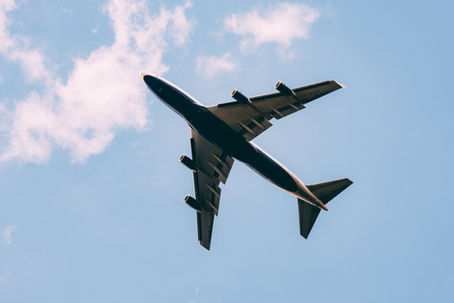

- Chez l’habitant
- Activités immersives
- Rencontres culturelles
- Guides de voyage
- L’esprit TTB Travel
- DÉMARCHE RESPONSABLE
Circuits à explorer
Voyage en famille au vietnam, ambiance festive du nouvel an, le haut tonkin intimiste, voyage au vietnam à l’automne, splendeurs de l’été, couleurs du printemps, séjours chez l’habitant, séjour chez l’habitant à hoang su phi.
À Hoang Su Phi, les vastes étendues vallonnées regorgent de villages tribaux où les ethnies Dzao et Hmong perpétuent les
Séjour chez l’habitant à Vung Liem
Impossible de résister à la beauté du pays des cocotiers. Le sens de l’hospitalité des habitants y est pour beaucoup.
Séjour chez l’habitant à Pu Luong
Immersion au coeur de la culture des Thaï Blancs dans la Réserve Naturelle de Pu Luong. Il n’y a pas
Expériences à vivre
C’est l’art de voyager comme des locaux. TTB Travel facilite votre accès à la population locale.
PARTENAIRE DES ACTEURS ENGAGÉS
Articles de blog, routards aguerris: quand le voyage forme une jeunesse pourrie.

Pollution plastique : un autre combat du voyage
L’esprit patriotique : moteur de la transition du tourisme durable, croisière maritime au vietnam : les pirates modernes du capitalisme, numérique responsable : nos efforts dans la transition écologique, standardisation culturelle dans l’aménagement du littoral vietnamien, label unesco : déclin d’un oscar déchu de la culture.
LIRE LA SUITE
Écoconception des voyages : comment réduire l’empreinte carbone
À propos de ttb travel.
Histoire d’une agence de voyages familiale
NOTRE VISION
Rencontres humaines au coeur de nos voyages
NOTRE FORCE
Innovation pour une découverte authentique
Recevoir le programme détaillé
Un document réalisé avec soin par l’équipe TTB Travel. Facile à lire, imprimer et partager pour préparer votre voyage.

7 amazing cruise itineraries to book in 2024
I don't know about you, but each year, as the weather turns cold, I start daydreaming about getting out of Dodge — or, in my case, Pennsylvania. My mind wanders to cruises that will take me to places where the temperature is warmer, but I also take a hard look at the (exceptionally lengthy) list of places I'm longing to visit.
After digging through what's new for 2024, I've come up with a shortlist of sailings that I think are noteworthy. They range from a standard Bahamas voyage with a new twist and an extended Alaska sailing that includes a foray across the Arctic Circle to more far-flung destinations in the Asia-Pacific region.
Dream on, dear reader, and add these to your list of 2024 cruise itineraries.
Note: All prices listed are per person, based on double occupancy, unless otherwise noted. Fares do not include taxes and fees.
For more cruise news, reviews and tips, sign up for TPG's cruise newsletter .
Seabourn's 'Kimberley Expedition: Waterfalls and Wandjinas' itinerary
Last year, the Australia and New Zealand cruise region gained momentum following the pandemic shutdown. In 2024, the hardly populated Australia region of The Kimberley is gaining popularity. Luxury cruise brand Seabourn will be offering a series of six 10-night voyages between Broome and Darwin on expedition vessel Seabourn Pursuit during what will be early winter in the southern hemisphere.
The line's " Kimberley Expedition: Waterfalls and Wandjinas " will take passengers to places along the coast few passengers are able to visit to see the stunning teal waters and horizontal waterfalls of Talbot Bay, sample wines in the Hunter River Region and check out nature preserves in Wyndham.
Details: The first sailing, from Darwin to Broome, embarks on June 12. The final voyage, from Broome to Darwin, departs on Aug. 1. Prices start from $6,134 per person ($613 per person, per night), double occupancy, for the July 2 cruise. All accommodations are suites with balconies.
Celebrity's 'Best of Japan' and 'Vietnam and Thailand' cruises
The number of voyages in Asia was trending upward notably prior to 2020, when the COVID-19 pandemic brought cruising in the region to an extended halt. And it's once again on the rise. Following that curve, Celebrity Cruises will be running new 11- to 13-night Asia sailings in 2024 on two ships — Celebrity Millennium and Celebrity Solstice — that bring stops in Japan, South Korea, Hong Kong, Vietnam and Thailand.
What's notable about the offerings is that they will aim to immerse passengers further into the destinations by including overnights in a total of 11 ports across all itineraries. That means more time to explore Hanoi's Old Quarter as the sun sets, indulge in nighttime gastronomy in Hong Kong, visit one of Bangkok's many markets, or learn why Osaka is known for street food.
Details: Celebrity Millennium's " Best of Japan " cruises run from early mid-March to early October. At press time, the least expensive fares — for a 12-night sailing — start from $1,330 per person ($111 per person, per night) for an inside cabin. It travels round-trip from Yokohama and visits Hiroshima, Pusan and other ports, including Osaka, where the ship will overnight.
Celerbrity Solstice's Vietnam and Thailand cruises kick off in mid-January and run through March. The ship will resume them again in the fall of 2024 and run through the winter season. Prices start from $1,255 per person ($105 per person, per night) for an inside cabin. The voyage sails from Hong Kong to Singapore with stops in Da Nang and Koh Samui, plus overnights in Hanoi and Bangkok.
SeaDream's 'Yachting the Adriatic & Greek Isles' sailing
Here's one to put on your radar if you're looking to book — but not necessarily sail — in 2024. It's a new Mediterranean itinerary that doesn't start up for nearly three more years, in 2026. The SeaDream routing brings stops at seven ports that are rarely visited by cruise passengers. During the seven-night voyages, there will be calls at Primosten, Croatia; Cesme, Turkey; Cetubal, Portugal; and Kythira, Kythnos, Syvota and Tinos, Greece — making these sailings unique and well-suited to anyone who loves the region but who's looking for new places to experience.
SeaDream's small ships, each of which carries just 112 people, are able to reach locales about which passengers on megaships can only fantasize. Couple that with excellent service, and you'll be visiting the Our Lady of Loretto statue in Primosten, touring the Cesme Castle and lounging on stunning Greek beaches from a home base that puts you squarely in the lap of luxury.
Details: An itinerary that includes three of the seven new ports is the 11-night " Yachting the Adriatic & Greek Isles " itinerary from Venice, Italy, to Athens, Greece, departing on Aug. 8, 2026, on SeaDream I. Prices start from $10,399 per person ($946 per person, per night) for a room with a porthole view.
Holland America's 'Alaska Arctic Circle Solstice' Legendary Voyage
Alaska is an absolute must for anyone who enjoys the vastness of untouched wilderness, the wildlife it houses and adventurous pursuits it provides. (Think whale-watching, hiking on glaciers and salmon fishing.) However, Holland America 's Westerdam is hosting a 28-day sailing that's anything but your standard cruise to the Last Frontier .
Passengers will visit the usual Alaska ports, such as Ketchikan, Sitka and Juneau, with scenic sailing through the Inside Passage, past Hubbard Glacier and to Glacier Bay. But they can also expect less-common stops at places like Nome, Kodiak, Anchorage (with an overnight) and Homer. Plus, about halfway through, this cruise crosses the Arctic Circle — a rite of passage for many travelers.
Details: Holland America's 28-day " Alaska Arctic Circle Solstice " cruise — one of the line's Legendary Voyages, known for longer durations and a unique mix of port calls — sails June 9-July 7, round-trip from Seattle. Inside cabins start from $5,299 per person (about $189 per person, per night).
Silversea's summertime French Polynesia cruises
Another consideration for future travel is Silversea Cruises , which is featuring its first full-summer season in French Polynesia in 2026. Silver Whisper will offer two immersive itineraries, including overnights, across 17 voyages between April and September.
Passengers can choose seven-night sailings that visit idyllic favorites like Tahiti, Moorea and Huahine and which also include overnights in Bora Bora. Or, they can cruise for twice as long by selecting a 14-night voyage that calls on the same ports as the seven-night option but with Fakarava, Nuku Hiva, Fatu Hiva, Atuona and Tahuata added.
Details: Silversea's seven-night voyages begin April 6, 2026, and start from $5,650 per person ($808 per person, per night) for an ocean-view cabin.
The line's 14-night sailings start on April 20, 2026. Fares start from $10,450 per person ($747 per person, per night) for ocean-view accommodations.
New Bermuda voyages on Carnival Venezia
Beginning in May of 2025, Carnival Cruise Line 's Carnival Venezia will sail a series of eight four- and five-night cruises to Bermuda from New York. These itineraries are notable because the line is aiming to increase its presence there but also because the style of the ship is new to even most of the brand's most dedicated passengers.
In 2022, Carnival announced its Costa by Carnival concept after revealing it would be transferring ships from its Costa sister brand to the Carnival fleet. Now, when travelers visit the Gibb's Hill Lighthouse or check out the island's renowned pink-sand beaches during a sailing on Carnival Venezia, they can enjoy both the Italian style of the ship and Carnival's fun atmosphere and high service standards.
Details: Voyages kick off on May 22, 2025. Prices start from $429 per person ($108 per person, per night) for an inside cabin on a four-night cruise departing Sept. 18, 2025.
Disney Cruise Line's Lighthouse Point itineraries
Disney Cruise Line 's new Lookout Cay at Lighthouse Point , a private destination on the Bahamian island of Eleuthera, is set to open in June with a three-night preview sailing on June 6 aboard Disney Magic. Following the initial voyage, the line will run regular three- to seven-night voyages to Lighthouse Point on Disney Magic, Disney Fantasy and Disney Dream.
The island will feature a dedicated family beach and water play area, an arts and culture pavilion focused on Bahamian culture, 20 family cabanas, an adults-only beach and a selection of shore excursion options.
Details: Prices for itineraries that include Lighthouse Point start from $624 per person ($208 per person, per night) for a three-night cruise on Disney Magic. The cruise departs Nov. 5 and sails from Fort Lauderdale's Port Everglades to San Juan, Puerto Rico.
Have cruise questions? TPG has answers:
- Banned items: What not to pack for a cruise
- Man overboard: Why do people fall off cruise ships?
- What is baked Alaska, and why is it paraded around cruise ships?
- What are the largest cruise ships in the world?
- What is a gentleman host on a cruise?
- What is the Jones Act and how does it affect cruise ships?
- What is a lido deck on a cruise ship?
- What's a cruise cabin guarantee and will it save you money?
- What's the difference between a cruise concierge and a butler?
Editorial disclaimer: Opinions expressed here are the author’s alone, not those of any bank, credit card issuer, airline or hotel chain, and have not been reviewed, approved or otherwise endorsed by any of these entities.
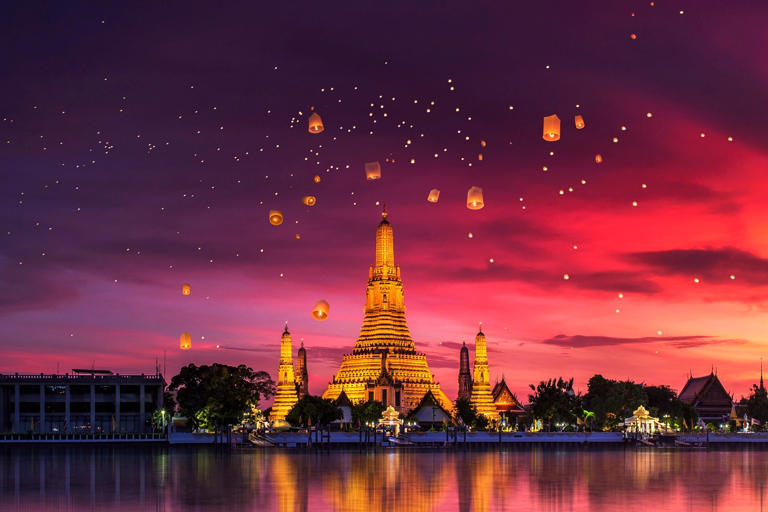

IMAGES
VIDEO
COMMENTS
Envie de découvrir le Vietnam ? Trouvez les meilleurs conseils, itinéraires, photos et forum sur Routard.com, le guide du voyage au Vietnam .
Live fully in Vietnam. Vietnam opens its door widely to welcome visitors all around the world! Starting from 15th August 2023, Vietnam extends e-visa validity to 90 days and unilateral visa exemption will be valid in 45 days! We are more than happy to welcome you all here and admire our stunning landscapes, free your soul on white sandy beaches ...
Vietnam (Vietnamese: Việt Nam) is a country in Southeast Asia with great food and a wealth of natural and cultural attractions. Despite the turmoil of the Vietnam War (called the American War in Vietnam), Vietnam has emerged from the ashes since the 1990s and is undergoing rapid economic development, driven by its young and industrious population. It remains less developed as a tourist ...
1. Pack for the climate. Perhaps the most important consideration when planning a trip to Vietnam is the weather. The south of the country sits firmly in the humid tropics, but the climate becomes increasingly temperate as you head north, and the highlands around Sapa can be downright chilly in winter. If you plan to visit both halves of the country, bring some clothes for the cooler highlands ...
Un voyage au Vietnam est un émerveillement pour les sens… Céladon, turquoise, rose tendre, framboise des façades de Hanoï jouant avec l'ombre des platanes. Lumière rasante du couchant sur les lagunes et les filets de pêche en apesanteur, sur les temples et pagodes. Bleu roi, bleu nuit, bleu pâle de la mer de Chine qui baigne de ses ...
VietnamTours is one of the leading travel agencies in Vietnam, and have been designing and operating quality tours around Southeast Asia since 2008. A tour with us guarantees a memorable experience; whether you opt for a long package tour or a one-day excursion, a jungle trekking adventure or a sun-soaked leisure holiday, we pride ourselves on providing the best customer service, local ...
Itinerary #1: Vietnam family adventure. Explore the vibrant culture and stunning landscapes of Vietnam with this 10-day itinerary, from the bustling streets of Hanoi to the serene beauty of Halong Bay, the historic sites of Hoi An and Hue, and the vibrant markets of Ho Chi Minh City, all designed with families in mind. Itinerary overview. This family-friendly Vietnam trip begins in Hanoi ...
Step 2: Click this link or access https://immigration.gov.vn/ and go to 'E-visa Issuance' then click on the link for 'Outside Vietnam foreigners'. Step 3: Upload your .jpg images (passport data page and passport photo) and fill out the required fields on the form completely. Submit your form. Step 4: Pay the e-Visa fee of 25 USD.
Victoria Voyages - Sales & Reservation Level 3, 46 Nguyen Truong To street, Ha Noi, Vietnam. Tel: +84 243 926 3148 - ext. 315. Fax: +84 243 926 3148. Email: [email protected] * Operated by Ivivu.com Joint Stock Company, Hanoi Branch
Backpacking Vietnam Travel Guide (BUDGET TIPS • 2024) Backpacking Vietnam will ignite your senses in a way you have never experienced before. This unique country in the middle of Southeast Asia is unlike anywhere I have ever been before. The colours, the lanterns and the smiley faces of Vietnam will forever be etched into my mind.
Victoria Voyages provide curated Vietnam Tours that reveal the beauty & authenticity of Vietnam. Using our in-house travel providers, we ensure 4-star Victoria-style service & unmatched savings for guests. ... Victoria Voyages - Sales & Reservation . Level 3, 46 Nguyen Truong To street, Ha Noi, Vietnam. Tel: +84 243 926 3148 - ext. 315. Fax ...
Vietnam. We have designed a range of tours to Vietnam to elevate your travel experience. You will see the exotic and rich culture of Vietnam that only a few countries have and the UNESCO Heritage Sites that it boasts many. You will follow the buffalo paths to find hill tribe villages in the mountains after exploring cities steeped in history.
Ce guide voyage Vietnam 2024 - 2025 vous aide à préparer au mieux le départ vers le Vietnam pour la première fois au Vietnam avec des infors et conseils pratiques. Quand partir au Vietnam, Hotline: M.Dinh: +84 (0) 9 12 12 10 91 (Dispo sur WhatsApp) | [email protected]; English Español;
Préparer un voyage au Vietnam. Vous envisagez partir en vacances au Vietnam mais vous ne savez pas si vous devez obtenir un visa, comment vous y rendre et quoi à mettre dans votre valise, etc. Voici nos conseils et renseignements pratiques à lire absolument pour une bonne préparation de votre séjour.
Organiser un voyage au Vietnam : tout ce qu'il faut savoir. Le Vietnam, une terre de contrastes saisissants et de richesses culturelles, est une destination de choix pour les voyageurs en quête d'aventure, de culture et de détente. Cet article vise à fournir un guide complet pour planifier votre voyage au Vietnam, en abordant des aspects ...
OPTION 1: circuit Vietnam 15 jours du Nord au Centre avec un séjour balnéaire. OPTION 2: Circuit Vietnam 15 jours du Nord au Centre ( y compris le Nord-Est) OPTION 3: Circuit Vietnam 15 jours du Nord au Centre ( y compis Phong Nh a. 4.3 Circuit 15 jours au Vietnam ( du Nord au Sud) 5. Quelques extensions à vous proposer.
1 Informations clés pour préparer votre voyage au Vietnam. Meilleure période pour une météo favorable : Janvier à Avril et Octobre à Décembre. Conditions d'entrée dans le pays : Visa non nécessaire. Durée de vol : environ 11h18 (vol Paris → Hanoï) Prix moyen du vol : 1119 € (vol aller-retour Paris → Hanoï)
Mon voyage au Vietnam en 15 jours touche à sa fin mais j'ai déjà pensé à un autre voyage pour découvrir ce pays magnifique en profondeur. C'est sûr que je reviendrai ! Voilà, j'ai plaisir à partager avec vous cet itinéraire de mon voyage au Vietnam en 15 jours et espère que cela vous servira pour préparer le vôtre. 4.
Découvrez nos conseils pour un voyage au Vietnam pour des vacances en amoureux pendant 15 jours. Un itinéraire de 15 jours en bateau, en bus, en avion pour découvrir le Vietnam du Nord au Sud, de Hanoï à Phu Quoc en passant par Hoi An, Tam Coc, Can Tho, ...
TTB-Travel - Agence spécialiste du voyage en immersion au Vietnam. Découvrez nos voyages sur mesure au coeur des populations locales : Vietnam, Laos, Cambodge.
Details: Silversea's seven-night voyages begin April 6, 2026, and start from $5,650 per person ($808 per person, per night) for an ocean-view cabin. The line's 14-night sailings start on April 20 ...